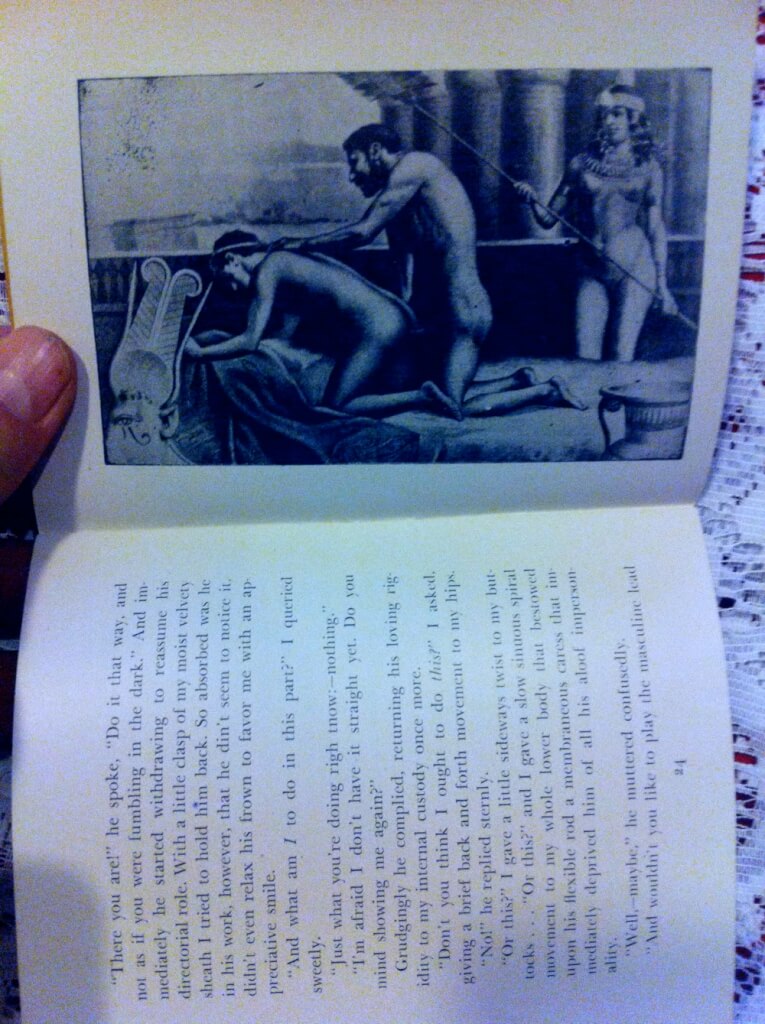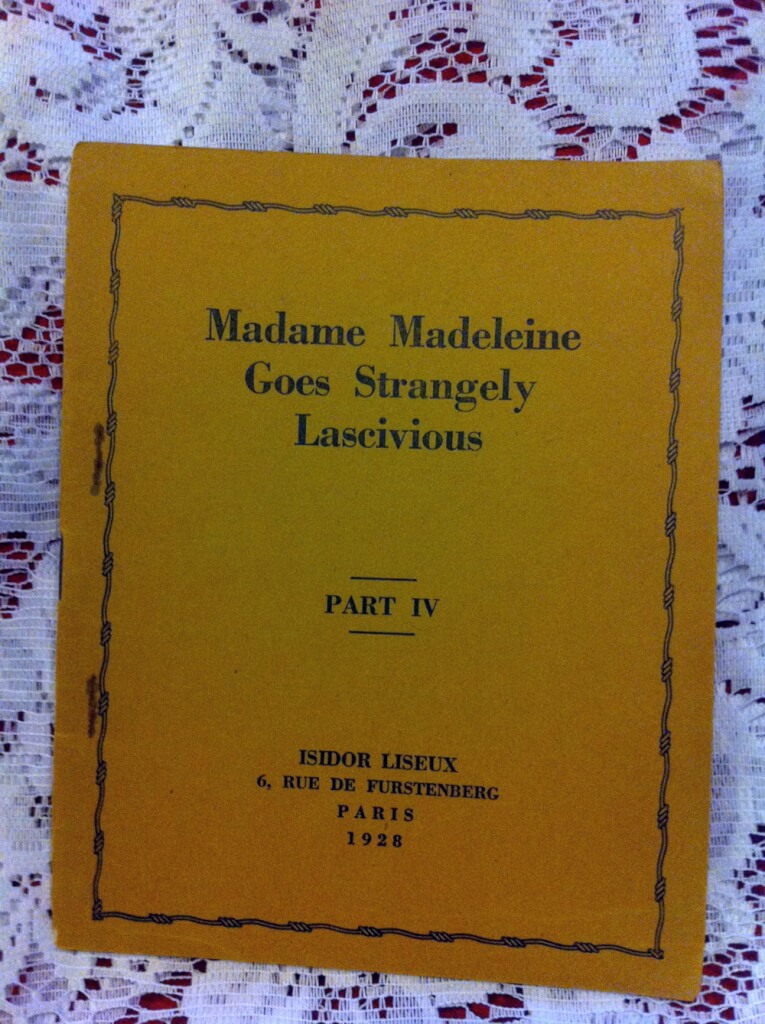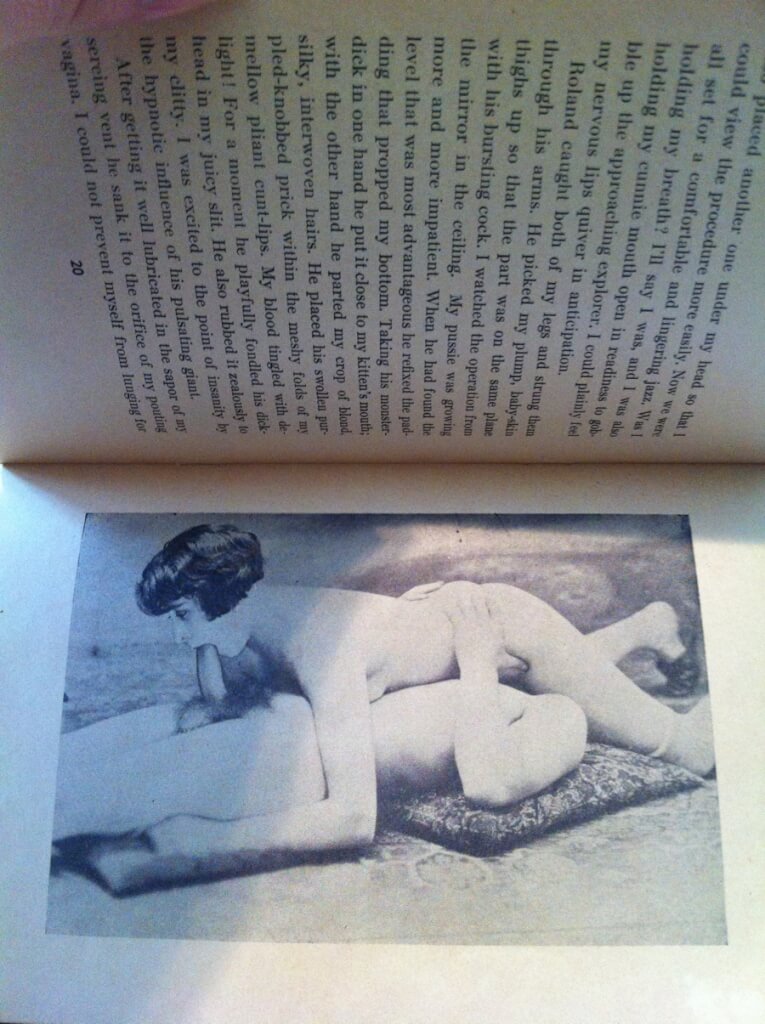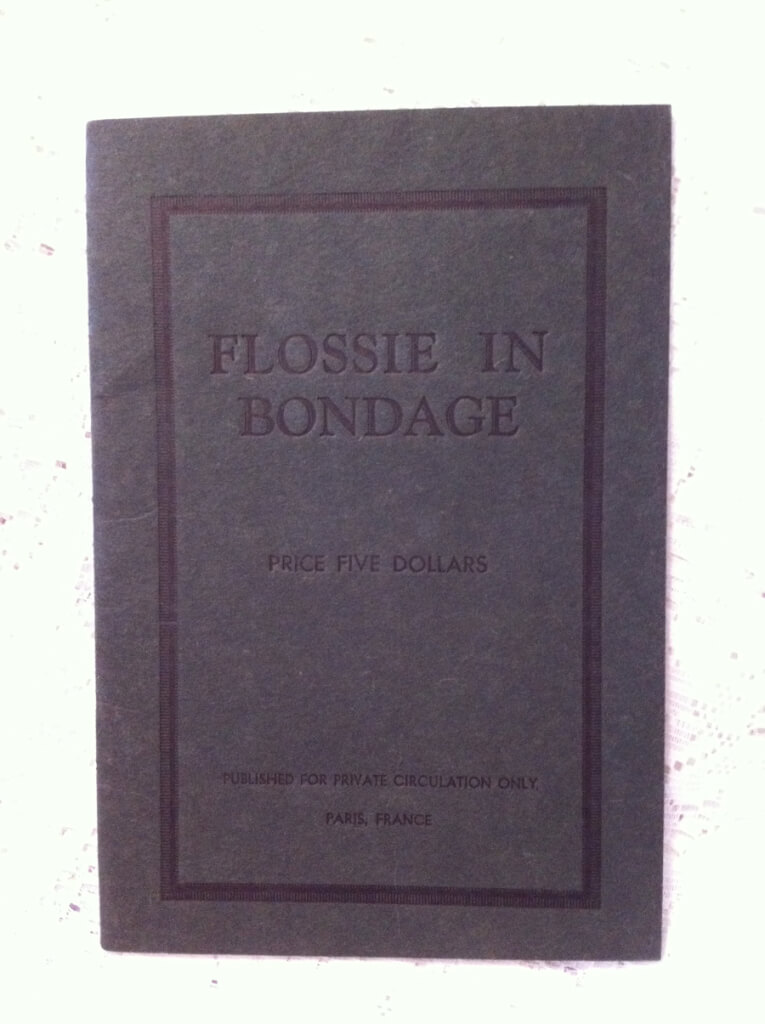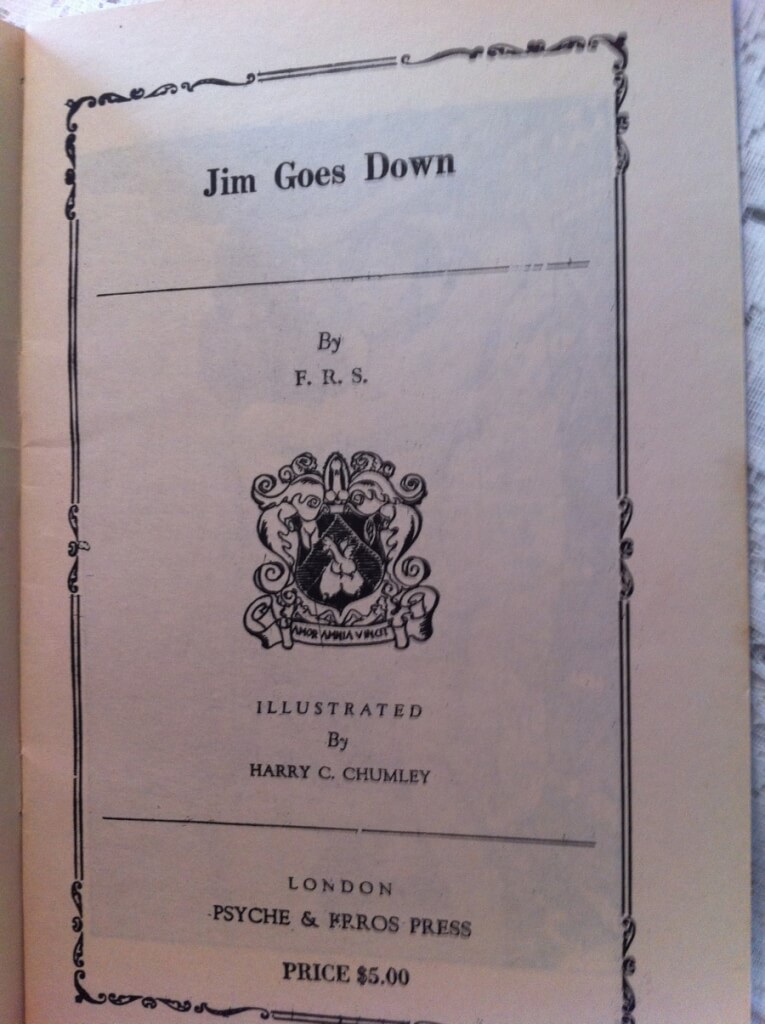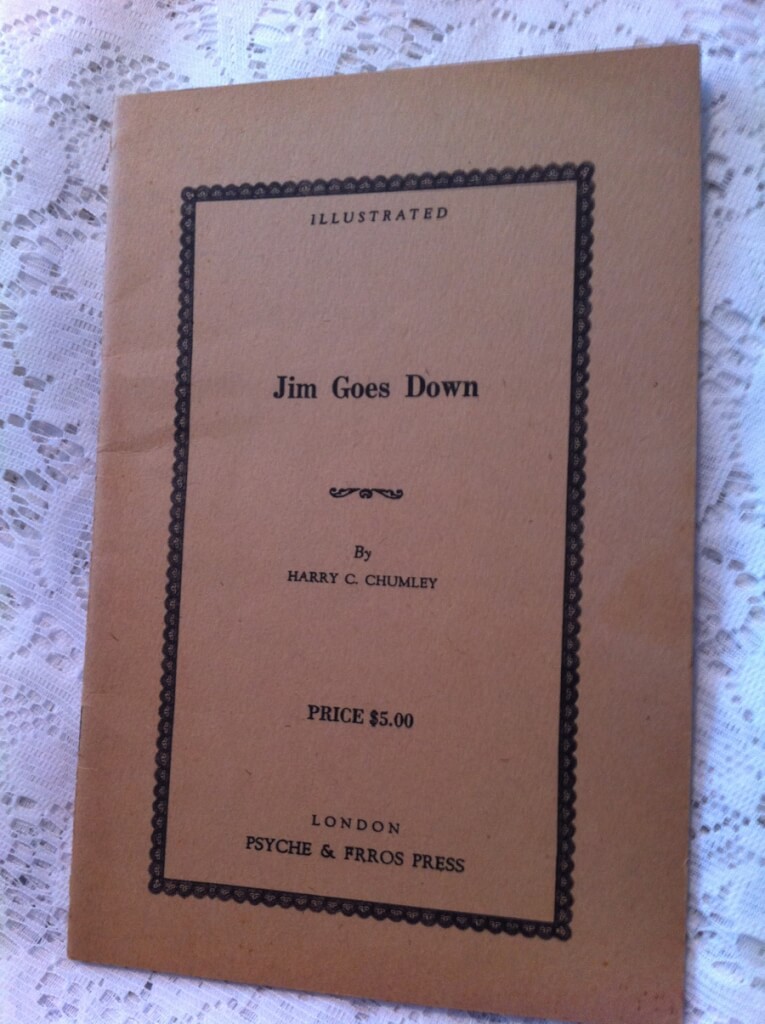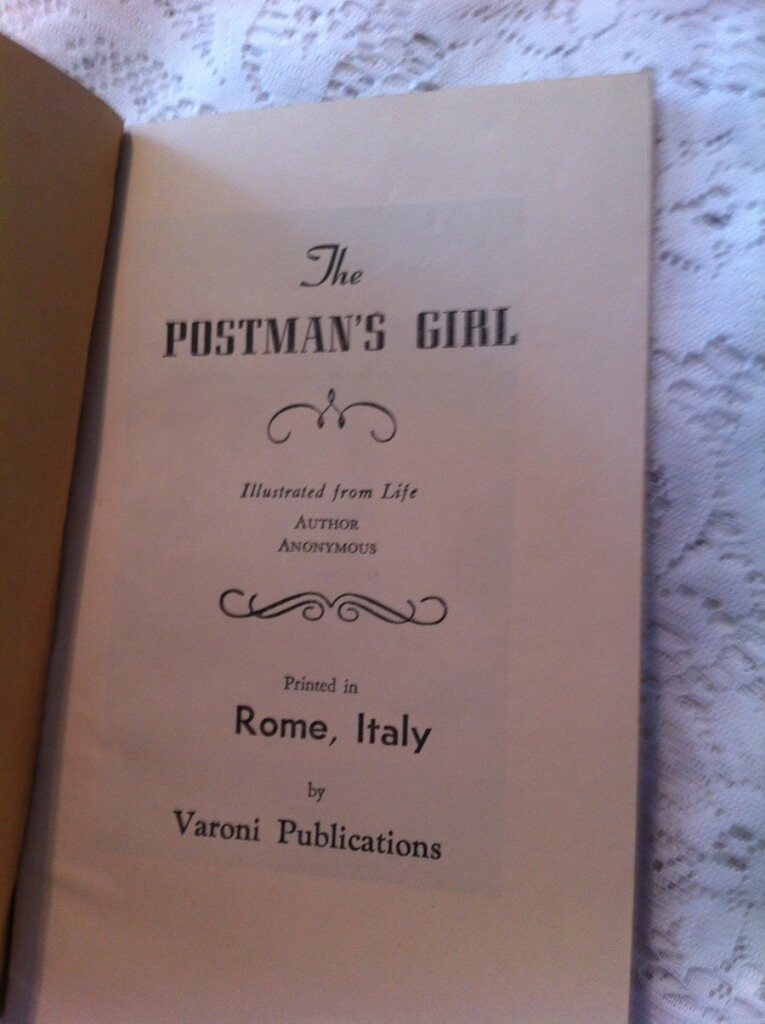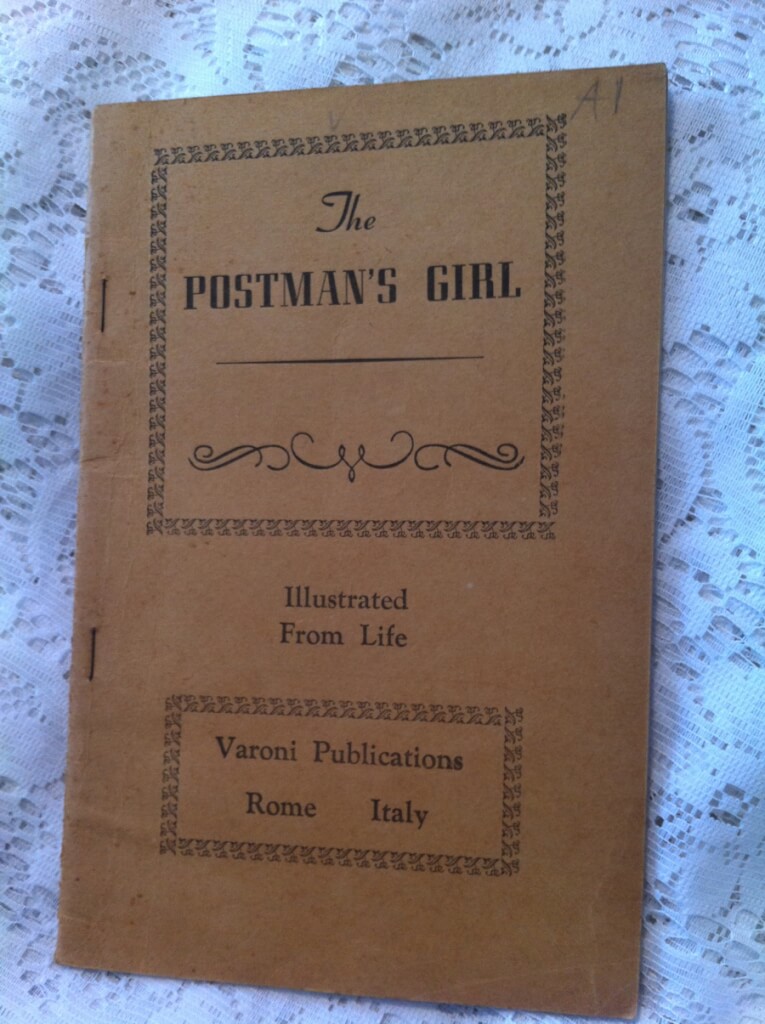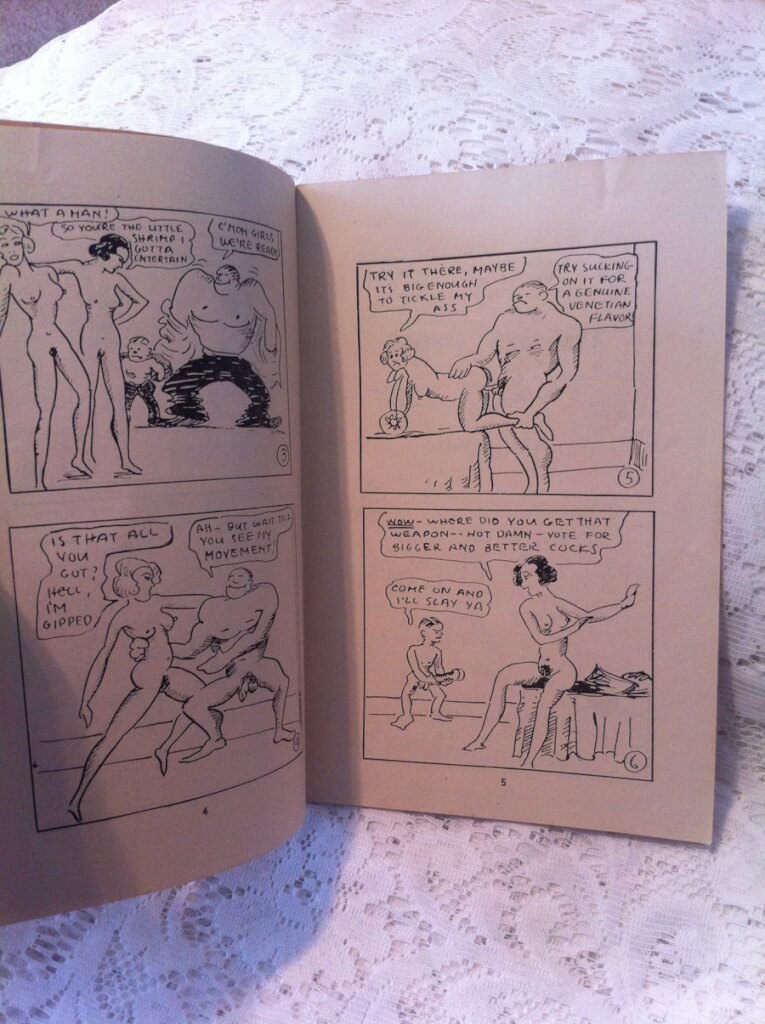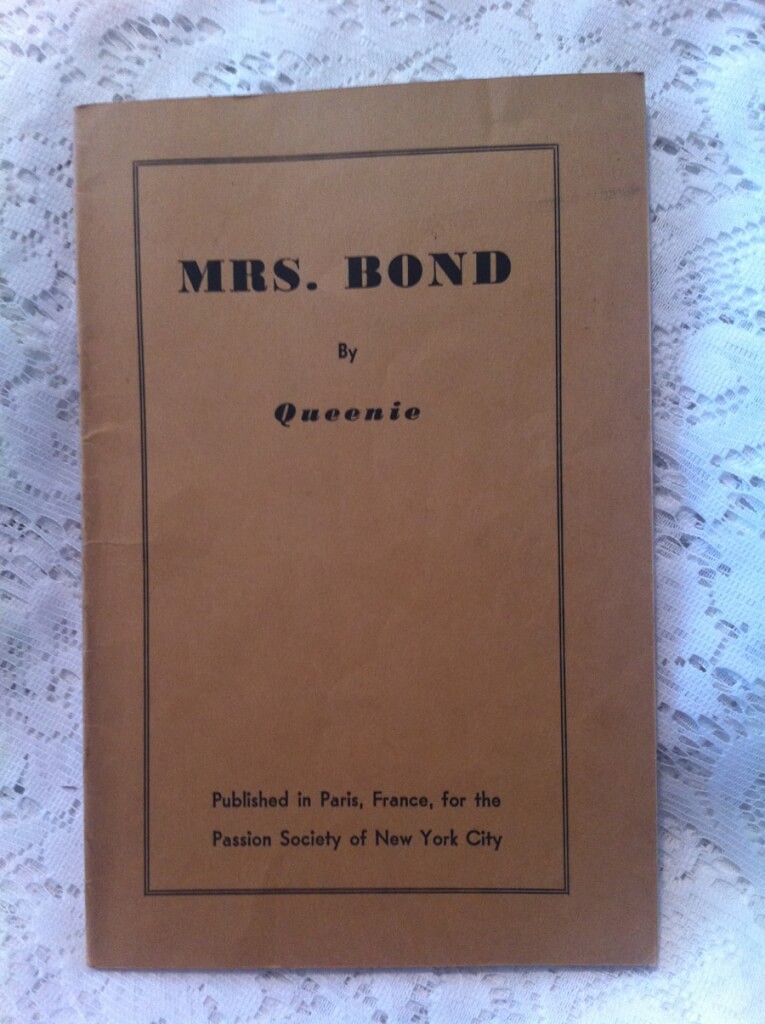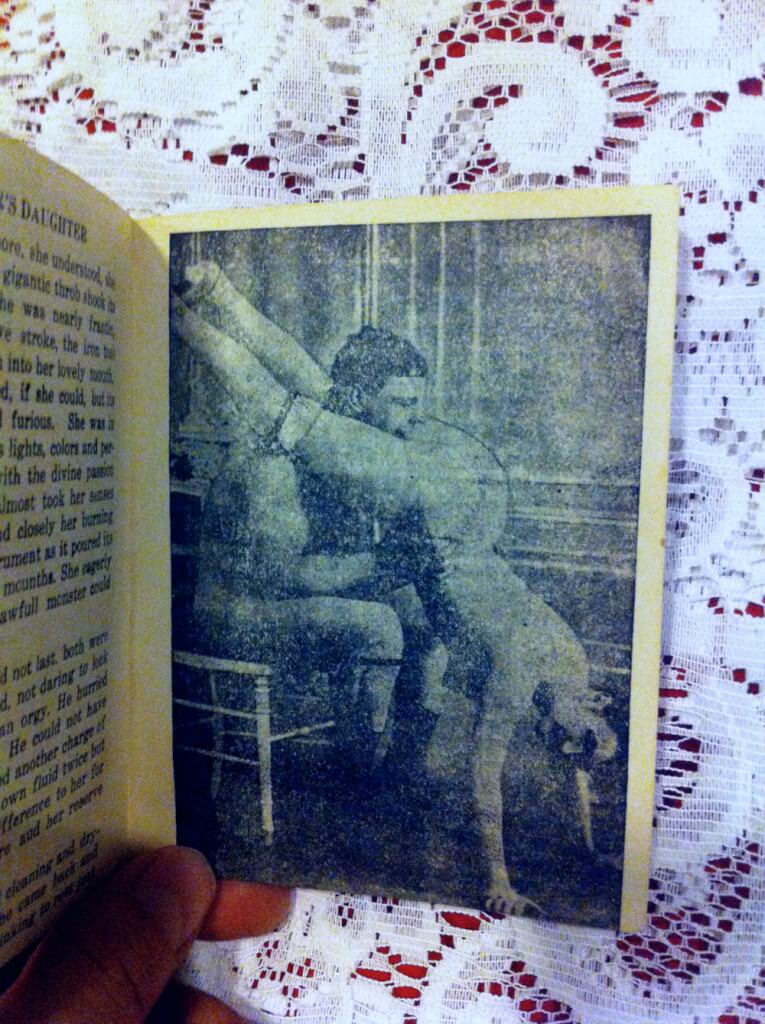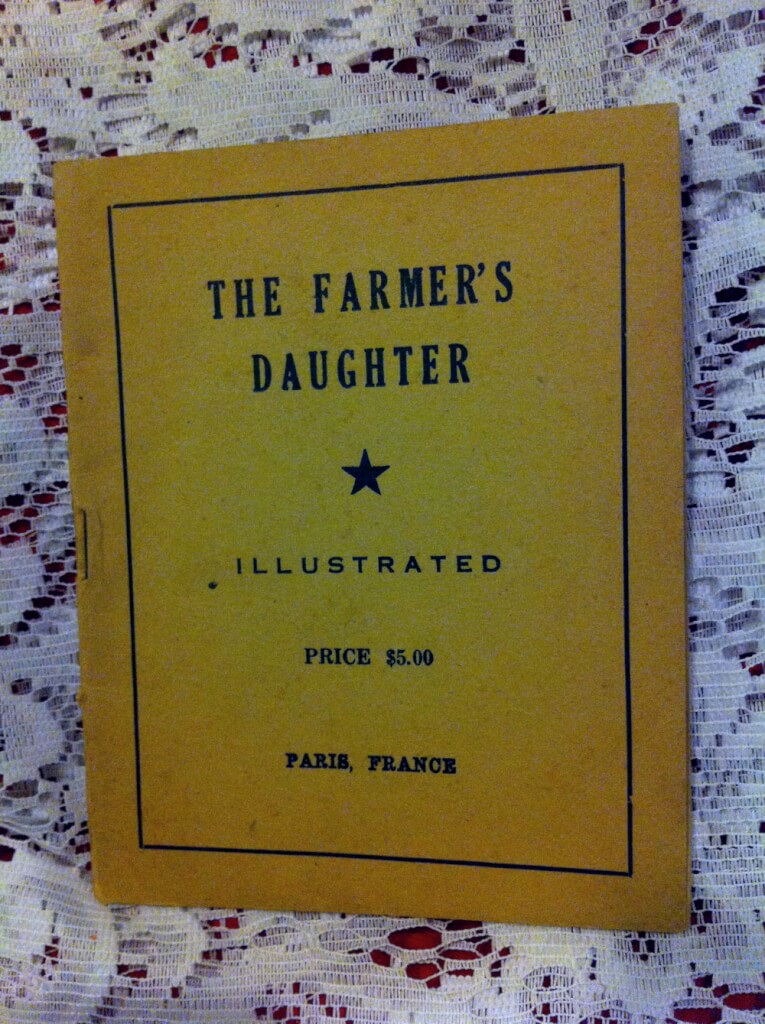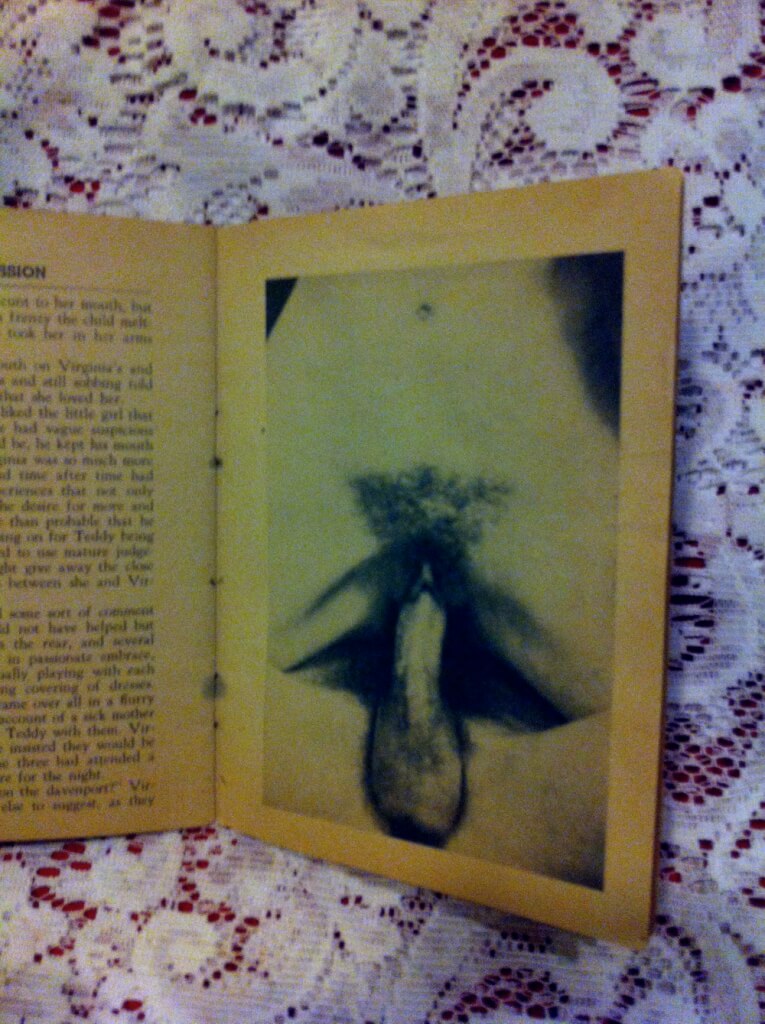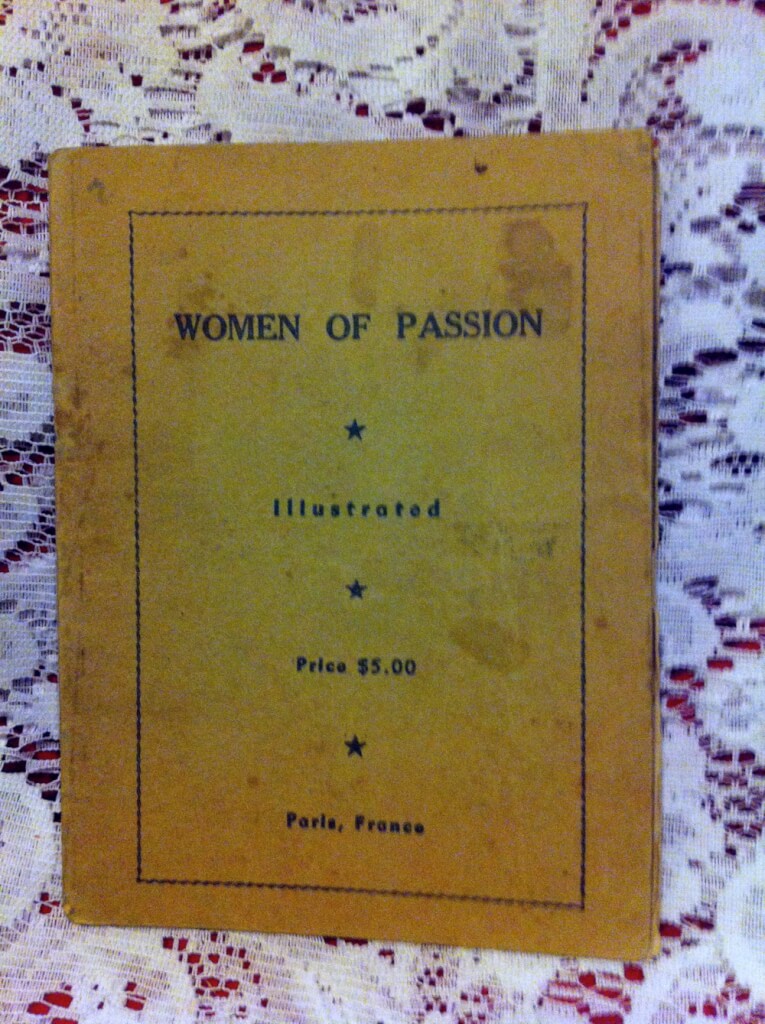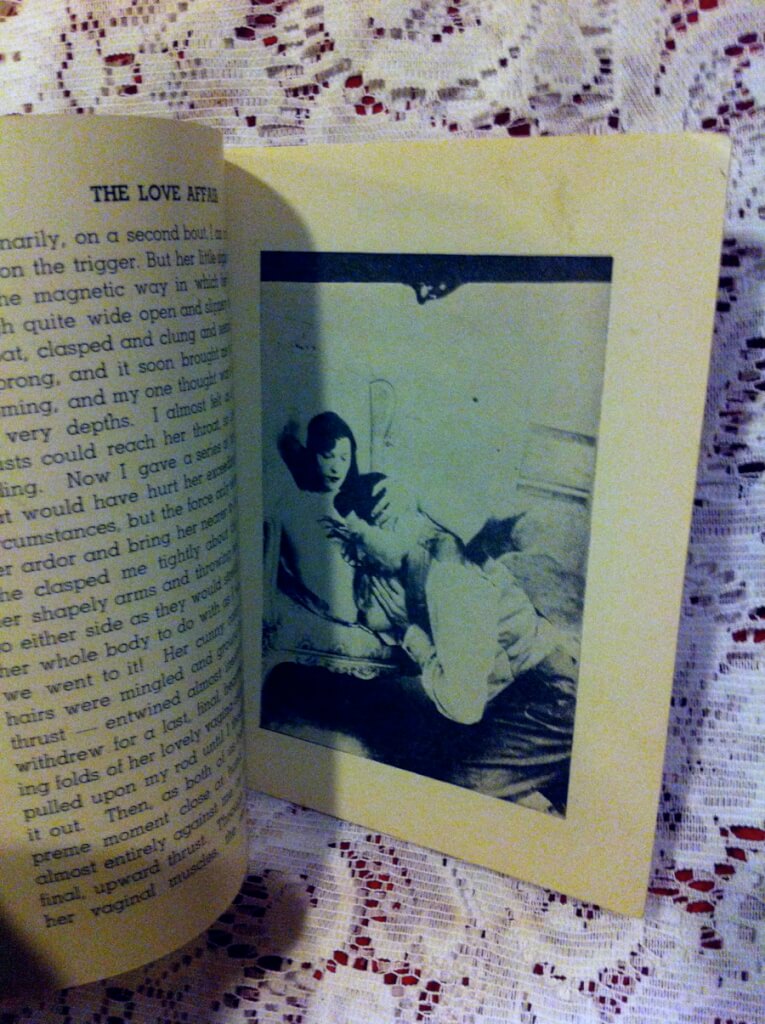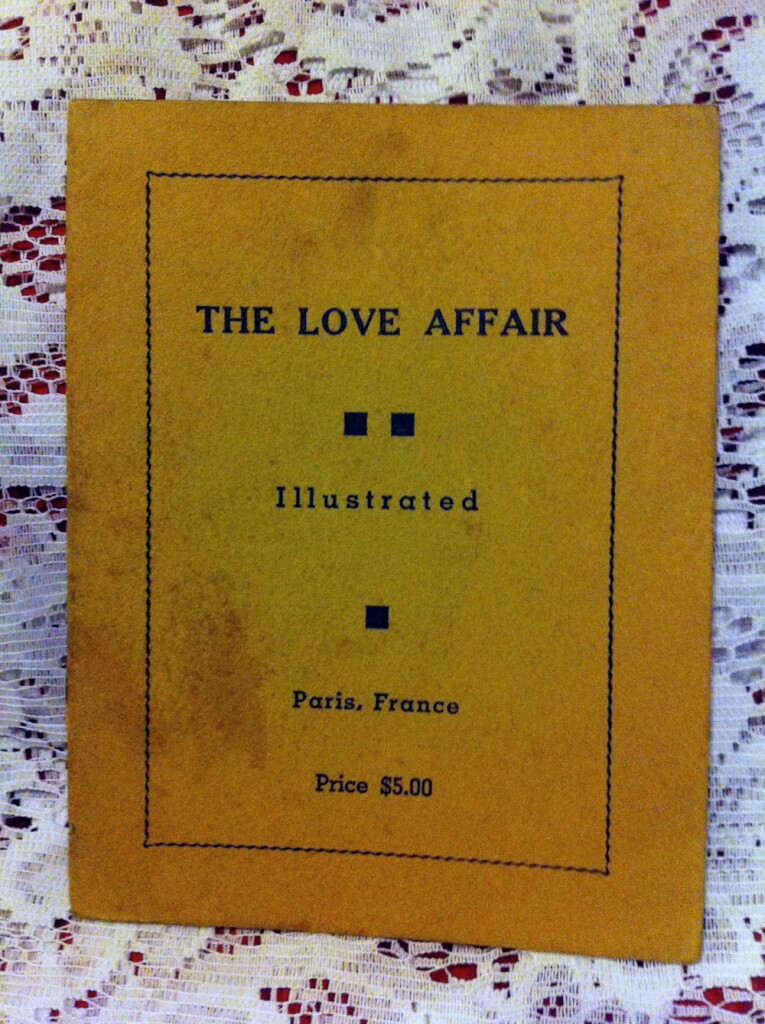-
 The Rahnghild Edition of: Venus in Furs, Leopold von Sacher-Masoch, illustrated by Rahnghild [Susan Inez Aguerra?] (William Faro, Inc [Samuel Roth, New York], 1932) 6.5"x9.25", 240pp, brown cloth boards with pasted title on spine, some soiling on front paste-down but overall a clean copy, beautiful art-deco illustrations throughout. Venus in Furs (German: Venus im Pelz) is a novella by Leopold Ritter von Sacher-Masoch (1836-1895), an Austrian writer and journalist. It is now his best known work and because of its themes the term masochism is derived from his name, coined by the Austrian psychiatrist, Krafft-Ebing. The novel was to be part of an epic series that Sacher-Masoch envisioned called Legacy of Cain. Venus in Furs was part of Love, the first volume of the series. It was published in 1870. The novel draws themes, like female dominance and sadomasochism, and character inspiration heavily from Sacher-Masoch’s own life. Wanda von Dunajew, the novel’s central female character, was modelled after his mistress Baroness Fanny Pistor. In December 1869 the two signed a contract making him her slave for a period of 6 months. In 1873, after the publication of Venus in Furs, Sacher-Masoch married Aurora von Rümelin who he pressured to continue the lifestyle he wrote about in his book. After 10 years they divorced. Rümelin, using the pseudonym of the books title character, “Wanda von Dunajew”, wrote Meine Lebensbeichte (My Life Confession) published in 1906. It detailed Sacher-Masoch’s private life and her relationship with him. During his lifetime, Sacher-Masoch was well known as a man of letters, a utopian thinker who espoused socialist and humanist ideals in his fiction and non-fiction. Most of his works remain untranslated into English. Until recently, his novel Venus in Furs was his only book commonly available in English. Samuel Roth (1893-1974) was an infamous American publisher and writer. He had a bookstore, Poetry Shop in the West Village section of Greenwich Villiage. He was the plaintiff in Roth v. United States (1957), which was a key Supreme Court ruling on freedom of sexual expression. He was also repeatedly convicted for publishing and distributing obscene material.
The Rahnghild Edition of: Venus in Furs, Leopold von Sacher-Masoch, illustrated by Rahnghild [Susan Inez Aguerra?] (William Faro, Inc [Samuel Roth, New York], 1932) 6.5"x9.25", 240pp, brown cloth boards with pasted title on spine, some soiling on front paste-down but overall a clean copy, beautiful art-deco illustrations throughout. Venus in Furs (German: Venus im Pelz) is a novella by Leopold Ritter von Sacher-Masoch (1836-1895), an Austrian writer and journalist. It is now his best known work and because of its themes the term masochism is derived from his name, coined by the Austrian psychiatrist, Krafft-Ebing. The novel was to be part of an epic series that Sacher-Masoch envisioned called Legacy of Cain. Venus in Furs was part of Love, the first volume of the series. It was published in 1870. The novel draws themes, like female dominance and sadomasochism, and character inspiration heavily from Sacher-Masoch’s own life. Wanda von Dunajew, the novel’s central female character, was modelled after his mistress Baroness Fanny Pistor. In December 1869 the two signed a contract making him her slave for a period of 6 months. In 1873, after the publication of Venus in Furs, Sacher-Masoch married Aurora von Rümelin who he pressured to continue the lifestyle he wrote about in his book. After 10 years they divorced. Rümelin, using the pseudonym of the books title character, “Wanda von Dunajew”, wrote Meine Lebensbeichte (My Life Confession) published in 1906. It detailed Sacher-Masoch’s private life and her relationship with him. During his lifetime, Sacher-Masoch was well known as a man of letters, a utopian thinker who espoused socialist and humanist ideals in his fiction and non-fiction. Most of his works remain untranslated into English. Until recently, his novel Venus in Furs was his only book commonly available in English. Samuel Roth (1893-1974) was an infamous American publisher and writer. He had a bookstore, Poetry Shop in the West Village section of Greenwich Villiage. He was the plaintiff in Roth v. United States (1957), which was a key Supreme Court ruling on freedom of sexual expression. He was also repeatedly convicted for publishing and distributing obscene material. -
Out of stock
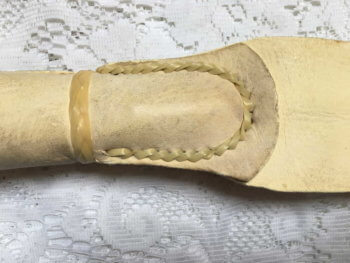
 White Rebenque 23" long, flap is 12", white leather with rawhide/sinew stitching and decorations, slight yellowing from age. Beautiful hand-made white leather rebenque 50+ years old. It has decorative rawhide work on the handle and on the strap, using two colors of rawhide. The handle is textured by wrapping a wet cord around it, leaving an imprint on the leather. Rebenque is the name in Brazilian Portuguese for a type of whip used by gauchos in South America. Especially in Argentina, it is the traditional riding, fighting, and punishing whip of the gaucho. It consists of a rawhide wrapped wooden handle with a thong made of a leather strap a little longer than the handle. The wide strap made the rebenque an instrument less severe on the horse than the European riding crop. As the gaucho was never far from the horse, the rebenque was always on him. When not in use, he made a knot with the strap and held the rebenque lazily by the wrist strap with the middle fingers of his hand, or hung it from the handle of his facón knife (as he used the large knife almost horizontally at his back, held by the belt or waistband, the handle protruded from his right side). The rebenque was used also for fighting, as a weapon by itself, when the fight did not merit a knife, or with the strap rolled on his left hand and the handle hanging, as a secondary weapon to the knife in his right hand. Of course, it was also used for domestic punishments, and for quasi-judicial chastisement. A couple of lashes with the rebenque on the bare legs were widely used as a punishment for children, even in the urban areas.
White Rebenque 23" long, flap is 12", white leather with rawhide/sinew stitching and decorations, slight yellowing from age. Beautiful hand-made white leather rebenque 50+ years old. It has decorative rawhide work on the handle and on the strap, using two colors of rawhide. The handle is textured by wrapping a wet cord around it, leaving an imprint on the leather. Rebenque is the name in Brazilian Portuguese for a type of whip used by gauchos in South America. Especially in Argentina, it is the traditional riding, fighting, and punishing whip of the gaucho. It consists of a rawhide wrapped wooden handle with a thong made of a leather strap a little longer than the handle. The wide strap made the rebenque an instrument less severe on the horse than the European riding crop. As the gaucho was never far from the horse, the rebenque was always on him. When not in use, he made a knot with the strap and held the rebenque lazily by the wrist strap with the middle fingers of his hand, or hung it from the handle of his facón knife (as he used the large knife almost horizontally at his back, held by the belt or waistband, the handle protruded from his right side). The rebenque was used also for fighting, as a weapon by itself, when the fight did not merit a knife, or with the strap rolled on his left hand and the handle hanging, as a secondary weapon to the knife in his right hand. Of course, it was also used for domestic punishments, and for quasi-judicial chastisement. A couple of lashes with the rebenque on the bare legs were widely used as a punishment for children, even in the urban areas. -
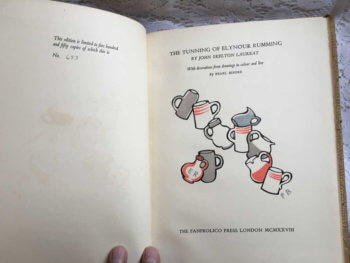
 The Tunning of Elynour Rumming, by John Skelton Laureat, "with decorations from the drawings in colour and line by Pearl Binder" (Fanfrolico Press, London, 1928, #433/550 hand written limitation) 7.75" x 11.25", 47pp, hardbound, coarse fiber on boards (burlap?), hand laid paper, artfully done, in good plus condition for age and for the unconventional binding materials The Tunning of Elynour Rummyng is a long raucous poem written by English poet John Skelton(1463-1529). The poem was first printed by Richard Lant sometime in 1550 and presents what many would consider disgusting images of rural drinking and drunkenness. For all its gritty description, Skelton has modeled the poem on Church liturgy of that time. The verse form itself closely resembles a liturgical chant. Elynour is a character in the poem who runs a "public house," or pub. Many pubs in England had the look of a home both inside and out. In the early 16th century, the male or female owner of the pub not only sold the ale, but also probably brewed it. Elynour easily acquires all her ingredients for quite acceptable ale from the local farmers in southern England where her pub was apparently located. Nevertheless, the kind of hard language which is found in the poem, is not uncommon as "bar talk." Today, much like in the 16th century, many brands of beer have been derisively referred to as "pig piss" perhaps because of beer's pale yellowish color and its bland and very slightly bitter taste. The poet says that chickens roost over Elynour's fermentation tank and drop their excrement into the froth. The yeast will sometimes form a white cap on the fermenting beer. Alcoholic beverages are also often associated with sex and indeed will sometimes reduce the inhibitions of men and women. However, Elynour advises her female customers that the ale will make them more desirable to their husbands, in part because she has the chicken excrement in the ale. Fanfrolico Press, Australia’s first ‘private press’ in the arts-and-craft tradition, was founded by Jack Lindsay, P. R. Stephensen and John Kirtley, originally in North Sydney in 1923. The press specialized in printings artful, limited editions of classics and forgotten works that were suited to the extravagant style of artist like his father, artist, sculptor and author Norman Lindsay who illustrated many of their books. Fanfrolico was scornful of modernism and with its florid style determinedly backward-looking. They did surprisingly well, despite the lack of business expertise of their young, ambitious "bohemian" owners, eking out a living despite the risky move to London in 1926 and upheavals in ownership that saw the departure in 1927 of Kirtley, and then Stephenson in 1929. Sometime in 1930 they published their last book.
The Tunning of Elynour Rumming, by John Skelton Laureat, "with decorations from the drawings in colour and line by Pearl Binder" (Fanfrolico Press, London, 1928, #433/550 hand written limitation) 7.75" x 11.25", 47pp, hardbound, coarse fiber on boards (burlap?), hand laid paper, artfully done, in good plus condition for age and for the unconventional binding materials The Tunning of Elynour Rummyng is a long raucous poem written by English poet John Skelton(1463-1529). The poem was first printed by Richard Lant sometime in 1550 and presents what many would consider disgusting images of rural drinking and drunkenness. For all its gritty description, Skelton has modeled the poem on Church liturgy of that time. The verse form itself closely resembles a liturgical chant. Elynour is a character in the poem who runs a "public house," or pub. Many pubs in England had the look of a home both inside and out. In the early 16th century, the male or female owner of the pub not only sold the ale, but also probably brewed it. Elynour easily acquires all her ingredients for quite acceptable ale from the local farmers in southern England where her pub was apparently located. Nevertheless, the kind of hard language which is found in the poem, is not uncommon as "bar talk." Today, much like in the 16th century, many brands of beer have been derisively referred to as "pig piss" perhaps because of beer's pale yellowish color and its bland and very slightly bitter taste. The poet says that chickens roost over Elynour's fermentation tank and drop their excrement into the froth. The yeast will sometimes form a white cap on the fermenting beer. Alcoholic beverages are also often associated with sex and indeed will sometimes reduce the inhibitions of men and women. However, Elynour advises her female customers that the ale will make them more desirable to their husbands, in part because she has the chicken excrement in the ale. Fanfrolico Press, Australia’s first ‘private press’ in the arts-and-craft tradition, was founded by Jack Lindsay, P. R. Stephensen and John Kirtley, originally in North Sydney in 1923. The press specialized in printings artful, limited editions of classics and forgotten works that were suited to the extravagant style of artist like his father, artist, sculptor and author Norman Lindsay who illustrated many of their books. Fanfrolico was scornful of modernism and with its florid style determinedly backward-looking. They did surprisingly well, despite the lack of business expertise of their young, ambitious "bohemian" owners, eking out a living despite the risky move to London in 1926 and upheavals in ownership that saw the departure in 1927 of Kirtley, and then Stephenson in 1929. Sometime in 1930 they published their last book. -
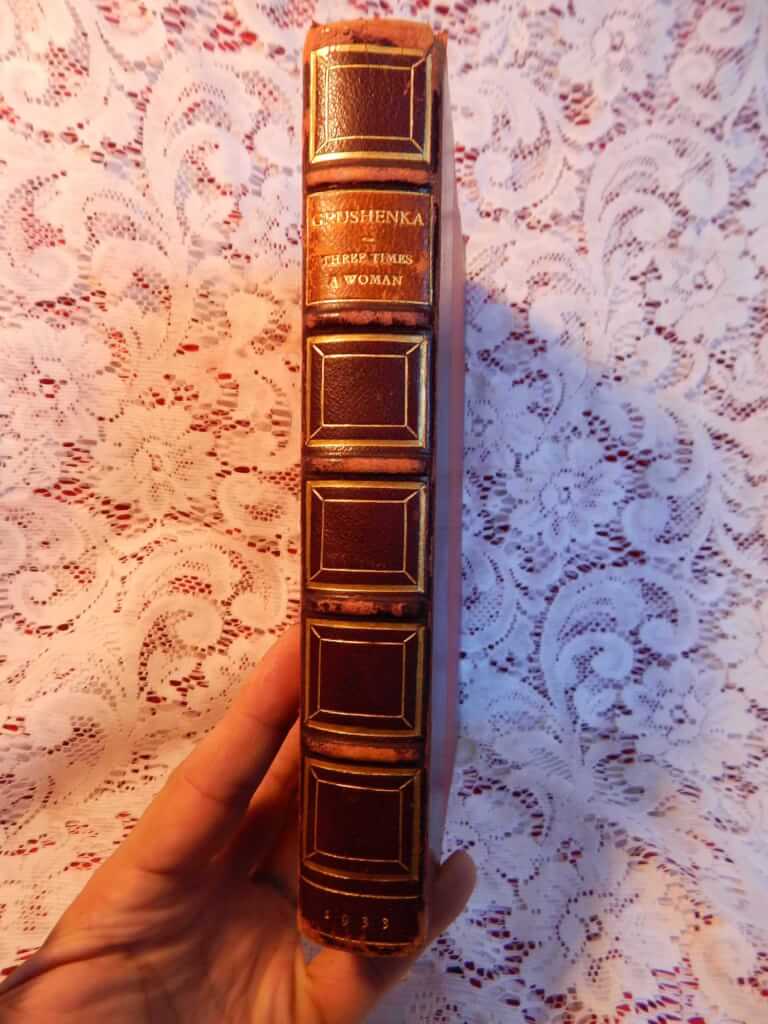
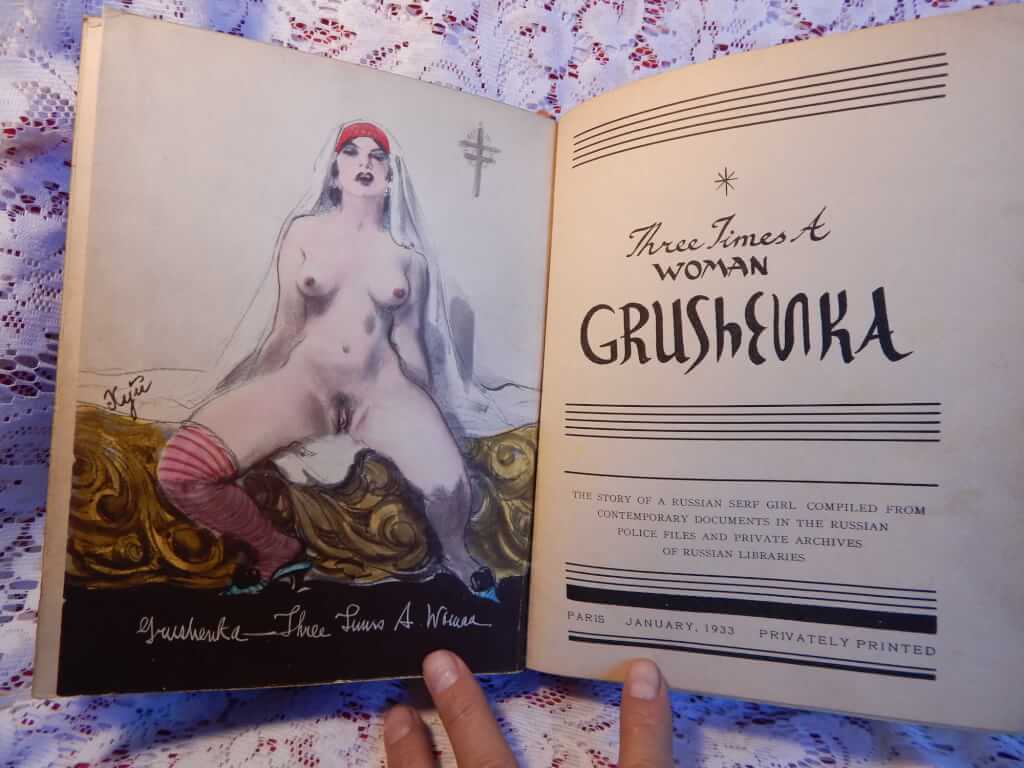 Three Times a Woman, Grushenka, anonymous [possibly Val Lewton?], illus. "a young Russian residing in Paris, who unfortunately must remain anonymous" (Privately Printed, Paris [New York], 1933) 7.25"x9", 252pp, the original "french wraps" bound into hardcover, half red morocco over red boards, gilt titles and decorations on spine, 5 raised bands, gilt boarders on leather covers, top edge gilt, other edges deckled, frontispiece in color (rare), other illustrations not present, binding split at 18/19 to 30/31pp otherwise good condition, rubbing and bumping to boards Title page reads: "The Story of a Russian Serf Girl Compiled from Contemporary Documents in the Russian Police Files and Private Archives of Russian Libraries" Originally published at New York in 1933 with a false Paris imprint. Val Lewton, the supposed author, was a well known film producer, responsible for a series of good low-budget horror movies in the 1940's by such directors as Robert Wise, Mark Robson and Jacques Tourneur. The book purports to be a flaggelation story written by a Russian living in Paris and then translated to english. The story takes place c. 1728, "shortly after the death of Peter the Great". The main character is Grushenka Pavlovsk.
Three Times a Woman, Grushenka, anonymous [possibly Val Lewton?], illus. "a young Russian residing in Paris, who unfortunately must remain anonymous" (Privately Printed, Paris [New York], 1933) 7.25"x9", 252pp, the original "french wraps" bound into hardcover, half red morocco over red boards, gilt titles and decorations on spine, 5 raised bands, gilt boarders on leather covers, top edge gilt, other edges deckled, frontispiece in color (rare), other illustrations not present, binding split at 18/19 to 30/31pp otherwise good condition, rubbing and bumping to boards Title page reads: "The Story of a Russian Serf Girl Compiled from Contemporary Documents in the Russian Police Files and Private Archives of Russian Libraries" Originally published at New York in 1933 with a false Paris imprint. Val Lewton, the supposed author, was a well known film producer, responsible for a series of good low-budget horror movies in the 1940's by such directors as Robert Wise, Mark Robson and Jacques Tourneur. The book purports to be a flaggelation story written by a Russian living in Paris and then translated to english. The story takes place c. 1728, "shortly after the death of Peter the Great". The main character is Grushenka Pavlovsk. -
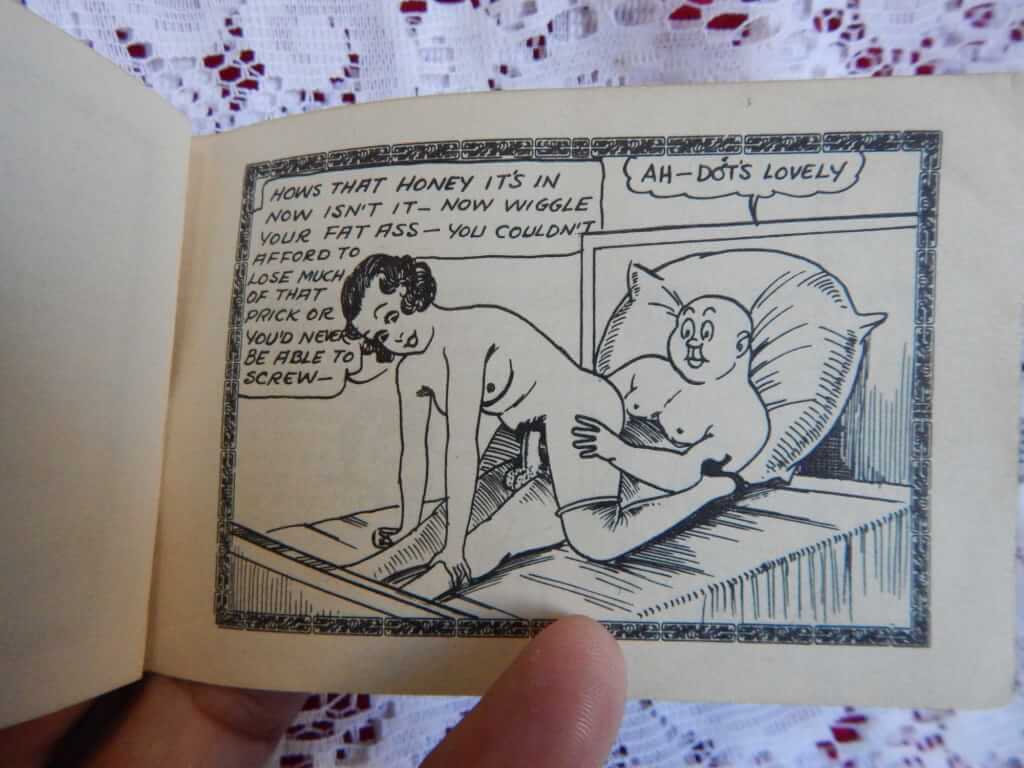
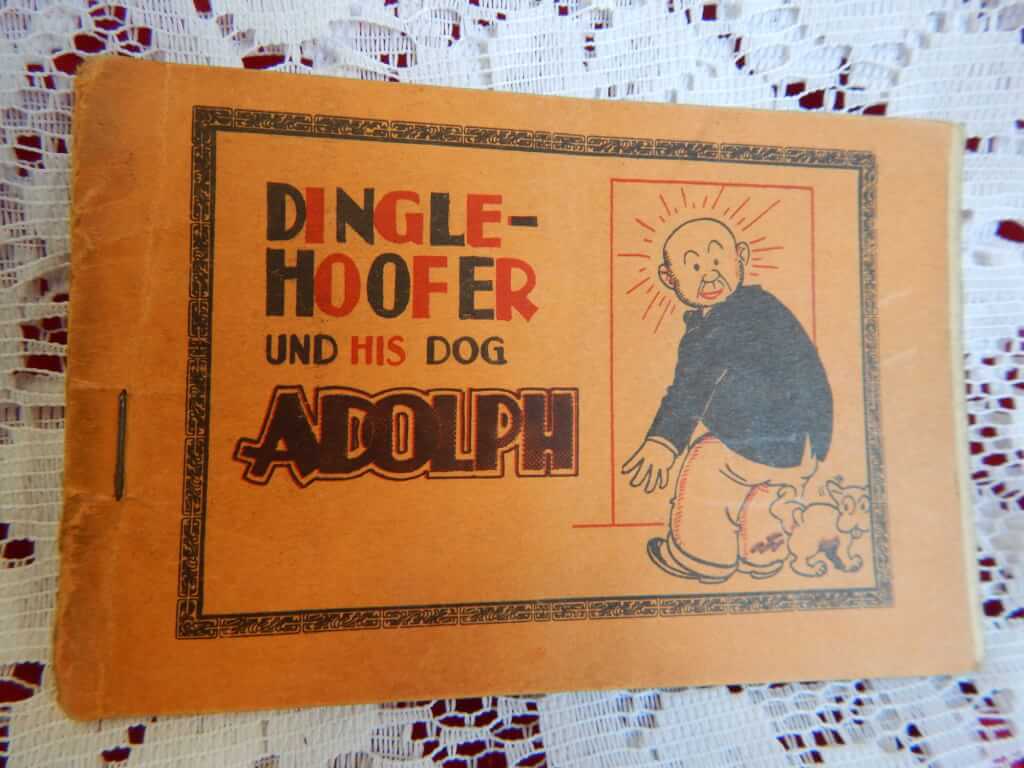 Dingle-Hoofer und his dog Adolph, (np. nd.) 4.5" x 3", 8pp. pamphlet, stapled Tijuana bibles (also known as eight-pagers, bluesies, gray-backs, Jiggs-and-Maggie books, jo-jo books, Tillie-and-Mac books, and two-by-fours) were little pornographic comic books produced in the United States from the 1920s to the early 1960s.
Dingle-Hoofer und his dog Adolph, (np. nd.) 4.5" x 3", 8pp. pamphlet, stapled Tijuana bibles (also known as eight-pagers, bluesies, gray-backs, Jiggs-and-Maggie books, jo-jo books, Tillie-and-Mac books, and two-by-fours) were little pornographic comic books produced in the United States from the 1920s to the early 1960s. -
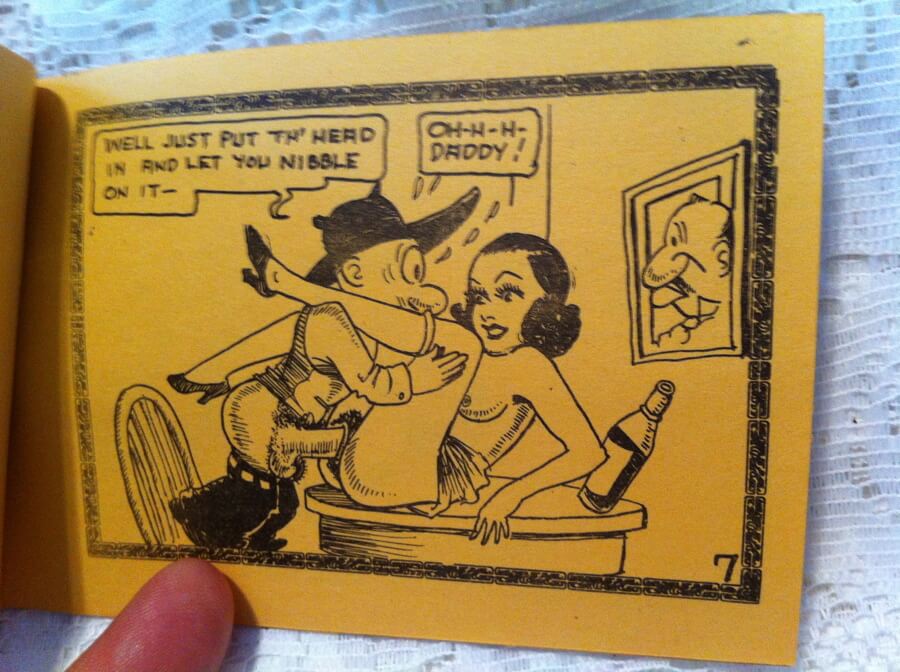
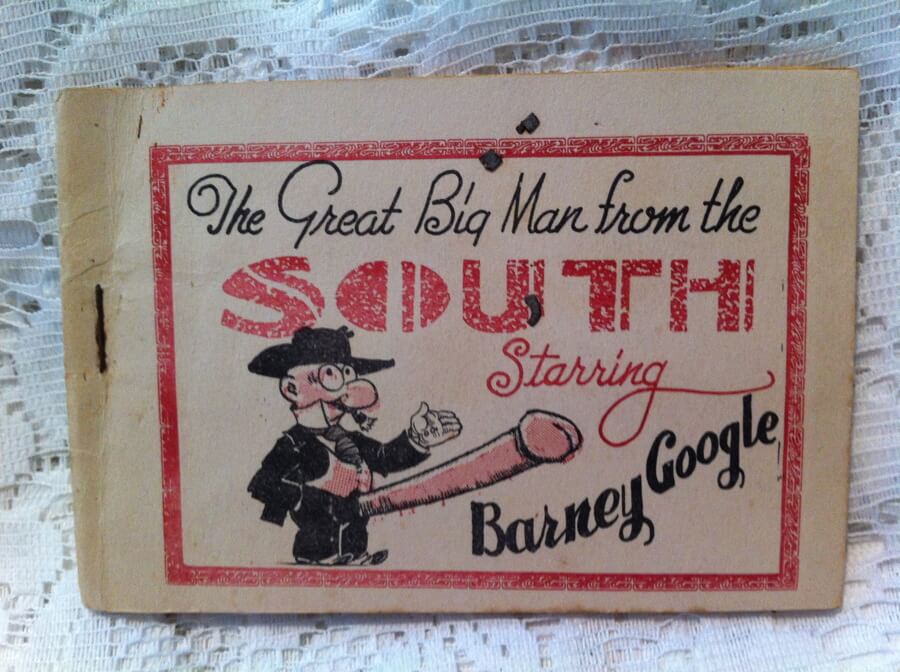 The Great Big Man from South, Staring Barney Google, (n.p. n.d.) 4.5" x 3", 8pp. pamphlet, stapled Tijuana bibles (also known as eight-pagers, bluesies, gray-backs, Jiggs-and-Maggie books, jo-jo books, Tillie-and-Mac books, and two-by-fours) were little pornographic comic books produced in the United States from the 1920s to the early 1960s. This parodies "Barney Google and Snuffy Smith" an widely read (even today) comic strip that has been around since 1919. This booklet features an unrelated erotic illustration on the back.
The Great Big Man from South, Staring Barney Google, (n.p. n.d.) 4.5" x 3", 8pp. pamphlet, stapled Tijuana bibles (also known as eight-pagers, bluesies, gray-backs, Jiggs-and-Maggie books, jo-jo books, Tillie-and-Mac books, and two-by-fours) were little pornographic comic books produced in the United States from the 1920s to the early 1960s. This parodies "Barney Google and Snuffy Smith" an widely read (even today) comic strip that has been around since 1919. This booklet features an unrelated erotic illustration on the back. -
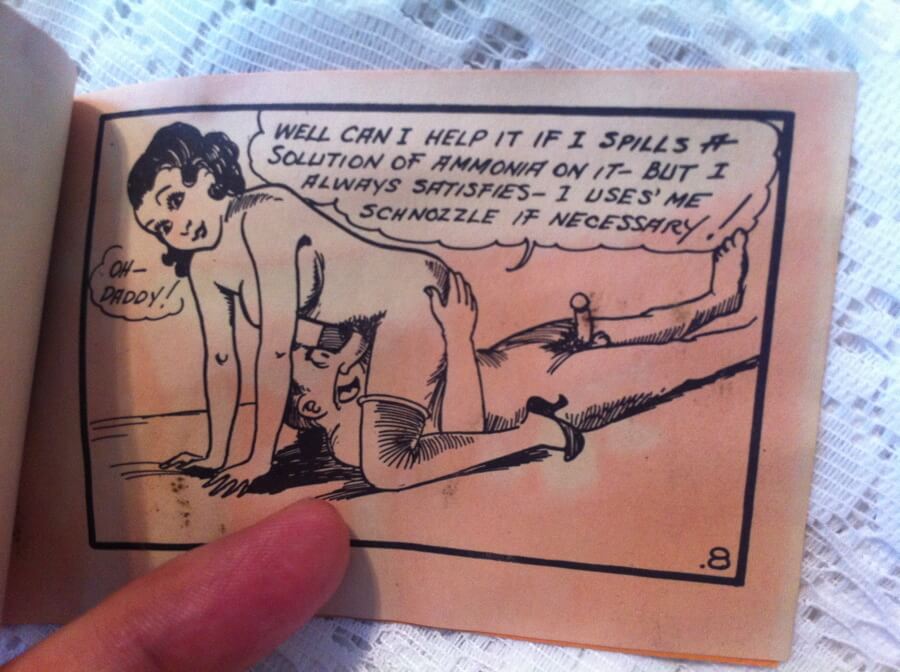
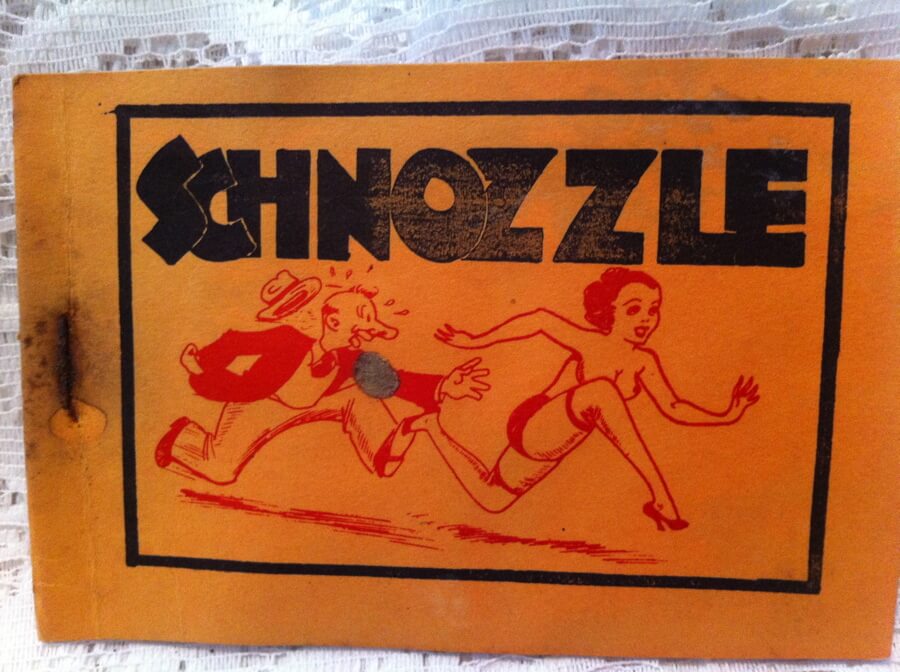 Schnozzle, (n.p. n.d.) 4.5" x 3", 8pp. pamphlet, stapled Tijuana bibles (also known as eight-pagers, bluesies, gray-backs, Jiggs-and-Maggie books, jo-jo books, Tillie-and-Mac books, and two-by-fours) were little pornographic comic books produced in the United States from the 1920s to the early 1960s. Their popularity peaked during the Great Depression era. This book parodies Jimmy Durante.
Schnozzle, (n.p. n.d.) 4.5" x 3", 8pp. pamphlet, stapled Tijuana bibles (also known as eight-pagers, bluesies, gray-backs, Jiggs-and-Maggie books, jo-jo books, Tillie-and-Mac books, and two-by-fours) were little pornographic comic books produced in the United States from the 1920s to the early 1960s. Their popularity peaked during the Great Depression era. This book parodies Jimmy Durante. -
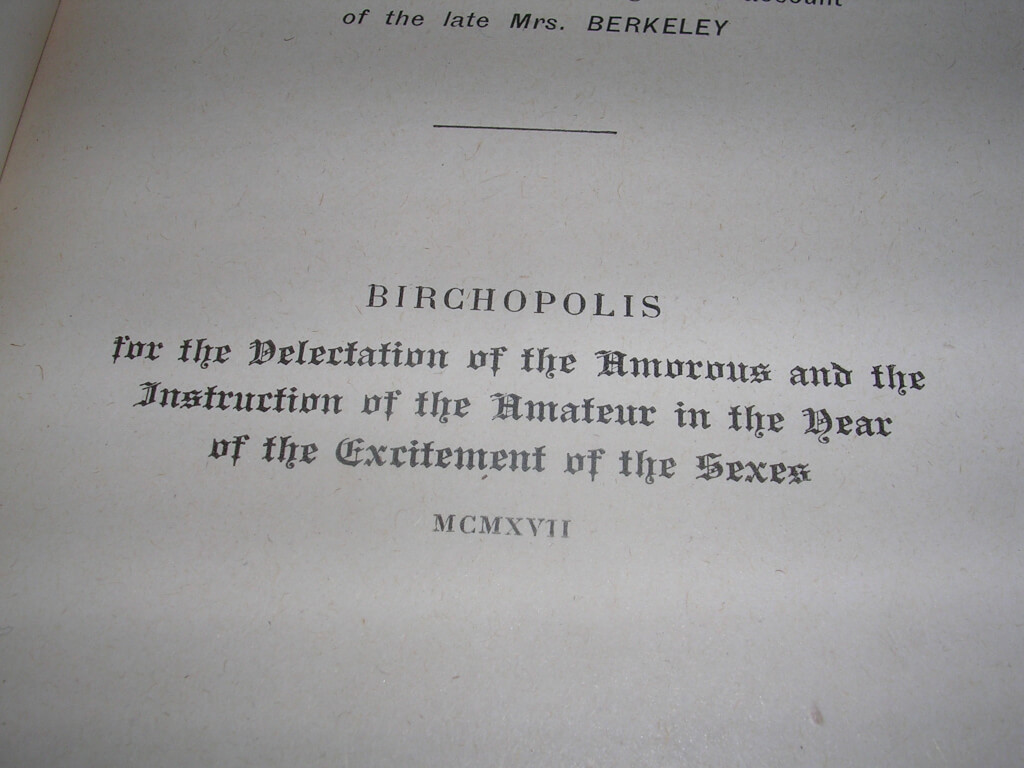
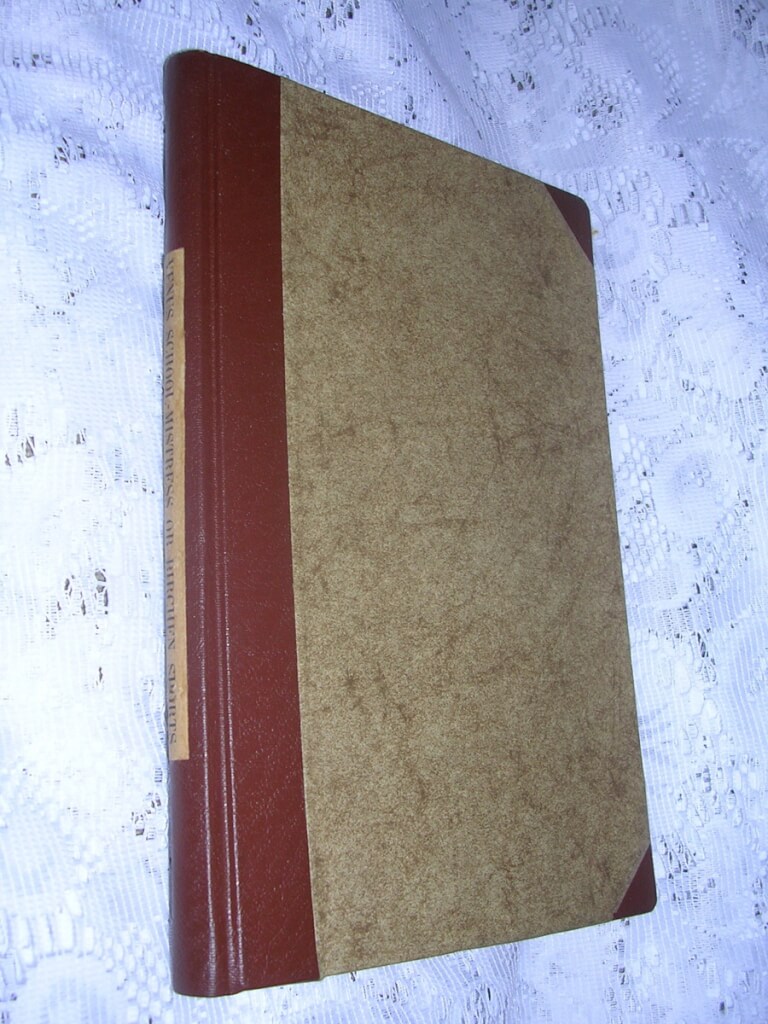 Venus School-Mistress, or Birchen Sports, anonymous, Preface by Mary Wilson (Birchopolis for the Delectation of the Amorous and the Instruction of the Amateur in the Year of the Excitement of the Sexes. 1917 [this is most-likely a newly rebound facsimile reprint of said edition, np nd]) 6 3/4" X 4 5/8", 167pp, hardbound no DJ, half-leather, very good condition, owner's signature in blue ink. According to Ashbee, this work probably dates to 1808-10 (by R. Birch, Translator of Manon's Memoirs, printed for Philosemus). It also appears in 1820 and then in 1830, published by George Cannon. This seems to be a reprint of a 1927 version. This edition reads "best and only complete edition" and "Reprinted from the edition of 1788 with a Preface by Mary Wilson, containing some account of the late Mrs. Berkeley". Also contained in this edition are The Charm, The Night School, The Beautiful Jewess, The Butcher's Daughter, Moral Reflections, The Questions for Casuists, Betsy Thoughtless and an extensive appendix with many articles about flagellation.
Venus School-Mistress, or Birchen Sports, anonymous, Preface by Mary Wilson (Birchopolis for the Delectation of the Amorous and the Instruction of the Amateur in the Year of the Excitement of the Sexes. 1917 [this is most-likely a newly rebound facsimile reprint of said edition, np nd]) 6 3/4" X 4 5/8", 167pp, hardbound no DJ, half-leather, very good condition, owner's signature in blue ink. According to Ashbee, this work probably dates to 1808-10 (by R. Birch, Translator of Manon's Memoirs, printed for Philosemus). It also appears in 1820 and then in 1830, published by George Cannon. This seems to be a reprint of a 1927 version. This edition reads "best and only complete edition" and "Reprinted from the edition of 1788 with a Preface by Mary Wilson, containing some account of the late Mrs. Berkeley". Also contained in this edition are The Charm, The Night School, The Beautiful Jewess, The Butcher's Daughter, Moral Reflections, The Questions for Casuists, Betsy Thoughtless and an extensive appendix with many articles about flagellation. -

 Woman and her Master; an Englishwoman's Adventures in the Madhi's Camp, Jean de Villiot [George Grassal (Hugues Rebell)] (Charles Carrington, Paris, 1904 [printed "Alençon, Imprimerie Veuve Félix Guy et Cie"] stated limited edition 750 copies) 6 3/8" X 5", 301pp, hardbound, red pebbled cloth boards, gilt title on front, no writing on spine, sewn signatures, good condition, some minor bumping and rubbing Jean de Villiot was a pseudonym used by several authors and compilers working for the publisher Charles Carrington writing novels and "studies" concerning flagellation, including Hugues Rebell (Georges Grassal), Hector France, Stéphane Arnoulin and Charles Carrington, himself. This novel is attributed to George Grassal (Hugues Rebell) originally written in French, in 1902, as "La Femme et son maître" (The Woman and her Master). In 1904 "Woman and her Master" was published in English by Charles Carrington. Often these editions were printed unbound and sent to the bookseller to bind to the specifications of their customers. "this book is a witness to the horrors that the power of England has in some degree blotted out by the erection of Schools at Khartoum and Omdurman."
Woman and her Master; an Englishwoman's Adventures in the Madhi's Camp, Jean de Villiot [George Grassal (Hugues Rebell)] (Charles Carrington, Paris, 1904 [printed "Alençon, Imprimerie Veuve Félix Guy et Cie"] stated limited edition 750 copies) 6 3/8" X 5", 301pp, hardbound, red pebbled cloth boards, gilt title on front, no writing on spine, sewn signatures, good condition, some minor bumping and rubbing Jean de Villiot was a pseudonym used by several authors and compilers working for the publisher Charles Carrington writing novels and "studies" concerning flagellation, including Hugues Rebell (Georges Grassal), Hector France, Stéphane Arnoulin and Charles Carrington, himself. This novel is attributed to George Grassal (Hugues Rebell) originally written in French, in 1902, as "La Femme et son maître" (The Woman and her Master). In 1904 "Woman and her Master" was published in English by Charles Carrington. Often these editions were printed unbound and sent to the bookseller to bind to the specifications of their customers. "this book is a witness to the horrors that the power of England has in some degree blotted out by the erection of Schools at Khartoum and Omdurman." -

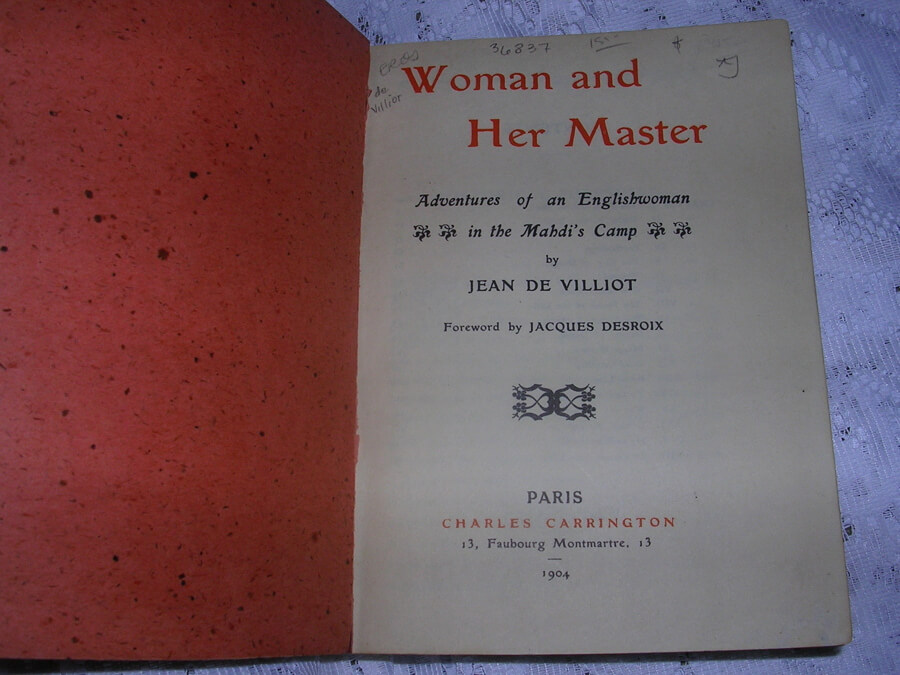 Jean de Villiot [George Grassal (Hugues Rebell)] (Charles Carrington, Paris, 1904 [printed "Alençon, Imprimerie Veuve Félix Guy et Cie"]) 6 3/8" X 5", 301pp, soft bound, red cloth spine with titling to paper label, orange paper covers, good condition, crease in lower corner of cover and inch tear along gutter's edge, slightly yellow pages
Jean de Villiot [George Grassal (Hugues Rebell)] (Charles Carrington, Paris, 1904 [printed "Alençon, Imprimerie Veuve Félix Guy et Cie"]) 6 3/8" X 5", 301pp, soft bound, red cloth spine with titling to paper label, orange paper covers, good condition, crease in lower corner of cover and inch tear along gutter's edge, slightly yellow pages -
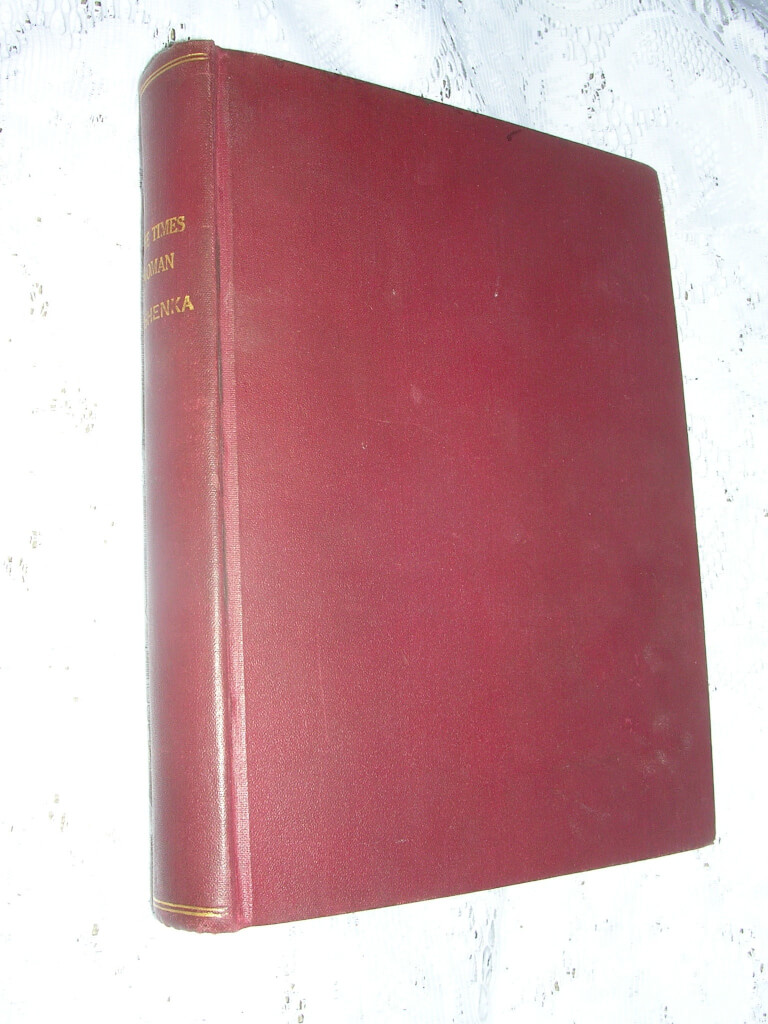
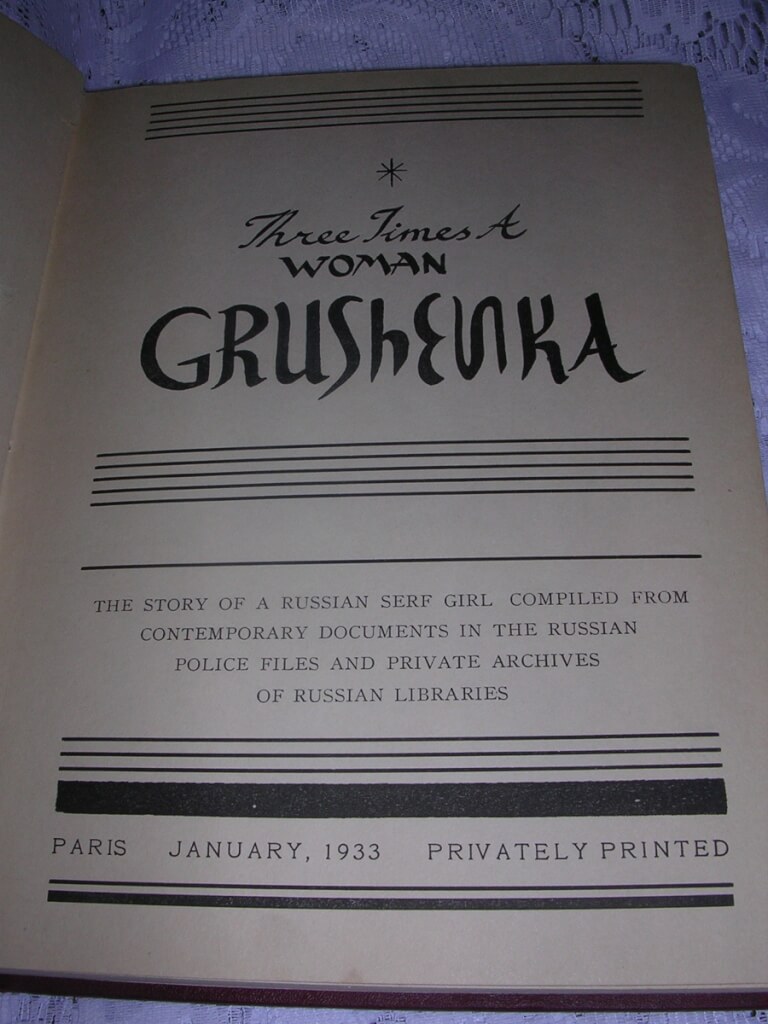 Three Times a Woman, Grushenka, anonymous [possibly Val Lewton?], illus. "a young Russain residing in Paris, who unfortunately must remain annonymous" (Privately Printed, London [New York], 1933 [probably a reprint as it does not have illustrations of the original]) 9 7/8" X 6 7/8", 252pp, hardbound no DJ, red boards with gilt title on spine, good condition, minor wear and bumps to cover, binding tight, bookplate of Erwin A. Weiss, D.D.S. Title page reads: "The Story of a Russian Serf Girl Compiled from Contemporary Documents in the Russian Police Files and Private Archives of Russian Libraries" Originally published at New York in 1933 with a false Paris imprint. Val Lewton, the supposed author, was a well known film producer, responsible for a series of good low-budget horror movies in the 1940's by such directors as Robert Wise, Mark Robson and Jacques Tourneur. The book purports to be a flaggelation story written by a Russian living in Paris and then translated to english. The story takes place c. 1728, "shortly after the death of Peter the Great". The main character is Grushenka Pavlovsk.
Three Times a Woman, Grushenka, anonymous [possibly Val Lewton?], illus. "a young Russain residing in Paris, who unfortunately must remain annonymous" (Privately Printed, London [New York], 1933 [probably a reprint as it does not have illustrations of the original]) 9 7/8" X 6 7/8", 252pp, hardbound no DJ, red boards with gilt title on spine, good condition, minor wear and bumps to cover, binding tight, bookplate of Erwin A. Weiss, D.D.S. Title page reads: "The Story of a Russian Serf Girl Compiled from Contemporary Documents in the Russian Police Files and Private Archives of Russian Libraries" Originally published at New York in 1933 with a false Paris imprint. Val Lewton, the supposed author, was a well known film producer, responsible for a series of good low-budget horror movies in the 1940's by such directors as Robert Wise, Mark Robson and Jacques Tourneur. The book purports to be a flaggelation story written by a Russian living in Paris and then translated to english. The story takes place c. 1728, "shortly after the death of Peter the Great". The main character is Grushenka Pavlovsk. -
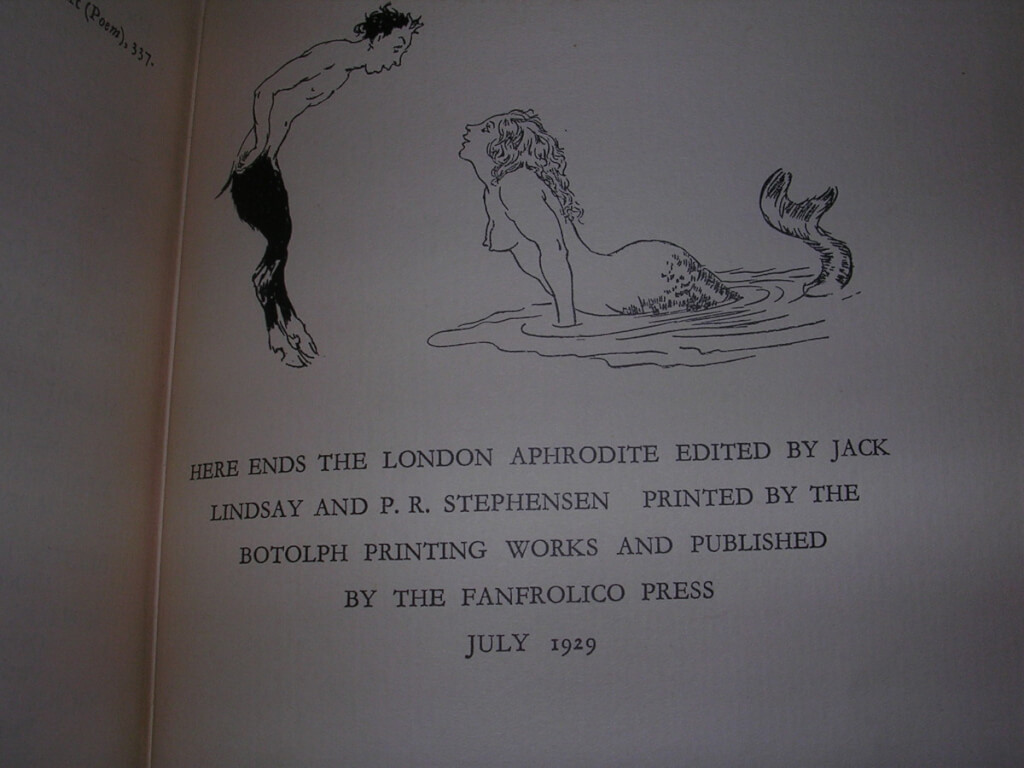
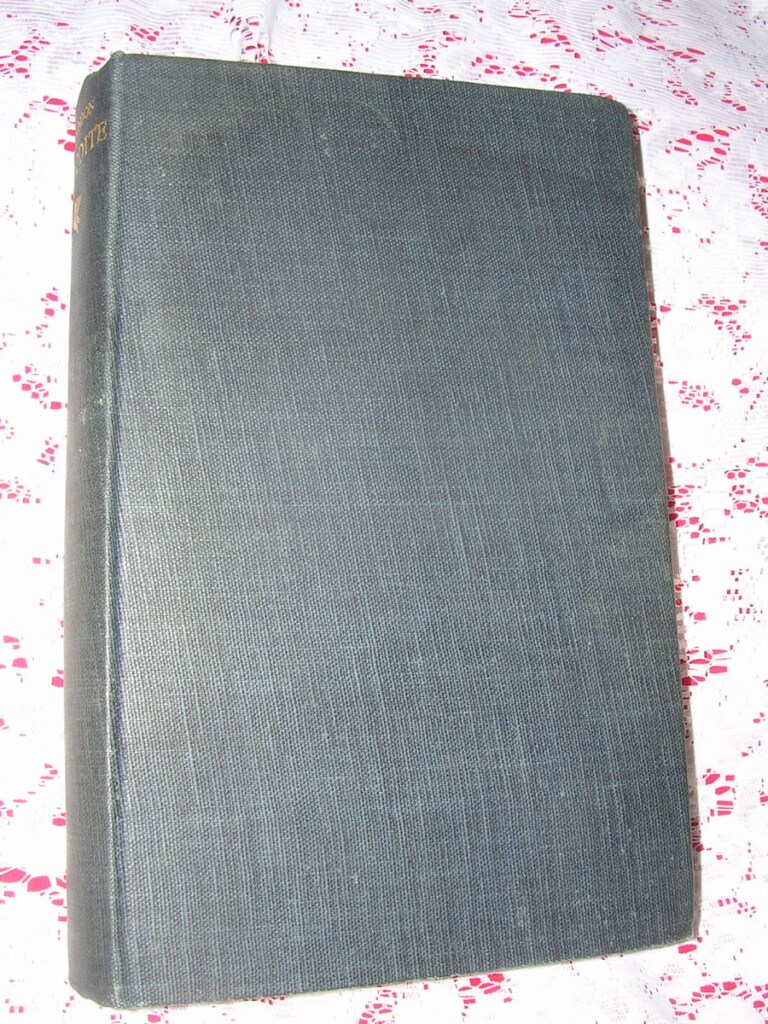 The London Aphrodite, ed. Jack Lindsay and P.R. Stephensen (Fanfrolico Press, "printed by the Botolph Printing Works", London, 1929) 9.75" X 6.24", 496pp plus index. hardcover no DJ, blue cloth boards, gilt title on spine, top edge gilt. Excellent condition. A periodical edited by Jack Lindsay and P.R. Stephensen and published in London by the Fanfrolico Press, ran for a planned six issues 1928-29. Self-described as "A Miscellany of Poems Stories and Essays by Various Hands Eminent or Rebellious." Named as a rebuttal of the conservatism of J.C. Squire's London Mercury, it was committed to the same aesthetic attitudes as Vision. Some prominent English authors, including Aldous Huxley, contributed, although the majority were Australian. Jack Lindsay, the dominant force, used the pseudonym 'Peter Meadows' for several articles. Other Australian contributors were Norman Lindsay, Hugh McCrae, Kenneth Slessor, Philip Lindsay, Brian Penton, P.R. Stephensen, Les Robinson, W.J. Turner, Bertram Higgins, E.J. Rupert Atkinson and Edith Hepburn ('Anna Wickham'). This is a compilation of those issues in book form, published by Fanfrolico Press.
The London Aphrodite, ed. Jack Lindsay and P.R. Stephensen (Fanfrolico Press, "printed by the Botolph Printing Works", London, 1929) 9.75" X 6.24", 496pp plus index. hardcover no DJ, blue cloth boards, gilt title on spine, top edge gilt. Excellent condition. A periodical edited by Jack Lindsay and P.R. Stephensen and published in London by the Fanfrolico Press, ran for a planned six issues 1928-29. Self-described as "A Miscellany of Poems Stories and Essays by Various Hands Eminent or Rebellious." Named as a rebuttal of the conservatism of J.C. Squire's London Mercury, it was committed to the same aesthetic attitudes as Vision. Some prominent English authors, including Aldous Huxley, contributed, although the majority were Australian. Jack Lindsay, the dominant force, used the pseudonym 'Peter Meadows' for several articles. Other Australian contributors were Norman Lindsay, Hugh McCrae, Kenneth Slessor, Philip Lindsay, Brian Penton, P.R. Stephensen, Les Robinson, W.J. Turner, Bertram Higgins, E.J. Rupert Atkinson and Edith Hepburn ('Anna Wickham'). This is a compilation of those issues in book form, published by Fanfrolico Press. -
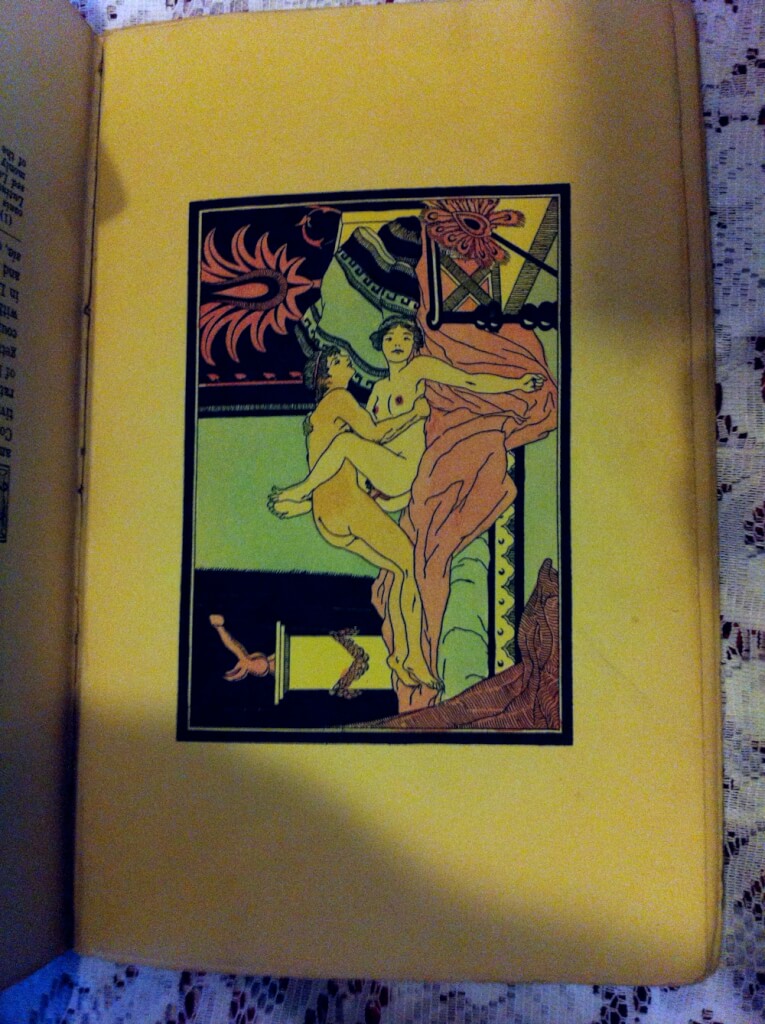
 the Dialogues of Luisa Sigea, Nicolas Chorier (Isadore Liseux, Paris 1890 [most likely an American pirated copy from the 1920-30's] illustrator unknown) 8.75" X 6", xx 296pp., bound in thin green boards and green tape on spine. Fair condition, binding is loose in places, part of first signature taped in place, rips in spine. Explicit color illustrations. Bookplate of Theodor Reich. In six dialogues, Tullia, who is 26, initiates her 15 year old cousin, Ottavia, in the art of sexual pleasure. The first four dialogues, which are fairly short, focus on tribadism and defloration. The longer fifth and six dialogues introduce flagellation, contractual submission, group sex, and anal sex. (I. The skirmish; II. Tribadicon; III. Fabric; IV. The duel; V. Pleasures; VI. Frolics and sports) Like many sexual fictions, The Dialogues of Luisa Sigea attempts to conceal the identity of its author: it purports to be based on a Latin manuscript translation of a work written originally in Spanish in the sixteenth-century by an erudite young woman, Luisa Sigea of Toledo and translated into latin by Jean Meursius of Holland. In fact, it was written c. 1660, in latin, by a Frenchman, Nicolas Chorier (1612-1692), a lawyer who wrote works on various historical and philosophical subjects. The first French translation, L\'Academie des dames, was issued in the 1680. It was first translated into English by Isidore Liseux and issued as a 3 volume set. (1. I-IV, 2. V, 3. VI). This book contains all 6 of the dialogues and some very pornographic colored illustrations.
the Dialogues of Luisa Sigea, Nicolas Chorier (Isadore Liseux, Paris 1890 [most likely an American pirated copy from the 1920-30's] illustrator unknown) 8.75" X 6", xx 296pp., bound in thin green boards and green tape on spine. Fair condition, binding is loose in places, part of first signature taped in place, rips in spine. Explicit color illustrations. Bookplate of Theodor Reich. In six dialogues, Tullia, who is 26, initiates her 15 year old cousin, Ottavia, in the art of sexual pleasure. The first four dialogues, which are fairly short, focus on tribadism and defloration. The longer fifth and six dialogues introduce flagellation, contractual submission, group sex, and anal sex. (I. The skirmish; II. Tribadicon; III. Fabric; IV. The duel; V. Pleasures; VI. Frolics and sports) Like many sexual fictions, The Dialogues of Luisa Sigea attempts to conceal the identity of its author: it purports to be based on a Latin manuscript translation of a work written originally in Spanish in the sixteenth-century by an erudite young woman, Luisa Sigea of Toledo and translated into latin by Jean Meursius of Holland. In fact, it was written c. 1660, in latin, by a Frenchman, Nicolas Chorier (1612-1692), a lawyer who wrote works on various historical and philosophical subjects. The first French translation, L\'Academie des dames, was issued in the 1680. It was first translated into English by Isidore Liseux and issued as a 3 volume set. (1. I-IV, 2. V, 3. VI). This book contains all 6 of the dialogues and some very pornographic colored illustrations. -

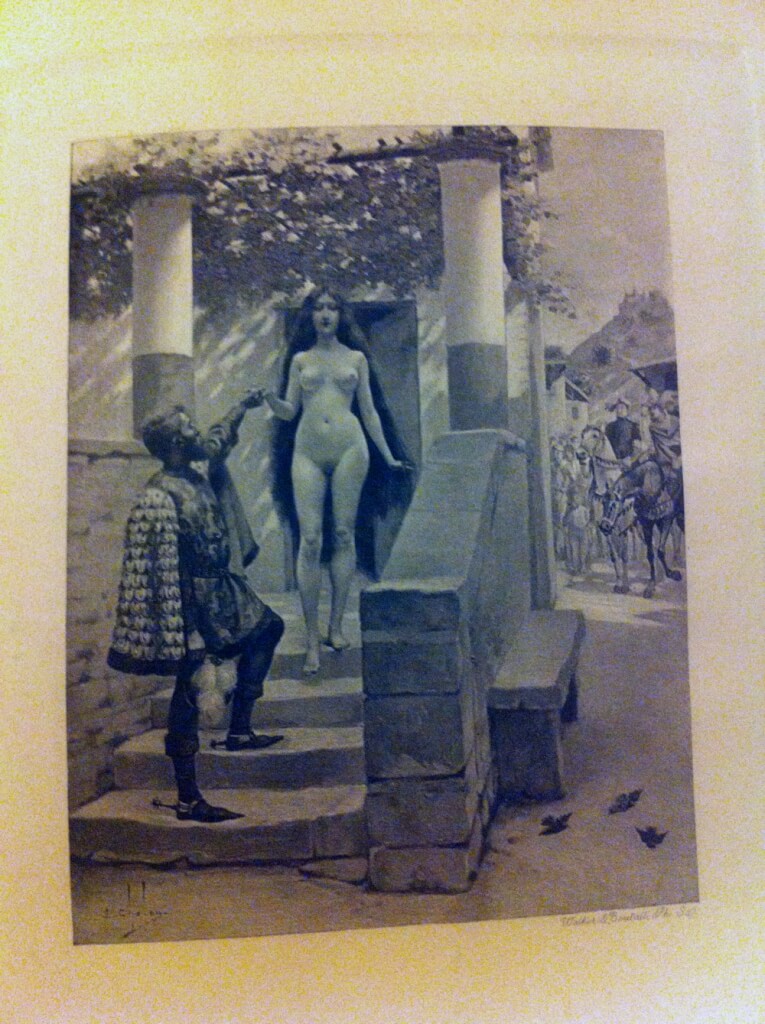 The Decameron of Giovanni Boccaccio, Giovanni Boccaccio, trans. John Payne, illust. Louis Chalon (Lawrence and Bullen, London, 1893, #638/1000) 11.25" X 7.5", 325pp 383pp, hardcover, olive green silk decorated boards with gilt decorations on cover and titles on spine. Numerous full-page B&W Illustrations, Good condition for age, some bumping to corners and slight wear, ribbons present but unattached. This is a beautifully bound and nicely illustrated edition of The Decameron from the late 1800s. The Decameron, (subtitled Prencipe Galeotto or Prince Galehaut), is a collection of novellas by the 14th-century Italian author Giovanni Boccaccio (1313–1375). The book is structured as a frame story containing 100 tales told by a group of seven young women and three young men sheltering in a secluded villa just outside Florence to escape the Black Death, which was afflicting the city. To make their exile more pleasant each of the ten tells the others one story every day. The Decameron records the narratives of ten days -- 100 stories. Boccaccio probably conceived of The Decameron after the epidemic of 1348, and completed it by 1353. These tales run the entire range of human emotion: grief, love, humor, anger, revenge. Many are based on oral folklore. Boccaccio's ten narrators thus retell already familiar stories about errant priests, rascally husbands, and mischievous wives. Variants of these stories are known in many cultures, but no one formulates them more cleverly or relates them more eloquently than does Boccaccio. In addition to its literary value and widespread influence, it provides a document of life at the time. Written in the vernacular of the Florentine language, it is considered a masterpiece of classical early Italian prose. Arthur Henry Bullen, often known as A. H. Bullen, (1857-1920) was an English editor and publisher, and a specialist in 16th and 17th century literature. His father George Bullen was librarian at the British Museum. A. H. Bullen's interest in Elizabethan dramatists and poets started at the City of London School, before he went to Worcester College, Oxford to study classics. His publishing career began with a scholarly edition of the Works of John Day in 1881 and continued with series of English Dramatists and a seven-volume set of Old English Plays, some of which he had discovered in manuscript and published for the first time. He was also the first person to publish some early lyric poems. Bullen wrote more than 150 articles for the Dictionary of National Biography, lectured on Elizabethan dramatists at Oxford University and taught at Toynbee Hall. In 1891 he and H. W. Lawrence went into partnership as the publishers Lawrence & Bullen. This lasted until 1900 when Bullen moved on to publish as A. H. Bullen. With Frank Sidgwick as partner, he then formed the Shakespeare Head Press for which he is most known.
The Decameron of Giovanni Boccaccio, Giovanni Boccaccio, trans. John Payne, illust. Louis Chalon (Lawrence and Bullen, London, 1893, #638/1000) 11.25" X 7.5", 325pp 383pp, hardcover, olive green silk decorated boards with gilt decorations on cover and titles on spine. Numerous full-page B&W Illustrations, Good condition for age, some bumping to corners and slight wear, ribbons present but unattached. This is a beautifully bound and nicely illustrated edition of The Decameron from the late 1800s. The Decameron, (subtitled Prencipe Galeotto or Prince Galehaut), is a collection of novellas by the 14th-century Italian author Giovanni Boccaccio (1313–1375). The book is structured as a frame story containing 100 tales told by a group of seven young women and three young men sheltering in a secluded villa just outside Florence to escape the Black Death, which was afflicting the city. To make their exile more pleasant each of the ten tells the others one story every day. The Decameron records the narratives of ten days -- 100 stories. Boccaccio probably conceived of The Decameron after the epidemic of 1348, and completed it by 1353. These tales run the entire range of human emotion: grief, love, humor, anger, revenge. Many are based on oral folklore. Boccaccio's ten narrators thus retell already familiar stories about errant priests, rascally husbands, and mischievous wives. Variants of these stories are known in many cultures, but no one formulates them more cleverly or relates them more eloquently than does Boccaccio. In addition to its literary value and widespread influence, it provides a document of life at the time. Written in the vernacular of the Florentine language, it is considered a masterpiece of classical early Italian prose. Arthur Henry Bullen, often known as A. H. Bullen, (1857-1920) was an English editor and publisher, and a specialist in 16th and 17th century literature. His father George Bullen was librarian at the British Museum. A. H. Bullen's interest in Elizabethan dramatists and poets started at the City of London School, before he went to Worcester College, Oxford to study classics. His publishing career began with a scholarly edition of the Works of John Day in 1881 and continued with series of English Dramatists and a seven-volume set of Old English Plays, some of which he had discovered in manuscript and published for the first time. He was also the first person to publish some early lyric poems. Bullen wrote more than 150 articles for the Dictionary of National Biography, lectured on Elizabethan dramatists at Oxford University and taught at Toynbee Hall. In 1891 he and H. W. Lawrence went into partnership as the publishers Lawrence & Bullen. This lasted until 1900 when Bullen moved on to publish as A. H. Bullen. With Frank Sidgwick as partner, he then formed the Shakespeare Head Press for which he is most known. -
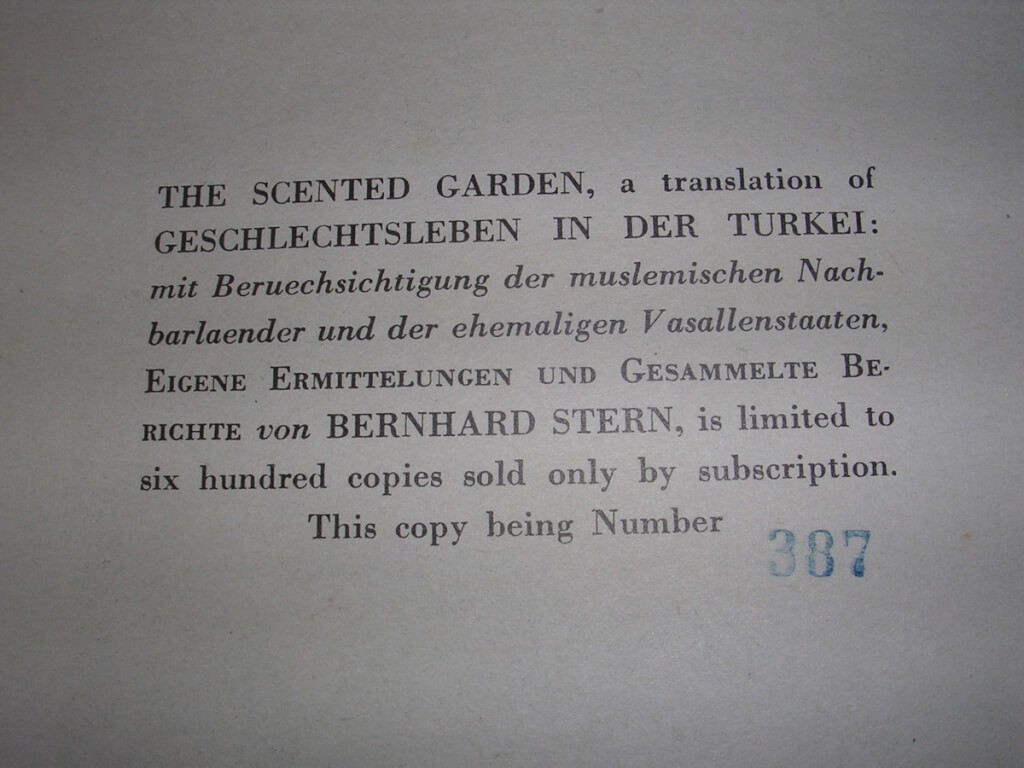
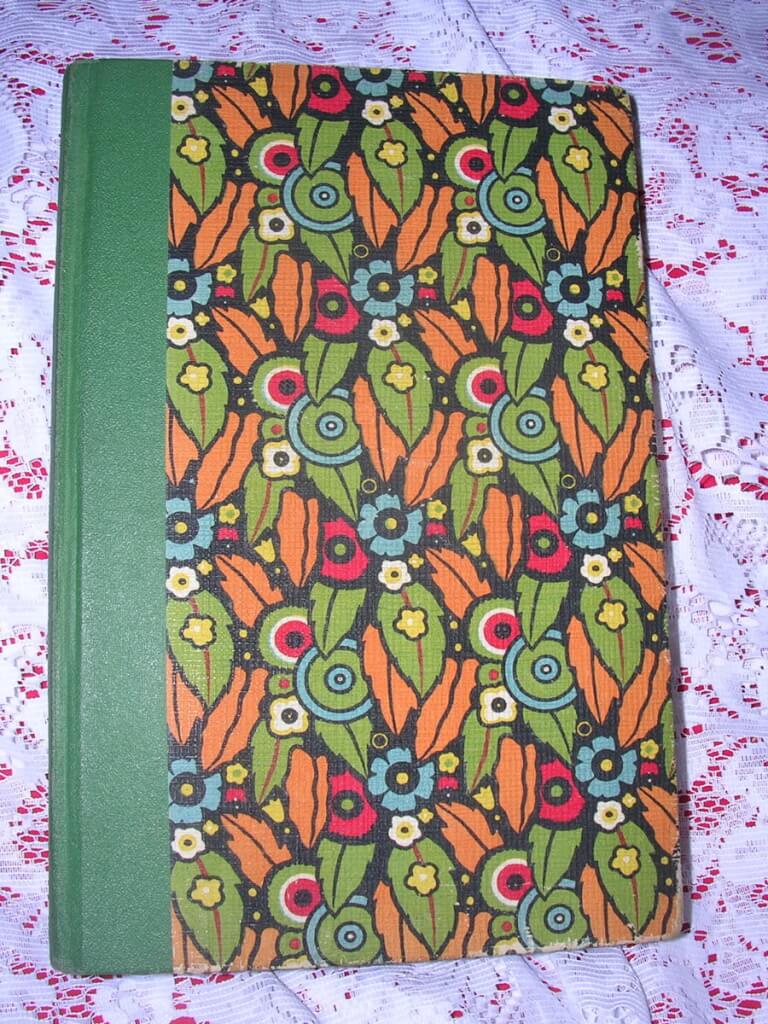 The Scented Garden: Anthropology of the Sex Life in the Levant , Bernhard Stern M.D., trans. David Berger M.A. (American Ethnological Press, New York, 1934, Printed for Subscribers, limited edition #387/600) 9 1/4" X 6 1/4", 443pp, hardbound half green cloth with floral boards, illustrated, top edge inked blue, good condition, corners worn, binding is tight Dr. Bernhard Stern spent 5 years in the Orient gathering data for this book. Conferring with famous oriental physicians, priests and students of folk-lore in the Turkish capital, and then on numerous distant journeys into the interior of the European and Asiatic Orient, all reports bearing on the contents of this book which were in any manner obtainable. This encyclopedic book details the sexual practices and perversions of peoples and cultures throughout the world. Topics include: love and love charms, rental marriages, the bridal night of a princess, the sexual lexicon, chastity and the feeling of shame, onanism and artificial instruments, public prostitution and the sex act.
The Scented Garden: Anthropology of the Sex Life in the Levant , Bernhard Stern M.D., trans. David Berger M.A. (American Ethnological Press, New York, 1934, Printed for Subscribers, limited edition #387/600) 9 1/4" X 6 1/4", 443pp, hardbound half green cloth with floral boards, illustrated, top edge inked blue, good condition, corners worn, binding is tight Dr. Bernhard Stern spent 5 years in the Orient gathering data for this book. Conferring with famous oriental physicians, priests and students of folk-lore in the Turkish capital, and then on numerous distant journeys into the interior of the European and Asiatic Orient, all reports bearing on the contents of this book which were in any manner obtainable. This encyclopedic book details the sexual practices and perversions of peoples and cultures throughout the world. Topics include: love and love charms, rental marriages, the bridal night of a princess, the sexual lexicon, chastity and the feeling of shame, onanism and artificial instruments, public prostitution and the sex act. -
 The Tales and Novels of Jean de La Fontaine | completely translated into English (Privately Printed, New York, 1929) 9.5"X6.25", xiii+250pp, x+329pp, hardbound with black boards and gilt titles on cover and spines, spine titles fading, top edge inked other edges deckled, good condition, illustrations throughout. Jean de La Fontaine (1621-1695) was a French fabulist and one of the most widely read French poets of the 17th century. After a long period of royal suspicion, he was admitted to the French Academy and his reputation in France has never faded since. Evidence of this is found in the many pictures and statues of the writer, as well as later depictions on medals, coins and postage stamps. The numerous works of La Fontaine fall into three traditional divisions: the Fables, the Tales and the miscellaneous (including dramatic) works. He is best known for the first of these, in which a tradition of fable collecting in French verse reaching back to the Middle Ages was brought to a peak. He published 245 fables, across twelve books between 1668 and 1694, exemplify the grace and wit of his age. Unlike many of his models, his fables function less as didactic tools and more as entertaining art. His beasts, humans, and plants are not merely moral-serving abstractions but rather lively actors in elegantly described escapades. Almost equally as popular in their time, his “tales”, Contes et nouvelles en vers (1665), is an anthology of various ribald short stories and novellas collected and versified from prose. They were particularly marked by their archly licentious tone. La Fontaine drew from several French and Italian works of the 15th and 16th centuries, among them The Decameron of Giovanni Boccaccio, Ludovico Ariosto’s Orlando Furioso, Antoine de la Sale’s collection Cent Nouvelles Nouvelles, and the work of Bonaventure des Périers.
The Tales and Novels of Jean de La Fontaine | completely translated into English (Privately Printed, New York, 1929) 9.5"X6.25", xiii+250pp, x+329pp, hardbound with black boards and gilt titles on cover and spines, spine titles fading, top edge inked other edges deckled, good condition, illustrations throughout. Jean de La Fontaine (1621-1695) was a French fabulist and one of the most widely read French poets of the 17th century. After a long period of royal suspicion, he was admitted to the French Academy and his reputation in France has never faded since. Evidence of this is found in the many pictures and statues of the writer, as well as later depictions on medals, coins and postage stamps. The numerous works of La Fontaine fall into three traditional divisions: the Fables, the Tales and the miscellaneous (including dramatic) works. He is best known for the first of these, in which a tradition of fable collecting in French verse reaching back to the Middle Ages was brought to a peak. He published 245 fables, across twelve books between 1668 and 1694, exemplify the grace and wit of his age. Unlike many of his models, his fables function less as didactic tools and more as entertaining art. His beasts, humans, and plants are not merely moral-serving abstractions but rather lively actors in elegantly described escapades. Almost equally as popular in their time, his “tales”, Contes et nouvelles en vers (1665), is an anthology of various ribald short stories and novellas collected and versified from prose. They were particularly marked by their archly licentious tone. La Fontaine drew from several French and Italian works of the 15th and 16th centuries, among them The Decameron of Giovanni Boccaccio, Ludovico Ariosto’s Orlando Furioso, Antoine de la Sale’s collection Cent Nouvelles Nouvelles, and the work of Bonaventure des Périers. -
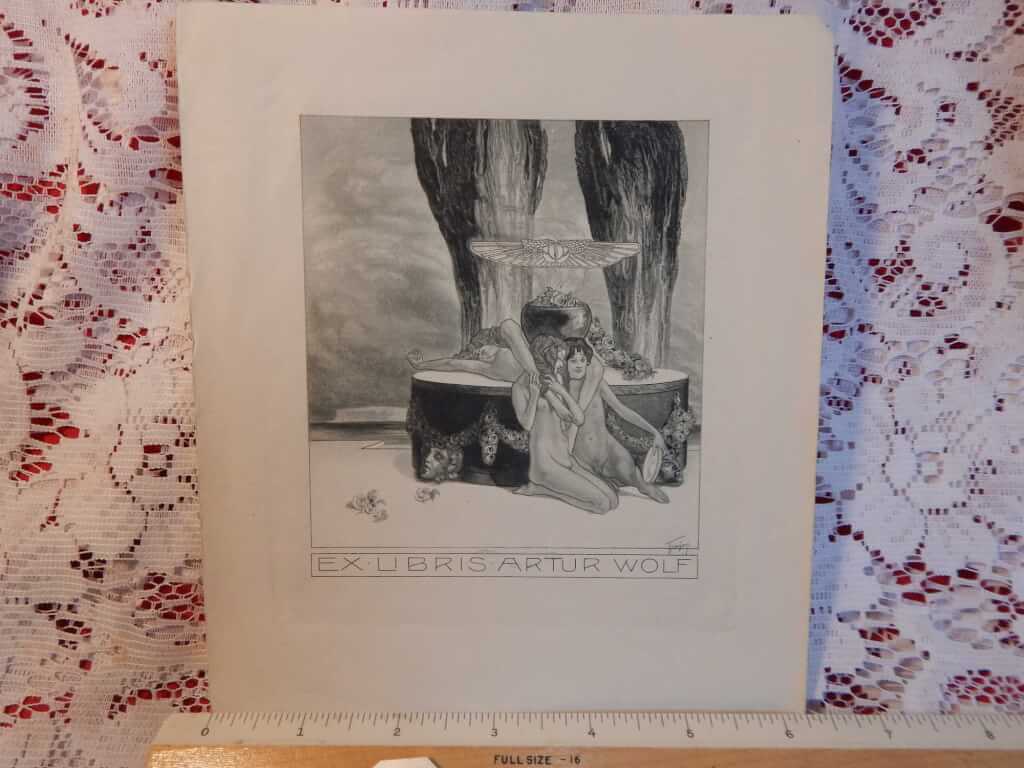 Ex Libris Artur Wolf, by Franz von Bayros paper size 6.25 x 7.25", print size 5 x 5.75", on hand laid paper three naked girls Franz von Bayros (1866 – 1924) was an Austrian commercial artist, illustrator, and painter, now he is best known for his erotic work. He belonged to the Decadent movement in art, often utilizing erotic themes and phantasmagoric imagery. At the age 17, Bayros passed the entrance exam for the Vienna Academy with Eduard von Engerth. Bayros mixed in elegant society and soon belonged to the circle of friends of Johann Straub, whose step daughter Alice he married on 1896. The next year, Bayros moved to Munich. In 1904, Bayros gave his first exhibition in Munich, which was a great success. From 1904 until 1908, Bayros traveled to Paris and Italy for his studies. Typically, for an artist dealing with such imagery, von Bayros produced work under several pseudonyms, most notably Choisy Le Conin, and was hounded by authorities for much of his life for his “indecent” art often very imaginative, and including such taboo subjects as sadomasochism and bestiality. He became equally well-known for his masterly drawn figures of elegant modestly nude and non-nude women.
Ex Libris Artur Wolf, by Franz von Bayros paper size 6.25 x 7.25", print size 5 x 5.75", on hand laid paper three naked girls Franz von Bayros (1866 – 1924) was an Austrian commercial artist, illustrator, and painter, now he is best known for his erotic work. He belonged to the Decadent movement in art, often utilizing erotic themes and phantasmagoric imagery. At the age 17, Bayros passed the entrance exam for the Vienna Academy with Eduard von Engerth. Bayros mixed in elegant society and soon belonged to the circle of friends of Johann Straub, whose step daughter Alice he married on 1896. The next year, Bayros moved to Munich. In 1904, Bayros gave his first exhibition in Munich, which was a great success. From 1904 until 1908, Bayros traveled to Paris and Italy for his studies. Typically, for an artist dealing with such imagery, von Bayros produced work under several pseudonyms, most notably Choisy Le Conin, and was hounded by authorities for much of his life for his “indecent” art often very imaginative, and including such taboo subjects as sadomasochism and bestiality. He became equally well-known for his masterly drawn figures of elegant modestly nude and non-nude women. -
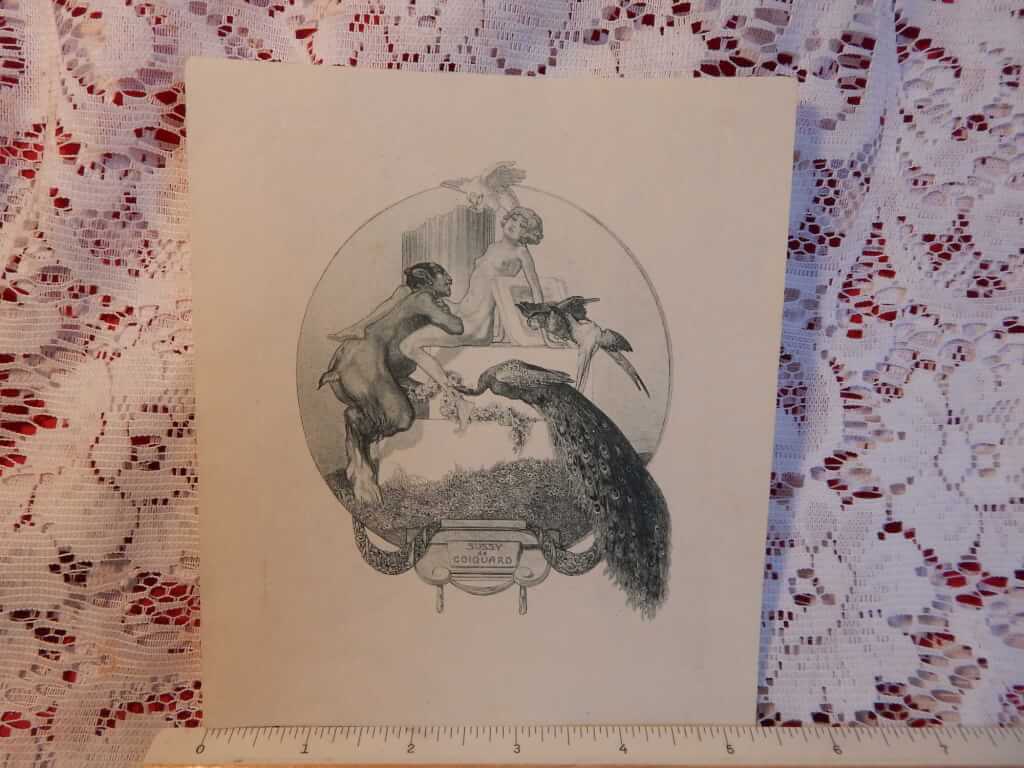 Ex libris Sussy de Coiquard, by Franz von Bayros paper size 5.5 x 6.25", print size 4.25 x 5.25" naked girl entertaining Pan(?), with peacock and other birds Franz von Bayros (1866 – 1924) was an Austrian commercial artist, illustrator, and painter, now he is best known for his erotic work. He belonged to the Decadent movement in art, often utilizing erotic themes and phantasmagoric imagery. At the age 17, Bayros passed the entrance exam for the Vienna Academy with Eduard von Engerth. Bayros mixed in elegant society and soon belonged to the circle of friends of Johann Straub, whose step daughter Alice he married on 1896. The next year, Bayros moved to Munich. In 1904, Bayros gave his first exhibition in Munich, which was a great success. From 1904 until 1908, Bayros traveled to Paris and Italy for his studies. Typically, for an artist dealing with such imagery, von Bayros produced work under several pseudonyms, most notably Choisy Le Conin, and was hounded by authorities for much of his life for his “indecent” art often very imaginative, and including such taboo subjects as sadomasochism and bestiality. He became equally well-known for his masterly drawn figures of elegant modestly nude and non-nude women.
Ex libris Sussy de Coiquard, by Franz von Bayros paper size 5.5 x 6.25", print size 4.25 x 5.25" naked girl entertaining Pan(?), with peacock and other birds Franz von Bayros (1866 – 1924) was an Austrian commercial artist, illustrator, and painter, now he is best known for his erotic work. He belonged to the Decadent movement in art, often utilizing erotic themes and phantasmagoric imagery. At the age 17, Bayros passed the entrance exam for the Vienna Academy with Eduard von Engerth. Bayros mixed in elegant society and soon belonged to the circle of friends of Johann Straub, whose step daughter Alice he married on 1896. The next year, Bayros moved to Munich. In 1904, Bayros gave his first exhibition in Munich, which was a great success. From 1904 until 1908, Bayros traveled to Paris and Italy for his studies. Typically, for an artist dealing with such imagery, von Bayros produced work under several pseudonyms, most notably Choisy Le Conin, and was hounded by authorities for much of his life for his “indecent” art often very imaginative, and including such taboo subjects as sadomasochism and bestiality. He became equally well-known for his masterly drawn figures of elegant modestly nude and non-nude women. -
Out of stock

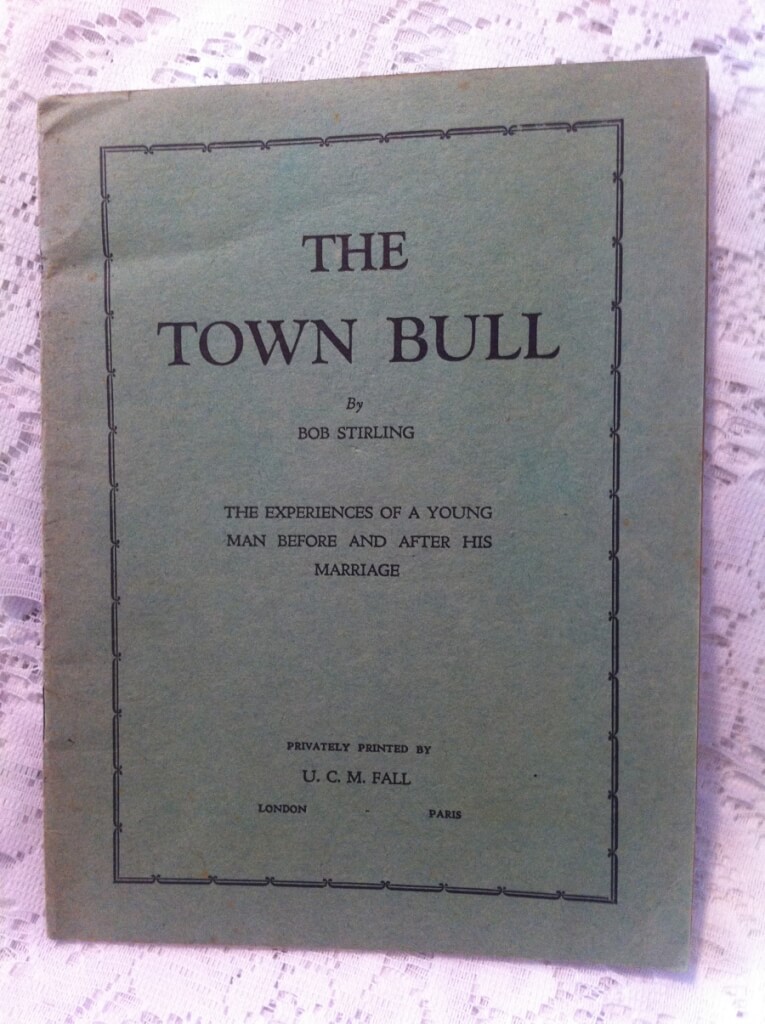 The Town Bull: the experiences of a young man before and after his marriage Bob Stirling, (Privately Printed by U. C. M. Fall, London, Paris,nd [false imprint. this is a pamphlet, not the book]) 7.25" x 5.5", 32pp., pamphlet, good condition, some fading Erotic story, no illustrations
The Town Bull: the experiences of a young man before and after his marriage Bob Stirling, (Privately Printed by U. C. M. Fall, London, Paris,nd [false imprint. this is a pamphlet, not the book]) 7.25" x 5.5", 32pp., pamphlet, good condition, some fading Erotic story, no illustrations -
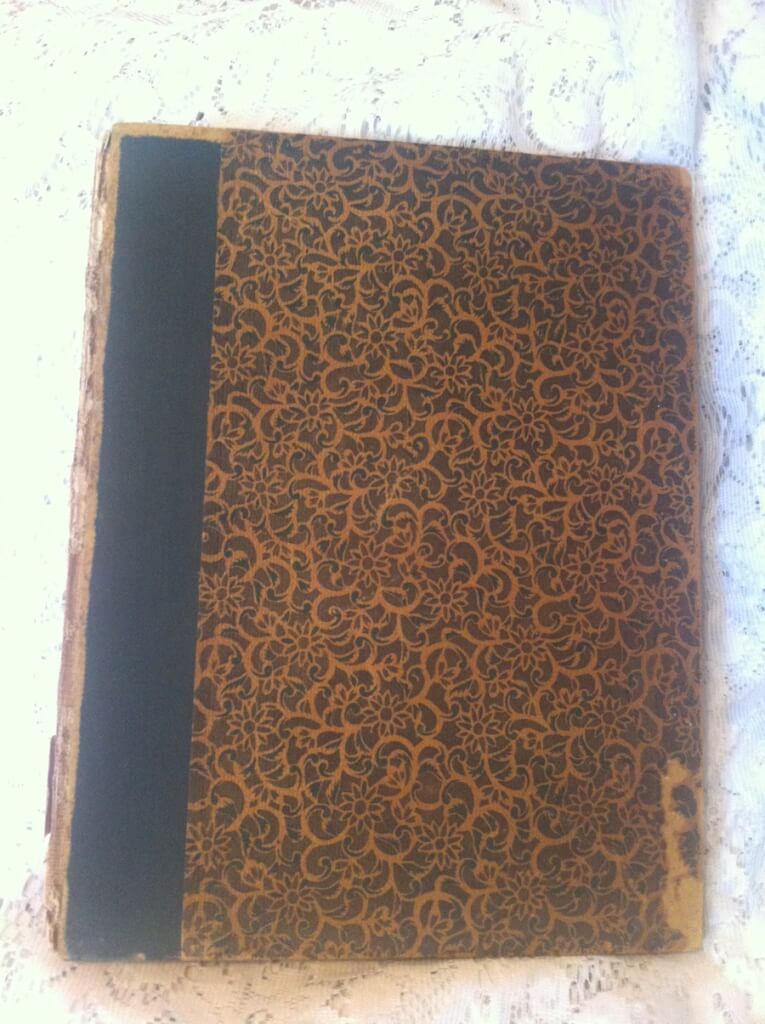
 The Mimiambs of Herondas, Herodas, Translated by Jack Lindsay, Decorated by Alan Odle, with a Foreword by Brian Penton. (The Fanfrolico Press, London, nd [c. 1929], #351/375 [first edition, and first Fanfrolico to be printed in London]) 11 7/8" X 9 3/8", unpaginated 72pp, hardbound no DJ, original buckram-backed decorated Japanese paper boards with plain green cloth spine and gilt lettering, top edge gilt, other edges deckle, poor condition, boards show major wear, spine worn off, binding still good, boards still attached, interior pages are fine, Cloister types on Van Gelder Antique handmade paper Herodas was a Greek poet and the author of short humorous dramatic scenes in verse, written under the Alexandrian empire in the 3rd century BC. Mimes were scenes in popular life in South Italy and Sicily, written in the language of the people, vigorous with racy proverbs such as we get in other reflections of that region. The Mimes of Herodas have been known to us only since the discovery and publication of the "Kenyon", M. S. Buck, by the British Museum in 1891 (from a parchment containing 7 legible mimes half of the 8th and a fragment of the 9th). This was Fanfrolico's first London book. It was published "for subscribers to The Franfrolico Press". This new translation of Mimiambs of Herondas was translated by Jack Lindsay and beautifully illustrated by Alan Odle whose grotesque and subversive style was a precursor of surrealism. This is a beautiful printed book in great condition and quite rare. Fanfrolico Press, Australia’s first ‘private press’ in the arts-and-craft tradition, was founded by Jack Lindsay, P. R. Stephensen and John Kirtley, originally in North Sydney in 1923. The press specialized in printings artful, limited editions of classics and forgotten works that were suited to the extravagant style of artist like his father, artist, sculptor and author Norman Lindsay who illustrated many of their books. Fanfrolico was scornful of modernism and with its florid style determinedly backward-looking. They did surprisingly well, despite the lack of business expertise of their young, ambitious "bohemian" owners, eking out a living despite the risky move to London in 1926 and upheavals in ownership that saw the departure in 1927 of Kirtley, and then Stephenson in 1929. Sometime in 1930 they published their last book.
The Mimiambs of Herondas, Herodas, Translated by Jack Lindsay, Decorated by Alan Odle, with a Foreword by Brian Penton. (The Fanfrolico Press, London, nd [c. 1929], #351/375 [first edition, and first Fanfrolico to be printed in London]) 11 7/8" X 9 3/8", unpaginated 72pp, hardbound no DJ, original buckram-backed decorated Japanese paper boards with plain green cloth spine and gilt lettering, top edge gilt, other edges deckle, poor condition, boards show major wear, spine worn off, binding still good, boards still attached, interior pages are fine, Cloister types on Van Gelder Antique handmade paper Herodas was a Greek poet and the author of short humorous dramatic scenes in verse, written under the Alexandrian empire in the 3rd century BC. Mimes were scenes in popular life in South Italy and Sicily, written in the language of the people, vigorous with racy proverbs such as we get in other reflections of that region. The Mimes of Herodas have been known to us only since the discovery and publication of the "Kenyon", M. S. Buck, by the British Museum in 1891 (from a parchment containing 7 legible mimes half of the 8th and a fragment of the 9th). This was Fanfrolico's first London book. It was published "for subscribers to The Franfrolico Press". This new translation of Mimiambs of Herondas was translated by Jack Lindsay and beautifully illustrated by Alan Odle whose grotesque and subversive style was a precursor of surrealism. This is a beautiful printed book in great condition and quite rare. Fanfrolico Press, Australia’s first ‘private press’ in the arts-and-craft tradition, was founded by Jack Lindsay, P. R. Stephensen and John Kirtley, originally in North Sydney in 1923. The press specialized in printings artful, limited editions of classics and forgotten works that were suited to the extravagant style of artist like his father, artist, sculptor and author Norman Lindsay who illustrated many of their books. Fanfrolico was scornful of modernism and with its florid style determinedly backward-looking. They did surprisingly well, despite the lack of business expertise of their young, ambitious "bohemian" owners, eking out a living despite the risky move to London in 1926 and upheavals in ownership that saw the departure in 1927 of Kirtley, and then Stephenson in 1929. Sometime in 1930 they published their last book. -
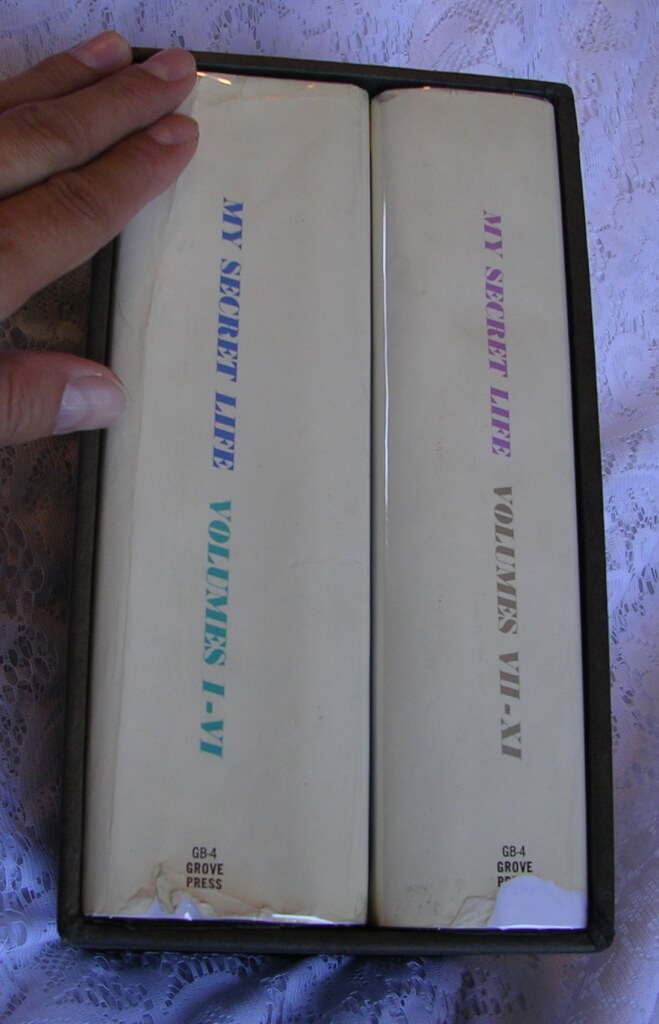
 My Secret Life, anonymous (Grove Press, Inc., New York, 1966 [first edition thus, first printing]) 9 1/4" X 6 1/4", 2 vol. 1291pp 1069pp [2nd vol. numbered 1291-2359], hardbound with dust jackets (with protector) and slip case, very good condition, very slight sunning on slip case, Ex Libris Robert Kintzler My Secret Life, by "Walter", is the memoir of a Victorian gentleman's sexual development and experiences. Between approximately 1883 and 1895, someone, presumably an Englishman of means, had printed on the Continent an eleven-volume sexual autobiography limited, so he thought, to just six copies. Who the printer or publisher was has not been established with certainty but the most likely possibility is Auguste Brancart, a prolific publisher of erotica who began his career in the early 1880's in Bruxelles and toward the end of the decade moved to Amsterdam. Interestingly, the original title page of My Secret Life has 'Amsterdam. Not for Publication' on it but in the sub rosa world of erotica publishing such indications are to be taken with a pinch of salt. The scarcity of the first edition of My Secret Life has been overstated; it certainly is a rare book. More than six copies, as ordered, were undoubtedly run off. From the number that have reliably been reported to exist, the number appears to have been in the region of twenty to twenty-five sets. Aleister Crowley was supposed to have had one, as well as the silent film comedian Harold Lloyd and Joseph von Sternberg, Marlene Dietrich's director and one-time lover. Charles Reginald Dawes, the last great English collector of erotica, had two sets, one of which was destroyed the the British Customs and the other going eventually to the British Library in 1964. Lord Louis Mountbatten's brother, the 2nd marquess of Milford Haven, certainly possessed a copy for it exists currently in a fine London collection and contains his bookplate. There is a copy in Geneva, another in Hamburg and at least two in New York. Two attempts to publish a reprint in the United States in the 1930's failed due to police action. The first, which began about 1932, followed the original edition as to title and imprint and got as far as volume three before the project was shut down. A copy with 100 original water colors by Clara Tice was auctioned by Parke-Bernet at New York in 1971. A second attempt took place about two years later, with a single volume called Marital Frolics (London [New York or Philadelphia]: For Distribution by Subscription Only [c. 1934]). This constituted an abridgment of volume 5, and was illustrated with ten plates by 'Malay.' A copy was likewise auctioned by Parke-Bernet in the same sale. The Grove Press reprint of 1966 is the first complete edition to be openly available. It was prepared from an eleven-volume typescript made directly from the copy in Hamburg referred to above. All subsequent reprints stem, legally or otherwise, from this. Gershon Legman's Introduction to the Grove Press reprint is a mine of fascinating information, and includes a closely argued case for My Secret Life having been written by Henry Spencer Ashbee, the famous Victorian bibliographer and collector of erotica. The present compiler is unable to share this view, but thinks it likely that Ashbee was involved in seeing it through the press on behalf of somebody else. This book is often wrongly attributed to Frank Harris, through confusion with My Life and Loves, which is a similar (although not as explicit) account of Harris' life. A number of reprints followed the Grove Press edition, including one published by Brandon House of North Hollywood and Pendulum Books of Atlanta, Georgia and a complete French translation.
My Secret Life, anonymous (Grove Press, Inc., New York, 1966 [first edition thus, first printing]) 9 1/4" X 6 1/4", 2 vol. 1291pp 1069pp [2nd vol. numbered 1291-2359], hardbound with dust jackets (with protector) and slip case, very good condition, very slight sunning on slip case, Ex Libris Robert Kintzler My Secret Life, by "Walter", is the memoir of a Victorian gentleman's sexual development and experiences. Between approximately 1883 and 1895, someone, presumably an Englishman of means, had printed on the Continent an eleven-volume sexual autobiography limited, so he thought, to just six copies. Who the printer or publisher was has not been established with certainty but the most likely possibility is Auguste Brancart, a prolific publisher of erotica who began his career in the early 1880's in Bruxelles and toward the end of the decade moved to Amsterdam. Interestingly, the original title page of My Secret Life has 'Amsterdam. Not for Publication' on it but in the sub rosa world of erotica publishing such indications are to be taken with a pinch of salt. The scarcity of the first edition of My Secret Life has been overstated; it certainly is a rare book. More than six copies, as ordered, were undoubtedly run off. From the number that have reliably been reported to exist, the number appears to have been in the region of twenty to twenty-five sets. Aleister Crowley was supposed to have had one, as well as the silent film comedian Harold Lloyd and Joseph von Sternberg, Marlene Dietrich's director and one-time lover. Charles Reginald Dawes, the last great English collector of erotica, had two sets, one of which was destroyed the the British Customs and the other going eventually to the British Library in 1964. Lord Louis Mountbatten's brother, the 2nd marquess of Milford Haven, certainly possessed a copy for it exists currently in a fine London collection and contains his bookplate. There is a copy in Geneva, another in Hamburg and at least two in New York. Two attempts to publish a reprint in the United States in the 1930's failed due to police action. The first, which began about 1932, followed the original edition as to title and imprint and got as far as volume three before the project was shut down. A copy with 100 original water colors by Clara Tice was auctioned by Parke-Bernet at New York in 1971. A second attempt took place about two years later, with a single volume called Marital Frolics (London [New York or Philadelphia]: For Distribution by Subscription Only [c. 1934]). This constituted an abridgment of volume 5, and was illustrated with ten plates by 'Malay.' A copy was likewise auctioned by Parke-Bernet in the same sale. The Grove Press reprint of 1966 is the first complete edition to be openly available. It was prepared from an eleven-volume typescript made directly from the copy in Hamburg referred to above. All subsequent reprints stem, legally or otherwise, from this. Gershon Legman's Introduction to the Grove Press reprint is a mine of fascinating information, and includes a closely argued case for My Secret Life having been written by Henry Spencer Ashbee, the famous Victorian bibliographer and collector of erotica. The present compiler is unable to share this view, but thinks it likely that Ashbee was involved in seeing it through the press on behalf of somebody else. This book is often wrongly attributed to Frank Harris, through confusion with My Life and Loves, which is a similar (although not as explicit) account of Harris' life. A number of reprints followed the Grove Press edition, including one published by Brandon House of North Hollywood and Pendulum Books of Atlanta, Georgia and a complete French translation. -
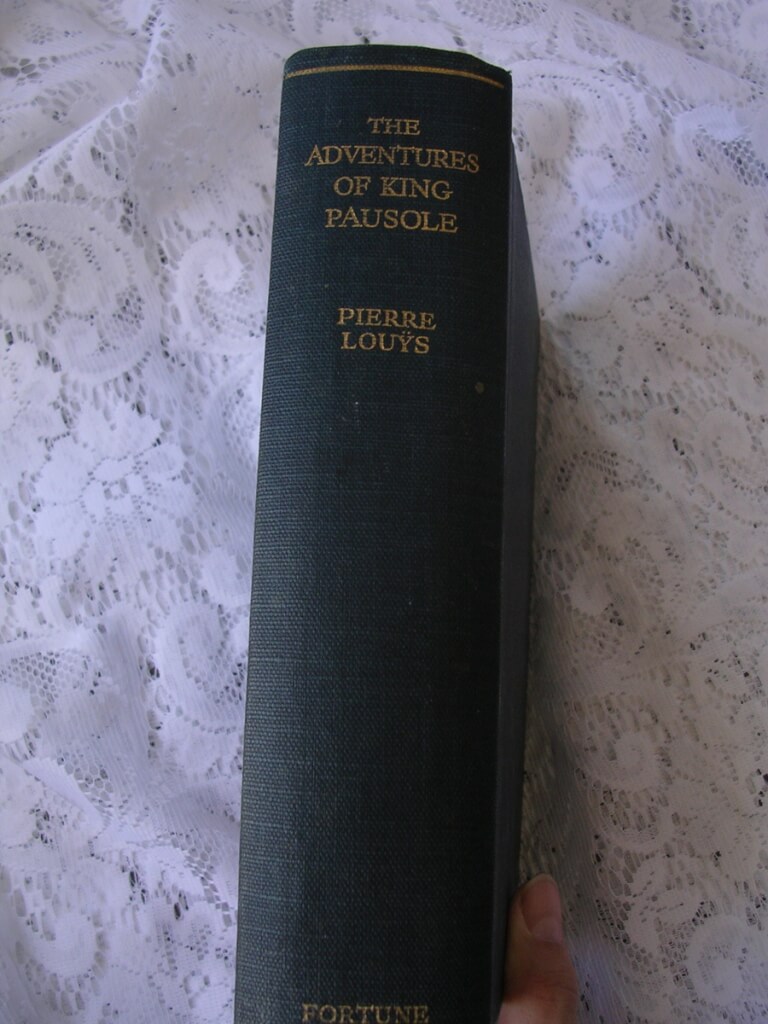
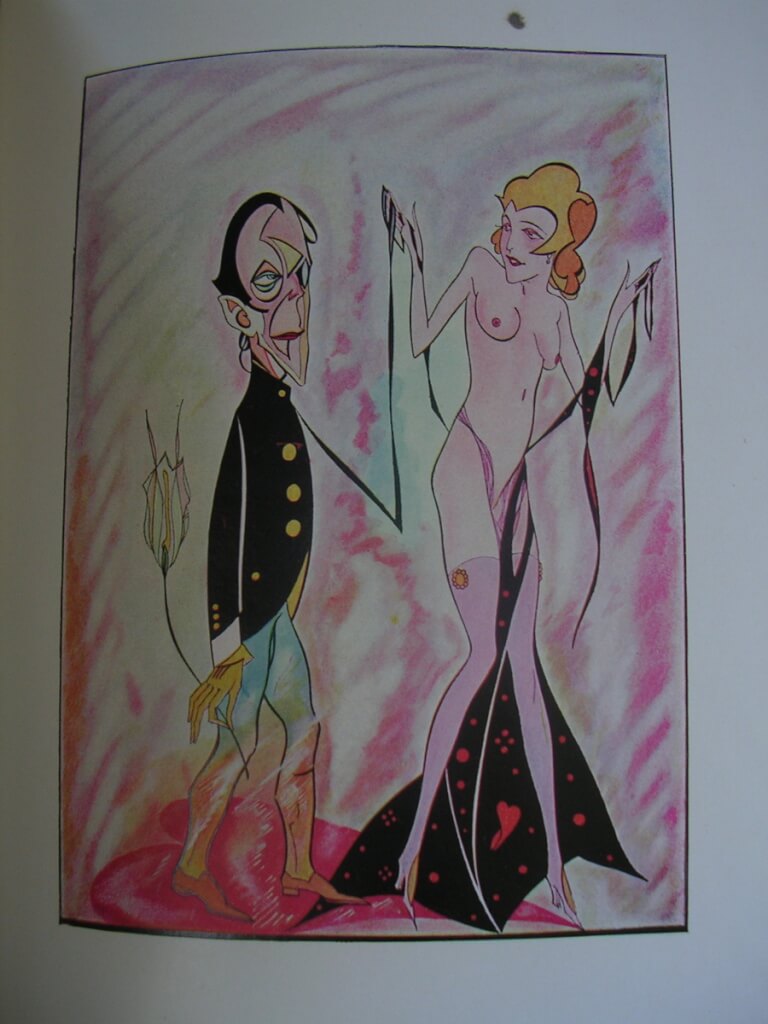 The Adventures of King Pausole, Pierre Louys, trans. Charles Hope Lumley, illustrated by Beresford Egan (The Fortune Press, London, 1929, #333/1200, "printed at Leige by the Imprimerie Vaillant-Carmanne - M. C. M. XXIX") 9 1/4" X 7", 312pp, hardbound no DJ, quarter cloth, marbled boards, gilt lettering on spine, printed on "batchelor hand-made paper", top edge gilted other edges deckle, in good condition, corners are bumped, some pages remain uncut, spine slightly cocked, some light rubbing to tail some pages remain unread/uncut Pierre Louys (1870 - 1925) was a French poet and writer, most renowned for lesbian and classical themes in some of his writings. He is known as a writer who "expressed pagan sensuality with stylistic perfection." This book is a humorous and risqué "libertine" story about a king with many wives (one for each day of the year). As part of the story, King Pausole had two laws "1. hurt no man. 2. Then do as you please." This law has been embraced many including pagan/wiccan community when Aleister Crowley introduced this as his "First Law". First English edition, 6 full page colour plates by Beresford.
The Adventures of King Pausole, Pierre Louys, trans. Charles Hope Lumley, illustrated by Beresford Egan (The Fortune Press, London, 1929, #333/1200, "printed at Leige by the Imprimerie Vaillant-Carmanne - M. C. M. XXIX") 9 1/4" X 7", 312pp, hardbound no DJ, quarter cloth, marbled boards, gilt lettering on spine, printed on "batchelor hand-made paper", top edge gilted other edges deckle, in good condition, corners are bumped, some pages remain uncut, spine slightly cocked, some light rubbing to tail some pages remain unread/uncut Pierre Louys (1870 - 1925) was a French poet and writer, most renowned for lesbian and classical themes in some of his writings. He is known as a writer who "expressed pagan sensuality with stylistic perfection." This book is a humorous and risqué "libertine" story about a king with many wives (one for each day of the year). As part of the story, King Pausole had two laws "1. hurt no man. 2. Then do as you please." This law has been embraced many including pagan/wiccan community when Aleister Crowley introduced this as his "First Law". First English edition, 6 full page colour plates by Beresford. -
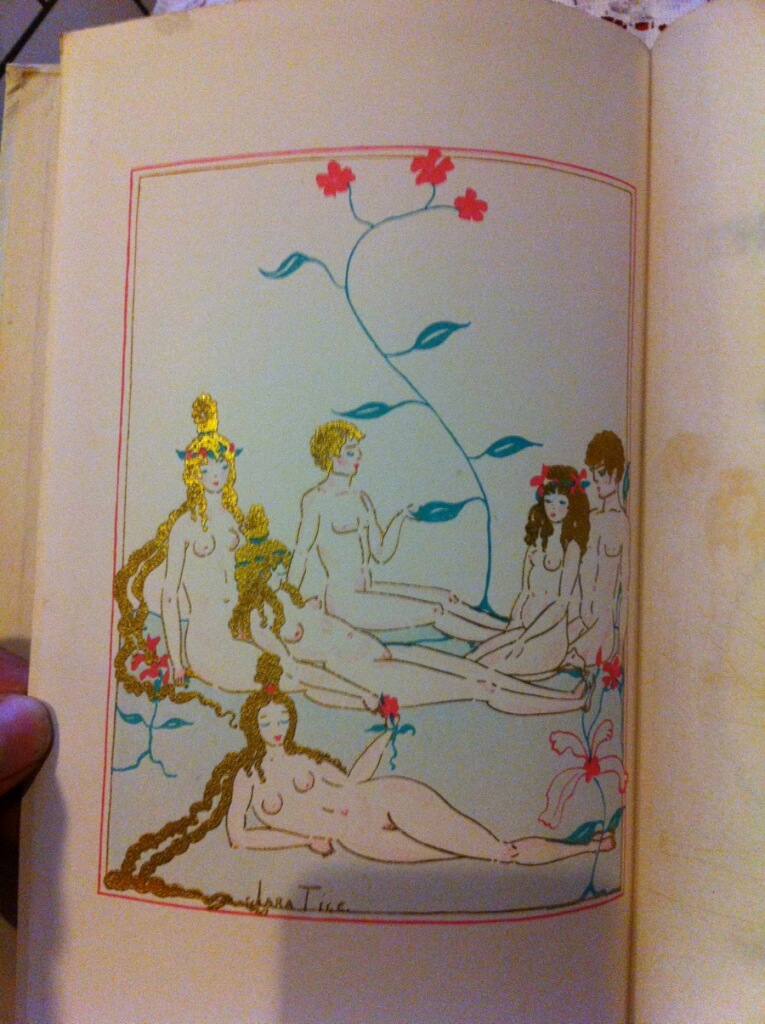
 The Twilight of the Nymphs, Pierre Louys, illustrated by Clara Tice, "designed and supervised by Harry Cunningham" (The Pierre Louys Society, US, 1927, #682/990) 9.75" x 6.5", 235pp, white boards with silver gilt decorations on cover and spine, no dustjacket, fair condition, back boards loose but holding, pages clean. Pierre Louys (1870 - 1925) was a French poet and writer, most renowned for lesbian and classical themes in some of his writings. He is known as a writer who "expressed pagan sensuality with stylistic perfection." A collection of seven mildly erotic fables based on mythology. "This Edition Limited to 1250 copies of which 990 are for America, No. 682". 28 beautiful color illustrations by Clara Tice, all with tissue overlay and enhanced with gilt and silver.
The Twilight of the Nymphs, Pierre Louys, illustrated by Clara Tice, "designed and supervised by Harry Cunningham" (The Pierre Louys Society, US, 1927, #682/990) 9.75" x 6.5", 235pp, white boards with silver gilt decorations on cover and spine, no dustjacket, fair condition, back boards loose but holding, pages clean. Pierre Louys (1870 - 1925) was a French poet and writer, most renowned for lesbian and classical themes in some of his writings. He is known as a writer who "expressed pagan sensuality with stylistic perfection." A collection of seven mildly erotic fables based on mythology. "This Edition Limited to 1250 copies of which 990 are for America, No. 682". 28 beautiful color illustrations by Clara Tice, all with tissue overlay and enhanced with gilt and silver. -
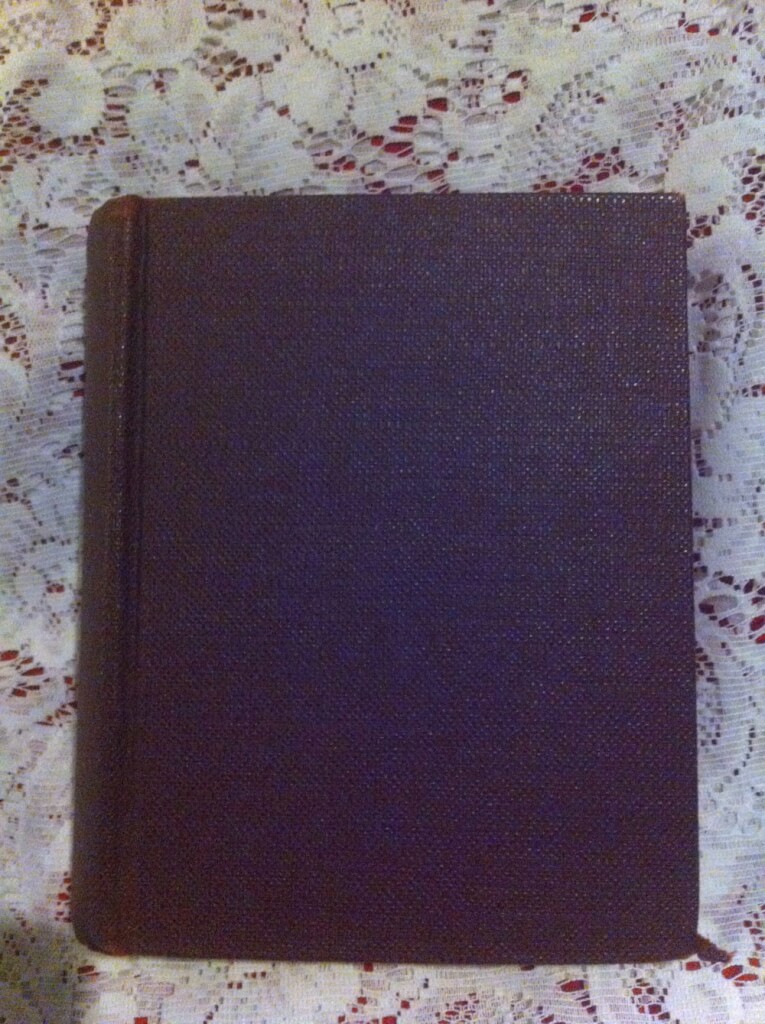
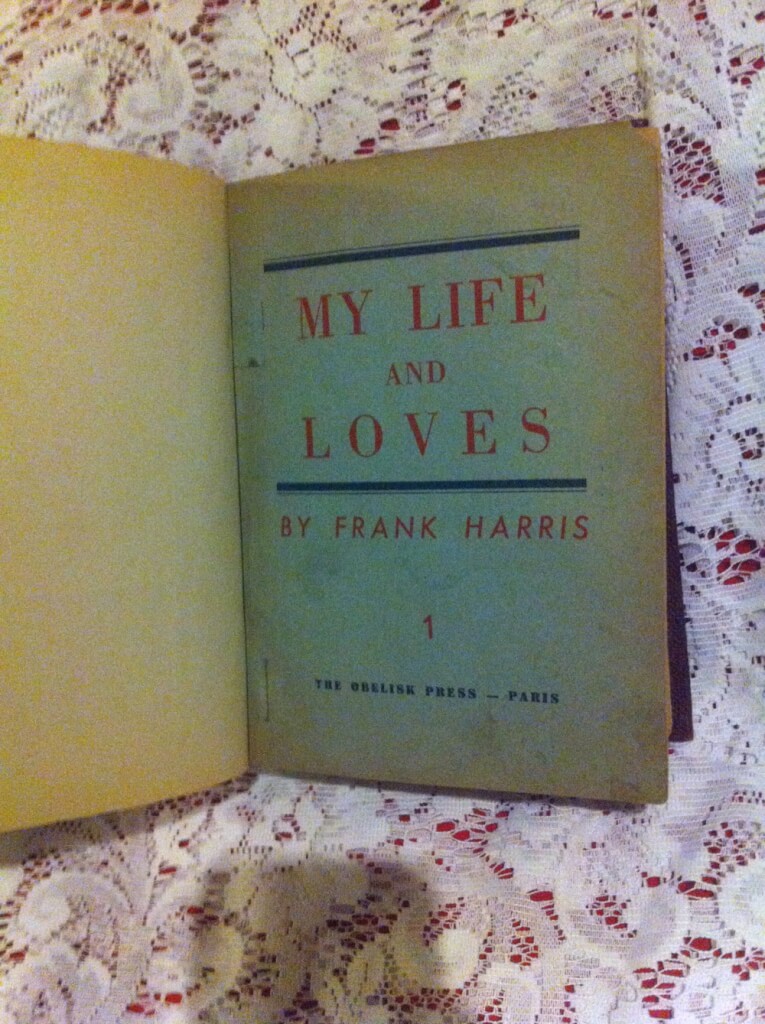 My Life and Loves, Frank Harris (Obelisk Press Books, Paris, 1945) 7" X 5.5", 233pp, 302pp, 176pp, 178pp., 4 vols hardbound in one book, red cloth boards, very good condition for age, pages yellowing no titles on spine or boards. Autobiography of the Ireland-born, naturalized-American writer and editor Frank Harris (1856_1931). Published privately by Harris between 1922 and 1927, and by Jack Kahane's Obelisk Press in 1931, the work consisted of four volumes (with a 5th promised but never delivered). The book gives a graphic account of Harris' sexual adventures and relates gossip about the sexual activities of celebrities of his day. Printed on somewhat cheap paper, these volumes are often in rough shape. This book presents the volumes preserved as best as can be expected for their age.
My Life and Loves, Frank Harris (Obelisk Press Books, Paris, 1945) 7" X 5.5", 233pp, 302pp, 176pp, 178pp., 4 vols hardbound in one book, red cloth boards, very good condition for age, pages yellowing no titles on spine or boards. Autobiography of the Ireland-born, naturalized-American writer and editor Frank Harris (1856_1931). Published privately by Harris between 1922 and 1927, and by Jack Kahane's Obelisk Press in 1931, the work consisted of four volumes (with a 5th promised but never delivered). The book gives a graphic account of Harris' sexual adventures and relates gossip about the sexual activities of celebrities of his day. Printed on somewhat cheap paper, these volumes are often in rough shape. This book presents the volumes preserved as best as can be expected for their age. -

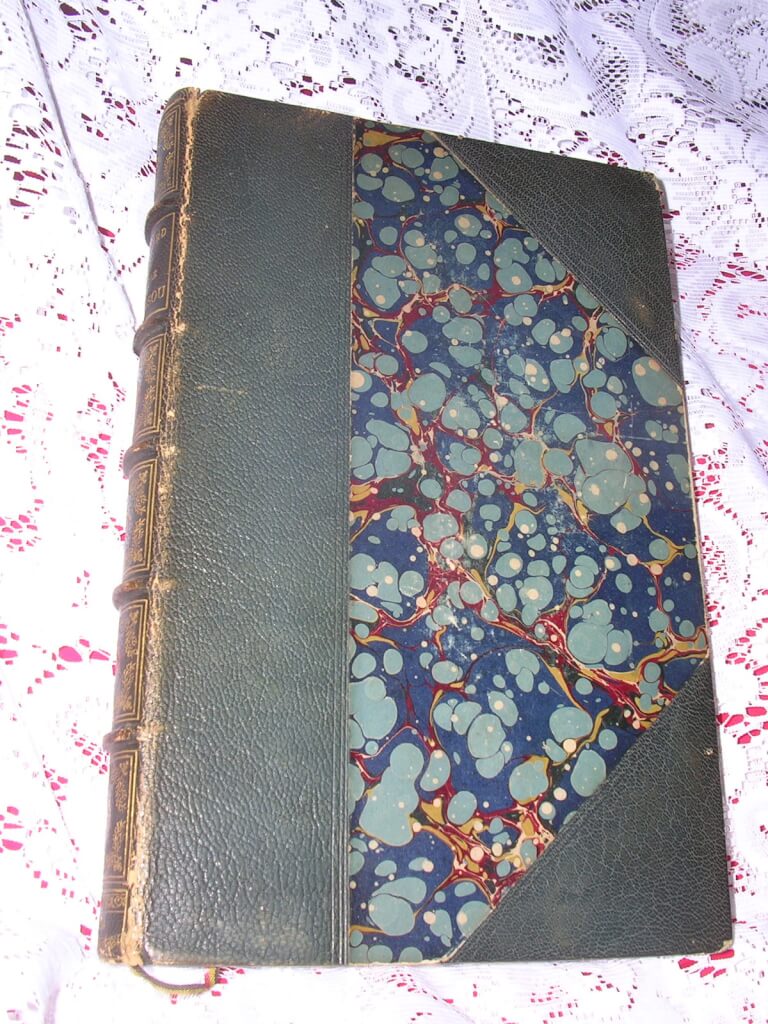 Mon Oncle Barbassou, Mario Uchard, illust. Paul Avril (J. Lemonnyer, Paris, 1884 [#394/1000, one of only 225 printed on Holland Paper]) 10" X 6.5", 311pp., hardbound in 3/4 dark blue morocco leather with gilt titles and decorations on spine with 5 raised bands, marbled endpapers, top edge gilt others deckled. First Illustrated Edition with many beautiful engravings by Paul Avril throughout. Some very slight wear to leather and boards, otherwise a very good+ copy overall clean, bright and structurally sound. #394/1000, one of only 275 in Holland Paper. Originally published in 4 parts in 1876, My Uncle Barbassou is a story of a man who inherits his uncle's estate which includes a newly purchased harem of 3 young girls. This novel is a prime example of the French "Orientalists" of the late 1800's. Scandalous for the age, but mild by today's standards, this book is in the original french. This is a beautifully bound copy of the First Illustrated Edition with plates by Paul Avril. Édouard-Henri Avril (1849-1928) used the pseudonym "Paul Avril" for his erotic work. He was a French painter and commercial artist. His career saw collaboration with influential people like Octave Uzanne, Henry Spencer Ashbee and Friedrich Karl Forberg. He is one of the most celebrated erotic artists of his age. Avril was a soldier before starting his career in art. He was awarded with the Legion of Honour for his actions in the Franco-Prussian War.
Mon Oncle Barbassou, Mario Uchard, illust. Paul Avril (J. Lemonnyer, Paris, 1884 [#394/1000, one of only 225 printed on Holland Paper]) 10" X 6.5", 311pp., hardbound in 3/4 dark blue morocco leather with gilt titles and decorations on spine with 5 raised bands, marbled endpapers, top edge gilt others deckled. First Illustrated Edition with many beautiful engravings by Paul Avril throughout. Some very slight wear to leather and boards, otherwise a very good+ copy overall clean, bright and structurally sound. #394/1000, one of only 275 in Holland Paper. Originally published in 4 parts in 1876, My Uncle Barbassou is a story of a man who inherits his uncle's estate which includes a newly purchased harem of 3 young girls. This novel is a prime example of the French "Orientalists" of the late 1800's. Scandalous for the age, but mild by today's standards, this book is in the original french. This is a beautifully bound copy of the First Illustrated Edition with plates by Paul Avril. Édouard-Henri Avril (1849-1928) used the pseudonym "Paul Avril" for his erotic work. He was a French painter and commercial artist. His career saw collaboration with influential people like Octave Uzanne, Henry Spencer Ashbee and Friedrich Karl Forberg. He is one of the most celebrated erotic artists of his age. Avril was a soldier before starting his career in art. He was awarded with the Legion of Honour for his actions in the Franco-Prussian War. -
 Julie, ou J'ai sauvé ma rose, Madame de C*** [Félicité Choiseul-Meuse] (Se trouve chez tous les Libraires Anglais, 1882) 8" x 5.25", 2 vol. bound together, 166pp 183pp, half calf on marbled boards, original wraps bound within, red label with gilt titles on spine, just good condition, boards intact, binding good, ribbon intact, major scuffing and bumping to the spine and rubbing to the boards. Felicite de Choiseul-Meuse wrote approximately twenty-seven novels from 1797 to 1824. Writings are sometimes identified by pseudonyms and acronyms: LFDLC; Emilia P ***, Madame de C *** , etc.. Her 1807 novel "Julie, ou j'ai sauvé ma rose" [Julie, or I saved my rose] is widely considered the first erotic novel written by a woman. It is more appropriately translated as "how I kept my cherry" for it tells the tale of a young woman who lets her lovers fondle her all they want, but will not allow penetration until she finds the right man and marries him. The work was condemned as obscene and its destruction ordered by the Cour royale de Paris on August 5, 1828. Excerpt: "I tasted in his arms unspeakable pleasures. Deadened by pleasure, then revived by an even more delirious pleasure, I made the object of happiness almost as happy as I was myself; and yet, true to my system, I made sure that he did not harvest the rose."
Julie, ou J'ai sauvé ma rose, Madame de C*** [Félicité Choiseul-Meuse] (Se trouve chez tous les Libraires Anglais, 1882) 8" x 5.25", 2 vol. bound together, 166pp 183pp, half calf on marbled boards, original wraps bound within, red label with gilt titles on spine, just good condition, boards intact, binding good, ribbon intact, major scuffing and bumping to the spine and rubbing to the boards. Felicite de Choiseul-Meuse wrote approximately twenty-seven novels from 1797 to 1824. Writings are sometimes identified by pseudonyms and acronyms: LFDLC; Emilia P ***, Madame de C *** , etc.. Her 1807 novel "Julie, ou j'ai sauvé ma rose" [Julie, or I saved my rose] is widely considered the first erotic novel written by a woman. It is more appropriately translated as "how I kept my cherry" for it tells the tale of a young woman who lets her lovers fondle her all they want, but will not allow penetration until she finds the right man and marries him. The work was condemned as obscene and its destruction ordered by the Cour royale de Paris on August 5, 1828. Excerpt: "I tasted in his arms unspeakable pleasures. Deadened by pleasure, then revived by an even more delirious pleasure, I made the object of happiness almost as happy as I was myself; and yet, true to my system, I made sure that he did not harvest the rose." -
 Julie, ou J'ai sauvé ma rose, Madame de C*** [Félicité Choiseul-Meuse] (J.-J. Gay, Bruxelles, 1882) 8" x 5.25", 2 vol. 169pp 188pp, full mottled calf, marbled endpapers. Gilt lettering and decorations on spine, 5 raised bands. 2 frontispiece engravings. just Fair condition, interior good, exterior in poor shape, Vol. 1 boards loose, Vol. 2 boards detached. Felicite de Choiseul-Meuse wrote approximately twenty-seven novels from 1797 to 1824. Writings are sometimes identified by pseudonyms and acronyms: LFDLC; Emilia P ***, Madame de C *** , etc.. Her 1807 novel "Julie, ou j'ai sauvé ma rose" [Julie, or I saved my rose] is widely considered the first erotic novel written by a woman. It is more appropriately translated as "how I kept my cherry" for it tells the tale of a young woman who lets her lovers fondle her all they want, but will not allow penetration until she finds the right man and marries him. The work was condemned as obscene and its destruction ordered by the Cour royale de Paris on August 5, 1828. Excerpt: "I tasted in his arms unspeakable pleasures. Deadened by pleasure, then revived by an even more delirious pleasure, I made the object of happiness almost as happy as I was myself; and yet, true to my system, I made sure that he did not harvest the rose."
Julie, ou J'ai sauvé ma rose, Madame de C*** [Félicité Choiseul-Meuse] (J.-J. Gay, Bruxelles, 1882) 8" x 5.25", 2 vol. 169pp 188pp, full mottled calf, marbled endpapers. Gilt lettering and decorations on spine, 5 raised bands. 2 frontispiece engravings. just Fair condition, interior good, exterior in poor shape, Vol. 1 boards loose, Vol. 2 boards detached. Felicite de Choiseul-Meuse wrote approximately twenty-seven novels from 1797 to 1824. Writings are sometimes identified by pseudonyms and acronyms: LFDLC; Emilia P ***, Madame de C *** , etc.. Her 1807 novel "Julie, ou j'ai sauvé ma rose" [Julie, or I saved my rose] is widely considered the first erotic novel written by a woman. It is more appropriately translated as "how I kept my cherry" for it tells the tale of a young woman who lets her lovers fondle her all they want, but will not allow penetration until she finds the right man and marries him. The work was condemned as obscene and its destruction ordered by the Cour royale de Paris on August 5, 1828. Excerpt: "I tasted in his arms unspeakable pleasures. Deadened by pleasure, then revived by an even more delirious pleasure, I made the object of happiness almost as happy as I was myself; and yet, true to my system, I made sure that he did not harvest the rose." -
 The Dialogues of Luisa Sigea, Nicolas Chorier, translation by Isadore Liseux (Isadore Liseux, Paris, 1890, first edition, first English translation, printed by Ch. Unsinger) 8.75" X 5.75", 2nd and 3rd books of a 3 vol set, 132pp, 98+2pp, 3/4 crimson morocco over red boards, gilt decorations and titles on spine, top edge gilt, others deckled. Excellent condition for age, very minor bumping on corners and top and bottom of spine. In six dialogues (I. The skirmish; II. Tribadicon; III. Fabric; IV. The duel; V. Pleasures; VI. Frolics and sports) Tullia, who is 26, initiates her 15 year old cousin, Ottavia, in the art of sexual pleasure. The first four dialogues (not present), are fairly short, focus on tribadism and defloration. The longer fifth and six dialogues introduce flagellation, contractual submission, group sex, and anal sex. Like many sexual fictions, The Dialogues of Luisa Sigea (originally written in latin "Aloisiae Sigeae Satyra Sotadica de arcanis Amoris et Veneris") attempts to conceal the identity of its author: it purports to be based on a Latin manuscript translation of a work written originally in Spanish in the sixteenth century by an erudite young woman, Luisa Sigea of Toledo and translated into latin by Jean Meursius of Holland. In fact, it was written c. 1660, in latin, by a Frenchman, Nicolas Chorier (1612-1692), a lawyer who wrote works on various historical and philosophical subjects. The first first French translation, L’Academie des dames, was issued in the 1680. This 1890 edition was for the first time translated into English by Isidore Liseux and issued as a 3 volume set. (1. I-IV, 2. V, 3. VI). Vol 1 is missing from this set. Isidore Liseux (1835-1894) was a French bibliophile and publisher of erotica and curiosa. His publications were mostly rare texts of 16th to 18th century authors, hard to find and little known books which were usually translated and annotated by his friend and associate Alcide Bonneau or by Liseux himself. Liseux and Bonneau, both ex-priests, knew each other since seminary. His books were published in small numbers, on high quality paper, and with excellent typography. His usual printers were Claude Motteroz, Antoine Bécus, and later Charles Unsinger. Liseux's books were published openly as the climate was more permissive in Paris at the time. His books were so well regarded that pirates of his books and even unrelated books bearing his imprint with a false date were published clandestinely into the 20th century. French poet, Guillaume Apollinaire wrote: "The publications of Liseux are more and more sought after because they are correct, beautiful and rare." (Le flaneur des deux rives, 1918).
The Dialogues of Luisa Sigea, Nicolas Chorier, translation by Isadore Liseux (Isadore Liseux, Paris, 1890, first edition, first English translation, printed by Ch. Unsinger) 8.75" X 5.75", 2nd and 3rd books of a 3 vol set, 132pp, 98+2pp, 3/4 crimson morocco over red boards, gilt decorations and titles on spine, top edge gilt, others deckled. Excellent condition for age, very minor bumping on corners and top and bottom of spine. In six dialogues (I. The skirmish; II. Tribadicon; III. Fabric; IV. The duel; V. Pleasures; VI. Frolics and sports) Tullia, who is 26, initiates her 15 year old cousin, Ottavia, in the art of sexual pleasure. The first four dialogues (not present), are fairly short, focus on tribadism and defloration. The longer fifth and six dialogues introduce flagellation, contractual submission, group sex, and anal sex. Like many sexual fictions, The Dialogues of Luisa Sigea (originally written in latin "Aloisiae Sigeae Satyra Sotadica de arcanis Amoris et Veneris") attempts to conceal the identity of its author: it purports to be based on a Latin manuscript translation of a work written originally in Spanish in the sixteenth century by an erudite young woman, Luisa Sigea of Toledo and translated into latin by Jean Meursius of Holland. In fact, it was written c. 1660, in latin, by a Frenchman, Nicolas Chorier (1612-1692), a lawyer who wrote works on various historical and philosophical subjects. The first first French translation, L’Academie des dames, was issued in the 1680. This 1890 edition was for the first time translated into English by Isidore Liseux and issued as a 3 volume set. (1. I-IV, 2. V, 3. VI). Vol 1 is missing from this set. Isidore Liseux (1835-1894) was a French bibliophile and publisher of erotica and curiosa. His publications were mostly rare texts of 16th to 18th century authors, hard to find and little known books which were usually translated and annotated by his friend and associate Alcide Bonneau or by Liseux himself. Liseux and Bonneau, both ex-priests, knew each other since seminary. His books were published in small numbers, on high quality paper, and with excellent typography. His usual printers were Claude Motteroz, Antoine Bécus, and later Charles Unsinger. Liseux's books were published openly as the climate was more permissive in Paris at the time. His books were so well regarded that pirates of his books and even unrelated books bearing his imprint with a false date were published clandestinely into the 20th century. French poet, Guillaume Apollinaire wrote: "The publications of Liseux are more and more sought after because they are correct, beautiful and rare." (Le flaneur des deux rives, 1918). -

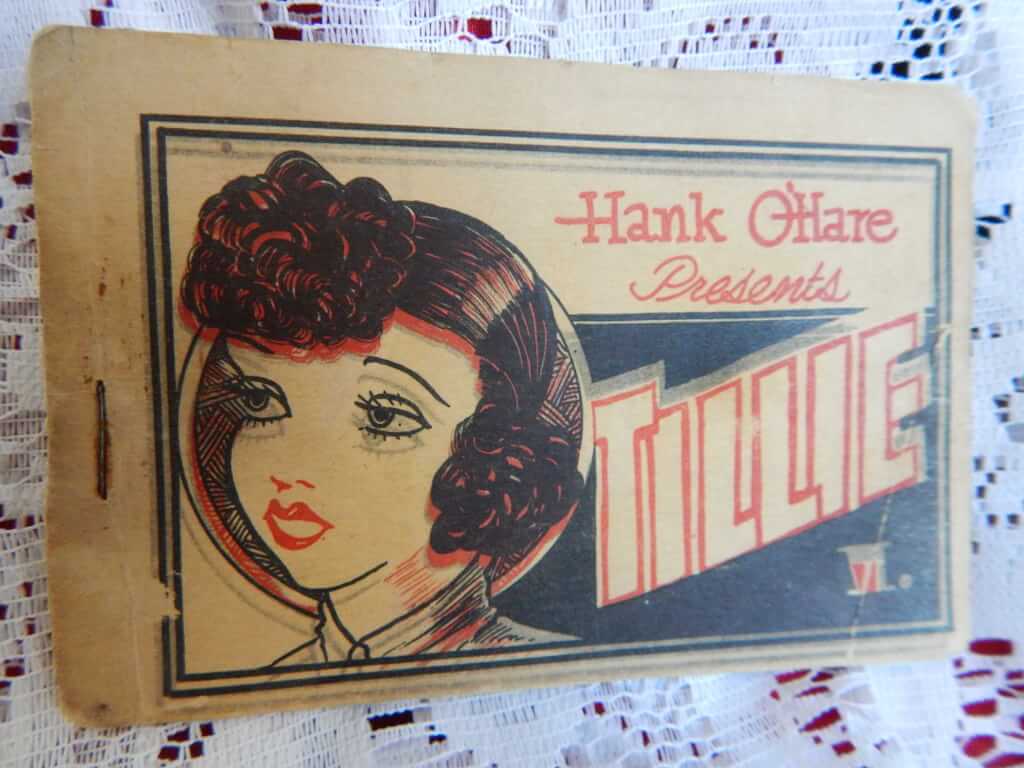 Hank O'Hare presents Tillie, (np. nd.) 4.5" x 3", 8pp., pamphlet, stapled and taped Tijuana bibles (also known as eight-pagers, bluesies, gray-backs, Jiggs-and-Maggie books, jo-jo books, Tillie-and-Mac books, and two-by-fours) were little pornographic comic books produced in the United States from the 1920s to the early 1960s.
Hank O'Hare presents Tillie, (np. nd.) 4.5" x 3", 8pp., pamphlet, stapled and taped Tijuana bibles (also known as eight-pagers, bluesies, gray-backs, Jiggs-and-Maggie books, jo-jo books, Tillie-and-Mac books, and two-by-fours) were little pornographic comic books produced in the United States from the 1920s to the early 1960s. -
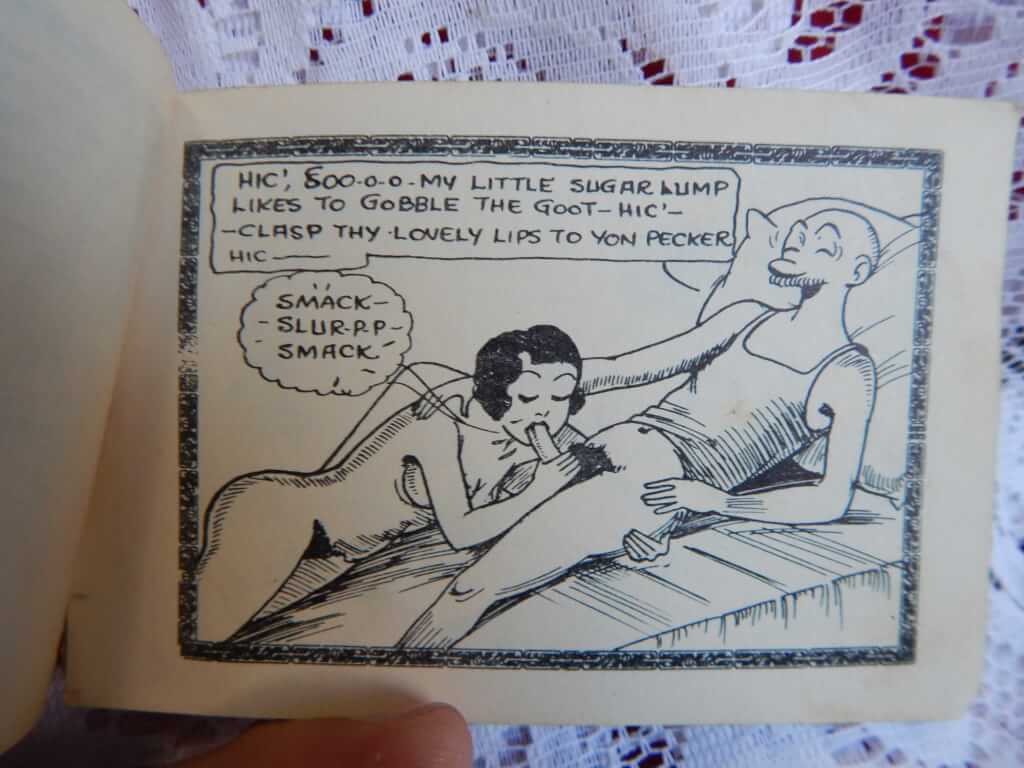
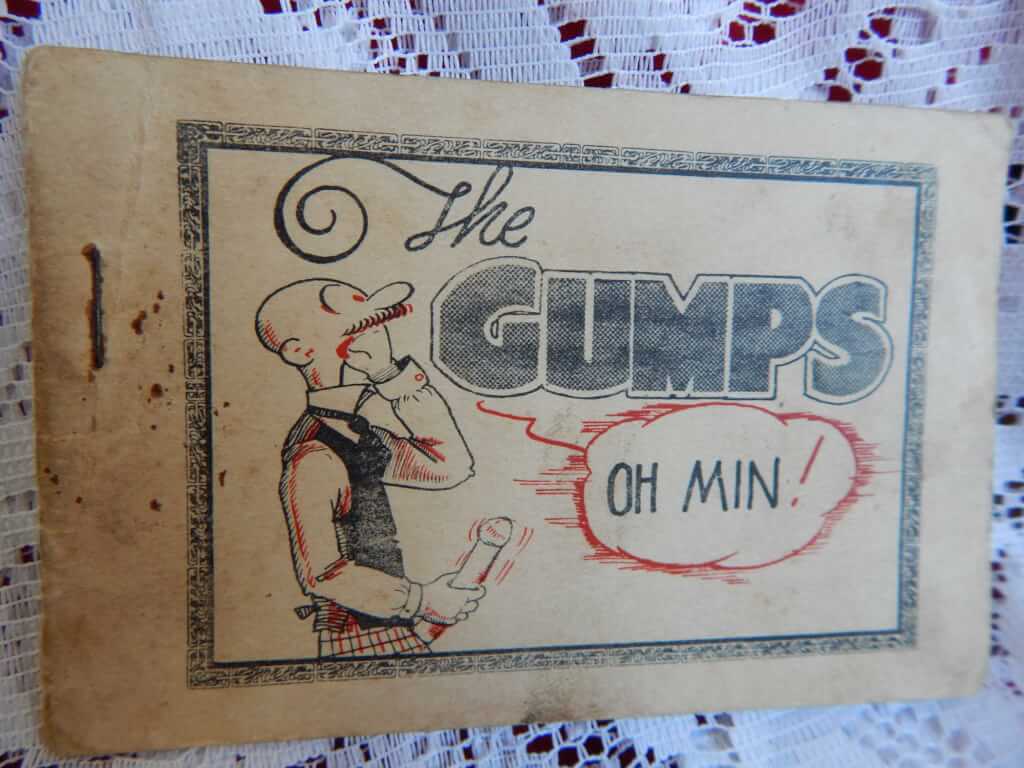 The Gumps - Oh Min!, (np. nd.) 4.5" x 3", 8pp. pamphlet, stapled Tijuana bibles (also known as eight-pagers, bluesies, gray-backs, Jiggs-and-Maggie books, jo-jo books, Tillie-and-Mac books, and two-by-fours) were little pornographic comic books produced in the United States from the 1920s to the early 1960s.
The Gumps - Oh Min!, (np. nd.) 4.5" x 3", 8pp. pamphlet, stapled Tijuana bibles (also known as eight-pagers, bluesies, gray-backs, Jiggs-and-Maggie books, jo-jo books, Tillie-and-Mac books, and two-by-fours) were little pornographic comic books produced in the United States from the 1920s to the early 1960s. -
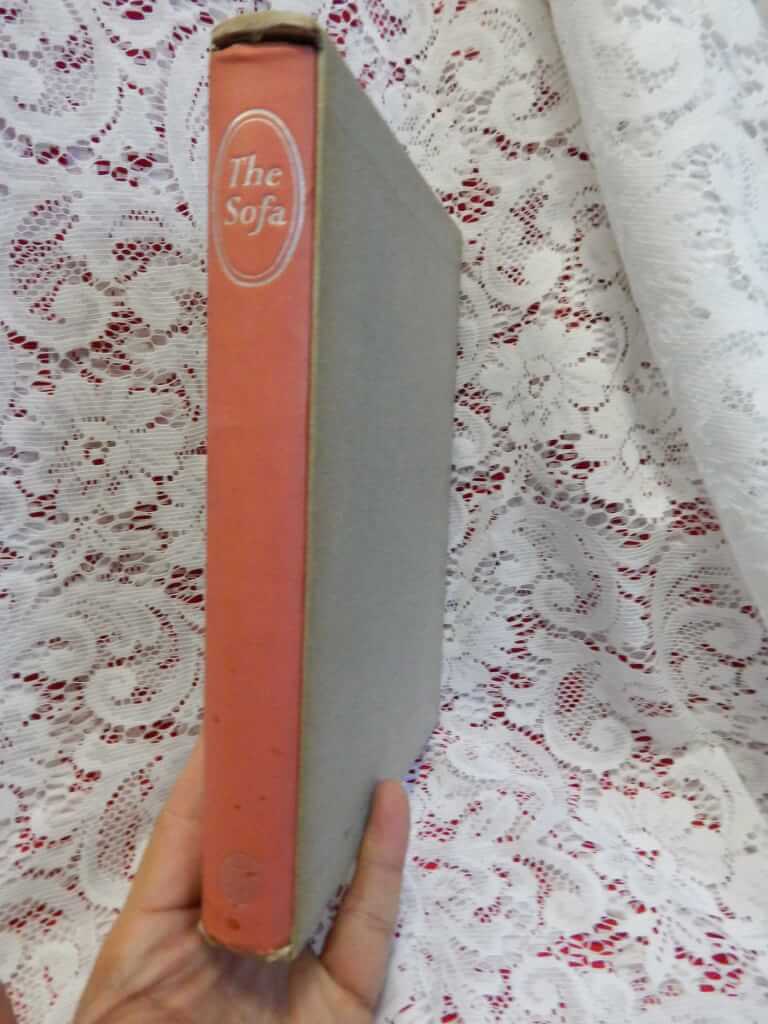
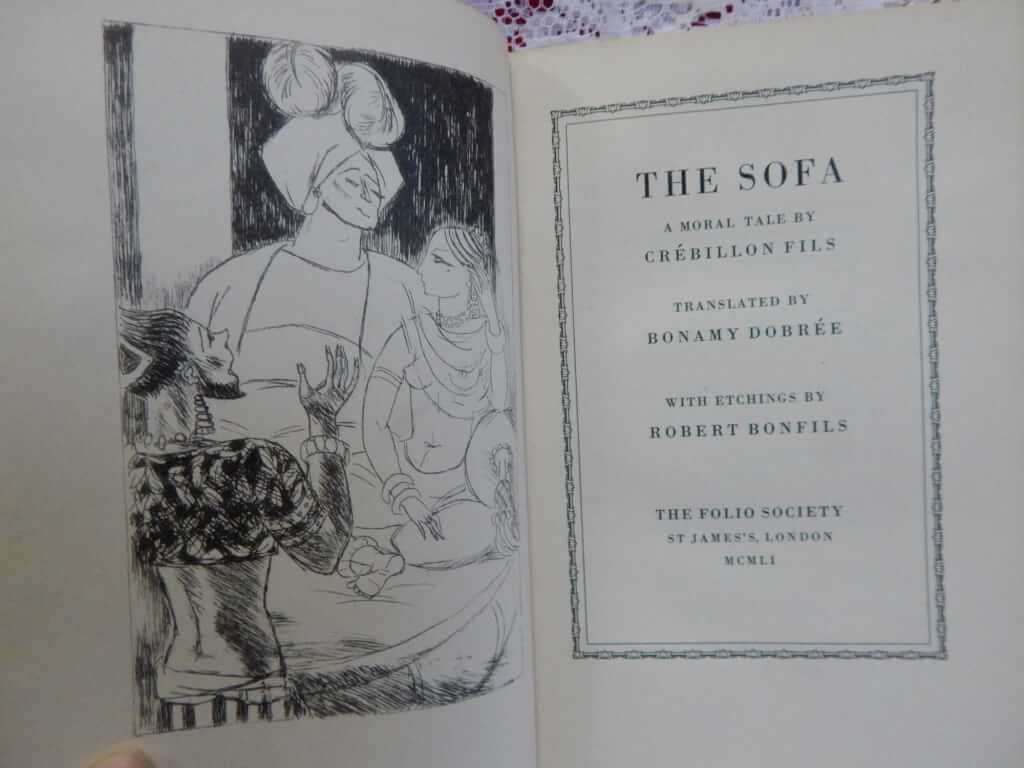 The Sofa, a moral tale by Crébillon fils, trans. Bonamy Dobrée, illus. Robert Bonfils (The Folio Society, St. James's, London, 1951) 6.75"x9.25", v+256, red boards with silver gilt decorations on spine, spine only slightly sunned, slipcase The Sofa: A Moral Tale (French: Le Sopha, conte moral) is a 1742 libertine novel by Claude Prosper Jolyot de Crébillon (Crebillon fils). It was first translated into English in the spring of 1742. The story concerns a young courtier, Amanzéï, whose soul in a previous life was condemned by Brahma to inhabit a series of sofas, and not to be reincarnated in a human body until two virgin lovers had consummated their passion for him. The novel is structured as a frame story in an oriental setting, explicitly evocative of the Arabian Nights, in which Amanzéï recounts the adventures of seven couples, which he witnessed in his sofa form, to the bored sultan Shah Baham (grandson of Shehryār and Scheherazade). The longest episode, that of Zulica, takes up nine chapters; the final episode concerns the teenage Zéïnis et Phéléas. Amanzéï, witnessing their innocent pleasure, is edified and freed through the experience of virtuous love. Many of the characters in the novel are satirical portraits of influential and powerful Parisians of Crébillon’s time; the author takes the opportunity to ridicule hypocrisy in its different forms (worldly respectability, virtue, religious devotion). Although the book was published anonymously and with a false imprint, Crébillon was discovered to be the author and was exiled to a distance of thirty leagues from Paris on April 7, 1742. He was able to return on July 22, after claiming that the work had been commissioned by Frederick II of Prussia and that it had been published against his will. Robert Bonfils started his illustration career in Chicago in the mid fifties, doing various commercial art assignments such as advertisements, lunch box decorations, catalog illustrations, magazine covers, interior story illustrations, record jacket covers, and book covers. He is best known for his covers for erotic, pulp fiction paperbacks.
The Sofa, a moral tale by Crébillon fils, trans. Bonamy Dobrée, illus. Robert Bonfils (The Folio Society, St. James's, London, 1951) 6.75"x9.25", v+256, red boards with silver gilt decorations on spine, spine only slightly sunned, slipcase The Sofa: A Moral Tale (French: Le Sopha, conte moral) is a 1742 libertine novel by Claude Prosper Jolyot de Crébillon (Crebillon fils). It was first translated into English in the spring of 1742. The story concerns a young courtier, Amanzéï, whose soul in a previous life was condemned by Brahma to inhabit a series of sofas, and not to be reincarnated in a human body until two virgin lovers had consummated their passion for him. The novel is structured as a frame story in an oriental setting, explicitly evocative of the Arabian Nights, in which Amanzéï recounts the adventures of seven couples, which he witnessed in his sofa form, to the bored sultan Shah Baham (grandson of Shehryār and Scheherazade). The longest episode, that of Zulica, takes up nine chapters; the final episode concerns the teenage Zéïnis et Phéléas. Amanzéï, witnessing their innocent pleasure, is edified and freed through the experience of virtuous love. Many of the characters in the novel are satirical portraits of influential and powerful Parisians of Crébillon’s time; the author takes the opportunity to ridicule hypocrisy in its different forms (worldly respectability, virtue, religious devotion). Although the book was published anonymously and with a false imprint, Crébillon was discovered to be the author and was exiled to a distance of thirty leagues from Paris on April 7, 1742. He was able to return on July 22, after claiming that the work had been commissioned by Frederick II of Prussia and that it had been published against his will. Robert Bonfils started his illustration career in Chicago in the mid fifties, doing various commercial art assignments such as advertisements, lunch box decorations, catalog illustrations, magazine covers, interior story illustrations, record jacket covers, and book covers. He is best known for his covers for erotic, pulp fiction paperbacks. -

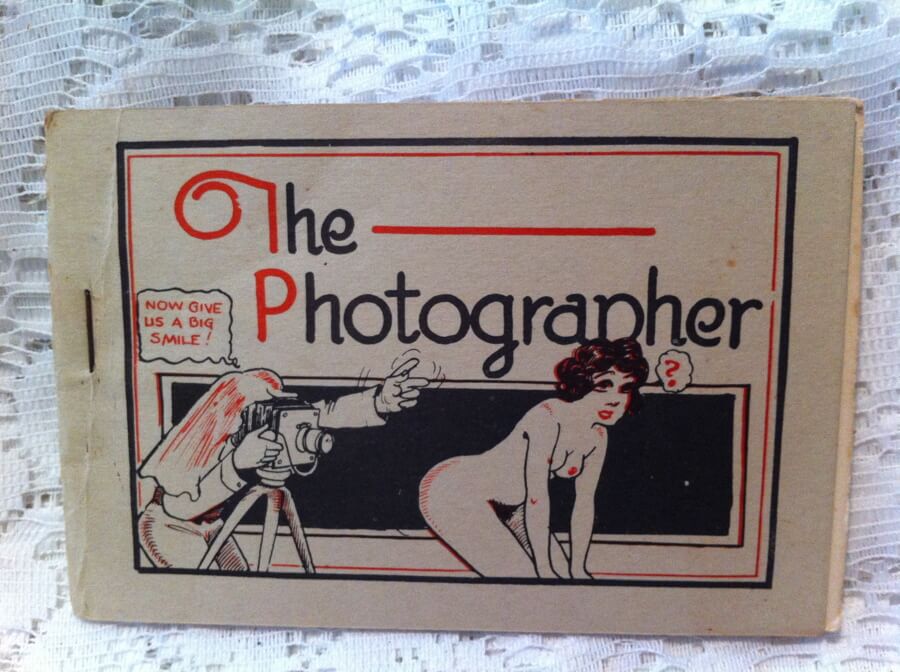 The Photographer, (n.p. n.d.) 4.5" x 3", 8pp. pamphlet, stapled Tijuana bibles (also known as eight-pagers, bluesies, gray-backs, Jiggs-and-Maggie books, jo-jo books, Tillie-and-Mac books, and two-by-fours) were little pornographic comic books produced in the United States from the 1920s to the early 1960s.
The Photographer, (n.p. n.d.) 4.5" x 3", 8pp. pamphlet, stapled Tijuana bibles (also known as eight-pagers, bluesies, gray-backs, Jiggs-and-Maggie books, jo-jo books, Tillie-and-Mac books, and two-by-fours) were little pornographic comic books produced in the United States from the 1920s to the early 1960s. -
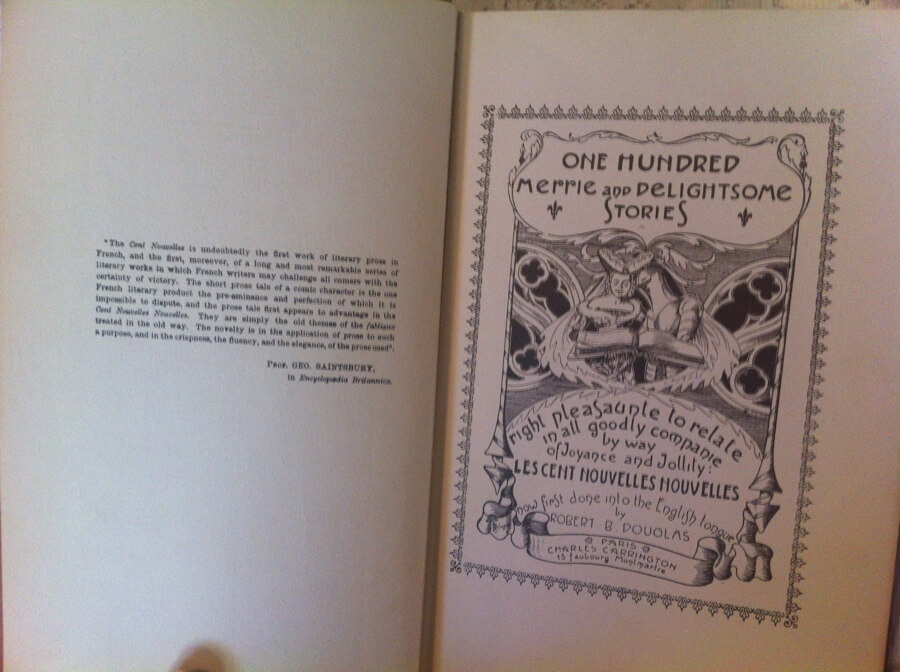
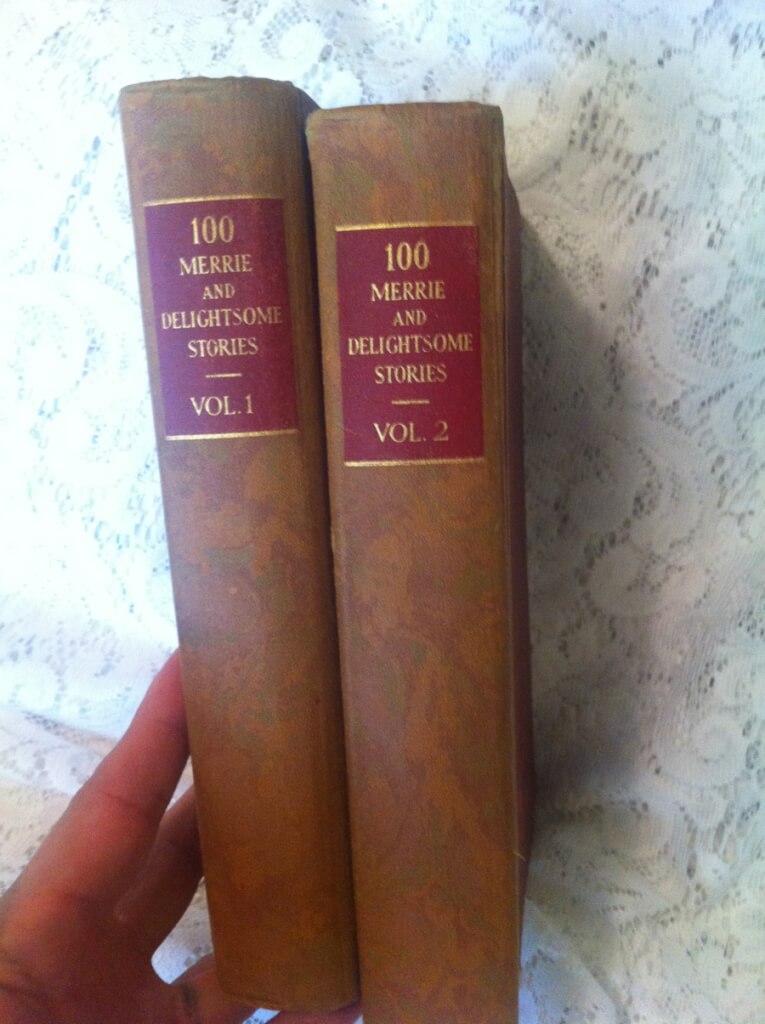 One Hundred Merrie and Delightsome Stories, ed. by Antoine de La Sale, trans. Robert B. Douglas (Charles Carrington, Paris, 1899 [pirated facimile reprint, probably New York, c.1930 states "privately printed from the Charles Carrington Paris 1899 edition] #294/1250) 8" X 5.75", two volumes, xxx+532pp, pagination continuous. Fifty-two b&w plates by Léon Lebègue, marbled boards, gilt on spine, top edge gilt, other edges deckled, very good condition, minor bumping, some stains on front cover of vol. 2 Charles Carrington was the first to have this translated into English. This is a pirated copy, but still very nicely printed on good paper, the illustrations are in B&W. Purported a collection of short stories narrated by various persons at the court of Philippe le Bon, and collected together by Antoine de la Sale, the nouvelles are, according to the authority on French Literature—Professor George Saintsbury "undoubtedly the first work of literary prose in French ... The short prose tale of a comic character is the one French literary product the pre-eminence and perfection of which it is impossible to dispute, and the prose tale first appears to advantage in the Cent Nouvelles Nouvelles." The stories give a curious glimpses of life in the 15th century, providing a genuine view of the social condition of the nobility and the middle classes. M. Lenient, a French critic, says: "Generally the incidents and personages belong to the bourgeoisée; there is nothing chivalric, nothing wonderful; no dreamy lovers, romantic dames, fairies, or enchanters. Noble dames, bourgeois, nuns, knights, merchants, monks, and peasants mutually dupe each other. The lord deceives the miller's wife by imposing on her simplicity, and the miller retaliates in much the same manner. The shepherd marries the knight's sister, and the nobleman is not over scandalized. The vices of the monks are depicted in half a score tales, and the seducers are punished with a severity not always in proportion to the offence." For four centuries 10 of the stories were credited to Louis XI. Modern scholars have since ascribed them to either Philippe le Bel or Comte de Charolais. In all, some thirty-two noblemen or squires contributed the stories, with some 14 or 15 taken from Giovanni Boccaccio, and as many more from Gian Francesco Poggio Bracciolini or other Italian writers, or French fabliaux, but about 70 of them appear to be original.
One Hundred Merrie and Delightsome Stories, ed. by Antoine de La Sale, trans. Robert B. Douglas (Charles Carrington, Paris, 1899 [pirated facimile reprint, probably New York, c.1930 states "privately printed from the Charles Carrington Paris 1899 edition] #294/1250) 8" X 5.75", two volumes, xxx+532pp, pagination continuous. Fifty-two b&w plates by Léon Lebègue, marbled boards, gilt on spine, top edge gilt, other edges deckled, very good condition, minor bumping, some stains on front cover of vol. 2 Charles Carrington was the first to have this translated into English. This is a pirated copy, but still very nicely printed on good paper, the illustrations are in B&W. Purported a collection of short stories narrated by various persons at the court of Philippe le Bon, and collected together by Antoine de la Sale, the nouvelles are, according to the authority on French Literature—Professor George Saintsbury "undoubtedly the first work of literary prose in French ... The short prose tale of a comic character is the one French literary product the pre-eminence and perfection of which it is impossible to dispute, and the prose tale first appears to advantage in the Cent Nouvelles Nouvelles." The stories give a curious glimpses of life in the 15th century, providing a genuine view of the social condition of the nobility and the middle classes. M. Lenient, a French critic, says: "Generally the incidents and personages belong to the bourgeoisée; there is nothing chivalric, nothing wonderful; no dreamy lovers, romantic dames, fairies, or enchanters. Noble dames, bourgeois, nuns, knights, merchants, monks, and peasants mutually dupe each other. The lord deceives the miller's wife by imposing on her simplicity, and the miller retaliates in much the same manner. The shepherd marries the knight's sister, and the nobleman is not over scandalized. The vices of the monks are depicted in half a score tales, and the seducers are punished with a severity not always in proportion to the offence." For four centuries 10 of the stories were credited to Louis XI. Modern scholars have since ascribed them to either Philippe le Bel or Comte de Charolais. In all, some thirty-two noblemen or squires contributed the stories, with some 14 or 15 taken from Giovanni Boccaccio, and as many more from Gian Francesco Poggio Bracciolini or other Italian writers, or French fabliaux, but about 70 of them appear to be original. -
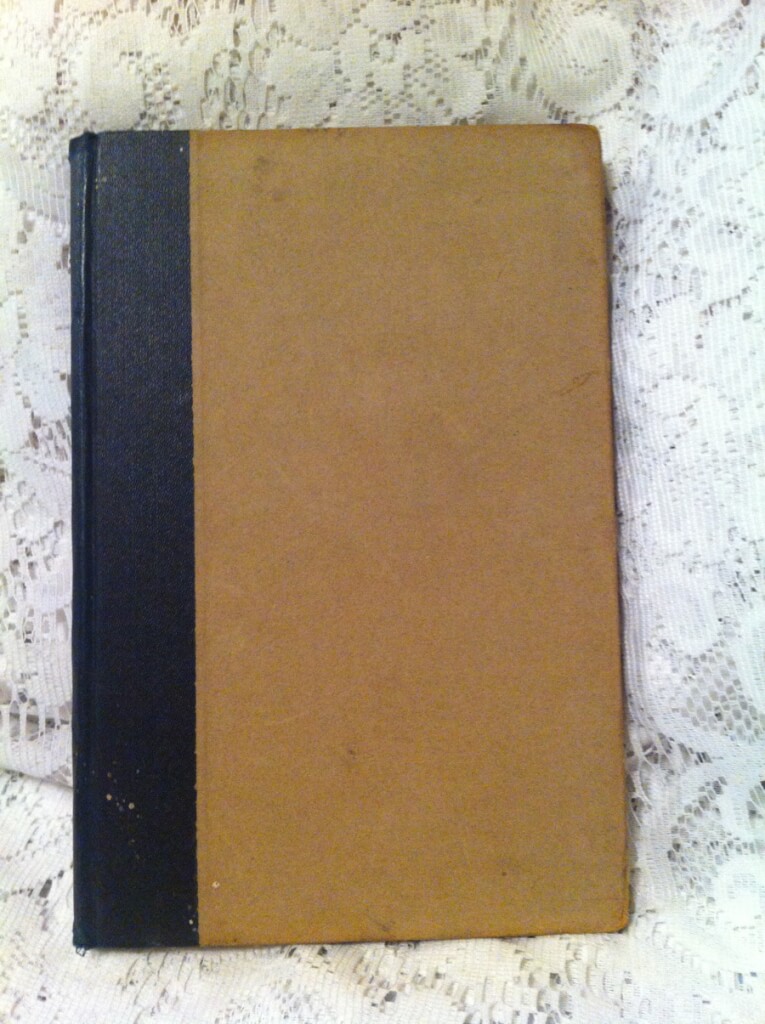
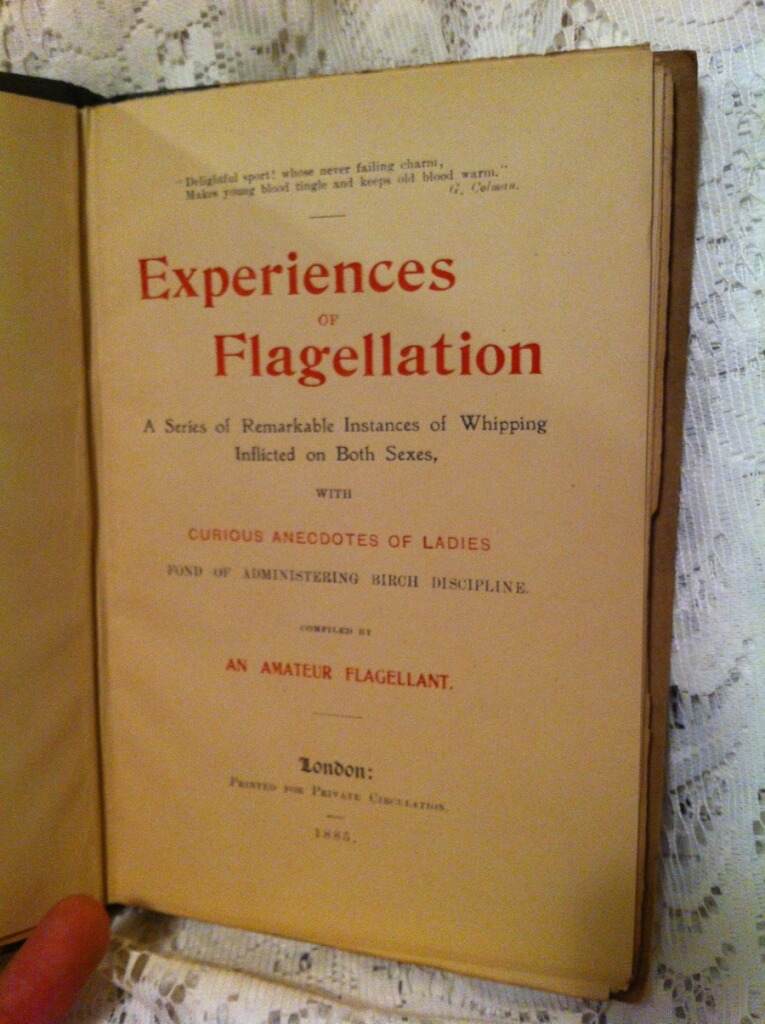 Experiences of Flagellation: A Series of Remarkable Instances of Whipping Inflicted on Both Sexes, With Curious Anecdotes of Ladies Fond of Administering Birch Discipline., "compiled by An Amateur Flagallant" (Printed for Private Circulation, London, 1885, first edition) 5.25"x 8", 80pp, hardbound no DJ, tan boards with blue spine, fair condition for age, some bumping to boards, binding fragile but holding, split between first and second signature, page 15/16 detached. A great read! Forward asserts God ordained pain and punishment, even animals fear it, it is his police department, not to punish is to keep a boy out of God's school. The rod should be used ceremoniously. Even girls up to 18 have often ben greatly improved for life by "Dr. Spankster's" cure wisely administered. Sections include: Flogging Girls, Wife Beating, A Conjugal Scene, Lady Preparing for Birching, and many more.
Experiences of Flagellation: A Series of Remarkable Instances of Whipping Inflicted on Both Sexes, With Curious Anecdotes of Ladies Fond of Administering Birch Discipline., "compiled by An Amateur Flagallant" (Printed for Private Circulation, London, 1885, first edition) 5.25"x 8", 80pp, hardbound no DJ, tan boards with blue spine, fair condition for age, some bumping to boards, binding fragile but holding, split between first and second signature, page 15/16 detached. A great read! Forward asserts God ordained pain and punishment, even animals fear it, it is his police department, not to punish is to keep a boy out of God's school. The rod should be used ceremoniously. Even girls up to 18 have often ben greatly improved for life by "Dr. Spankster's" cure wisely administered. Sections include: Flogging Girls, Wife Beating, A Conjugal Scene, Lady Preparing for Birching, and many more. -

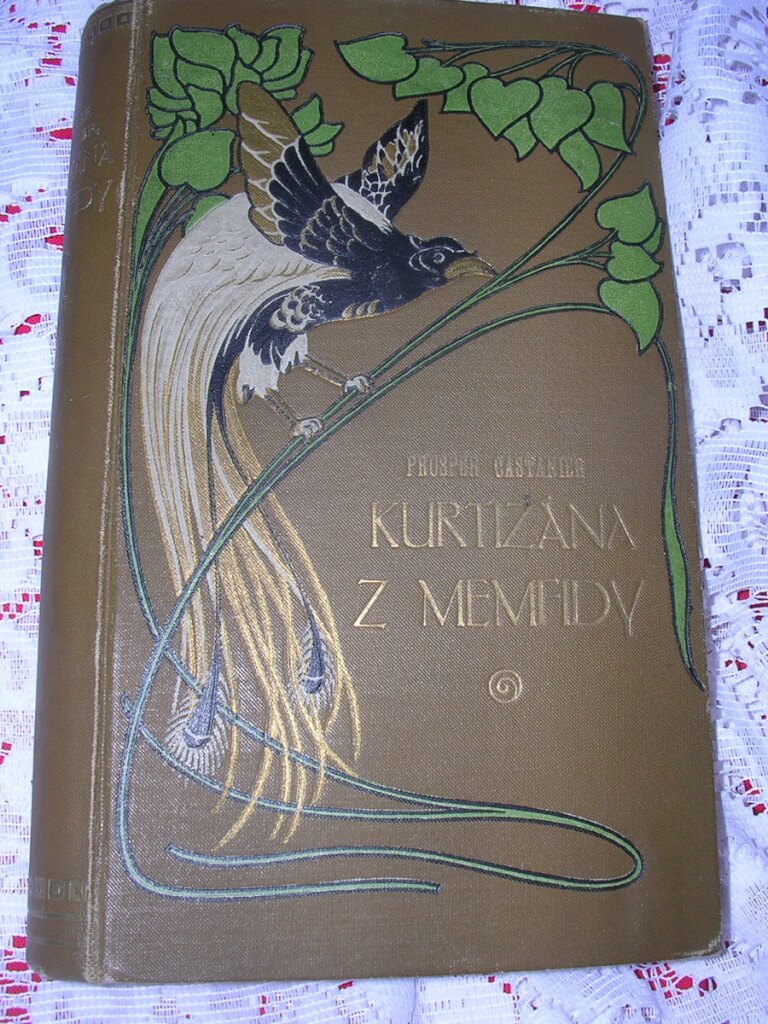 Kurtizána z Memfidy: Anticky román [Czech], Prosper Castanier, trans. Karel Weinfurter, illus. A. Calbeta (Alois Hynek, Praha [Prague], nd [c. 1901], printed by J. Rokyta, Praha) 7" x 4.5", 312pp, hardbound brown decorated cloth boards with gilt and other colors, gilt lettering and design on spine. Top edge gilt. Illustrated throughout with 4 choice illustrations duplicated in alternating red and green before title page. Great condition of a very rare book. This is a rare Czech translation of The Courtesan of Memphis, Czech Memfidy (Memphis) book, also in the rare publisher's original cloth-binding. The publisher, Alois Hynek, translated this and many of Castanier's books into German. These books had similiarly decorated covers. Most of the Hynek's Czech translations one finds are softcover. This is a rare hardcover translation into Czech. It is beautifully illustrated The French author, poet, novelist and historian Prosper Castanier (1865-19??) was born in Saint-Ambroix (Gard). He was the editor-in-chief of the "Progrès du midi". He had made a specialty of novels set in antiquity. (Particularly after the success of Aphrodite by Pierre Louès, published in 1896)
Kurtizána z Memfidy: Anticky román [Czech], Prosper Castanier, trans. Karel Weinfurter, illus. A. Calbeta (Alois Hynek, Praha [Prague], nd [c. 1901], printed by J. Rokyta, Praha) 7" x 4.5", 312pp, hardbound brown decorated cloth boards with gilt and other colors, gilt lettering and design on spine. Top edge gilt. Illustrated throughout with 4 choice illustrations duplicated in alternating red and green before title page. Great condition of a very rare book. This is a rare Czech translation of The Courtesan of Memphis, Czech Memfidy (Memphis) book, also in the rare publisher's original cloth-binding. The publisher, Alois Hynek, translated this and many of Castanier's books into German. These books had similiarly decorated covers. Most of the Hynek's Czech translations one finds are softcover. This is a rare hardcover translation into Czech. It is beautifully illustrated The French author, poet, novelist and historian Prosper Castanier (1865-19??) was born in Saint-Ambroix (Gard). He was the editor-in-chief of the "Progrès du midi". He had made a specialty of novels set in antiquity. (Particularly after the success of Aphrodite by Pierre Louès, published in 1896) -

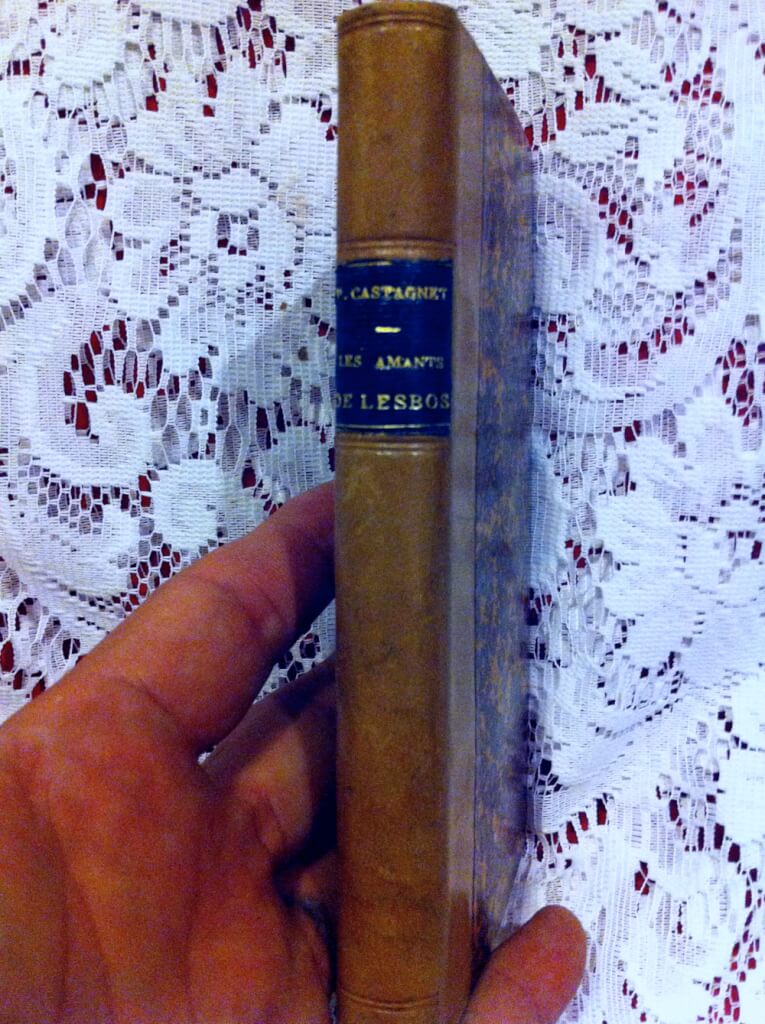 Les Amants de Lesbos, Prosper Castanier, illus. Franz Schmidt (Librairie L. Borel, Paris, 1900) 6" X 3.25", 116pp, Hardbound in 1/4 tan leather over marbled boards, marbled end-papers, glassine protective tissue for title page with gold emblem stamped on it. Very good condition. An imagination of the life and loves of the poet Sappho and her fight against the tyrant of Mytilene. The French author, poet, novelist and historian Prosper Castanier (1865-19??) was born in Saint-Ambroix (Gard). He was the editor-in-chief of the "Progrès du midi". He had made a specialty of novels set in antiquity. (Particularly after the success of Aphrodite by Pierre Louès, published in 1896)
Les Amants de Lesbos, Prosper Castanier, illus. Franz Schmidt (Librairie L. Borel, Paris, 1900) 6" X 3.25", 116pp, Hardbound in 1/4 tan leather over marbled boards, marbled end-papers, glassine protective tissue for title page with gold emblem stamped on it. Very good condition. An imagination of the life and loves of the poet Sappho and her fight against the tyrant of Mytilene. The French author, poet, novelist and historian Prosper Castanier (1865-19??) was born in Saint-Ambroix (Gard). He was the editor-in-chief of the "Progrès du midi". He had made a specialty of novels set in antiquity. (Particularly after the success of Aphrodite by Pierre Louès, published in 1896) -
 Marriage Ceremonies and Priapic Rites in India and the East, "by a member of the Royal Asiatic Society" (Printed for Private Circulation Only, 1909) 9" X 7.25", 107pp., hardbound, blue cloth boards, gilt and red titles on spine, top edge gilt. Very good condition, binding good hinges good. From forward: "The sentiments of Hindu Sages that follow have been chosen mostly from well-known books. They are instructive in many respects, and pretend to be nothing but a collection of notes made by the author while seeking a solution to his own doubts and difficulties... So this monograph--the subject of which is the one most intimately bound up with the life of every man and woman--will be found useful and interesting, both to the Aryans of the East, and to the Aryans of the West, and further needs no apology for its appearance."
Marriage Ceremonies and Priapic Rites in India and the East, "by a member of the Royal Asiatic Society" (Printed for Private Circulation Only, 1909) 9" X 7.25", 107pp., hardbound, blue cloth boards, gilt and red titles on spine, top edge gilt. Very good condition, binding good hinges good. From forward: "The sentiments of Hindu Sages that follow have been chosen mostly from well-known books. They are instructive in many respects, and pretend to be nothing but a collection of notes made by the author while seeking a solution to his own doubts and difficulties... So this monograph--the subject of which is the one most intimately bound up with the life of every man and woman--will be found useful and interesting, both to the Aryans of the East, and to the Aryans of the West, and further needs no apology for its appearance." -
 1601 A Tudor Fireside Conversation As Written by the Ingenuous, Virtuous and learned Mark Twain, wit., Embellished by the worthy Alan Odle, Mark Twain, illustrations Alan Odle (Land's End Press, USA, 1969, stated "At London, Printed for Subscribers Only and are to be sold at ye beare Back-Side in Maiden Lane") 8.75"x11.25", 24pp (unpaginated), hardbound with mylar-protected dust jacket, red boards with gilt titles [Date: 1601.] Conversation, as it was the Social Fireside, in the Time of the Tudors is the title of a humorous work by Mark Twain, first published anonymously in 1880. Edward Wagenknecht once referred to it as "the most famous piece of pornography in American literature." Its content is irreverent and vulgar rather than obscene, and its purpose seems to be comedic shock rather than erotic arousal. It would thus qualify as ribaldry rather than pornography. Twain wrote 1601 during the summer of 1876 (between writing Tom Sawyer and Huckleberry Finn), for the amusement of his closest friend, Reverend Joseph Twichell, 1601 was later first published by another friend, John Hay, who later became Secretary of State. The work circulated among printers (due to it's often archaic type font) and many small batches were printed, however the authorship of the work remained unverified until Twain finally acknowledged he wrote it in 1906.
1601 A Tudor Fireside Conversation As Written by the Ingenuous, Virtuous and learned Mark Twain, wit., Embellished by the worthy Alan Odle, Mark Twain, illustrations Alan Odle (Land's End Press, USA, 1969, stated "At London, Printed for Subscribers Only and are to be sold at ye beare Back-Side in Maiden Lane") 8.75"x11.25", 24pp (unpaginated), hardbound with mylar-protected dust jacket, red boards with gilt titles [Date: 1601.] Conversation, as it was the Social Fireside, in the Time of the Tudors is the title of a humorous work by Mark Twain, first published anonymously in 1880. Edward Wagenknecht once referred to it as "the most famous piece of pornography in American literature." Its content is irreverent and vulgar rather than obscene, and its purpose seems to be comedic shock rather than erotic arousal. It would thus qualify as ribaldry rather than pornography. Twain wrote 1601 during the summer of 1876 (between writing Tom Sawyer and Huckleberry Finn), for the amusement of his closest friend, Reverend Joseph Twichell, 1601 was later first published by another friend, John Hay, who later became Secretary of State. The work circulated among printers (due to it's often archaic type font) and many small batches were printed, however the authorship of the work remained unverified until Twain finally acknowledged he wrote it in 1906. -
 Sex Mythology | including an account of the | Masculine Cross, anonymous, Sha Rocco [Abisha S. Hudson] (Privately Printed, London, 1898, one of 200 copies unnumbered) 8.25" X 6", 64pp, quarter white cloth over grey boards, good condition, some bumping to corners, bookplate of Virginia & Edwin Irwin, bookseller stamp of George T. Juckes, London. An account of primitive symbolism and ancient phallic worship including Yoni, Shaga, Hebrew phallicism, Bacchic festivals, sexual rites, religious prostitution, and the mysteries of the ancient faiths. "The phallus and the sexual vocabulary of the Bible are explained within for the first time." The work is anonymous but much of the text comes from the writer of the preface, Sha Rocco, a pseudonym for Abisha S. Hudson. Abisha was born Abisha Shumway Hudson (1819-1905) was born in Oxford, Massachusetts one half of a pair of twins: his twin brother, Abijah T. Hudson, was never far from Abisha; the two trained as physicians together, lived together, and doctored together, in the midwest and on the west coast, even after they married. In April of 1855, Abisha radicalized, ordering a copy of Robert Taylor's infamous Diegesis from the bookstore of the Boston Investigator to hone his arguments as an anti-Christian free-thinker: the subtext for Sha Rocco's Masculine Cross. In 1874, The Masculine Cross and Ancient Sex Worship is published, by Asa K. Butts, a free-thought publisher in New York. Other published editions followed and he contributed to the present book published in London. Abisha was a public Spiritualist and the author of at least one other work "Tree and Serpent Worship" published around 1894, this time using his own name.
Sex Mythology | including an account of the | Masculine Cross, anonymous, Sha Rocco [Abisha S. Hudson] (Privately Printed, London, 1898, one of 200 copies unnumbered) 8.25" X 6", 64pp, quarter white cloth over grey boards, good condition, some bumping to corners, bookplate of Virginia & Edwin Irwin, bookseller stamp of George T. Juckes, London. An account of primitive symbolism and ancient phallic worship including Yoni, Shaga, Hebrew phallicism, Bacchic festivals, sexual rites, religious prostitution, and the mysteries of the ancient faiths. "The phallus and the sexual vocabulary of the Bible are explained within for the first time." The work is anonymous but much of the text comes from the writer of the preface, Sha Rocco, a pseudonym for Abisha S. Hudson. Abisha was born Abisha Shumway Hudson (1819-1905) was born in Oxford, Massachusetts one half of a pair of twins: his twin brother, Abijah T. Hudson, was never far from Abisha; the two trained as physicians together, lived together, and doctored together, in the midwest and on the west coast, even after they married. In April of 1855, Abisha radicalized, ordering a copy of Robert Taylor's infamous Diegesis from the bookstore of the Boston Investigator to hone his arguments as an anti-Christian free-thinker: the subtext for Sha Rocco's Masculine Cross. In 1874, The Masculine Cross and Ancient Sex Worship is published, by Asa K. Butts, a free-thought publisher in New York. Other published editions followed and he contributed to the present book published in London. Abisha was a public Spiritualist and the author of at least one other work "Tree and Serpent Worship" published around 1894, this time using his own name. -
 Ninety-Five Limericks | A Contribution to the Folk Lore of our Time | Collected and Edited by John Falmouth (The Limerick Press, Suffern, NY, 1932) 5"x7.25", unpaginated, protected DJ over tan cloth boards with red lettering and decorations, tears and soiling to DJ, some soiling on boards, interior good, previous owner added a limerick about a young man from Calcutta in the end pages. Mr. Falmouth has a 6 page forward where he discusses the phallic nature of the limerick (with diagrams). A fun little book even though the profanity is exed out.
Ninety-Five Limericks | A Contribution to the Folk Lore of our Time | Collected and Edited by John Falmouth (The Limerick Press, Suffern, NY, 1932) 5"x7.25", unpaginated, protected DJ over tan cloth boards with red lettering and decorations, tears and soiling to DJ, some soiling on boards, interior good, previous owner added a limerick about a young man from Calcutta in the end pages. Mr. Falmouth has a 6 page forward where he discusses the phallic nature of the limerick (with diagrams). A fun little book even though the profanity is exed out. -
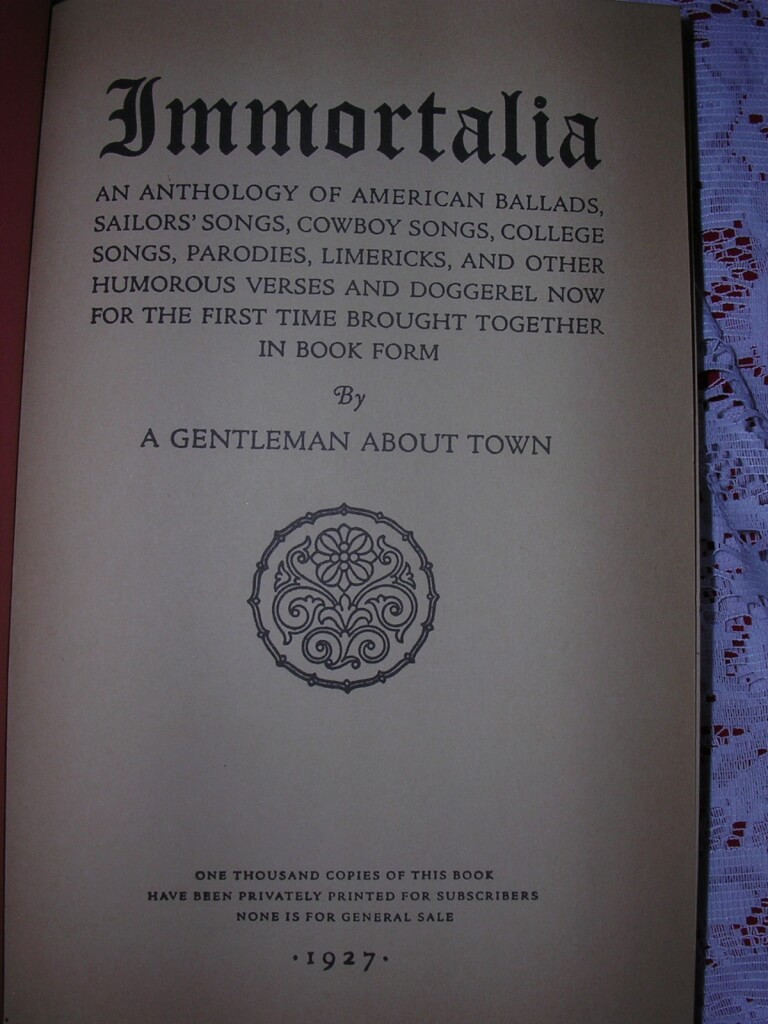
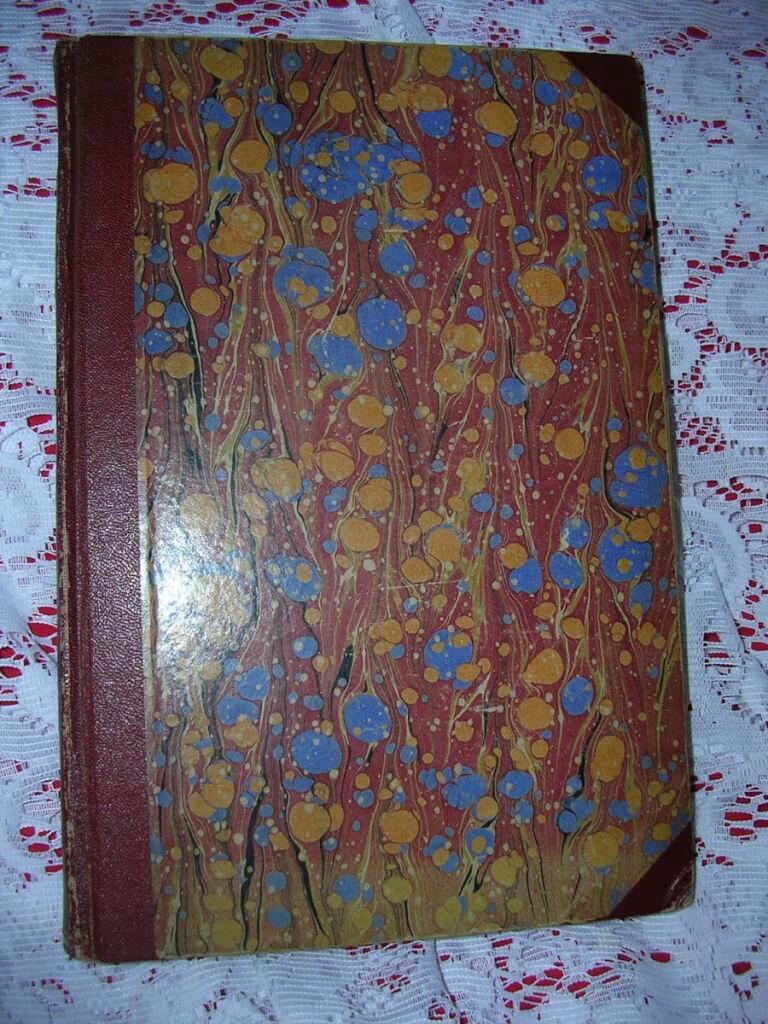 Immortalia, an anthology of american ballads, sailors' songs, cowboy songs, college songs, parodies, limericks, and other humorous verses and doggerel now for the first time brought together in book form, "By A Gentleman About Town" [T. R. Smith?] ("...privately printed for subscribers, none is for general sale" 1927 [pirated edition from the 2nd printing 1928 edtion, c.1932. New York: Samuel Roth or, less likely, Philadelphia: Nathan Young and Robert Sterling].) 6" x 8.75", iii, 184 pp., hardbound no DJ, decorated paper boards, cloth on spine and corners, worn edges on boards, corners bumped, binding tight. Assumed to be edited by T. R. Smith (George Macy, editor of Poetica Erotica around the same time). This is the most influential and widely published/circulated collection of "bawdry". Most collections since borrow from it liberally. There is a heavy emphasis on limericks (103 to be exact). Included are poems/"doggerel" attributed to James Joyce and D.H. Lawrence.
Immortalia, an anthology of american ballads, sailors' songs, cowboy songs, college songs, parodies, limericks, and other humorous verses and doggerel now for the first time brought together in book form, "By A Gentleman About Town" [T. R. Smith?] ("...privately printed for subscribers, none is for general sale" 1927 [pirated edition from the 2nd printing 1928 edtion, c.1932. New York: Samuel Roth or, less likely, Philadelphia: Nathan Young and Robert Sterling].) 6" x 8.75", iii, 184 pp., hardbound no DJ, decorated paper boards, cloth on spine and corners, worn edges on boards, corners bumped, binding tight. Assumed to be edited by T. R. Smith (George Macy, editor of Poetica Erotica around the same time). This is the most influential and widely published/circulated collection of "bawdry". Most collections since borrow from it liberally. There is a heavy emphasis on limericks (103 to be exact). Included are poems/"doggerel" attributed to James Joyce and D.H. Lawrence. -
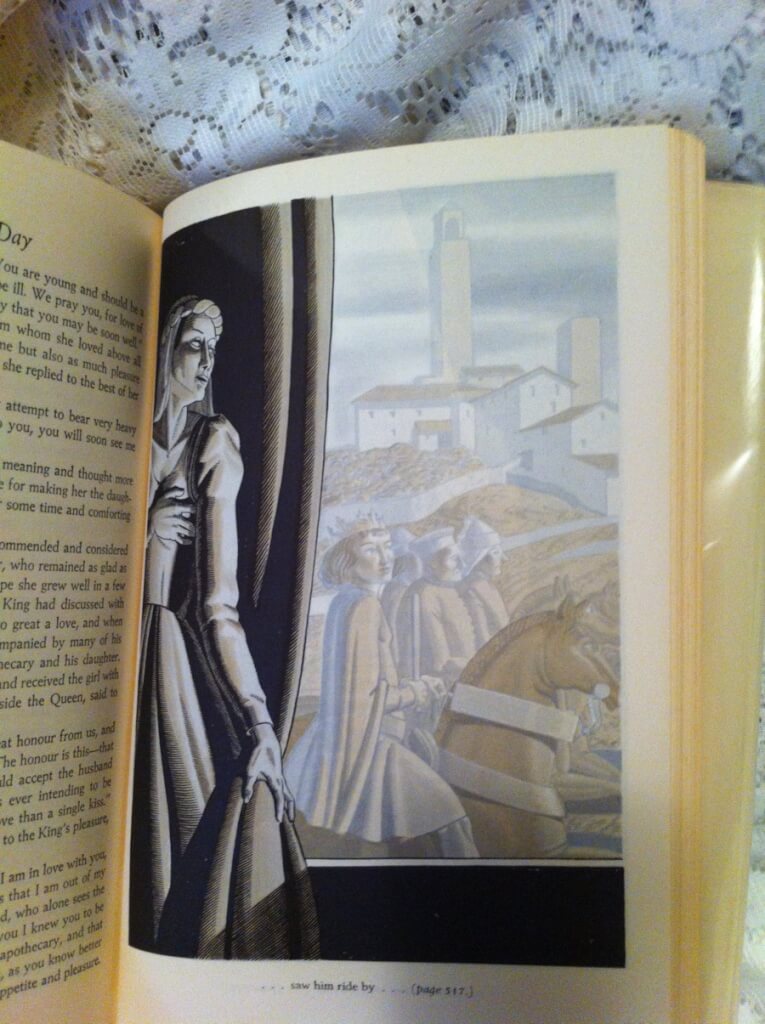
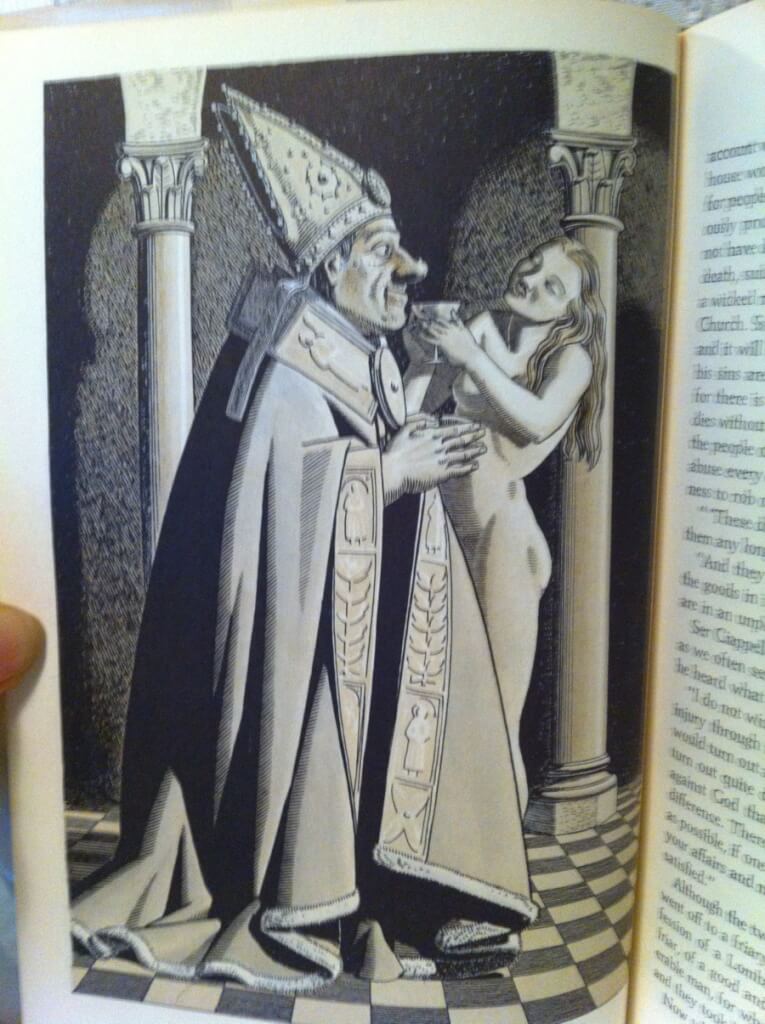 The Decameron of Giovanni Boccaccio, Giovanni Boccaccio, trans. Richard Aldington, illustrated by Rockwell Kent (Garden City Books, Garden City, NY, 1949 [date of illustrations]) 9 1/2" X 6 3/8", 562pp, hardbound with DJ protected by mylar, green boards with cream spine, great condition. This is the popular (at the time) Garden City edition. Superb art deco color illustrations throughout by Rockwell Kent (famous illustrator of Moby Dick and others). The Decameron, (subtitled Prencipe Galeotto or Prince Galehaut), is a collection of novellas by the 14th-century Italian author Giovanni Boccaccio (1313–1375). The book is structured as a frame story containing 100 tales told by a group of seven young women and three young men sheltering in a secluded villa just outside Florence to escape the Black Death, which was afflicting the city. To make their exile more pleasant each of the ten tells the others one story every day. The Decameron records the narratives of ten days -- 100 stories. Boccaccio probably conceived of The Decameron after the epidemic of 1348, and completed it by 1353. These tales run the entire range of human emotion: grief, love, humor, anger, revenge. Many are based on oral folklore. Boccaccio's ten narrators thus retell already familiar stories about errant priests, rascally husbands, and mischievous wives. Variants of these stories are known in many cultures, but no one formulates them more cleverly or relates them more eloquently than does Boccaccio. In addition to its literary value and widespread influence, it provides a document of life at the time. Written in the vernacular of the Florentine language, it is considered a masterpiece of classical early Italian prose.
The Decameron of Giovanni Boccaccio, Giovanni Boccaccio, trans. Richard Aldington, illustrated by Rockwell Kent (Garden City Books, Garden City, NY, 1949 [date of illustrations]) 9 1/2" X 6 3/8", 562pp, hardbound with DJ protected by mylar, green boards with cream spine, great condition. This is the popular (at the time) Garden City edition. Superb art deco color illustrations throughout by Rockwell Kent (famous illustrator of Moby Dick and others). The Decameron, (subtitled Prencipe Galeotto or Prince Galehaut), is a collection of novellas by the 14th-century Italian author Giovanni Boccaccio (1313–1375). The book is structured as a frame story containing 100 tales told by a group of seven young women and three young men sheltering in a secluded villa just outside Florence to escape the Black Death, which was afflicting the city. To make their exile more pleasant each of the ten tells the others one story every day. The Decameron records the narratives of ten days -- 100 stories. Boccaccio probably conceived of The Decameron after the epidemic of 1348, and completed it by 1353. These tales run the entire range of human emotion: grief, love, humor, anger, revenge. Many are based on oral folklore. Boccaccio's ten narrators thus retell already familiar stories about errant priests, rascally husbands, and mischievous wives. Variants of these stories are known in many cultures, but no one formulates them more cleverly or relates them more eloquently than does Boccaccio. In addition to its literary value and widespread influence, it provides a document of life at the time. Written in the vernacular of the Florentine language, it is considered a masterpiece of classical early Italian prose. -
Out of stock
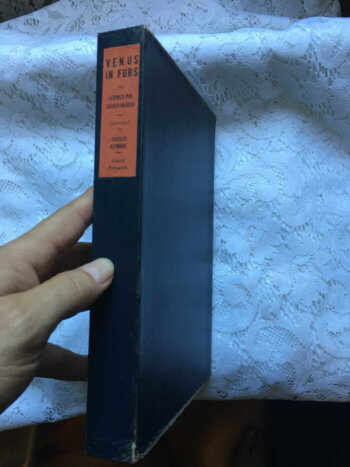
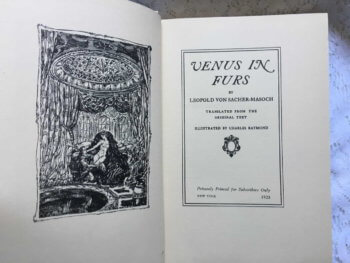 Venus in Furs, Leopold von Sacher-Masoch, illustrated by Charles Raymond [trans. Fernanda Savage] (Privately Printed For Subscribers Only, New York, 1928) 218pp, hardbound with slipcase, blue faux sued boards, white spine with gilt titles, deckled edges, dark blue slipcase with orange title on spine, very good condition for age, slipcase bumps and rubbing repair to bottom of spine, book clean, pages in unread condition with some remaining uncut Venus in Furs (German: Venus im Pelz) is a novella by Leopold Ritter von Sacher-Masoch (1836-1895), an Austrian writer and journalist. It is now his best known work and because of its themes the term masochism is derived from his name, coined by the Austrian psychiatrist, Krafft-Ebing. The novel was to be part of an epic series that Sacher-Masoch envisioned called Legacy of Cain. Venus in Furs was part of Love, the first volume of the series. It was published in 1870. The novel draws themes, like female dominance and sadomasochism, and character inspiration heavily from Sacher-Masoch's own life. Wanda von Dunajew, the novel's central female character, was modelled after his mistress Baroness Fanny Pistor. In December 1869 the two signed a contract making him her slave for a period of 6 months. In 1873, after the publication of Venus in Furs, Sacher-Masoch married Aurora von Rümelin who he pressured to continue the lifestyle he wrote about in his book. After 10 years they divorced. Rümelin, using the pseudonym of the books title character, "Wanda von Dunajew", wrote Meine Lebensbeichte (My Life Confession) published in 1906. It detailed Sacher-Masoch's private life and her relationship with him. During his lifetime, Sacher-Masoch was well known as a man of letters, a utopian thinker who espoused socialist and humanist ideals in his fiction and non-fiction. Most of his works remain untranslated into English. Until recently, his novel Venus in Furs was his only book commonly available in English.
Venus in Furs, Leopold von Sacher-Masoch, illustrated by Charles Raymond [trans. Fernanda Savage] (Privately Printed For Subscribers Only, New York, 1928) 218pp, hardbound with slipcase, blue faux sued boards, white spine with gilt titles, deckled edges, dark blue slipcase with orange title on spine, very good condition for age, slipcase bumps and rubbing repair to bottom of spine, book clean, pages in unread condition with some remaining uncut Venus in Furs (German: Venus im Pelz) is a novella by Leopold Ritter von Sacher-Masoch (1836-1895), an Austrian writer and journalist. It is now his best known work and because of its themes the term masochism is derived from his name, coined by the Austrian psychiatrist, Krafft-Ebing. The novel was to be part of an epic series that Sacher-Masoch envisioned called Legacy of Cain. Venus in Furs was part of Love, the first volume of the series. It was published in 1870. The novel draws themes, like female dominance and sadomasochism, and character inspiration heavily from Sacher-Masoch's own life. Wanda von Dunajew, the novel's central female character, was modelled after his mistress Baroness Fanny Pistor. In December 1869 the two signed a contract making him her slave for a period of 6 months. In 1873, after the publication of Venus in Furs, Sacher-Masoch married Aurora von Rümelin who he pressured to continue the lifestyle he wrote about in his book. After 10 years they divorced. Rümelin, using the pseudonym of the books title character, "Wanda von Dunajew", wrote Meine Lebensbeichte (My Life Confession) published in 1906. It detailed Sacher-Masoch's private life and her relationship with him. During his lifetime, Sacher-Masoch was well known as a man of letters, a utopian thinker who espoused socialist and humanist ideals in his fiction and non-fiction. Most of his works remain untranslated into English. Until recently, his novel Venus in Furs was his only book commonly available in English. -
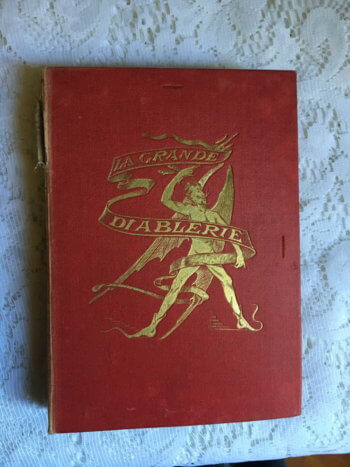
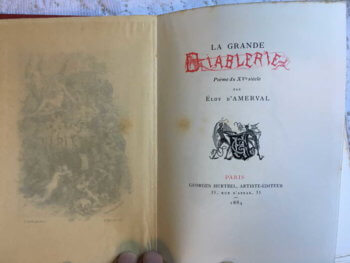 La Grande Diablerie, poem du XVe siècles, by Éloy d'Amerval (George Hurtrel, Artiste-Édueur, Paris, 1884, #152/1000 hand signed by publisher) 5" x 6.75", 216pp, in original published state, french wraps with loose hardcover/case, red with gilt decoration, frontispiece and 3 full page engravings by Paul Avril protected by tissue guard, images throughout, good minus condition, spine cover is sunned, binding is loose and splitting in places Eloy d'Amerval (fl. 1455 – 1508) was a French composer, singer, choirmaster, and poet of the Renaissance. He spent most of his life in the Loire Valley of France. From his poetic works, the long poem Le livre de la deablerie, it can be inferred that he knew most of the famous composers of the time, even though his own musical works never approached theirs in renown. This poem, considered invaluable to music historians, recounts a dialogue between Satan and Lucifer, in which their nefarious plotting of future evil deeds is interrupted periodically by the author, who among other accounts of earthly and divine virtue, records useful information on contemporary musical practice. In addition to listing musical instruments, he lists who he considers to be the great composers of the time: they are residents of Paradise in his poem, even though several were still alive in 1508, the date of its composition. Édouard-Henri Avril (1849-1928) used the pseudonym “Paul Avril” for his erotic work. He was a French painter and commercial artist. His career saw collaboration with influential people like Octave Uzanne, Henry Spencer Ashbee and Friedrich Karl Forberg. He is one of the most celebrated erotic artists of his age. Avril was a soldier before starting his career in art. He was awarded with the Legion of Honour for his actions in the Franco-Prussian War.
La Grande Diablerie, poem du XVe siècles, by Éloy d'Amerval (George Hurtrel, Artiste-Édueur, Paris, 1884, #152/1000 hand signed by publisher) 5" x 6.75", 216pp, in original published state, french wraps with loose hardcover/case, red with gilt decoration, frontispiece and 3 full page engravings by Paul Avril protected by tissue guard, images throughout, good minus condition, spine cover is sunned, binding is loose and splitting in places Eloy d'Amerval (fl. 1455 – 1508) was a French composer, singer, choirmaster, and poet of the Renaissance. He spent most of his life in the Loire Valley of France. From his poetic works, the long poem Le livre de la deablerie, it can be inferred that he knew most of the famous composers of the time, even though his own musical works never approached theirs in renown. This poem, considered invaluable to music historians, recounts a dialogue between Satan and Lucifer, in which their nefarious plotting of future evil deeds is interrupted periodically by the author, who among other accounts of earthly and divine virtue, records useful information on contemporary musical practice. In addition to listing musical instruments, he lists who he considers to be the great composers of the time: they are residents of Paradise in his poem, even though several were still alive in 1508, the date of its composition. Édouard-Henri Avril (1849-1928) used the pseudonym “Paul Avril” for his erotic work. He was a French painter and commercial artist. His career saw collaboration with influential people like Octave Uzanne, Henry Spencer Ashbee and Friedrich Karl Forberg. He is one of the most celebrated erotic artists of his age. Avril was a soldier before starting his career in art. He was awarded with the Legion of Honour for his actions in the Franco-Prussian War. -

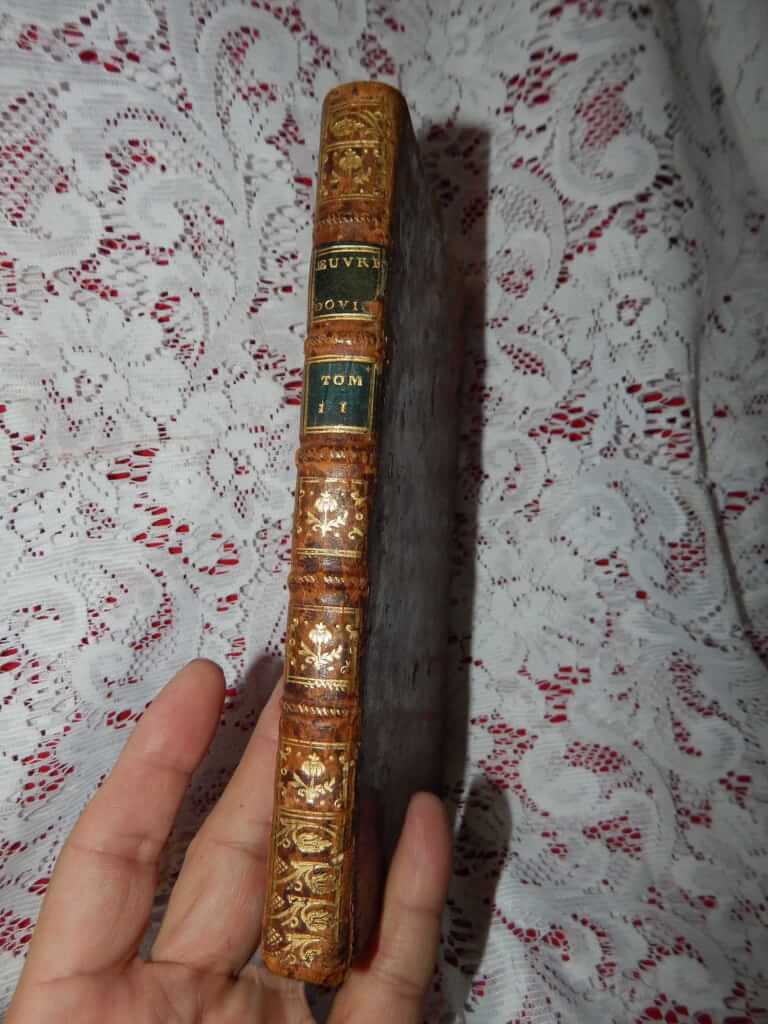 Les Œuvres Galantes et Amoureuses D'Ovide, contenant l'Art d'Aimer, le Remede d'Amour, les Épitre et les Élégies amoureuses, Nouvelle Édition (Vol 2 only of 2) (A Cythere, Aux Dépens du Loisir, 1774) 5"x8", 204pp, full calf, gilt titles and decorations to spine, 5 raised bands, marbled boards, good+ condition 2nd volume only beautifully bound, this volume contains the Art of Love, the Remedy of Love, the Letters and Elegies in Love, New Edition (Vol 2 only of 2) Publius Ovidius Naso (43 BC – AD 17/18), known as Ovid in the English-speaking world, was a Roman poet who lived during the reign of Augustus. He was a contemporary of the older Virgil and Horace, with whom he is often ranked as one of the three canonical poets of Latin literature. The Imperial scholar Quintilian considered him the last of the Latin love elegists. He enjoyed enormous popularity, but, in one of the mysteries of literary history, was sent by Augustus into exile in a remote province on the Black Sea, where he remained until his death. Ovid himself attributes his exile to carmen et error, "a poem and a mistake", but his discretion in discussing the causes has resulted in much speculation among scholars. The first major Roman poet to begin his career during the reign of Augustus, Ovid is today best known for the Metamorphoses, a 15-book continuous mythological narrative written in the meter of epic, and for works in elegiac couplets such as Ars Amatoria ("The Art of Love") and Fasti. His poetry was much imitated during Late Antiquity and the Middle Ages, and greatly influenced Western art and literature. The Metamorphoses remains one of the most important sources of classical mythology.
Les Œuvres Galantes et Amoureuses D'Ovide, contenant l'Art d'Aimer, le Remede d'Amour, les Épitre et les Élégies amoureuses, Nouvelle Édition (Vol 2 only of 2) (A Cythere, Aux Dépens du Loisir, 1774) 5"x8", 204pp, full calf, gilt titles and decorations to spine, 5 raised bands, marbled boards, good+ condition 2nd volume only beautifully bound, this volume contains the Art of Love, the Remedy of Love, the Letters and Elegies in Love, New Edition (Vol 2 only of 2) Publius Ovidius Naso (43 BC – AD 17/18), known as Ovid in the English-speaking world, was a Roman poet who lived during the reign of Augustus. He was a contemporary of the older Virgil and Horace, with whom he is often ranked as one of the three canonical poets of Latin literature. The Imperial scholar Quintilian considered him the last of the Latin love elegists. He enjoyed enormous popularity, but, in one of the mysteries of literary history, was sent by Augustus into exile in a remote province on the Black Sea, where he remained until his death. Ovid himself attributes his exile to carmen et error, "a poem and a mistake", but his discretion in discussing the causes has resulted in much speculation among scholars. The first major Roman poet to begin his career during the reign of Augustus, Ovid is today best known for the Metamorphoses, a 15-book continuous mythological narrative written in the meter of epic, and for works in elegiac couplets such as Ars Amatoria ("The Art of Love") and Fasti. His poetry was much imitated during Late Antiquity and the Middle Ages, and greatly influenced Western art and literature. The Metamorphoses remains one of the most important sources of classical mythology. -
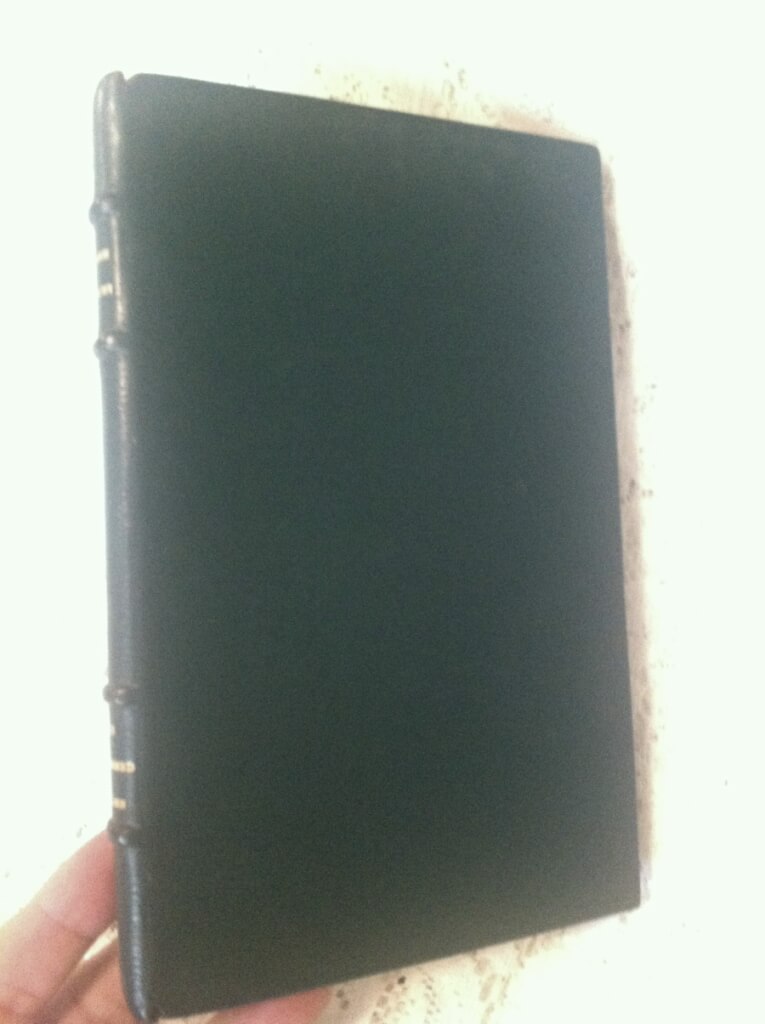
 The Perfumed Garden: A Manual of Arabian Erotology, Sheikh Nefzawi (Editions de la Fontaine d'Or, Paris, 1900 [Imprimerie M. Laballery, Clamecy (Nievre) 1952]) 8.75" X 5.5", 189pp. full leather rebinding of the paperback (original covers included), fine condition, ribbin intact, Original back cover states "not to be sold in England or U.S.A" The Perfumed Garden of Sensual Delight is a fifteenth-century Arabic sex manual and work of erotic literature. The book presents opinions on what qualities men and women should have to be attractive, gives advice on sexual technique, warnings about sexual health, and recipes to remedy sexual maladies. It gives lists of names for the penis and vagina, has a section on the interpretation of dreams, and briefly describes sex among animals. Interspersed with these there are a number of stories which are intended to give context and amusement. Sheikh Nefzawi (Abu Abdullah Muhammad ben Umar Nafzawi), was born among the Berber Nefzawa tribe in the south of present-day Tunisia. He probably wrote The Perfumed Garden sometime during the twelfth century, compiled at the request of the Hafsid ruler of Tunis, Abū Fāris ʿAbd al-ʿAzīz al-Mutawakkil. A nice full leather copy of the work.
The Perfumed Garden: A Manual of Arabian Erotology, Sheikh Nefzawi (Editions de la Fontaine d'Or, Paris, 1900 [Imprimerie M. Laballery, Clamecy (Nievre) 1952]) 8.75" X 5.5", 189pp. full leather rebinding of the paperback (original covers included), fine condition, ribbin intact, Original back cover states "not to be sold in England or U.S.A" The Perfumed Garden of Sensual Delight is a fifteenth-century Arabic sex manual and work of erotic literature. The book presents opinions on what qualities men and women should have to be attractive, gives advice on sexual technique, warnings about sexual health, and recipes to remedy sexual maladies. It gives lists of names for the penis and vagina, has a section on the interpretation of dreams, and briefly describes sex among animals. Interspersed with these there are a number of stories which are intended to give context and amusement. Sheikh Nefzawi (Abu Abdullah Muhammad ben Umar Nafzawi), was born among the Berber Nefzawa tribe in the south of present-day Tunisia. He probably wrote The Perfumed Garden sometime during the twelfth century, compiled at the request of the Hafsid ruler of Tunis, Abū Fāris ʿAbd al-ʿAzīz al-Mutawakkil. A nice full leather copy of the work. -
Out of stock
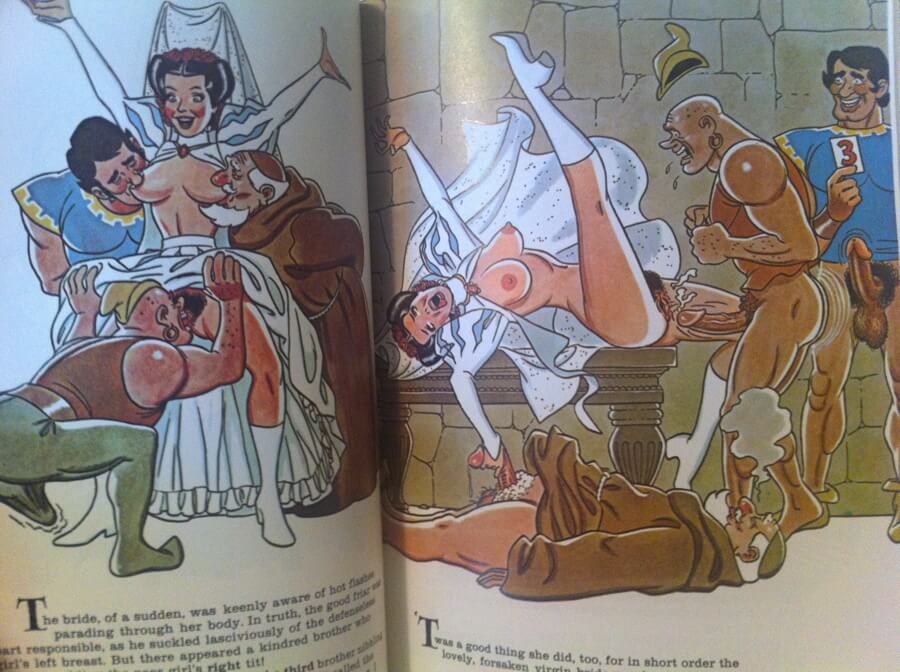
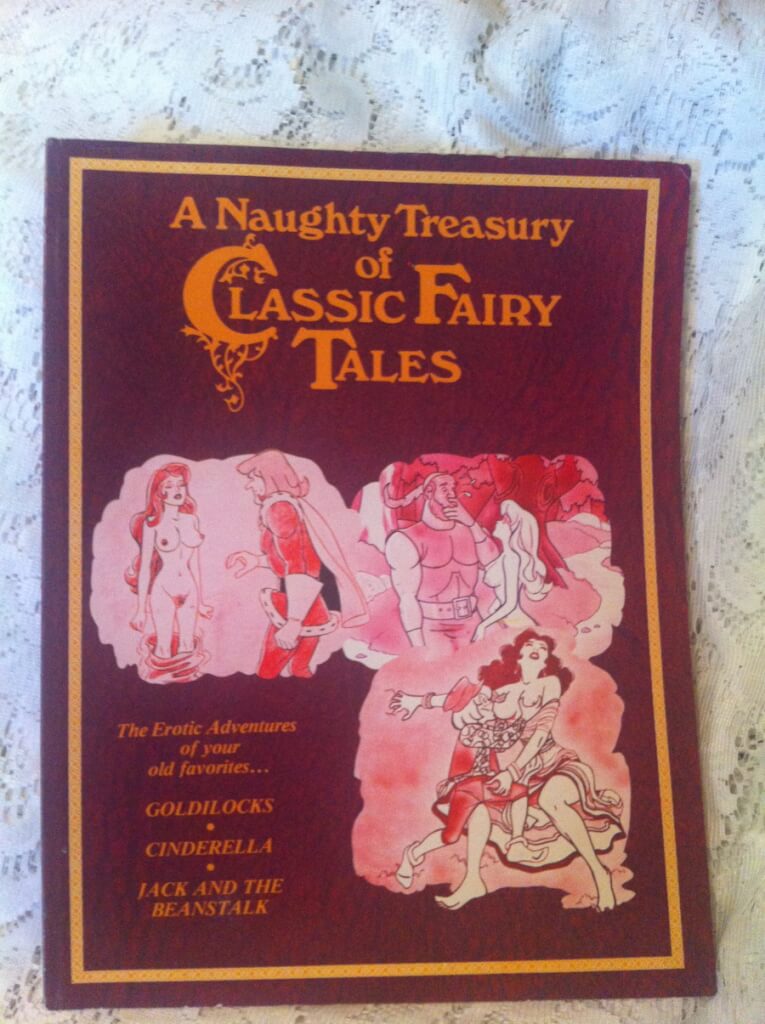 Naughty Treasury of Classic Fairy Tales, "Translated from the Old Saxon and Illustrated by Sir Rod Q. M'Gurk, Knight of the Brush (np, nd c. 1975) 8.5"x11", 96pp (unpaginated), soft covers, good condition, some minor bumping to corners, near fine internal pages I've been able to find a few references to this book and very little about "Sir Rod Q. M'Gurk". He apparently also had his cartoons published in Swank magazine c. 1976-7. Eventually it came to the attention of some illustrators and (with help of former Disney animators) was made into a movie by Don Jurwich (not sure the connection between him and Sir Rod Q. M'Gurk, but I'd love to know if it was him).
Naughty Treasury of Classic Fairy Tales, "Translated from the Old Saxon and Illustrated by Sir Rod Q. M'Gurk, Knight of the Brush (np, nd c. 1975) 8.5"x11", 96pp (unpaginated), soft covers, good condition, some minor bumping to corners, near fine internal pages I've been able to find a few references to this book and very little about "Sir Rod Q. M'Gurk". He apparently also had his cartoons published in Swank magazine c. 1976-7. Eventually it came to the attention of some illustrators and (with help of former Disney animators) was made into a movie by Don Jurwich (not sure the connection between him and Sir Rod Q. M'Gurk, but I'd love to know if it was him). -
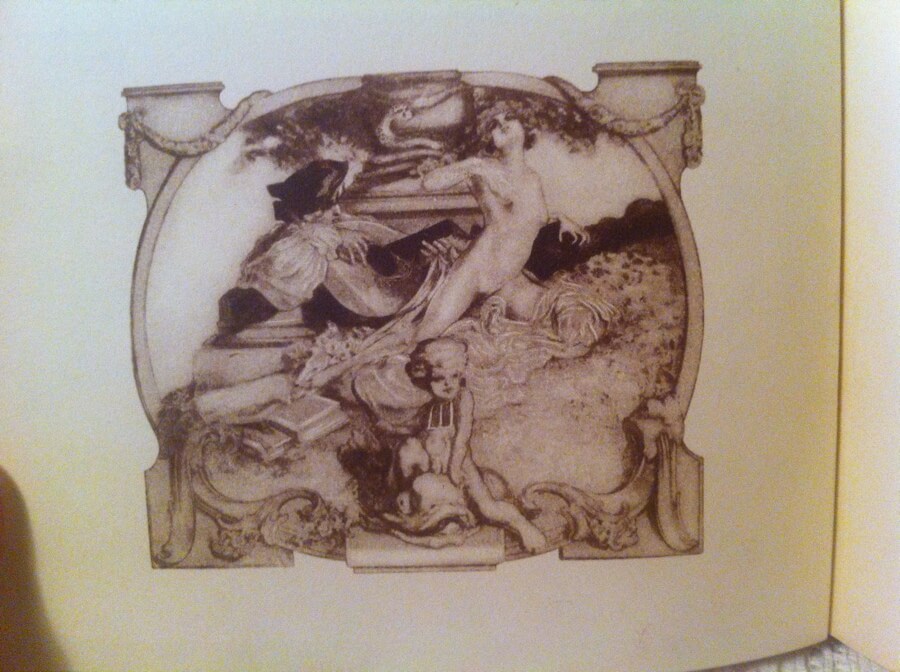
 Galante Lieder und Gedichte, Concordia Ball 25. Jänner 1926 [Galante songs and poems with images after originals by Franz von Bayros selected by Johannes Pilz and Viktor Wögerer, Concordia Ball, January 25, 1926] (Der Presseclub Concordia, Strache, Vienna 1926) 6.5"x4.75", very good condition, boards slightly rubbed and stained, interior fine, with carrying strap intact. Press Club Concordia, an organization of Austrian journalists and writers, has been holding a traditional Viennese ball at the Vienna City Hall each June for over 150 years. In 1926 their program book featured art by Franz von Bayros. The illustrations feature both erotic and musical themes. This is a great piece of European/Austrian interbellum history, a rare find in this condition with the carrying strap still intact.
Galante Lieder und Gedichte, Concordia Ball 25. Jänner 1926 [Galante songs and poems with images after originals by Franz von Bayros selected by Johannes Pilz and Viktor Wögerer, Concordia Ball, January 25, 1926] (Der Presseclub Concordia, Strache, Vienna 1926) 6.5"x4.75", very good condition, boards slightly rubbed and stained, interior fine, with carrying strap intact. Press Club Concordia, an organization of Austrian journalists and writers, has been holding a traditional Viennese ball at the Vienna City Hall each June for over 150 years. In 1926 their program book featured art by Franz von Bayros. The illustrations feature both erotic and musical themes. This is a great piece of European/Austrian interbellum history, a rare find in this condition with the carrying strap still intact. -
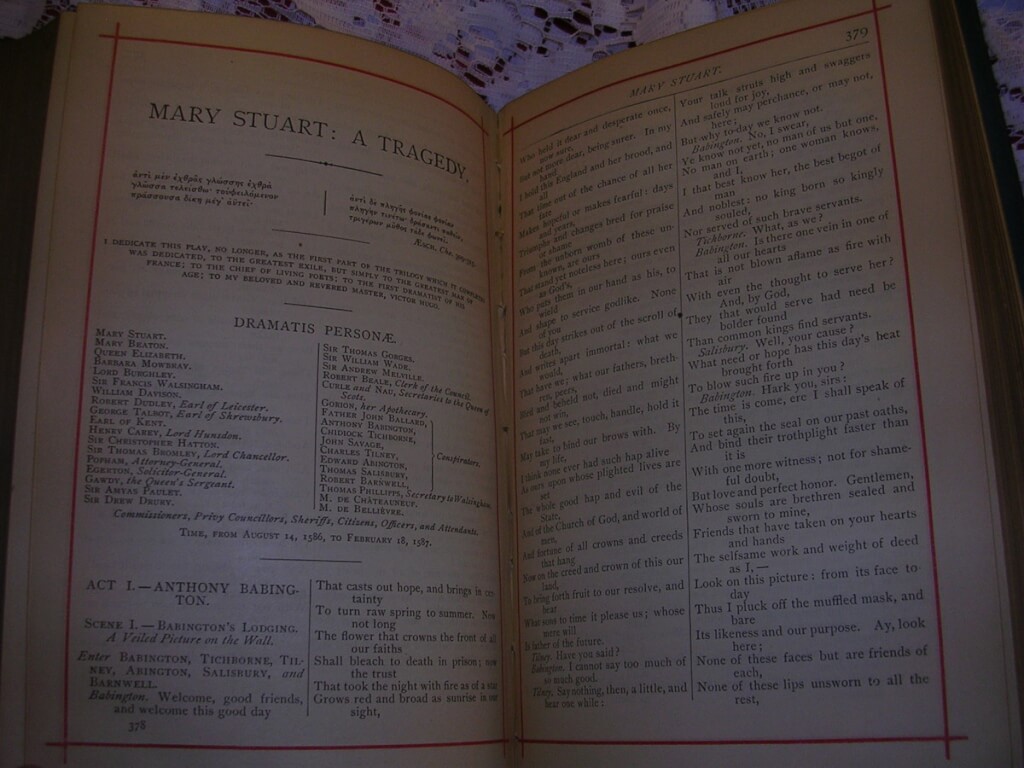
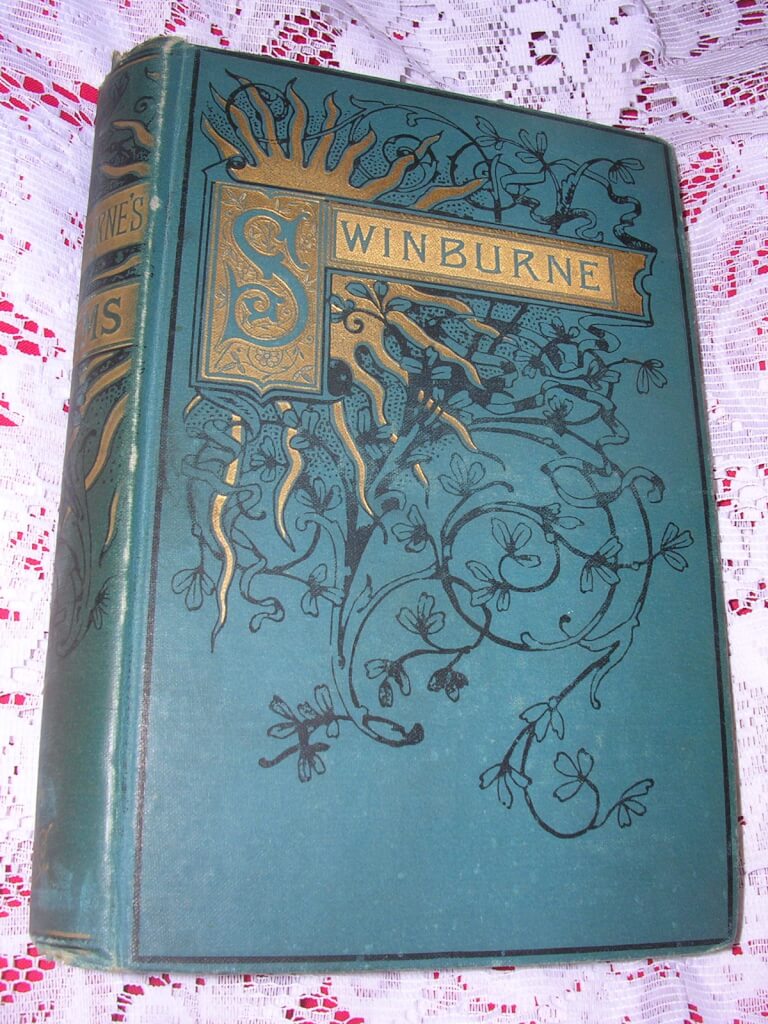 Selections from the Poetical Works of A. C. Swinburne, from the latest English edition of his works., A. C. Swinburne, ed. R. H. Stoddard (Thomas Y. Crowell & Co., New York, 1884 [first edition, thus.]) 7.5" x 5", xxii, 634pp, Hardcover, raised and gilted blue cloth decorated binding. Gilt edges internal pages framed in red lines. Good condition, bumped and worn corners and spine. Binding tight. Signed by previous owner "Ray E. Searls 1900" Swinburne was an English poet, playwright, novelist, and critic. Considered a decadent poet, although Swinburne perhaps professed to more vice than he actually indulged in; Oscar Wilde stated that Swinburne was "a braggart in matters of vice, who had done everything he could to convince his fellow citizens of his homosexuality and bestiality without being in the slightest degree a homosexual or a bestializer." He was nominated for the Nobel Prize in Literature in every year from 1903 to 1907 and again in 1909.
Selections from the Poetical Works of A. C. Swinburne, from the latest English edition of his works., A. C. Swinburne, ed. R. H. Stoddard (Thomas Y. Crowell & Co., New York, 1884 [first edition, thus.]) 7.5" x 5", xxii, 634pp, Hardcover, raised and gilted blue cloth decorated binding. Gilt edges internal pages framed in red lines. Good condition, bumped and worn corners and spine. Binding tight. Signed by previous owner "Ray E. Searls 1900" Swinburne was an English poet, playwright, novelist, and critic. Considered a decadent poet, although Swinburne perhaps professed to more vice than he actually indulged in; Oscar Wilde stated that Swinburne was "a braggart in matters of vice, who had done everything he could to convince his fellow citizens of his homosexuality and bestiality without being in the slightest degree a homosexual or a bestializer." He was nominated for the Nobel Prize in Literature in every year from 1903 to 1907 and again in 1909. -

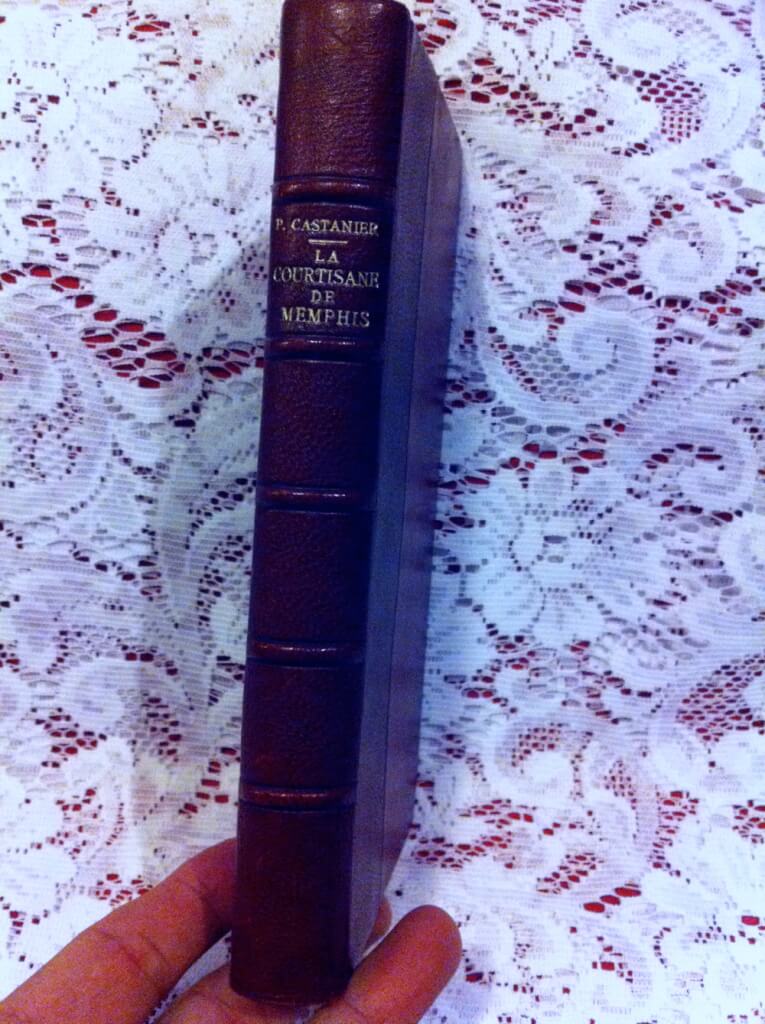 La Courtisane de Memphis, Prosper Castanier, illust. by A. Calbet (Librairie L. Borel, Paris, 1900 "Nymphée Collection") 7.75" X 4", 242pp.+, 1/2 red leather over silk-covered boards, marbled end-papers, gallery of 7 full-page illustrations in red, 5 pages of ads in back, fine condition for age, ribbon intact. In French, The Courtesan of Memphis. Prosper Castanier wrote of the decadence of ancient Rome. This is a beautiful example of a rare book. The French author, poet, novelist and historian Prosper Castanier (1865-19??) was born in Saint-Ambroix (Gard). He was the editor-in-chief of the "Progrès du midi". He had made a specialty of novels set in antiquity. (Particularly after the success of Aphrodite by Pierre Louès, published in 1896)
La Courtisane de Memphis, Prosper Castanier, illust. by A. Calbet (Librairie L. Borel, Paris, 1900 "Nymphée Collection") 7.75" X 4", 242pp.+, 1/2 red leather over silk-covered boards, marbled end-papers, gallery of 7 full-page illustrations in red, 5 pages of ads in back, fine condition for age, ribbon intact. In French, The Courtesan of Memphis. Prosper Castanier wrote of the decadence of ancient Rome. This is a beautiful example of a rare book. The French author, poet, novelist and historian Prosper Castanier (1865-19??) was born in Saint-Ambroix (Gard). He was the editor-in-chief of the "Progrès du midi". He had made a specialty of novels set in antiquity. (Particularly after the success of Aphrodite by Pierre Louès, published in 1896) -

 Novellen und Cymbalum Mundi: Die neuen Schwänke und lustigen Unterhaltungen gefolgt von der Weltbimmel (VOL 2 only), by Bonaventure Des Periers. "For the first time translated from French and introduced by Hanns Floerke with 10 illustrations by Franz von Bayros" (Georg Müller, München und Leipzig 1910) 5.25"x7", 404pp, vol 2 of 2, top edge gilt, other edges deckled, 3/4 vellum on green boards, 5 illustrations by Bayros tipped in, ribbon present but detached, good+ condition. German translation of Des Periers short stories and Cymbalum Mundi, Four Very Ancient Joyous and Facetious Dialogues. Bonaventure des Périers (c. 1500 – 1544) was a French storyteller and humanist who attained notoriety as a freethinker. Margaret of Angoulême, queen of Navarre, made him her valet de chambre in 1536. He acted as her secretary and transcribed her Heptaméron; some maintain that he in fact wrote the work. The free discussions permitted at Margaret’s court encouraged a license of thought as displeasing to the Calvinists as to the Roman Catholics; it became skepticism in Des Périers’s Cymbalum Mundi, a brilliant and violent attack upon Christianity. The allegorical form of its four dialogues in imitation of the Greek rhetorician Lucian did not conceal its real meaning. It was suppressed (c. 1538), but it was reprinted in Paris in the same year. His book made many bitter enemies for Des Périers, who prudently left Paris and settled at Lyon. Tradition has it that he killed himself in 1544, but this is questionable. Franz von Bayros (1866–1924) was an Austrian commercial artist, illustrator, and painter, best known for his controversial Tales at the Dressing Table portfolio, a book considered so dangerous to the morality of the time that Von Bayros was arrested and forced into exile. He was obliged to move from one European capital to another as each outrageous new work was banned by the authorities.
Novellen und Cymbalum Mundi: Die neuen Schwänke und lustigen Unterhaltungen gefolgt von der Weltbimmel (VOL 2 only), by Bonaventure Des Periers. "For the first time translated from French and introduced by Hanns Floerke with 10 illustrations by Franz von Bayros" (Georg Müller, München und Leipzig 1910) 5.25"x7", 404pp, vol 2 of 2, top edge gilt, other edges deckled, 3/4 vellum on green boards, 5 illustrations by Bayros tipped in, ribbon present but detached, good+ condition. German translation of Des Periers short stories and Cymbalum Mundi, Four Very Ancient Joyous and Facetious Dialogues. Bonaventure des Périers (c. 1500 – 1544) was a French storyteller and humanist who attained notoriety as a freethinker. Margaret of Angoulême, queen of Navarre, made him her valet de chambre in 1536. He acted as her secretary and transcribed her Heptaméron; some maintain that he in fact wrote the work. The free discussions permitted at Margaret’s court encouraged a license of thought as displeasing to the Calvinists as to the Roman Catholics; it became skepticism in Des Périers’s Cymbalum Mundi, a brilliant and violent attack upon Christianity. The allegorical form of its four dialogues in imitation of the Greek rhetorician Lucian did not conceal its real meaning. It was suppressed (c. 1538), but it was reprinted in Paris in the same year. His book made many bitter enemies for Des Périers, who prudently left Paris and settled at Lyon. Tradition has it that he killed himself in 1544, but this is questionable. Franz von Bayros (1866–1924) was an Austrian commercial artist, illustrator, and painter, best known for his controversial Tales at the Dressing Table portfolio, a book considered so dangerous to the morality of the time that Von Bayros was arrested and forced into exile. He was obliged to move from one European capital to another as each outrageous new work was banned by the authorities. -
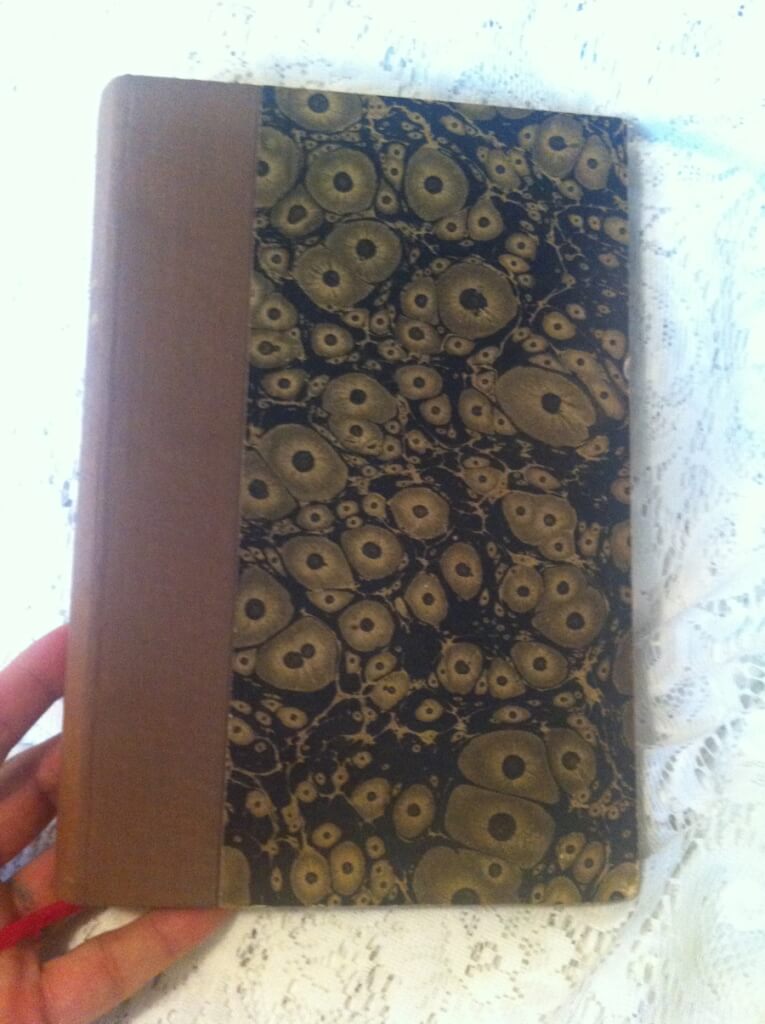
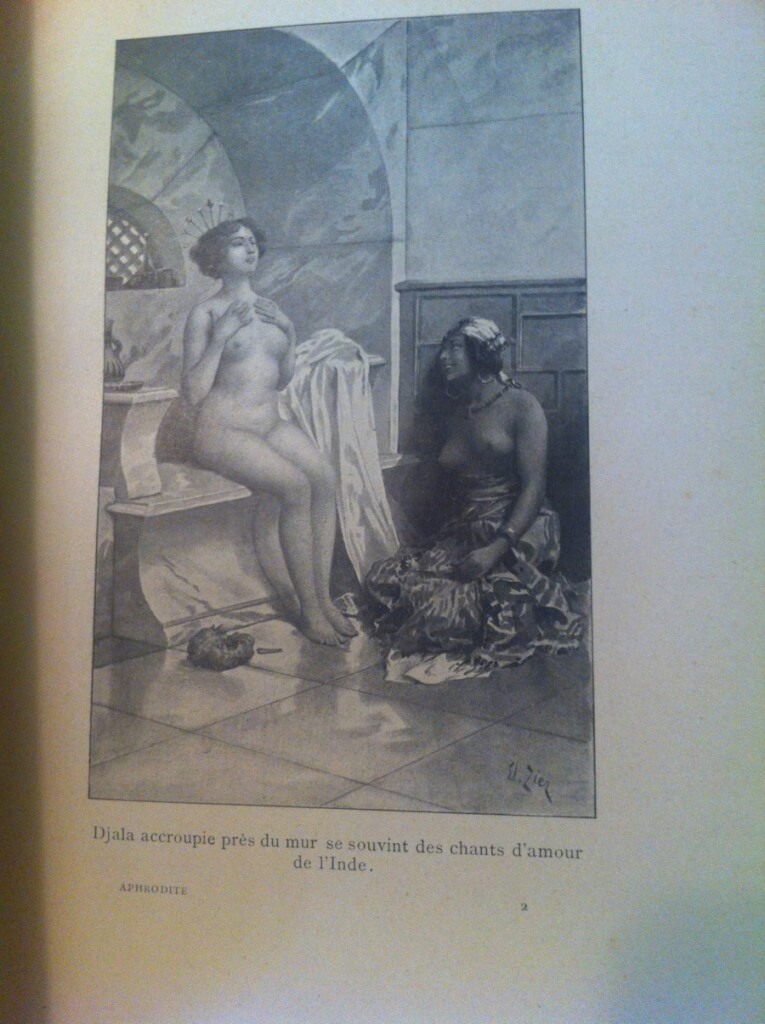 Aphrodite, mœurs antiques, by Pierre Louÿs, illus. Eduard Zier (Librairie Illustree, J. Tallandier, Éditeur, nd [c. 1900], Paris, printed by Charles Hérissey, engravings executed by Ruckert et Cie, on Champon, Bichelberger et Cie ) 6.75" x 10", 374pp, hardbound in half buckram over marbled boards, very good condition for age, some bumping to boards and foxing throughout pages, red ribbon intact Pierre Louys (1870 - 1925) was a French poet and writer, most renowned for lesbian and classical themes in some of his writings. He is known as a writer who "expressed pagan sensuality with stylistic perfection." "Aphrodite: mæurs antiques" (Ancient Manners) is a "libertine" story set in ancient Alexandria. Highlights include the loves of Chrysis, an orgy banquet ending in the crucifixion of a slave, the love of two young musician girls and the festivals of Aphrodite.
Aphrodite, mœurs antiques, by Pierre Louÿs, illus. Eduard Zier (Librairie Illustree, J. Tallandier, Éditeur, nd [c. 1900], Paris, printed by Charles Hérissey, engravings executed by Ruckert et Cie, on Champon, Bichelberger et Cie ) 6.75" x 10", 374pp, hardbound in half buckram over marbled boards, very good condition for age, some bumping to boards and foxing throughout pages, red ribbon intact Pierre Louys (1870 - 1925) was a French poet and writer, most renowned for lesbian and classical themes in some of his writings. He is known as a writer who "expressed pagan sensuality with stylistic perfection." "Aphrodite: mæurs antiques" (Ancient Manners) is a "libertine" story set in ancient Alexandria. Highlights include the loves of Chrysis, an orgy banquet ending in the crucifixion of a slave, the love of two young musician girls and the festivals of Aphrodite. -
 Napoleon et les Femmes | L 'amour, Frederick Masson, illus. A. Calbet (Librairie Borel, Paris, 1899 "Collection Nymphée") 7.5" X 3.75", 391pp.+, 3/4 blue leather over marbled blue silk-covered boards, 5 raised bands, top edge gilt, marbled end-papers, illustrations throughout This book focuses on the life of women under the Consulate and the Empire. It considers Napoleon’s conception of women, examining his contribution to the drafting of the Civil Code on the question of the place of women in society or the education of young girls. The memoirs and correspondence give an idea of how the women who lived through the Empire perceived this period of reforms, deprivation of freedoms, and also wars.
Napoleon et les Femmes | L 'amour, Frederick Masson, illus. A. Calbet (Librairie Borel, Paris, 1899 "Collection Nymphée") 7.5" X 3.75", 391pp.+, 3/4 blue leather over marbled blue silk-covered boards, 5 raised bands, top edge gilt, marbled end-papers, illustrations throughout This book focuses on the life of women under the Consulate and the Empire. It considers Napoleon’s conception of women, examining his contribution to the drafting of the Civil Code on the question of the place of women in society or the education of young girls. The memoirs and correspondence give an idea of how the women who lived through the Empire perceived this period of reforms, deprivation of freedoms, and also wars. -
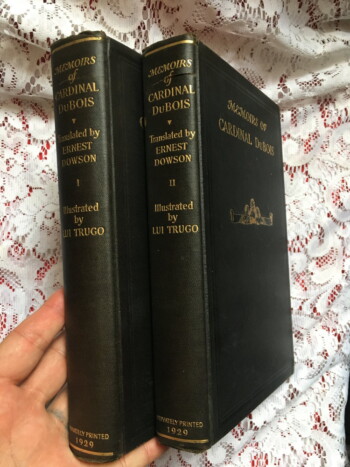
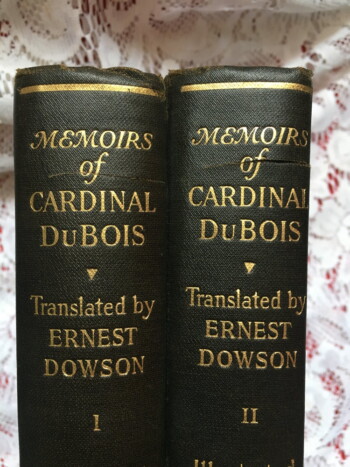 Memoirs of Cardinal Dubois | A complete unabridged translation from the French by Ernest Dowson | Embellished with photogravure portraits of Cardinal Dubois and the Duc d'Orleans, together with twelve full page drawings by Lui Trugo (Privately Printed for Subscribers [Art Studio Press], New York, 1929, #264/1500) 9.75"x6.5", 2 volumes on hand laid paper, xvi-376pp, viii-349pp, black cloth with gilt titles and decorations, top-edge inked, others deckled, good condition bumped corners and a few scuff marks. Two different ex libris Alan K Dolliver bookplates inside front covers of both books. According to the publisher, the original manuscript which was written entirely in Dubois hand was stolen by his secretary Lavergne after his death in 1723. It was later discovered of its literary value that Lavergne attempted to sell the manuscript. He was found and arrested. They later fell into the hands of Comte de Maurepas, then upon his death they were passed on to an anonymous writer named Mercier (possibly M. Paul Laroix) whose family had it published in 1829. The manuscript then became lost. In 1899 and English version of the book translated by Ernest Christopher Dowson, was published by the notorious pornographer, Leonard Smithers & Co. This is, presumably a reprinting of that translation. Guillaume Dubois (1656-1723), a son of a country doctor, rose from humble beginnings to positions of power and high honor in government and in the Catholic Church. He is best known for negotiating the Triple Alliance of 1717 between France, the Dutch Republic and Great Britain against their mutual enemy, Spain. Considered one of the four great French Cardinal-Ministers (Richelieu, Mazarin, Dubois, and Fleury). His ecclesiastical career left a great deal to be desired. Although there is no proof of the prevalent assertion that he got secretly married, his licentiousness, and notorious impiety, even at the time of his death, make it evident that he pursued and used ecclesiastical dignities principally to enhance his political position and prestige. Eventually in 1721, Du Bois was created cardinal. He had the reputation of a libertine and adventurer and made plenty of enemies. One of his rivals was charged at creating his portrait, the Duc de Saint-Simon, who was said to have placed a painting of Dubois in his lavatory. Saint-Simon had this to say about the Cardinal: "He was a little, pitiful, wizened, herring-gutted man, in a flaxen wig, with a weasel's face, brightened by some intellect. All the vices - perfidy, avarice, debauchery, ambition, flattery - fought within him for the mastery. He was so consummate a liar that, when taken in the fact, he could brazenly deny it. Even his wit and knowledge of the world were spoiled, and his affected gaiety was touched with sadness, by the odour of falsehood which escaped through every pore of his body." This famous picture is certainly biased. Dubois was unscrupulous, but so were his contemporaries, and whatever vices he had, he forged a European peace that, with the exception of small, restrained military expeditions against the Austrian Habsburgs, would last for a quarter of a century.
Memoirs of Cardinal Dubois | A complete unabridged translation from the French by Ernest Dowson | Embellished with photogravure portraits of Cardinal Dubois and the Duc d'Orleans, together with twelve full page drawings by Lui Trugo (Privately Printed for Subscribers [Art Studio Press], New York, 1929, #264/1500) 9.75"x6.5", 2 volumes on hand laid paper, xvi-376pp, viii-349pp, black cloth with gilt titles and decorations, top-edge inked, others deckled, good condition bumped corners and a few scuff marks. Two different ex libris Alan K Dolliver bookplates inside front covers of both books. According to the publisher, the original manuscript which was written entirely in Dubois hand was stolen by his secretary Lavergne after his death in 1723. It was later discovered of its literary value that Lavergne attempted to sell the manuscript. He was found and arrested. They later fell into the hands of Comte de Maurepas, then upon his death they were passed on to an anonymous writer named Mercier (possibly M. Paul Laroix) whose family had it published in 1829. The manuscript then became lost. In 1899 and English version of the book translated by Ernest Christopher Dowson, was published by the notorious pornographer, Leonard Smithers & Co. This is, presumably a reprinting of that translation. Guillaume Dubois (1656-1723), a son of a country doctor, rose from humble beginnings to positions of power and high honor in government and in the Catholic Church. He is best known for negotiating the Triple Alliance of 1717 between France, the Dutch Republic and Great Britain against their mutual enemy, Spain. Considered one of the four great French Cardinal-Ministers (Richelieu, Mazarin, Dubois, and Fleury). His ecclesiastical career left a great deal to be desired. Although there is no proof of the prevalent assertion that he got secretly married, his licentiousness, and notorious impiety, even at the time of his death, make it evident that he pursued and used ecclesiastical dignities principally to enhance his political position and prestige. Eventually in 1721, Du Bois was created cardinal. He had the reputation of a libertine and adventurer and made plenty of enemies. One of his rivals was charged at creating his portrait, the Duc de Saint-Simon, who was said to have placed a painting of Dubois in his lavatory. Saint-Simon had this to say about the Cardinal: "He was a little, pitiful, wizened, herring-gutted man, in a flaxen wig, with a weasel's face, brightened by some intellect. All the vices - perfidy, avarice, debauchery, ambition, flattery - fought within him for the mastery. He was so consummate a liar that, when taken in the fact, he could brazenly deny it. Even his wit and knowledge of the world were spoiled, and his affected gaiety was touched with sadness, by the odour of falsehood which escaped through every pore of his body." This famous picture is certainly biased. Dubois was unscrupulous, but so were his contemporaries, and whatever vices he had, he forged a European peace that, with the exception of small, restrained military expeditions against the Austrian Habsburgs, would last for a quarter of a century. -
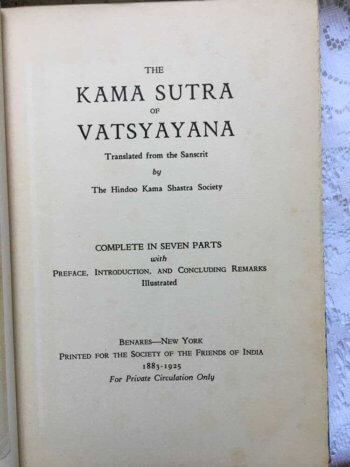
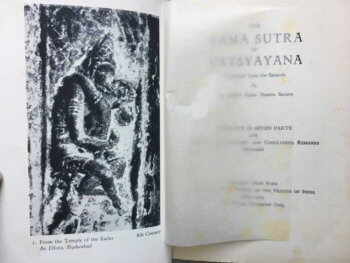 <strong>The Kama Sutra of Vatsyayana | Translated from the Sanscrit by The Hindoo Kama Shastra Society | Complete in seven parts with Preface, Introduction, and Concluding Remarks | Illustrated</strong>, by Vatsyayana (Printed for the Society of the Friends of India 1883-1925, Benares-New York, one of 800, unnumbered) <em>6"x9", xxi+175pp, hardbound, blue boards, hand laid paper, top-edge gilt, others deckled, 8 B/W half-tone reproductions of erotic Hindu stone-sculptures with tissue guards, soiling on boards, inner pages are clean, binding is good.</em> Attributed to ancient Indian philosopher Vatsyayana, the Kama Sutra is generally believed to have been composed between 400 and 200 B.C.E. Although a portion of the work consists of practical advice on sexual intercourse, the work is primarily prose consisting of 1250 verses distributed over 36 chapters structured into seven parts. This book lists those parts as: Part I. Index, and General Consideration of the Subject Part II. Of Sexual Union Part III. About the Acquisition of a Wife Part IV. About a Wife Part V. About the Wives of Other People Part VI. About Courtezans Part VII. On the Means of Attracting Others to Oneself
<strong>The Kama Sutra of Vatsyayana | Translated from the Sanscrit by The Hindoo Kama Shastra Society | Complete in seven parts with Preface, Introduction, and Concluding Remarks | Illustrated</strong>, by Vatsyayana (Printed for the Society of the Friends of India 1883-1925, Benares-New York, one of 800, unnumbered) <em>6"x9", xxi+175pp, hardbound, blue boards, hand laid paper, top-edge gilt, others deckled, 8 B/W half-tone reproductions of erotic Hindu stone-sculptures with tissue guards, soiling on boards, inner pages are clean, binding is good.</em> Attributed to ancient Indian philosopher Vatsyayana, the Kama Sutra is generally believed to have been composed between 400 and 200 B.C.E. Although a portion of the work consists of practical advice on sexual intercourse, the work is primarily prose consisting of 1250 verses distributed over 36 chapters structured into seven parts. This book lists those parts as: Part I. Index, and General Consideration of the Subject Part II. Of Sexual Union Part III. About the Acquisition of a Wife Part IV. About a Wife Part V. About the Wives of Other People Part VI. About Courtezans Part VII. On the Means of Attracting Others to Oneself -
 The Love Books of Ovid, A Completely Unexpurgated and Newly Translated Edition by Charles D. Young | Together with the Elegie, Translated by Christopher Marlowe | Illustrated by Alexander King "This book, designed by T. Spencer Hutson, was printed at the Alexander Hamilton Press, in March 1930. Illustrations are reproduced by the Knudson process. This edition consists of Two Thousand numbered copies printed on Strathmore MELDON deckle edge laid paper. This copy is No. 361" (Privately Published for Subscribers, Art Studio Books, Inc., 1930, #361/2000) 6.25"x9.5", iii+302pp, 3/4 black cloth over marbled boards, gilt text and decorations on spine, gilt borders on covers, marbled pastdowns, top edge gilt, other edges deckled, frontispiece and 16 full-page illustrations with descriptive tissue guards, other illustrations and titles in orange within text, near fine copy, slight rubbing at top and bottom of spine. This is a beautiful edition of 5 of his works, Ars Amatoria ("The Art of Love"), Remedia Amoris ("The Cure for Love"), Amores ("The Loves"), Medicamina Faciei ("dye on the face"), and his Elegies Publius Ovidius Naso (43 BC – AD 17/18), known as Ovid in the English-speaking world, was a Roman poet who lived during the reign of Augustus. He was a contemporary of the older Virgil and Horace, with whom he is often ranked as one of the three canonical poets of Latin literature. The Imperial scholar Quintilian considered him the last of the Latin love elegists. He enjoyed enormous popularity, but, in one of the mysteries of literary history, was sent by Augustus into exile in a remote province on the Black Sea, where he remained until his death. Ovid himself attributes his exile to carmen et error, "a poem and a mistake", but his discretion in discussing the causes has resulted in much speculation among scholars. The first major Roman poet to begin his career during the reign of Augustus, Ovid is today best known for the Metamorphoses, a 15-book continuous mythological narrative written in the meter of epic, and for works in elegiac couplets such as Ars Amatoria ("The Art of Love") and Fasti. His poetry was much imitated during Late Antiquity and the Middle Ages, and greatly influenced Western art and literature. The Metamorphoses remains one of the most important sources of classical mythology. Alexander King (1899–1965), born Alexander Koenig in Vienna, was a bestselling humorist, memoirist and media personality of the early television era, based in the United States. In his late fifties, after becoming a frequent guest on the a Tonight Show hosted by Jack Paar, King emerged as an incongruous presence in the realm of national celebrity: an aging, irascible raconteur, with elegant mannerisms and trademark bow-tie, who spoke frankly and disarmingly about his bohemian lifestyle, multiple marriages, and years-long struggle with drug addiction. His checkered past led TIME magazine to describe him as "an ex-illustrator, ex-cartoonist, ex-adman, ex-editor, ex-playwright, ex-dope addict. For a quarter-century he was an ex-painter, and by his own bizarre account qualifies as an ex-midwife. He is also an ex-husband to three wives and an ex-Viennese of sufficient age (60) to remember muttonchopped Emperor Franz Joseph. When doctors told him a few years ago that he might soon be an ex-patient (two strokes, serious kidney disease, peptic ulcer, high blood pressure), he sat down to tell gay stories of the life of all these earlier Kings."
The Love Books of Ovid, A Completely Unexpurgated and Newly Translated Edition by Charles D. Young | Together with the Elegie, Translated by Christopher Marlowe | Illustrated by Alexander King "This book, designed by T. Spencer Hutson, was printed at the Alexander Hamilton Press, in March 1930. Illustrations are reproduced by the Knudson process. This edition consists of Two Thousand numbered copies printed on Strathmore MELDON deckle edge laid paper. This copy is No. 361" (Privately Published for Subscribers, Art Studio Books, Inc., 1930, #361/2000) 6.25"x9.5", iii+302pp, 3/4 black cloth over marbled boards, gilt text and decorations on spine, gilt borders on covers, marbled pastdowns, top edge gilt, other edges deckled, frontispiece and 16 full-page illustrations with descriptive tissue guards, other illustrations and titles in orange within text, near fine copy, slight rubbing at top and bottom of spine. This is a beautiful edition of 5 of his works, Ars Amatoria ("The Art of Love"), Remedia Amoris ("The Cure for Love"), Amores ("The Loves"), Medicamina Faciei ("dye on the face"), and his Elegies Publius Ovidius Naso (43 BC – AD 17/18), known as Ovid in the English-speaking world, was a Roman poet who lived during the reign of Augustus. He was a contemporary of the older Virgil and Horace, with whom he is often ranked as one of the three canonical poets of Latin literature. The Imperial scholar Quintilian considered him the last of the Latin love elegists. He enjoyed enormous popularity, but, in one of the mysteries of literary history, was sent by Augustus into exile in a remote province on the Black Sea, where he remained until his death. Ovid himself attributes his exile to carmen et error, "a poem and a mistake", but his discretion in discussing the causes has resulted in much speculation among scholars. The first major Roman poet to begin his career during the reign of Augustus, Ovid is today best known for the Metamorphoses, a 15-book continuous mythological narrative written in the meter of epic, and for works in elegiac couplets such as Ars Amatoria ("The Art of Love") and Fasti. His poetry was much imitated during Late Antiquity and the Middle Ages, and greatly influenced Western art and literature. The Metamorphoses remains one of the most important sources of classical mythology. Alexander King (1899–1965), born Alexander Koenig in Vienna, was a bestselling humorist, memoirist and media personality of the early television era, based in the United States. In his late fifties, after becoming a frequent guest on the a Tonight Show hosted by Jack Paar, King emerged as an incongruous presence in the realm of national celebrity: an aging, irascible raconteur, with elegant mannerisms and trademark bow-tie, who spoke frankly and disarmingly about his bohemian lifestyle, multiple marriages, and years-long struggle with drug addiction. His checkered past led TIME magazine to describe him as "an ex-illustrator, ex-cartoonist, ex-adman, ex-editor, ex-playwright, ex-dope addict. For a quarter-century he was an ex-painter, and by his own bizarre account qualifies as an ex-midwife. He is also an ex-husband to three wives and an ex-Viennese of sufficient age (60) to remember muttonchopped Emperor Franz Joseph. When doctors told him a few years ago that he might soon be an ex-patient (two strokes, serious kidney disease, peptic ulcer, high blood pressure), he sat down to tell gay stories of the life of all these earlier Kings." -
Out of stock
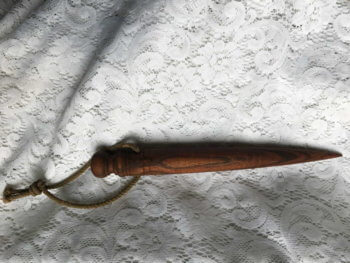
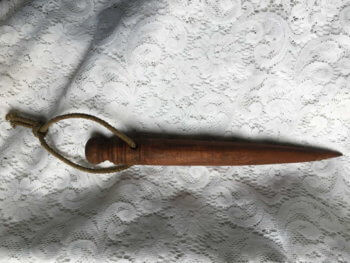 Fid from India 13.5" long, 1.5" at widest part, unknown wood, with original rope A fid is a conical tool made of wood or bone. It is used to work with rope and canvas in seamanship. A fid is used to hold open knots and holes in canvas or to open the "lays", or strands of rope, for splicing.
Fid from India 13.5" long, 1.5" at widest part, unknown wood, with original rope A fid is a conical tool made of wood or bone. It is used to work with rope and canvas in seamanship. A fid is used to hold open knots and holes in canvas or to open the "lays", or strands of rope, for splicing. -
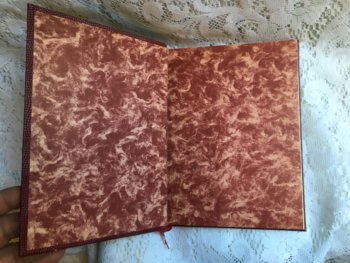
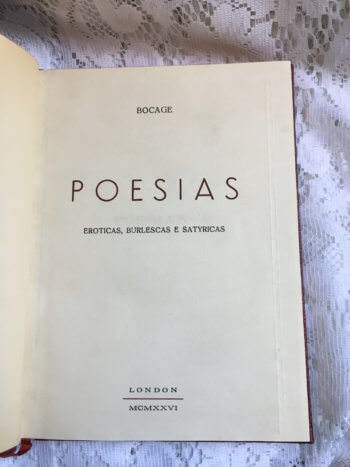 Poesias: eroticas, burlescas e satyricas, Bocage (Manuel Maria Barbosa du Bocage) (np, London, 1926, #443/1000 machine numbered) 6" X 8", 220pp, in Portuguese, hardcover, quarter bound red leather over red pebbled boards, gilt titles and decorations on spine, four raised bands, laid paper, top-edge inked, marbled end papers, ribbon present, a handsome quarter-leather bound copy of a clandestinely published edition of Bocage's unpublishable works. (most copies of this edition are softbound). Manuel Maria Barbosa du Bocage (1765-1805) was a Portuguese Neoclassic poet, writing at the beginning of his career under the pen name Elmano Sadino. He aspired to be a second Camões. He was born, the son of a lawyer, in Setúbal, Portugal. He is said to to have made verses in infancy, and being somewhat of a prodigy grew up to be flattered, self-conscious and unstable. He left home at age 14 to join the army then transfered to the navy at age 16. While in the military he devoted most of his energies to love affairs, poetry, and bohemianism. Eventually, like his hero Camões, he was sent to India and became disillusioned by the Orient. He deserted to Macau, returning to Lisbon in 1790. He then joined the New Arcadia, a literary society with vaguely egalitarian and libertarian sympathies, but his satires on his fellow members resulted in his expulsion. In 1797 he was accused of propagating republicanism and atheism and was imprisoned. During his imprisonment he undertook translations of Virgil and Ovid. Translations provided him with a livelihood during the few years that he lived after his release. Despite the Neoclassical framework of his poetry, his intensely personal accent, frequent violence of expression, and self-dramatizing obsession with fate and death anticipate Romanticism. The subversiveness of his poems has meant that for much of the last 200 years they have not been (officially) available in Portugal.
Poesias: eroticas, burlescas e satyricas, Bocage (Manuel Maria Barbosa du Bocage) (np, London, 1926, #443/1000 machine numbered) 6" X 8", 220pp, in Portuguese, hardcover, quarter bound red leather over red pebbled boards, gilt titles and decorations on spine, four raised bands, laid paper, top-edge inked, marbled end papers, ribbon present, a handsome quarter-leather bound copy of a clandestinely published edition of Bocage's unpublishable works. (most copies of this edition are softbound). Manuel Maria Barbosa du Bocage (1765-1805) was a Portuguese Neoclassic poet, writing at the beginning of his career under the pen name Elmano Sadino. He aspired to be a second Camões. He was born, the son of a lawyer, in Setúbal, Portugal. He is said to to have made verses in infancy, and being somewhat of a prodigy grew up to be flattered, self-conscious and unstable. He left home at age 14 to join the army then transfered to the navy at age 16. While in the military he devoted most of his energies to love affairs, poetry, and bohemianism. Eventually, like his hero Camões, he was sent to India and became disillusioned by the Orient. He deserted to Macau, returning to Lisbon in 1790. He then joined the New Arcadia, a literary society with vaguely egalitarian and libertarian sympathies, but his satires on his fellow members resulted in his expulsion. In 1797 he was accused of propagating republicanism and atheism and was imprisoned. During his imprisonment he undertook translations of Virgil and Ovid. Translations provided him with a livelihood during the few years that he lived after his release. Despite the Neoclassical framework of his poetry, his intensely personal accent, frequent violence of expression, and self-dramatizing obsession with fate and death anticipate Romanticism. The subversiveness of his poems has meant that for much of the last 200 years they have not been (officially) available in Portugal. -
 Venus in Furs, Leopold von Sacher-Masoch, trans. Fernanda Savage (Privately Printed For Subscirbers Only. 1921, [first english translation?] limited first edition thus, #400/1225) Venus in Furs (German: Venus im Pelz) is a novella by Leopold Ritter von Sacher-Masoch (1836-1895), an Austrian writer and journalist. It is now his best known work and because of its themes the term masochism is derived from his name, coined by the Austrian psychiatrist, Krafft-Ebing. The novel was to be part of an epic series that Sacher-Masoch envisioned called Legacy of Cain. Venus in Furs was part of Love, the first volume of the series. It was published in 1870. The novel draws themes, like female dominance and sadomasochism, and character inspiration heavily from Sacher-Masoch's own life. Wanda von Dunajew, the novel's central female character, was modelled after his mistress Baroness Fanny Pistor. In December 1869 the two signed a contract making him her slave for a period of 6 months. In 1873, after the publication of Venus in Furs, Sacher-Masoch married Aurora von Rümelin who he pressured to continue the lifestyle he wrote about in his book. After 10 years they divorced. Rümelin, using the pseudonym of the books title character, "Wanda von Dunajew", wrote Meine Lebensbeichte (My Life Confession) published in 1906. It detailed Sacher-Masoch's private life and her relationship with him. During his lifetime, Sacher-Masoch was well known as a man of letters, a utopian thinker who espoused socialist and humanist ideals in his fiction and non-fiction. Most of his works remain untranslated into English. Until recently, his novel Venus in Furs was his only book commonly available in English.
Venus in Furs, Leopold von Sacher-Masoch, trans. Fernanda Savage (Privately Printed For Subscirbers Only. 1921, [first english translation?] limited first edition thus, #400/1225) Venus in Furs (German: Venus im Pelz) is a novella by Leopold Ritter von Sacher-Masoch (1836-1895), an Austrian writer and journalist. It is now his best known work and because of its themes the term masochism is derived from his name, coined by the Austrian psychiatrist, Krafft-Ebing. The novel was to be part of an epic series that Sacher-Masoch envisioned called Legacy of Cain. Venus in Furs was part of Love, the first volume of the series. It was published in 1870. The novel draws themes, like female dominance and sadomasochism, and character inspiration heavily from Sacher-Masoch's own life. Wanda von Dunajew, the novel's central female character, was modelled after his mistress Baroness Fanny Pistor. In December 1869 the two signed a contract making him her slave for a period of 6 months. In 1873, after the publication of Venus in Furs, Sacher-Masoch married Aurora von Rümelin who he pressured to continue the lifestyle he wrote about in his book. After 10 years they divorced. Rümelin, using the pseudonym of the books title character, "Wanda von Dunajew", wrote Meine Lebensbeichte (My Life Confession) published in 1906. It detailed Sacher-Masoch's private life and her relationship with him. During his lifetime, Sacher-Masoch was well known as a man of letters, a utopian thinker who espoused socialist and humanist ideals in his fiction and non-fiction. Most of his works remain untranslated into English. Until recently, his novel Venus in Furs was his only book commonly available in English. -
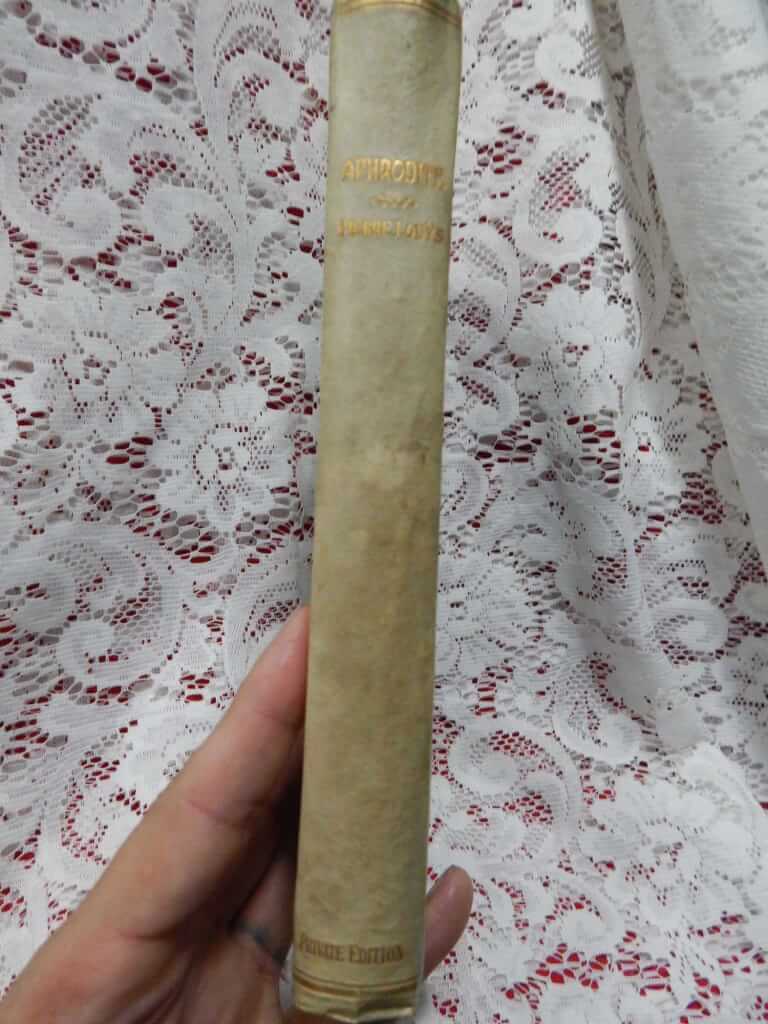
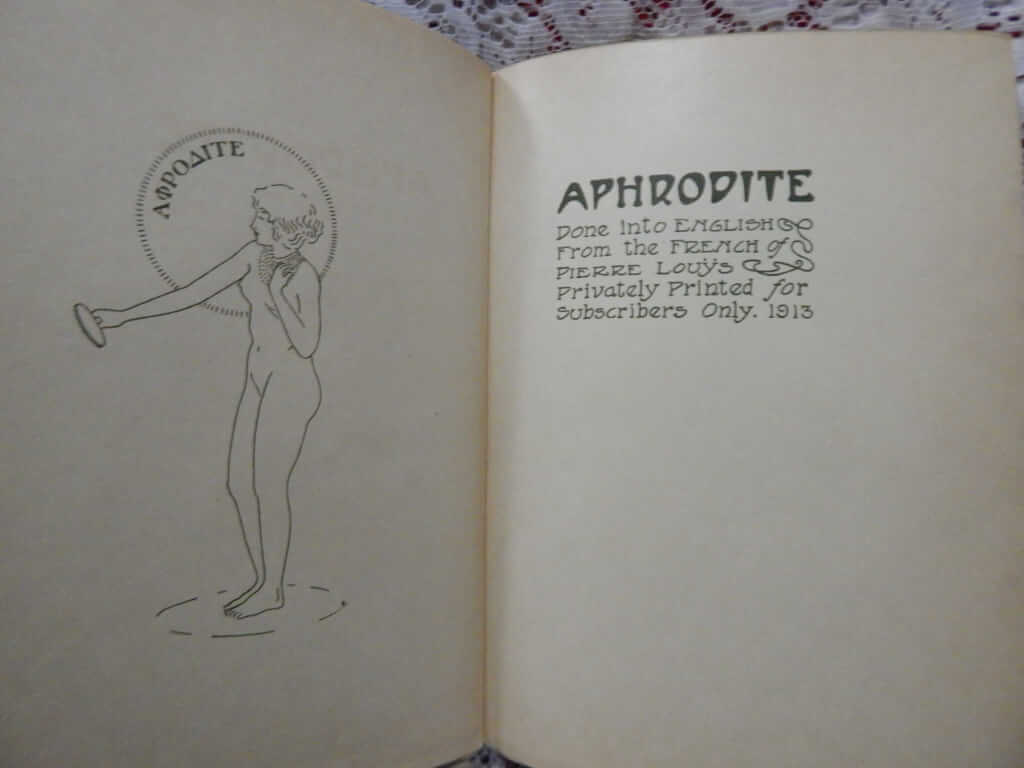 Aphrodite, done into English from the French of Pierre Louys, by Pierre Louÿs, illus. unknown, (Privately Printed for Subscribers Only[Mitchell S. Buck], 1913, #66/550) 6.5"x8.75", xi+258pp+Notes+Index, cream vellum spine over green boards, gilt titles on spine, good condition, some bumping and rubbing Buck's translation is easier to read than Carrington's translation a few years earlier. This was his first book, most likely, self-published and printed by Nicholas L. Brown. Pierre Louys (1870 - 1925) was a French poet and writer, most renowned for lesbian and classical themes in some of his writings. He is known as a writer who "expressed pagan sensuality with stylistic perfection." "Aphrodite: mæurs antiques" (Ancient Manners) is a "libertine" story set in ancient Alexandria. Highlights include the loves of Chrysis, an orgy banquet ending in the crucifixion of a slave, the love of two young musician girls and the festivals of Aphrodite." Mitchell Starrett Buck (February 10, 1887 – May 12, 1959) was an American poet, translator and classical scholar. His volumes of verse and prose poetry were deeply influenced by 1890s aestheticism as well as classical Greek and Roman Literature. Buck’s writing was secondary to his work as a heating engineer, and the money he made professionally allowed him to become a noted book-collector, specializing in first editions, English literature, Greek and Latin classics. Buck’s first book was a translation of Aphrodite by the French decadent Pierre Louÿs (1870-1925). It appeared in 1913, and was “privately printed”, probably at Buck’s expense. It may have been arranged through the Philadelphia bookseller Nicholas L. Brown, who officially became a publisher in 1916, and thereafter issued most of Buck’s output. Between 1916 and 1932, Brown published small editions of poetry, belles lettres, translations, sometimes without his imprint but stating that the title has been “issued privately for subscribers” (in order to evade prosecution for dealing in obscene materials). Such classical erotica is very tame by modern standards, but in the teens and twenties such material was policed by self-appointed authorities such as John S. Sumner of the New York Society for the Suppression of Vice.
Aphrodite, done into English from the French of Pierre Louys, by Pierre Louÿs, illus. unknown, (Privately Printed for Subscribers Only[Mitchell S. Buck], 1913, #66/550) 6.5"x8.75", xi+258pp+Notes+Index, cream vellum spine over green boards, gilt titles on spine, good condition, some bumping and rubbing Buck's translation is easier to read than Carrington's translation a few years earlier. This was his first book, most likely, self-published and printed by Nicholas L. Brown. Pierre Louys (1870 - 1925) was a French poet and writer, most renowned for lesbian and classical themes in some of his writings. He is known as a writer who "expressed pagan sensuality with stylistic perfection." "Aphrodite: mæurs antiques" (Ancient Manners) is a "libertine" story set in ancient Alexandria. Highlights include the loves of Chrysis, an orgy banquet ending in the crucifixion of a slave, the love of two young musician girls and the festivals of Aphrodite." Mitchell Starrett Buck (February 10, 1887 – May 12, 1959) was an American poet, translator and classical scholar. His volumes of verse and prose poetry were deeply influenced by 1890s aestheticism as well as classical Greek and Roman Literature. Buck’s writing was secondary to his work as a heating engineer, and the money he made professionally allowed him to become a noted book-collector, specializing in first editions, English literature, Greek and Latin classics. Buck’s first book was a translation of Aphrodite by the French decadent Pierre Louÿs (1870-1925). It appeared in 1913, and was “privately printed”, probably at Buck’s expense. It may have been arranged through the Philadelphia bookseller Nicholas L. Brown, who officially became a publisher in 1916, and thereafter issued most of Buck’s output. Between 1916 and 1932, Brown published small editions of poetry, belles lettres, translations, sometimes without his imprint but stating that the title has been “issued privately for subscribers” (in order to evade prosecution for dealing in obscene materials). Such classical erotica is very tame by modern standards, but in the teens and twenties such material was policed by self-appointed authorities such as John S. Sumner of the New York Society for the Suppression of Vice. -
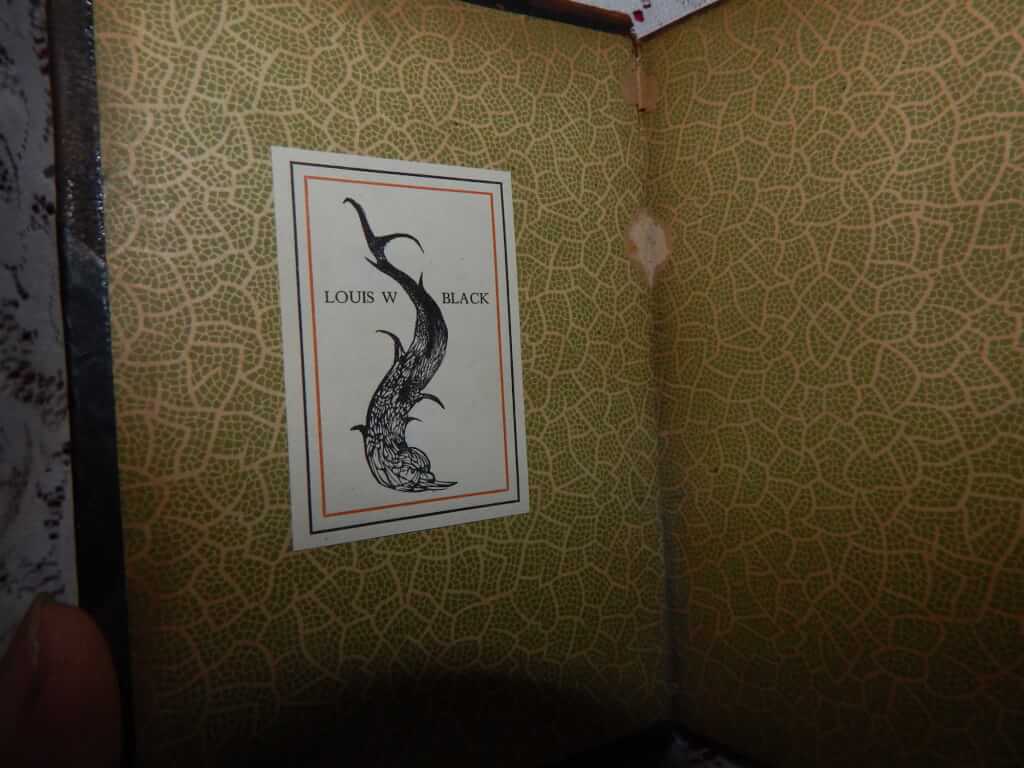
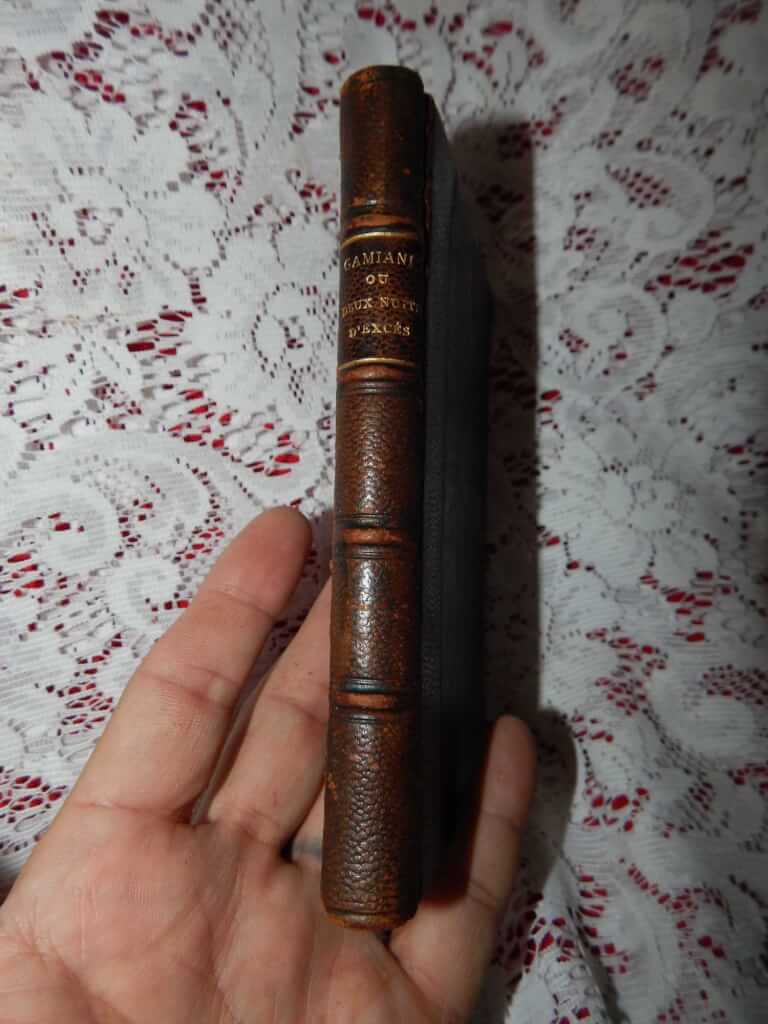 Gamiani, ou deux nuits d'excés par Alcide, Baron de M***, anonymous [believed to have been written by Alfred de Musset] (G. Lebaucher, Libraire-Éditeur, Montreal, Canada [likely Gaucher, Malakoff, France] nd.) 4.5"x6", 144pp, half morocco over marbled boards, title in gilt on spine, 4 raised bands, boards cracked but holding, just good condition Gamiani, or Two Nights of Excess is a French erotic novel first published in 1833. Its authorship is anonymous, but it is believed to have been written by Alfred de Musset and the lesbian eponymous heroine a portrait of his lover, George Sand. It became a bestseller among nineteenth century erotic literature. Modeled after George Sand, this work gives us a young man named Alcide observing the Countess Gamiani and a young girl named Fanny, engaged in their lesbian bed. Having watched them and provoked by their abandonment, he reveals himself, joins them, and they spend the night alternately sharing their intimate histories and their bodies. The stories they tell include the rape of one in a monastery and the nearly fatal debauchment of another in a convent, as well as encounters with a number of animals, including an ape and a donkey. Elias Gaucher (publisher from 1898 until 1925(?)) was a Clandestine editor who mainly used the pseudonym G. Lebaucher, Libraire-Éditeur, Montreal (Canada), but also Maison Mystère, Imprimerie Galante, etc. This publisher published many erotic underground works in English from 1898 to about 1904 with the mentions "Printed for the Erotica Biblion Society of London and New York", he also published erotic texts in French from 1899. His printing press was actually located at 11 rue Danicourt in Malakoff, France. Gaucher left his works in deposit with booksellers-distributors [...] Most editions of Gaucher are counterfeit editions of Brancart or Hirsch, and Gaucher often republished his own works.
Gamiani, ou deux nuits d'excés par Alcide, Baron de M***, anonymous [believed to have been written by Alfred de Musset] (G. Lebaucher, Libraire-Éditeur, Montreal, Canada [likely Gaucher, Malakoff, France] nd.) 4.5"x6", 144pp, half morocco over marbled boards, title in gilt on spine, 4 raised bands, boards cracked but holding, just good condition Gamiani, or Two Nights of Excess is a French erotic novel first published in 1833. Its authorship is anonymous, but it is believed to have been written by Alfred de Musset and the lesbian eponymous heroine a portrait of his lover, George Sand. It became a bestseller among nineteenth century erotic literature. Modeled after George Sand, this work gives us a young man named Alcide observing the Countess Gamiani and a young girl named Fanny, engaged in their lesbian bed. Having watched them and provoked by their abandonment, he reveals himself, joins them, and they spend the night alternately sharing their intimate histories and their bodies. The stories they tell include the rape of one in a monastery and the nearly fatal debauchment of another in a convent, as well as encounters with a number of animals, including an ape and a donkey. Elias Gaucher (publisher from 1898 until 1925(?)) was a Clandestine editor who mainly used the pseudonym G. Lebaucher, Libraire-Éditeur, Montreal (Canada), but also Maison Mystère, Imprimerie Galante, etc. This publisher published many erotic underground works in English from 1898 to about 1904 with the mentions "Printed for the Erotica Biblion Society of London and New York", he also published erotic texts in French from 1899. His printing press was actually located at 11 rue Danicourt in Malakoff, France. Gaucher left his works in deposit with booksellers-distributors [...] Most editions of Gaucher are counterfeit editions of Brancart or Hirsch, and Gaucher often republished his own works. -

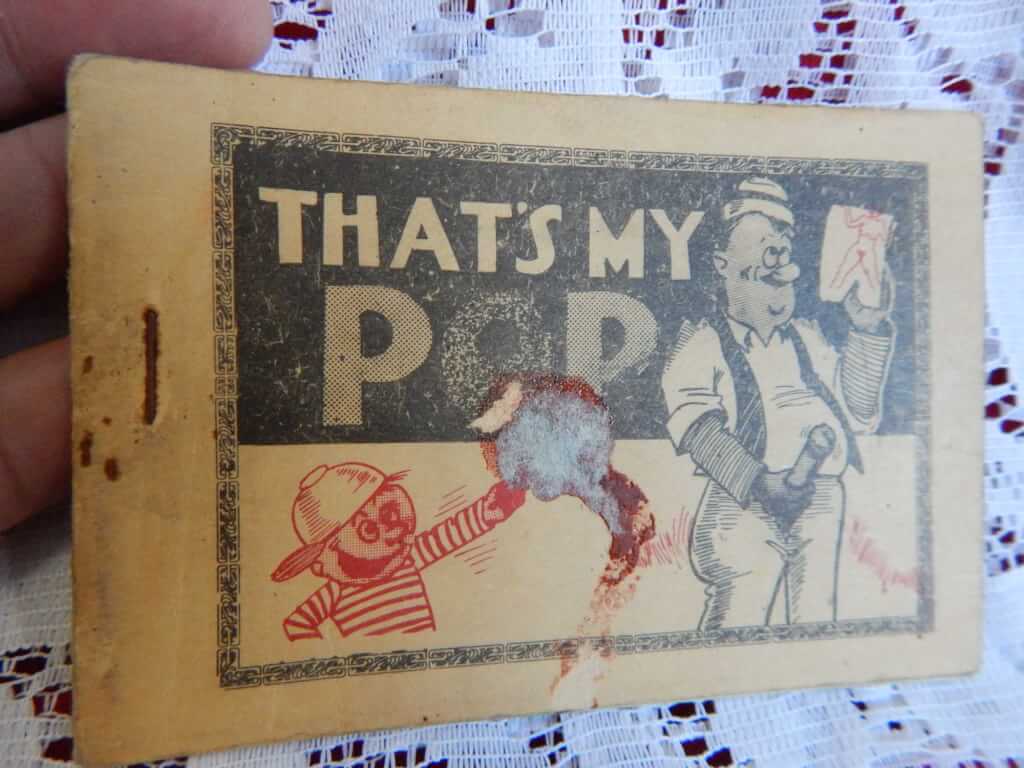 That's My Pop, (np. nd.) 4.5" x 3", 8pp.+2 pages describing sexual positions, pamphlet, stapled Tijuana bibles (also known as eight-pagers, bluesies, gray-backs, Jiggs-and-Maggie books, jo-jo books, Tillie-and-Mac books, and two-by-fours) were little pornographic comic books produced in the United States from the 1920s to the early 1960s.
That's My Pop, (np. nd.) 4.5" x 3", 8pp.+2 pages describing sexual positions, pamphlet, stapled Tijuana bibles (also known as eight-pagers, bluesies, gray-backs, Jiggs-and-Maggie books, jo-jo books, Tillie-and-Mac books, and two-by-fours) were little pornographic comic books produced in the United States from the 1920s to the early 1960s. -
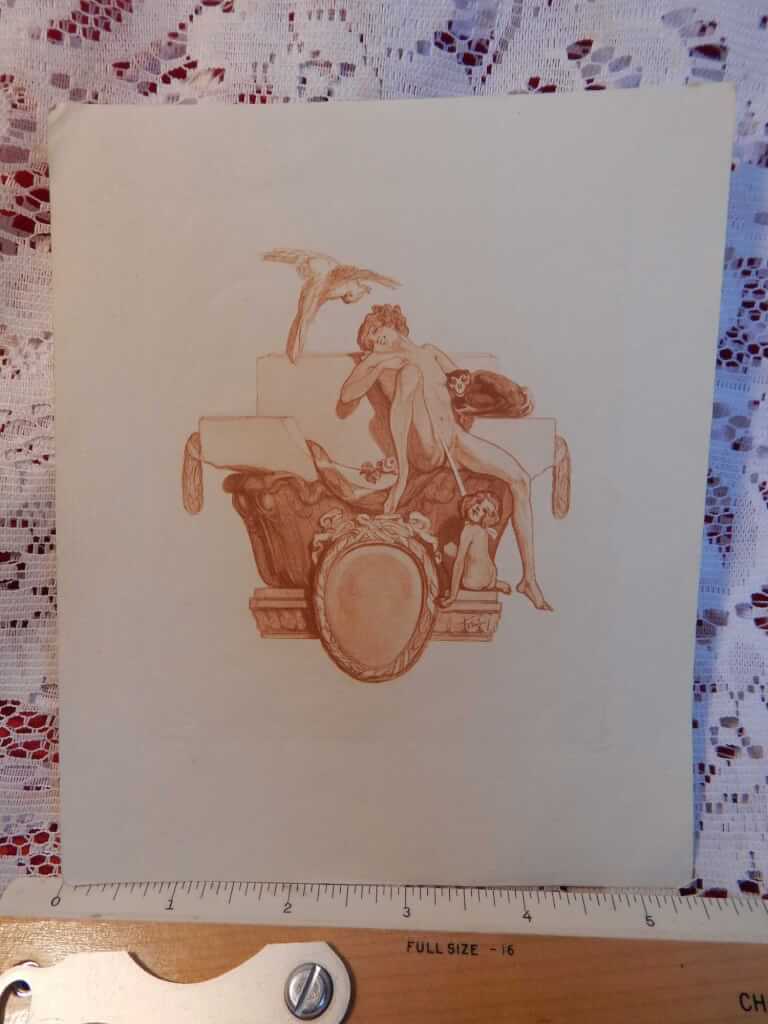 bookplate, by Franz von Bayros paper size 5.5 x 6.5", print size 4 x 4.5", on hand laid paper naked girl, animals, and child Franz von Bayros (1866 – 1924) was an Austrian commercial artist, illustrator, and painter, now he is best known for his erotic work. He belonged to the Decadent movement in art, often utilizing erotic themes and phantasmagoric imagery. At the age 17, Bayros passed the entrance exam for the Vienna Academy with Eduard von Engerth. Bayros mixed in elegant society and soon belonged to the circle of friends of Johann Straub, whose step daughter Alice he married on 1896. The next year, Bayros moved to Munich. In 1904, Bayros gave his first exhibition in Munich, which was a great success. From 1904 until 1908, Bayros traveled to Paris and Italy for his studies. Typically, for an artist dealing with such imagery, von Bayros produced work under several pseudonyms, most notably Choisy Le Conin, and was hounded by authorities for much of his life for his “indecent” art often very imaginative, and including such taboo subjects as sadomasochism and bestiality. He became equally well-known for his masterly drawn figures of elegant modestly nude and non-nude women.
bookplate, by Franz von Bayros paper size 5.5 x 6.5", print size 4 x 4.5", on hand laid paper naked girl, animals, and child Franz von Bayros (1866 – 1924) was an Austrian commercial artist, illustrator, and painter, now he is best known for his erotic work. He belonged to the Decadent movement in art, often utilizing erotic themes and phantasmagoric imagery. At the age 17, Bayros passed the entrance exam for the Vienna Academy with Eduard von Engerth. Bayros mixed in elegant society and soon belonged to the circle of friends of Johann Straub, whose step daughter Alice he married on 1896. The next year, Bayros moved to Munich. In 1904, Bayros gave his first exhibition in Munich, which was a great success. From 1904 until 1908, Bayros traveled to Paris and Italy for his studies. Typically, for an artist dealing with such imagery, von Bayros produced work under several pseudonyms, most notably Choisy Le Conin, and was hounded by authorities for much of his life for his “indecent” art often very imaginative, and including such taboo subjects as sadomasochism and bestiality. He became equally well-known for his masterly drawn figures of elegant modestly nude and non-nude women. -
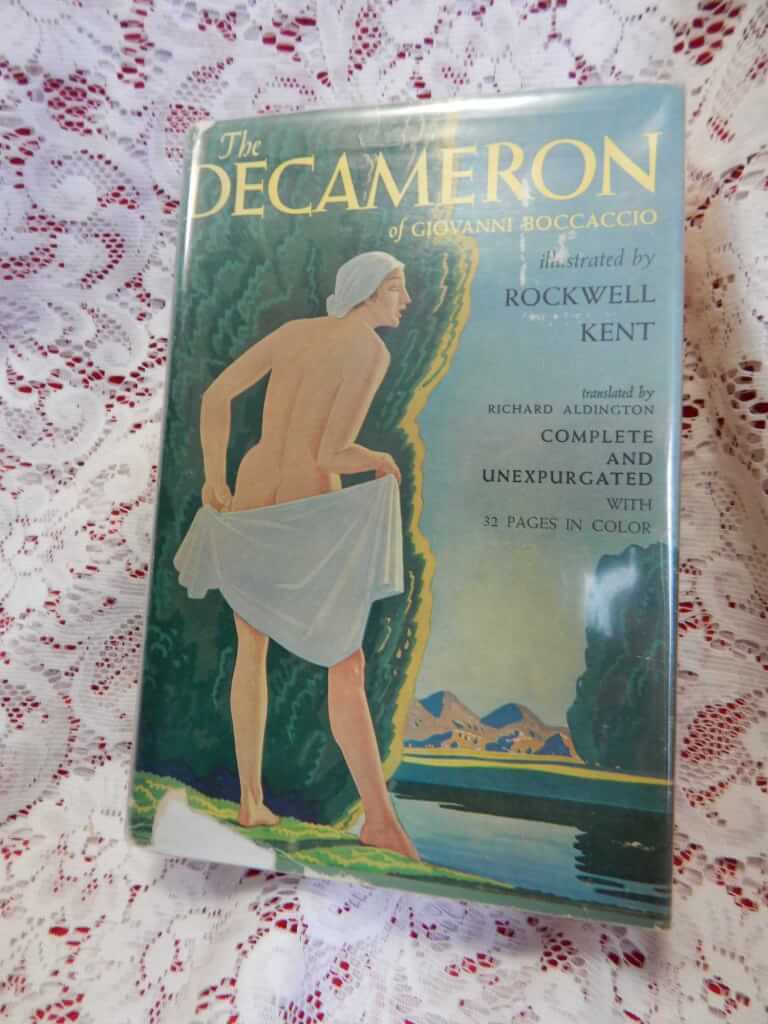
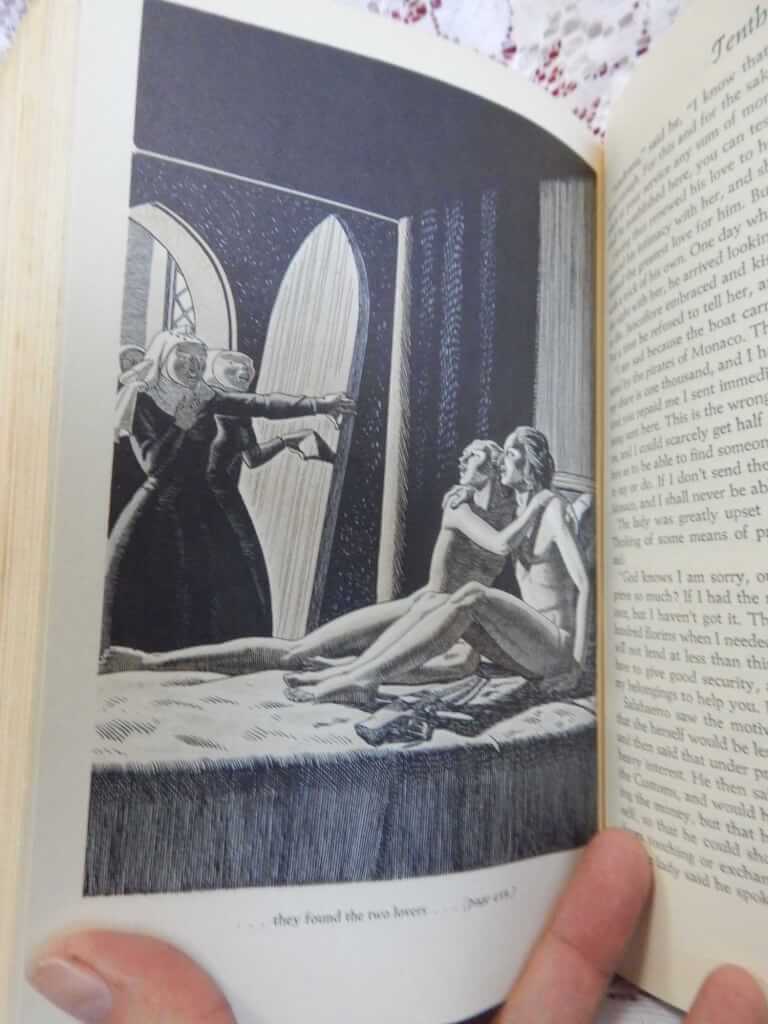 The Decameron of Giovanni Boccaccio, Giovanni Boccaccio, trans. Richard Aldington, illustrated by Rockwell Kent (Garden City Books, Garden City, NY, 1949 [date of illustrations]) 9 1/2" X 6 3/8", 562pp, hardbound with DJ (with some rips) protected by mylar, green boards with cream spine, great condition. This is the popular (at the time) Garden City edition. Superb art deco color illustrations throughout by Rockwell Kent (famous illustrator of Moby Dick and others). The Decameron, (subtitled Prencipe Galeotto or Prince Galehaut), is a collection of novellas by the 14th-century Italian author Giovanni Boccaccio (1313–1375). The book is structured as a frame story containing 100 tales told by a group of seven young women and three young men sheltering in a secluded villa just outside Florence to escape the Black Death, which was afflicting the city. To make their exile more pleasant each of the ten tells the others one story every day. The Decameron records the narratives of ten days -- 100 stories. Boccaccio probably conceived of The Decameron after the epidemic of 1348, and completed it by 1353. These tales run the entire range of human emotion: grief, love, humor, anger, revenge. Many are based on oral folklore. Boccaccio's ten narrators thus retell already familiar stories about errant priests, rascally husbands, and mischievous wives. Variants of these stories are known in many cultures, but no one formulates them more cleverly or relates them more eloquently than does Boccaccio. In addition to its literary value and widespread influence, it provides a document of life at the time. Written in the vernacular of the Florentine language, it is considered a masterpiece of classical early Italian prose.
The Decameron of Giovanni Boccaccio, Giovanni Boccaccio, trans. Richard Aldington, illustrated by Rockwell Kent (Garden City Books, Garden City, NY, 1949 [date of illustrations]) 9 1/2" X 6 3/8", 562pp, hardbound with DJ (with some rips) protected by mylar, green boards with cream spine, great condition. This is the popular (at the time) Garden City edition. Superb art deco color illustrations throughout by Rockwell Kent (famous illustrator of Moby Dick and others). The Decameron, (subtitled Prencipe Galeotto or Prince Galehaut), is a collection of novellas by the 14th-century Italian author Giovanni Boccaccio (1313–1375). The book is structured as a frame story containing 100 tales told by a group of seven young women and three young men sheltering in a secluded villa just outside Florence to escape the Black Death, which was afflicting the city. To make their exile more pleasant each of the ten tells the others one story every day. The Decameron records the narratives of ten days -- 100 stories. Boccaccio probably conceived of The Decameron after the epidemic of 1348, and completed it by 1353. These tales run the entire range of human emotion: grief, love, humor, anger, revenge. Many are based on oral folklore. Boccaccio's ten narrators thus retell already familiar stories about errant priests, rascally husbands, and mischievous wives. Variants of these stories are known in many cultures, but no one formulates them more cleverly or relates them more eloquently than does Boccaccio. In addition to its literary value and widespread influence, it provides a document of life at the time. Written in the vernacular of the Florentine language, it is considered a masterpiece of classical early Italian prose. -
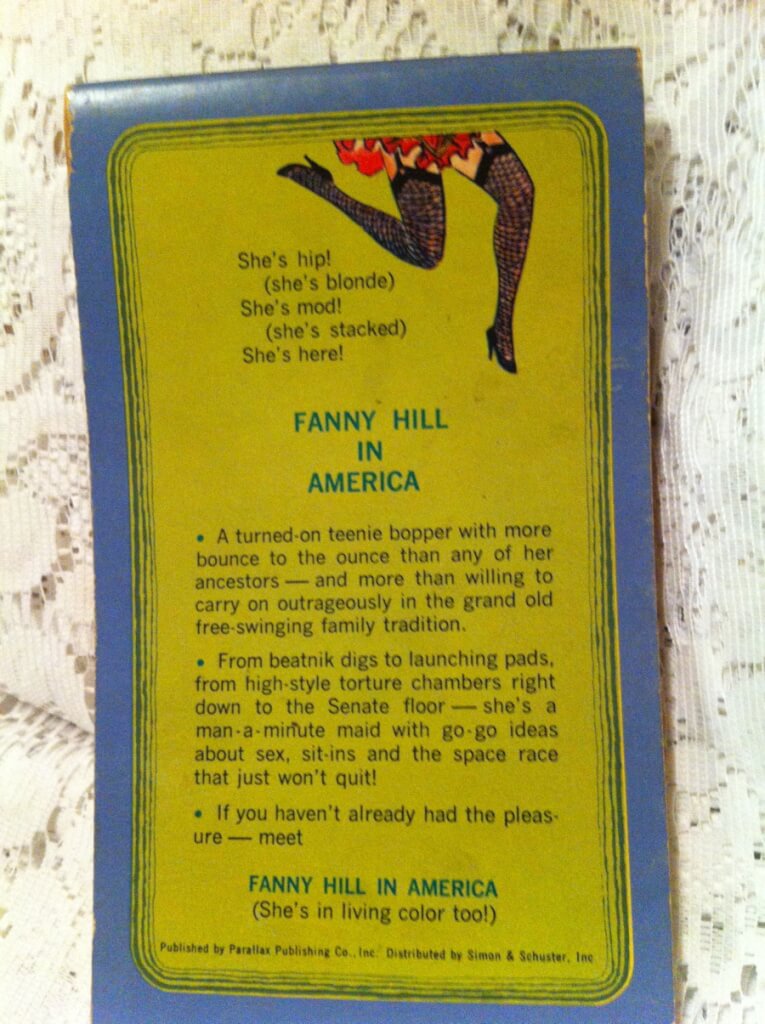
 Fanny Hill in America, by Frank Fosdick and David Sierra, cover by Jerry Schiano (Parallax Publishing Company, Inc, New York, Distributed by Simon & Schuster, Inc.) 7" x 4.25", soft cover comic book, cover scuffed and slightly soiled Stated "The first Go-Go Comic Novel in Full Color". As far as I can find it is the ONLY "Go-Go" Comic Novel. The Man from M.O.T.H.E.R. was also published in similar form saying "A Super-Cool Comic Novel in Full Color". Parallax is also hard to track down. I've only found mention of a few other comic books. all published in 1966 (The Great Society Comic Book[a parody of LBJ's social policies], it's companion comic, Bobman and Teddy [parodying Robert and Ted Kennedy], and the VERY rare Kosher Comics [featuring The Lone Arranger, Supermax, Tishman of the Apes, & Dick Shamus]). I can't find this publication listed at all. Other Parallax publications are similarly very rare.
Fanny Hill in America, by Frank Fosdick and David Sierra, cover by Jerry Schiano (Parallax Publishing Company, Inc, New York, Distributed by Simon & Schuster, Inc.) 7" x 4.25", soft cover comic book, cover scuffed and slightly soiled Stated "The first Go-Go Comic Novel in Full Color". As far as I can find it is the ONLY "Go-Go" Comic Novel. The Man from M.O.T.H.E.R. was also published in similar form saying "A Super-Cool Comic Novel in Full Color". Parallax is also hard to track down. I've only found mention of a few other comic books. all published in 1966 (The Great Society Comic Book[a parody of LBJ's social policies], it's companion comic, Bobman and Teddy [parodying Robert and Ted Kennedy], and the VERY rare Kosher Comics [featuring The Lone Arranger, Supermax, Tishman of the Apes, & Dick Shamus]). I can't find this publication listed at all. Other Parallax publications are similarly very rare. -
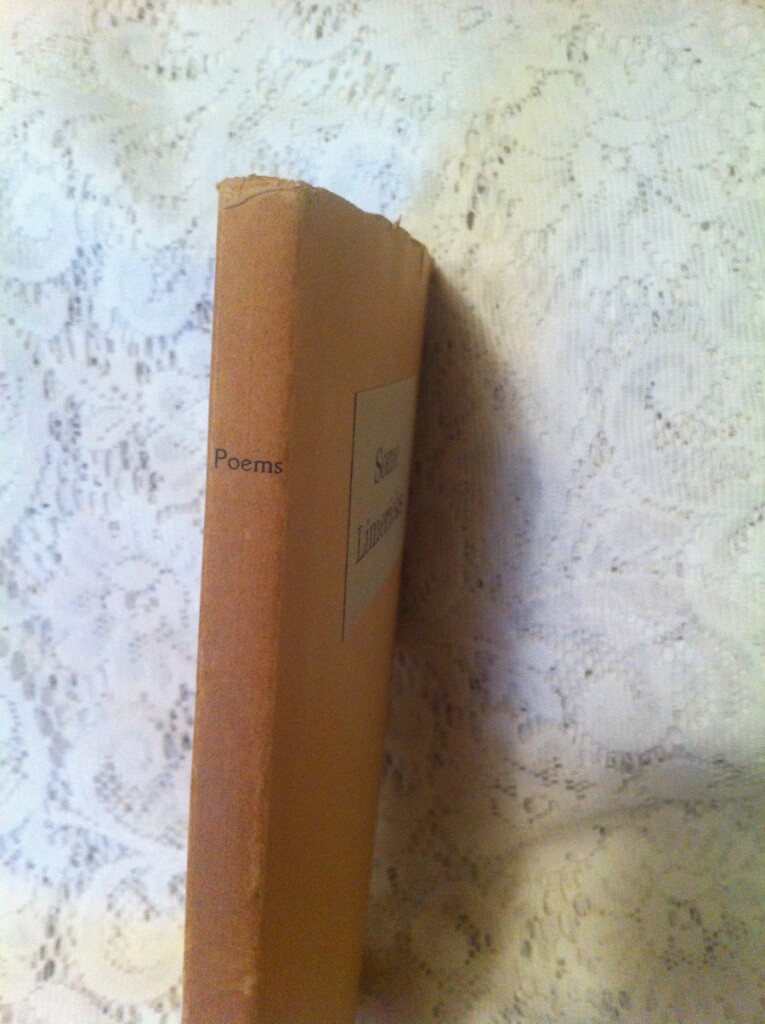
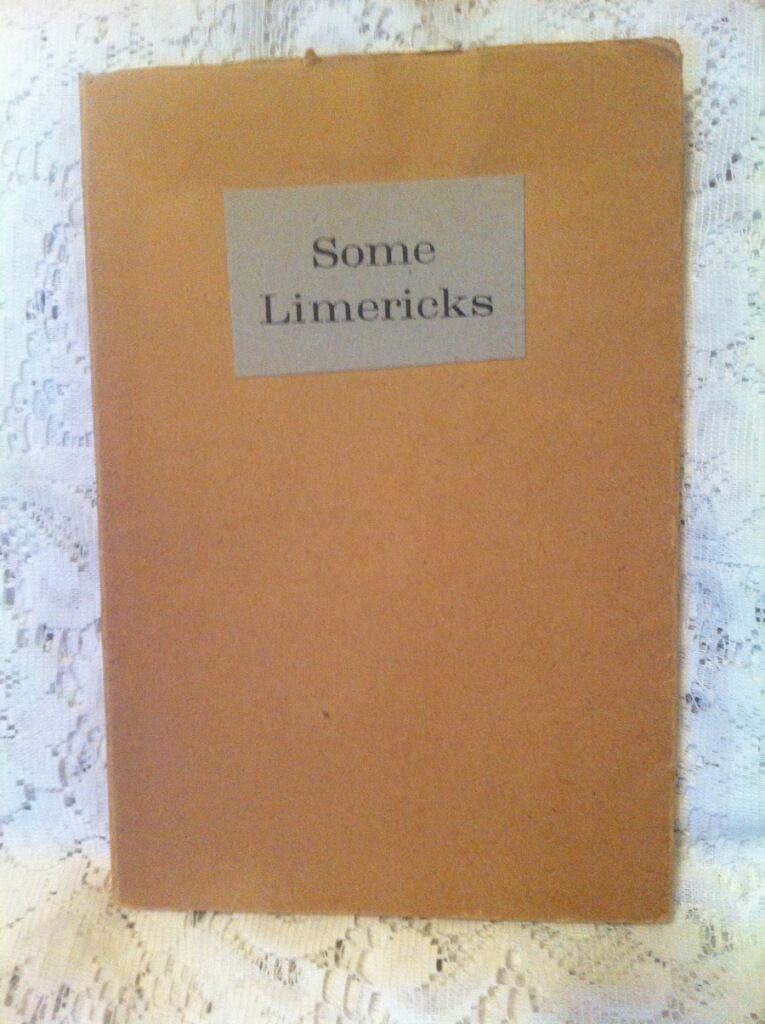 Some Limericks: Collected for the use of Students, & ensplendour’d with Introduction, Geographical Index, and with Notes Explanatory and Critical, by Norman Douglas (Nicholson and Whitney, Boston, 1942 [most likely published in Paris by Maurice Girodias of Olympia Press, early 1950's, a reprint of the Obelisk Press edition of 1939], stated 616/1000 "printed by The Brownbent Press, Boston, Mass.") 5.5" x 8.25", 117pp, near fine condition, unlabeled soft covers, dust jacket slightly warn at top with paper label "Some Limericks", spine of dust jacket simply reads "poems". Norman Douglas is an English author best known for his 1917 novel, South Wind. However, this particular book of his is one of the most pirated books of it's kind. Unable to find a publisher willing to take it on, Douglas published it himself in 1928. It was published by Oblisk Press in 1939 (said to be the last book secured for the company before Jack Kahane's lifetime). This particular edition was published by Mr. Kahane's son, Maurice Girodias, who inherited his father's press, but changed the name to Olympia Press. It is said that this book has everything, blasphemy, incest, paedophilia, bestiality. Accompanying each limericks are entertaining (if not scholarly) notes explaining the supposed origin and/or circumstances by which the rhymes were procured. So obscene and offensive, even Olympia Press, known for it's erotic literature, chose to publish under a false imprint.
Some Limericks: Collected for the use of Students, & ensplendour’d with Introduction, Geographical Index, and with Notes Explanatory and Critical, by Norman Douglas (Nicholson and Whitney, Boston, 1942 [most likely published in Paris by Maurice Girodias of Olympia Press, early 1950's, a reprint of the Obelisk Press edition of 1939], stated 616/1000 "printed by The Brownbent Press, Boston, Mass.") 5.5" x 8.25", 117pp, near fine condition, unlabeled soft covers, dust jacket slightly warn at top with paper label "Some Limericks", spine of dust jacket simply reads "poems". Norman Douglas is an English author best known for his 1917 novel, South Wind. However, this particular book of his is one of the most pirated books of it's kind. Unable to find a publisher willing to take it on, Douglas published it himself in 1928. It was published by Oblisk Press in 1939 (said to be the last book secured for the company before Jack Kahane's lifetime). This particular edition was published by Mr. Kahane's son, Maurice Girodias, who inherited his father's press, but changed the name to Olympia Press. It is said that this book has everything, blasphemy, incest, paedophilia, bestiality. Accompanying each limericks are entertaining (if not scholarly) notes explaining the supposed origin and/or circumstances by which the rhymes were procured. So obscene and offensive, even Olympia Press, known for it's erotic literature, chose to publish under a false imprint. -
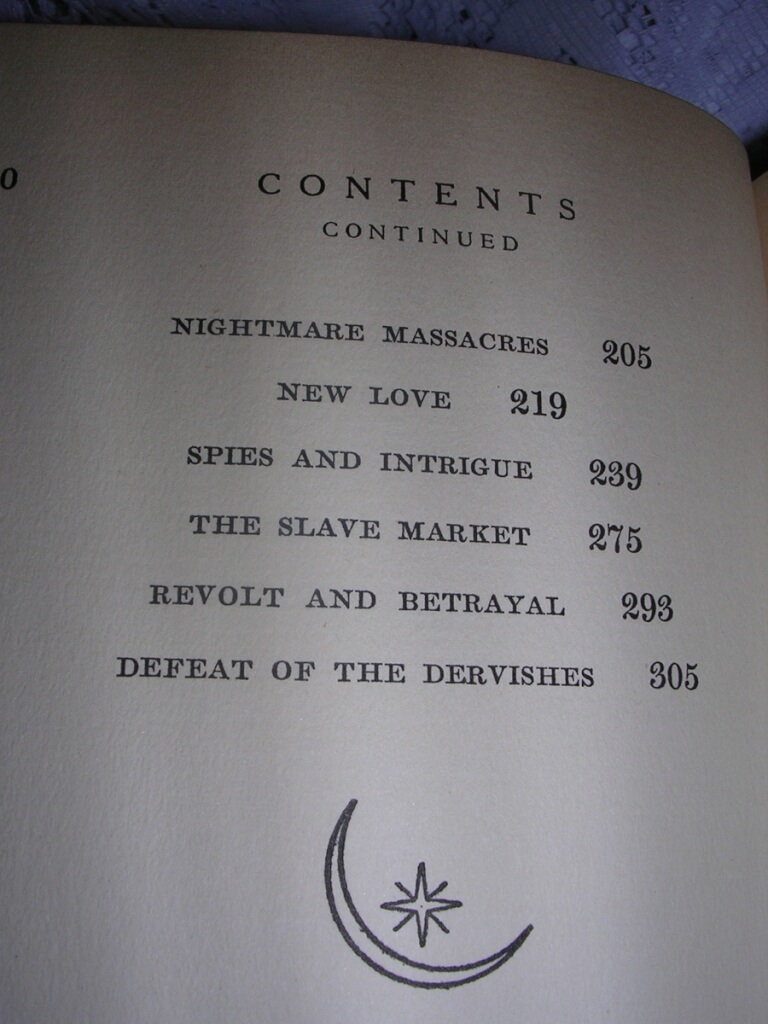
 Black Lust, Jean de Villiot [George Grassal (Hugues Rebell)] (Privately printed by The Panurge Press, Inc., New York, 1931, #365/2000) 8 5/8" X 6", 312pp, hardbound no DJ, cream cloth boards with black stamped decorations, top edge dyed blue, other edges deckle, good condition, slight soiling to boards, binding tight Jean de Villiot was a pseudonym used by several authors and compilers working for the publisher Charles Carrington writing novels and "studies" concerning flagellation, including Hugues Rebell (Georges Grassal), Hector France, Stéphane Arnoulin and Charles Carrington, himself. This novel is attributed to George Grassal (Hugues Rebell) originally written in French, in 1902, as "La Femme et son maître" (The Woman and her Master). In 1904 "Woman and her Master" was published in English by Charles Carrington. Panurge Press published this work as "Black Lust" in 1931. This book is a numbered limited edition copy of the Panurge Press edition.
Black Lust, Jean de Villiot [George Grassal (Hugues Rebell)] (Privately printed by The Panurge Press, Inc., New York, 1931, #365/2000) 8 5/8" X 6", 312pp, hardbound no DJ, cream cloth boards with black stamped decorations, top edge dyed blue, other edges deckle, good condition, slight soiling to boards, binding tight Jean de Villiot was a pseudonym used by several authors and compilers working for the publisher Charles Carrington writing novels and "studies" concerning flagellation, including Hugues Rebell (Georges Grassal), Hector France, Stéphane Arnoulin and Charles Carrington, himself. This novel is attributed to George Grassal (Hugues Rebell) originally written in French, in 1902, as "La Femme et son maître" (The Woman and her Master). In 1904 "Woman and her Master" was published in English by Charles Carrington. Panurge Press published this work as "Black Lust" in 1931. This book is a numbered limited edition copy of the Panurge Press edition. -
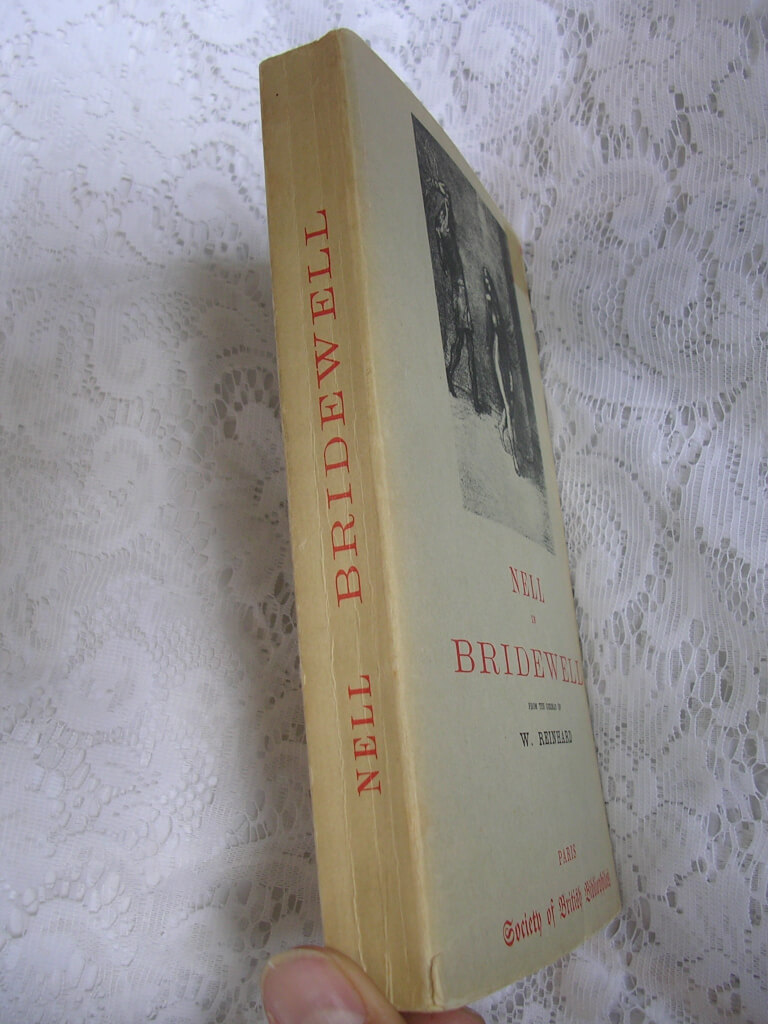
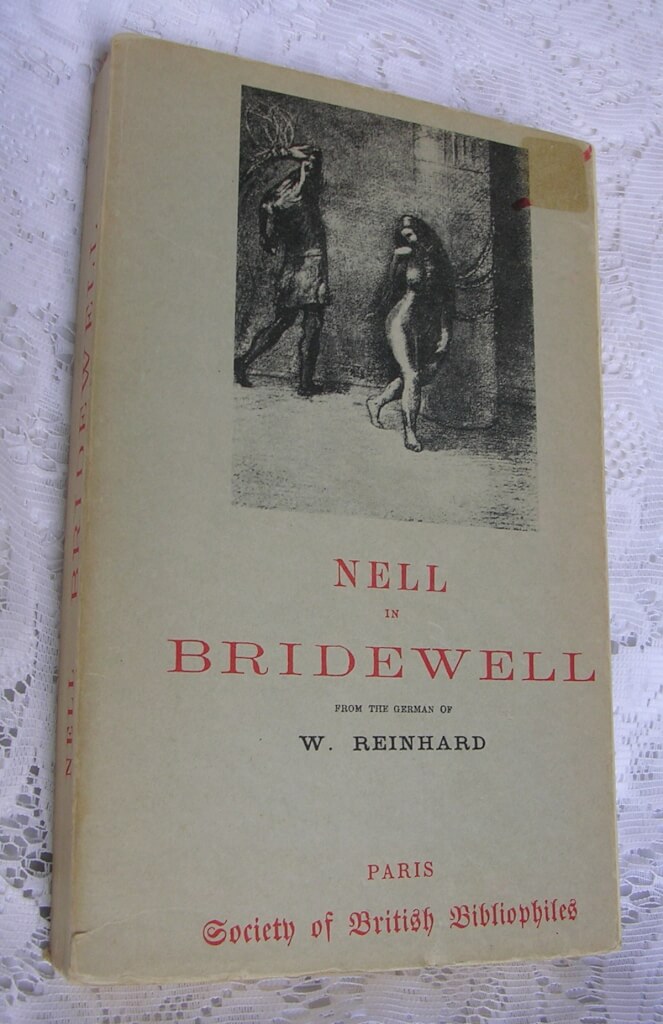 Nell in Bridewell (Lenchen im Zuchthause), W. Reinhard, trans. W.C. Costello Ph. D. and A. R. Allinson M. A. (Society of British Bibliophiles, Paris, 1900) 8" X 5", 326pp, paperback, good condition, price tag mark on front cover, a tear and some bumping, spine is creased, binding is still good Subtitle: "Description of the System of Corporal Punishment (Flagellation) in the Female Prisons of South Germany up to the year 1848; a contribution to the history of manners." Although the title suggests that this is a "study", it goes beyond the facts and delves into the minds of those who are doing the punishing and those who are being humiliated and punished. Publishers of these "flagellation novels" would often lesson their liability by representing their books as academic studies. Often they would go unnoticed by the larger community unaware of the erotic nature of such a book to a certain segment of the public. In this book, Nell describes in graphic terms the merciless floggings she witnessed of girls and young women, as well as of boys and men and confesses to disturbingly confusing emotions that such sights occasioned in her. She recalls the lustful expressions on the faces of the onlookers, records the fervent words of gratitude to the skillful flogger from the lips of grand ladies who "were only too delighted to see such girls whipped", and tells of the evidently sensual appetites such cruelties incited in the torturers.
Nell in Bridewell (Lenchen im Zuchthause), W. Reinhard, trans. W.C. Costello Ph. D. and A. R. Allinson M. A. (Society of British Bibliophiles, Paris, 1900) 8" X 5", 326pp, paperback, good condition, price tag mark on front cover, a tear and some bumping, spine is creased, binding is still good Subtitle: "Description of the System of Corporal Punishment (Flagellation) in the Female Prisons of South Germany up to the year 1848; a contribution to the history of manners." Although the title suggests that this is a "study", it goes beyond the facts and delves into the minds of those who are doing the punishing and those who are being humiliated and punished. Publishers of these "flagellation novels" would often lesson their liability by representing their books as academic studies. Often they would go unnoticed by the larger community unaware of the erotic nature of such a book to a certain segment of the public. In this book, Nell describes in graphic terms the merciless floggings she witnessed of girls and young women, as well as of boys and men and confesses to disturbingly confusing emotions that such sights occasioned in her. She recalls the lustful expressions on the faces of the onlookers, records the fervent words of gratitude to the skillful flogger from the lips of grand ladies who "were only too delighted to see such girls whipped", and tells of the evidently sensual appetites such cruelties incited in the torturers. -

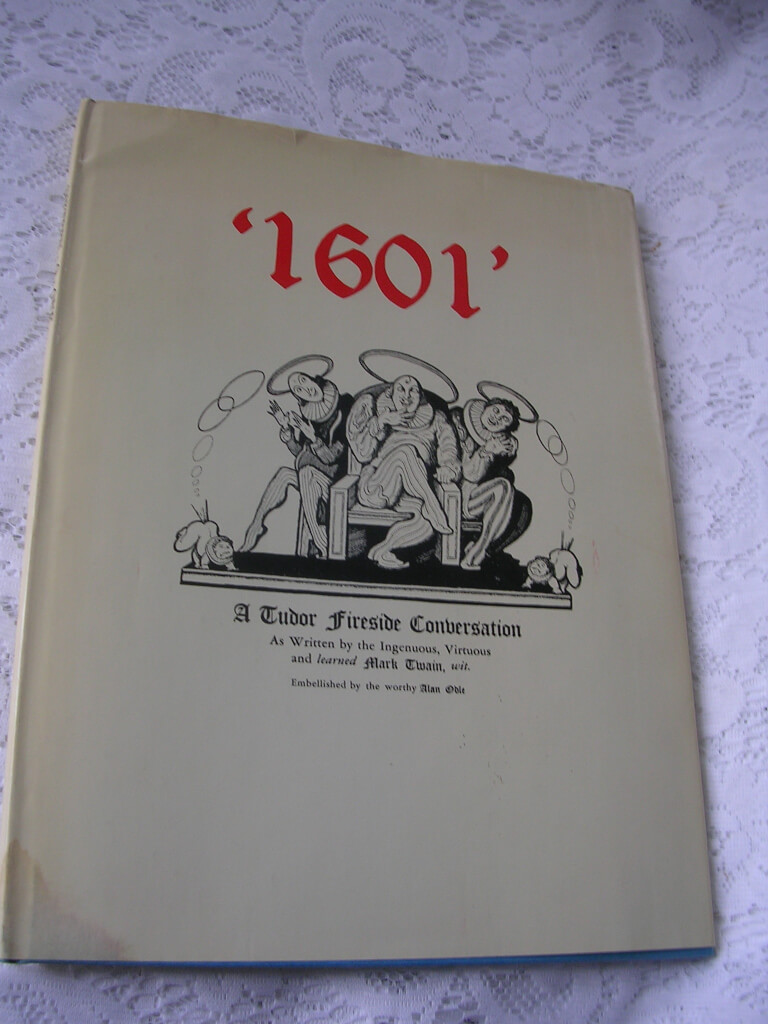 1601 A Tudor Fireside Conversation As Written by the Ingenuous, Virtuous and learned Mark Twain, wit., Embellished by the worthy Alan Odle, Mark Twain, illustrations Alan Odle (Land's End Press, USA, 1969, stated "At London, Printed for Subscribers Only and are to be sold at ye beare Back-Side in Maiden Lane") 12 1/2" X 9 1/2", 24pp (unpaginated), hardbound with dust jacket, blue boards with blue titles, pages, pages printed in such a way that the lower edge is uncut (six folded sheets of paper printed on one side, making up 4 pages) [Date: 1601.] Conversation, as it was the Social Fireside, in the Time of the Tudors is the title of a humorous work by Mark Twain, first published anonymously in 1880. Edward Wagenknecht once referred to it as "the most famous piece of pornography in American literature." Its content is irreverent and vulgar rather than obscene, and its purpose seems to be comedic shock rather than erotic arousal. It would thus qualify as ribaldry rather than pornography. Twain wrote 1601 during the summer of 1876 (between writing Tom Sawyer and Huckleberry Finn), for the amusement of his closest friend, Reverend Joseph Twichell, 1601 was later first published by another friend, John Hay, who later became Secretary of State. The work circulated among printers (due to it's often archaic type font) and many small batches were printed, however the authorship of the work remained unverified until Twain finally acknowledged he wrote it in 1906.
1601 A Tudor Fireside Conversation As Written by the Ingenuous, Virtuous and learned Mark Twain, wit., Embellished by the worthy Alan Odle, Mark Twain, illustrations Alan Odle (Land's End Press, USA, 1969, stated "At London, Printed for Subscribers Only and are to be sold at ye beare Back-Side in Maiden Lane") 12 1/2" X 9 1/2", 24pp (unpaginated), hardbound with dust jacket, blue boards with blue titles, pages, pages printed in such a way that the lower edge is uncut (six folded sheets of paper printed on one side, making up 4 pages) [Date: 1601.] Conversation, as it was the Social Fireside, in the Time of the Tudors is the title of a humorous work by Mark Twain, first published anonymously in 1880. Edward Wagenknecht once referred to it as "the most famous piece of pornography in American literature." Its content is irreverent and vulgar rather than obscene, and its purpose seems to be comedic shock rather than erotic arousal. It would thus qualify as ribaldry rather than pornography. Twain wrote 1601 during the summer of 1876 (between writing Tom Sawyer and Huckleberry Finn), for the amusement of his closest friend, Reverend Joseph Twichell, 1601 was later first published by another friend, John Hay, who later became Secretary of State. The work circulated among printers (due to it's often archaic type font) and many small batches were printed, however the authorship of the work remained unverified until Twain finally acknowledged he wrote it in 1906. -
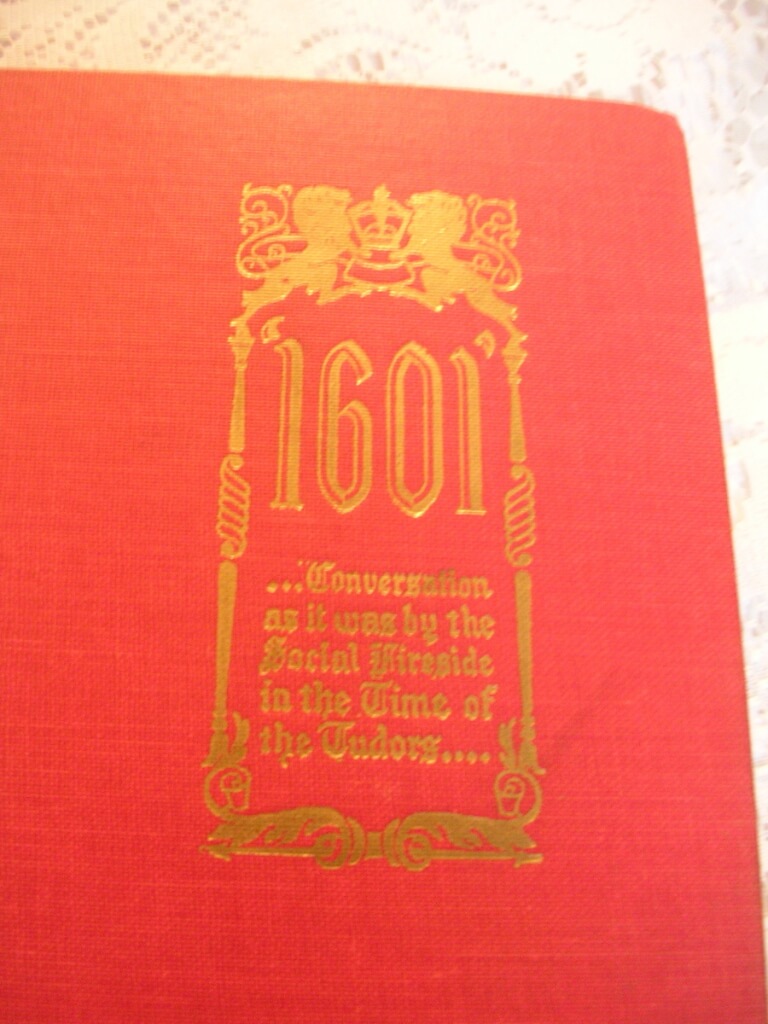
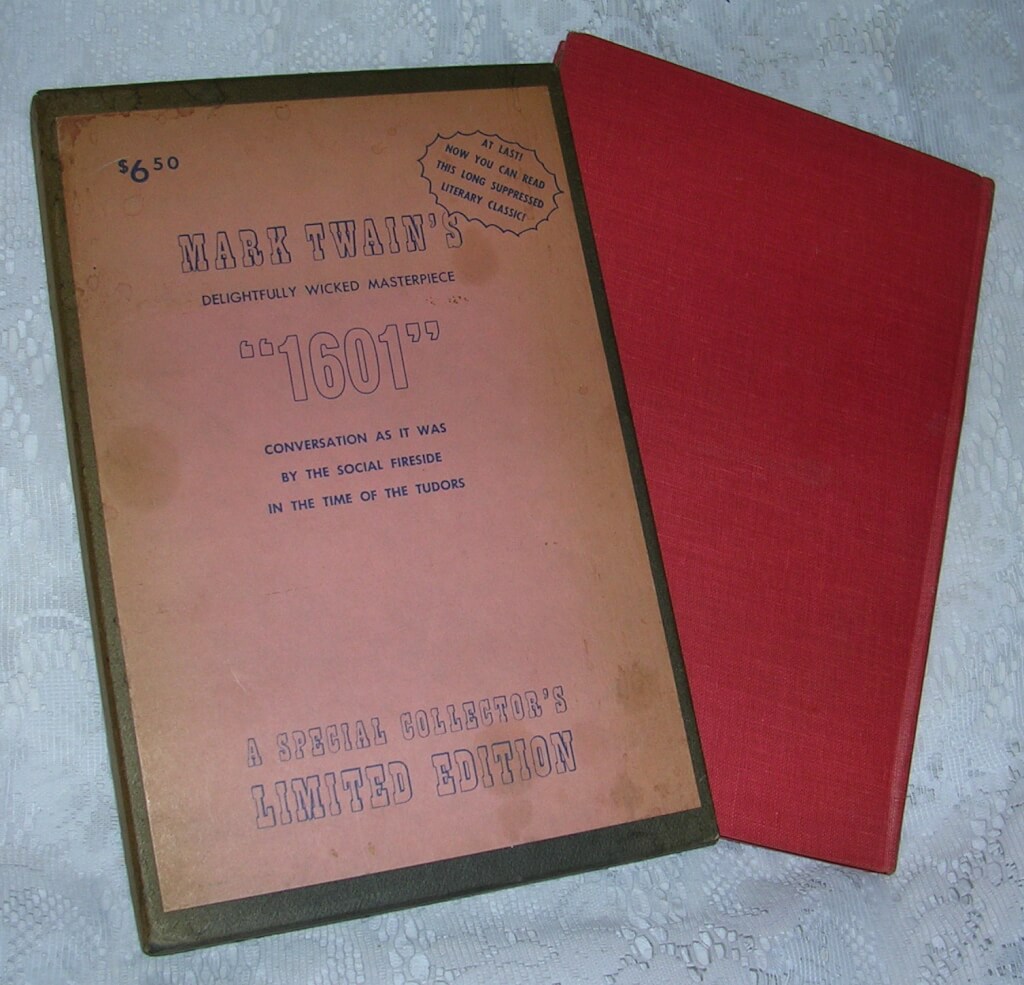 Mark Twain's [Date, 1601.] Conversation As it was by the Social Fireside in the Time of the Tudors, Mark Twain, "With an Illuminating Introduction, Facetions Footnotes and a Bibliography by Franklin J. Meine" (Privately Printed for Lyle Stuart, New York, nd [c. 1939]) 9 1/2" X 6 1/4", 80pp, hardbound no DJ with slipcase, red cloth boards with gilt lettering and decoration, book very good condition, slight soiling on spine, slipcover good condition, faded spine and soiled but intact [Date: 1601.] Conversation, as it was the Social Fireside, in the Time of the Tudors is the title of a humorous work by Mark Twain, first published anonymously in 1880. Edward Wagenknecht once referred to it as "the most famous piece of pornography in American literature." Its content is irreverent and vulgar rather than obscene, and its purpose seems to be comedic shock rather than erotic arousal. It would thus qualify as ribaldry rather than pornography. Twain wrote 1601 during the summer of 1876 (between writing Tom Sawyer and Huckleberry Finn), for the amusement of his closest friend, Reverend Joseph Twichell, 1601 was later first published by another friend, John Hay, who later became Secretary of State. The work circulated among printers (due to it's often archaic type font) and many small batches were printed, however the authorship of the work remained unverified until Twain finally acknowledged he wrote it in 1906.
Mark Twain's [Date, 1601.] Conversation As it was by the Social Fireside in the Time of the Tudors, Mark Twain, "With an Illuminating Introduction, Facetions Footnotes and a Bibliography by Franklin J. Meine" (Privately Printed for Lyle Stuart, New York, nd [c. 1939]) 9 1/2" X 6 1/4", 80pp, hardbound no DJ with slipcase, red cloth boards with gilt lettering and decoration, book very good condition, slight soiling on spine, slipcover good condition, faded spine and soiled but intact [Date: 1601.] Conversation, as it was the Social Fireside, in the Time of the Tudors is the title of a humorous work by Mark Twain, first published anonymously in 1880. Edward Wagenknecht once referred to it as "the most famous piece of pornography in American literature." Its content is irreverent and vulgar rather than obscene, and its purpose seems to be comedic shock rather than erotic arousal. It would thus qualify as ribaldry rather than pornography. Twain wrote 1601 during the summer of 1876 (between writing Tom Sawyer and Huckleberry Finn), for the amusement of his closest friend, Reverend Joseph Twichell, 1601 was later first published by another friend, John Hay, who later became Secretary of State. The work circulated among printers (due to it's often archaic type font) and many small batches were printed, however the authorship of the work remained unverified until Twain finally acknowledged he wrote it in 1906. -
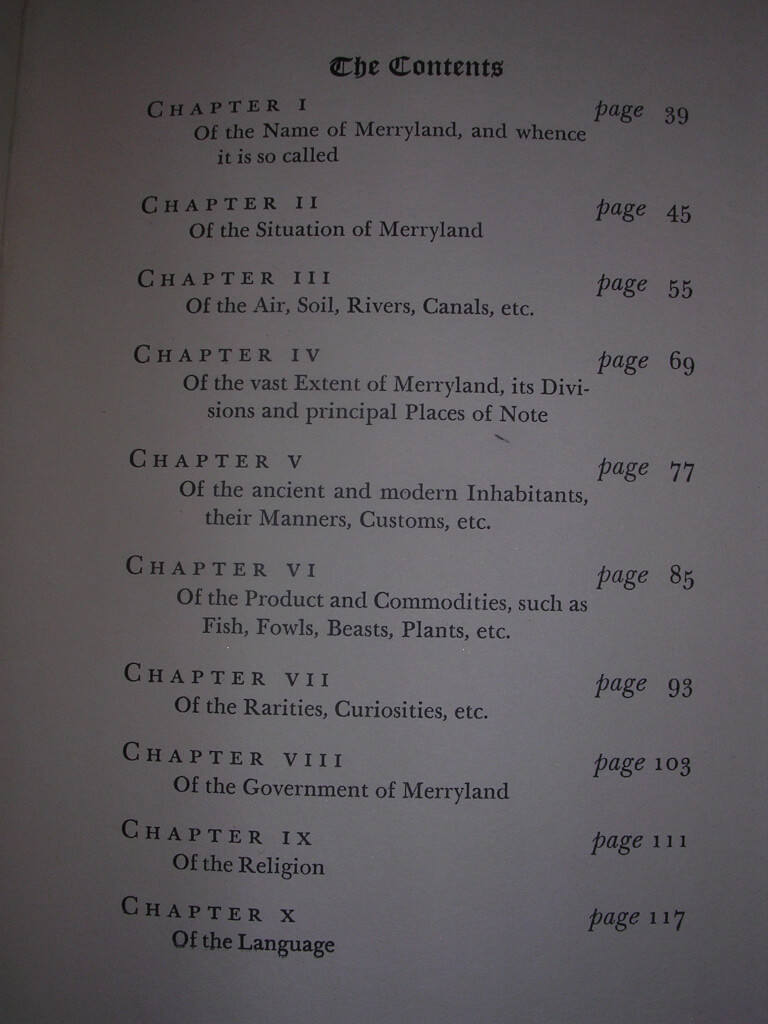
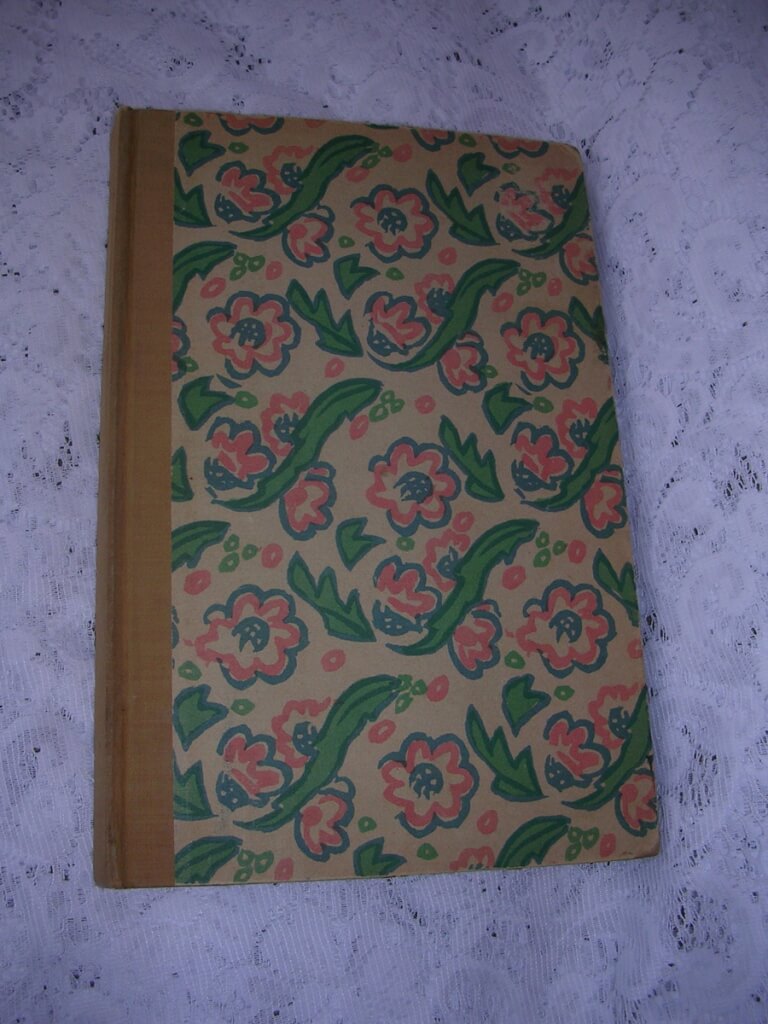 Merryland, Thomas Stretzer (Privately Issued, New York, Robin Hood House, 1932) 9 3/8" X 6 1/4", 136pp, hardbound no DJ, decorative paper boards with mylar protector, flower design, gilt lettering on spine, very good condition The Merryland books were a somewhat peculiar genre of English seventeenth and eighteenth century erotic fiction in which the female body was described in terms of a topographical metaphor derived from a pun on Maryland. Stretzer's book is typical of the genre in depicting the female body as a landscape that men explore, till, and plow. For example, he writes: "Her valleys are like Eden, her hills like Lebanon, she is a paradise of pleasure and a garden of delight."
Merryland, Thomas Stretzer (Privately Issued, New York, Robin Hood House, 1932) 9 3/8" X 6 1/4", 136pp, hardbound no DJ, decorative paper boards with mylar protector, flower design, gilt lettering on spine, very good condition The Merryland books were a somewhat peculiar genre of English seventeenth and eighteenth century erotic fiction in which the female body was described in terms of a topographical metaphor derived from a pun on Maryland. Stretzer's book is typical of the genre in depicting the female body as a landscape that men explore, till, and plow. For example, he writes: "Her valleys are like Eden, her hills like Lebanon, she is a paradise of pleasure and a garden of delight." -
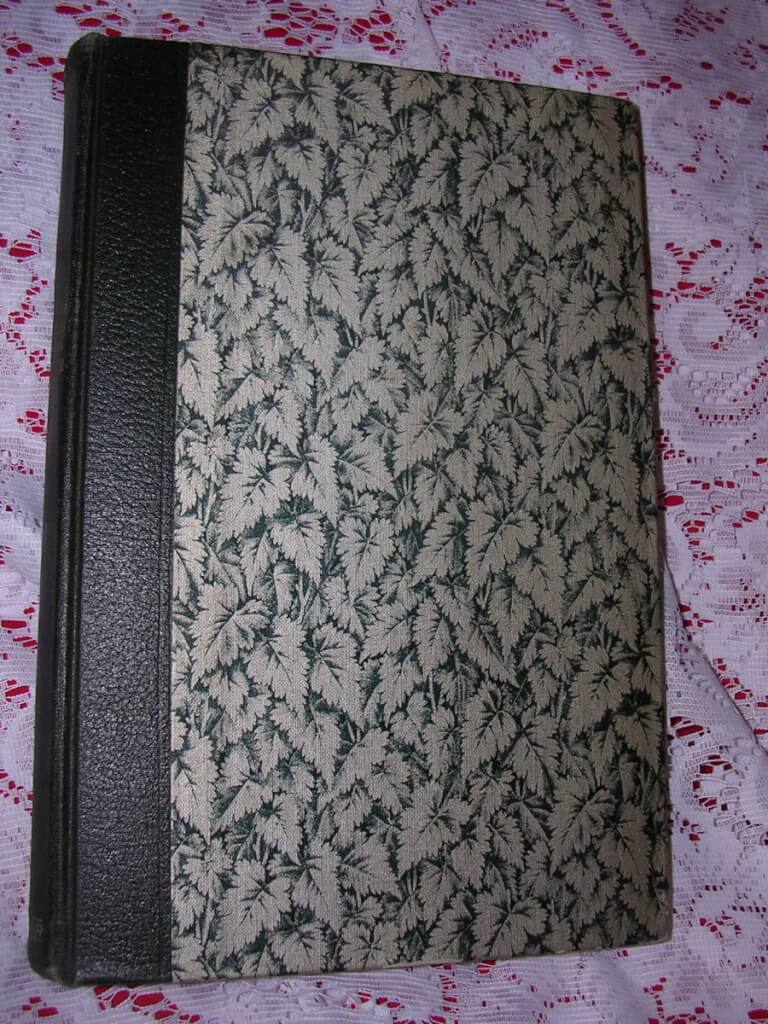
 Amatory Adventures of Sheik Mansour, A Master of the Art of Love, Hector France (Jul-Mar Press, 1932) 6 3/8 x 9 5/8", 249 pp, Stated, limited printing of 1000, but has no number. By Hector France, illustrated by Esaye Rabkin, this is a nice copy of this classic erotic novel. Book is a good used copy - cover is nice, has some rubbing to corners, overall age/use, as seen in the photo. Pages are all present and bound solid. Book has two 'Discarded' stamps, one at inside of the front cover, one at the title page. Has a damp stain along bottom margin of pages from front to page 19, small chip and tear at bottom of the title page. I see no other extraneous marks in this copy! Hector France (1837 - 1908) was a French author best known for his "orientalist" and flagellation tales. This is his risque tale of an Arab stud in action; a novel set around a Turkish harem. Translated by Alfred Allinson and reproduced from the Charles Carrington novel "The Chastisement of Mansour"
Amatory Adventures of Sheik Mansour, A Master of the Art of Love, Hector France (Jul-Mar Press, 1932) 6 3/8 x 9 5/8", 249 pp, Stated, limited printing of 1000, but has no number. By Hector France, illustrated by Esaye Rabkin, this is a nice copy of this classic erotic novel. Book is a good used copy - cover is nice, has some rubbing to corners, overall age/use, as seen in the photo. Pages are all present and bound solid. Book has two 'Discarded' stamps, one at inside of the front cover, one at the title page. Has a damp stain along bottom margin of pages from front to page 19, small chip and tear at bottom of the title page. I see no other extraneous marks in this copy! Hector France (1837 - 1908) was a French author best known for his "orientalist" and flagellation tales. This is his risque tale of an Arab stud in action; a novel set around a Turkish harem. Translated by Alfred Allinson and reproduced from the Charles Carrington novel "The Chastisement of Mansour" -
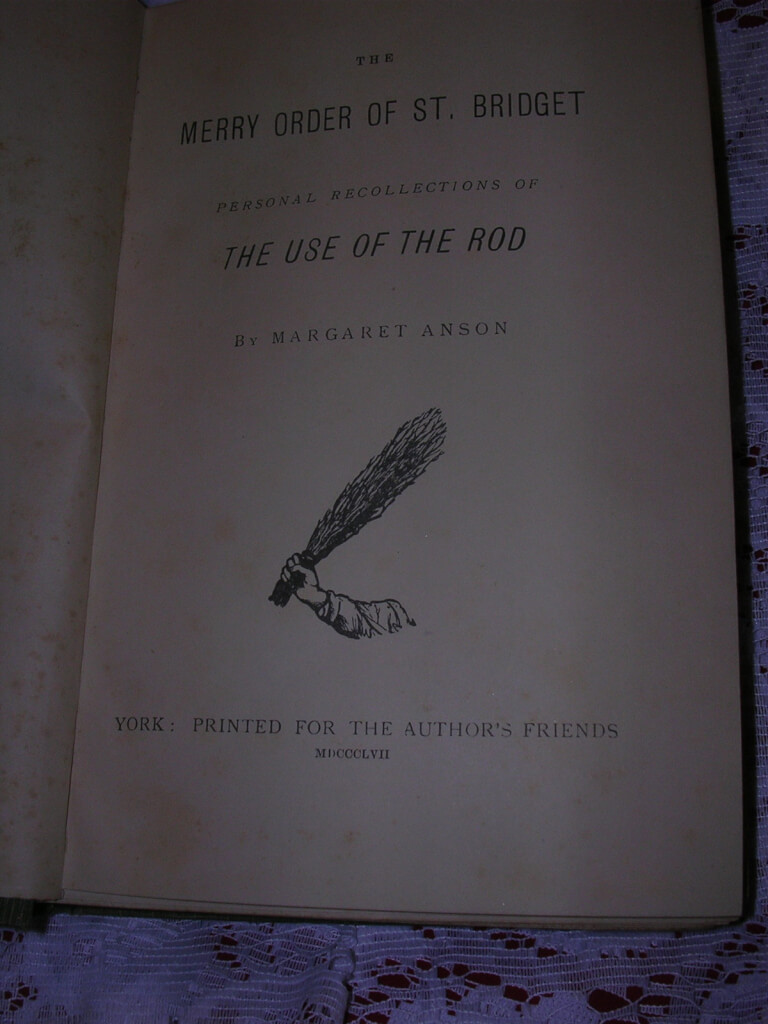
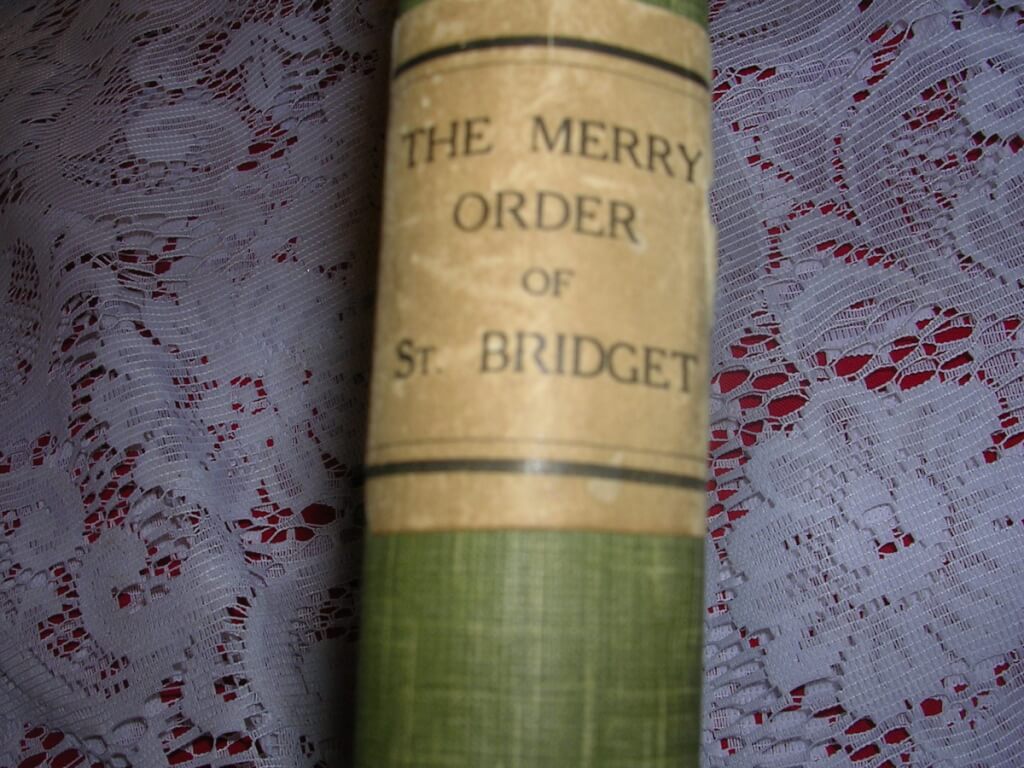 The Merry Order of St. Bridget, Margaret Anson (James Glass Bertram) (Printed for the Author's Friends, np, York, 1857 [fascimile copy of the 1868 edition c. 1930]) 7 7/8" X 5 1/4", 237pp, hardbound textured green cloth boards, paper lable on spine, deckle edges, corners and top/botton of spine bumped, binding loose but intact Bertram was apprenticed to Tait's Edinburgh Magazine and became managing clerk, before joining a company of strolling players. He returned to Edinburgh and set up as a bookseller and newsagent. In 1855 he was appointed the editor of the North Briton and in 1872 of the Glasgow News, leaving to become a freelance journalist two years later. He published "flagellation" pornography under the names "Revd William Cooper" and "Margaret Anson". In this graphic unveiling of 19th-century sexual adventures, Margaret Anson, a submissive handmaiden to the notorious Marquise St. Val_ry, describes the orgies at the Chateau de Floris, where the elite women of Paris submit to the subjugations and exotic indignities of the flesh that trigger ecstatic sensations. "Do you remember how we used to indulge in whipping on the sly, when Madame thought we were in bed? That was a very untutored way of proceeding. I have learned better since, and I can tell you that the passion for the rod is one which grows." 237 pp.
The Merry Order of St. Bridget, Margaret Anson (James Glass Bertram) (Printed for the Author's Friends, np, York, 1857 [fascimile copy of the 1868 edition c. 1930]) 7 7/8" X 5 1/4", 237pp, hardbound textured green cloth boards, paper lable on spine, deckle edges, corners and top/botton of spine bumped, binding loose but intact Bertram was apprenticed to Tait's Edinburgh Magazine and became managing clerk, before joining a company of strolling players. He returned to Edinburgh and set up as a bookseller and newsagent. In 1855 he was appointed the editor of the North Briton and in 1872 of the Glasgow News, leaving to become a freelance journalist two years later. He published "flagellation" pornography under the names "Revd William Cooper" and "Margaret Anson". In this graphic unveiling of 19th-century sexual adventures, Margaret Anson, a submissive handmaiden to the notorious Marquise St. Val_ry, describes the orgies at the Chateau de Floris, where the elite women of Paris submit to the subjugations and exotic indignities of the flesh that trigger ecstatic sensations. "Do you remember how we used to indulge in whipping on the sly, when Madame thought we were in bed? That was a very untutored way of proceeding. I have learned better since, and I can tell you that the passion for the rod is one which grows." 237 pp. -
Out of stock
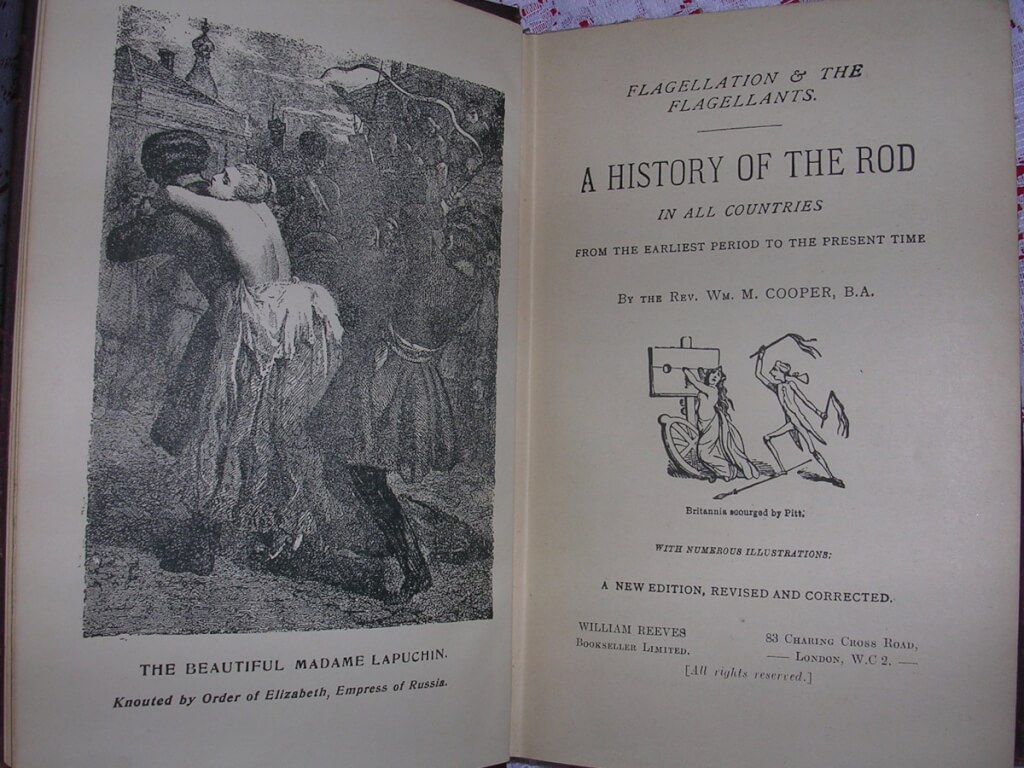
 Flagellation & the Flagellants. A History of the Rod in All Countries from the earliest period to the present time, The Rev. Wm. M. Cooper, B.A. [James Glass Bertram] (William Reeves Bookseller Limited, London, nd [c. 1908]) 7 3/4" X 5 1/4", 544pp, hardbound no DJ, dark purple cloth boards with gilt stamp and blind stamp decorations to boards and spine, good condition, minor bumping and rubbing, a few stains on lower fore-edge of boards. Bertram was apprenticed to Tait's Edinburgh Magazine and became managing clerk, before joining a company of strolling players. He returned to Edinburgh and set up as a bookseller and newsagent. In 1855 he was appointed the editor of the North Briton and in 1872 of the Glasgow News, leaving to become a freelance journalist two years later. He published "flagellation" pornography under the names "Revd William Cooper" and "Margaret Anson". This edition was published by William Reeves sometime around 1908.
Flagellation & the Flagellants. A History of the Rod in All Countries from the earliest period to the present time, The Rev. Wm. M. Cooper, B.A. [James Glass Bertram] (William Reeves Bookseller Limited, London, nd [c. 1908]) 7 3/4" X 5 1/4", 544pp, hardbound no DJ, dark purple cloth boards with gilt stamp and blind stamp decorations to boards and spine, good condition, minor bumping and rubbing, a few stains on lower fore-edge of boards. Bertram was apprenticed to Tait's Edinburgh Magazine and became managing clerk, before joining a company of strolling players. He returned to Edinburgh and set up as a bookseller and newsagent. In 1855 he was appointed the editor of the North Briton and in 1872 of the Glasgow News, leaving to become a freelance journalist two years later. He published "flagellation" pornography under the names "Revd William Cooper" and "Margaret Anson". This edition was published by William Reeves sometime around 1908. -
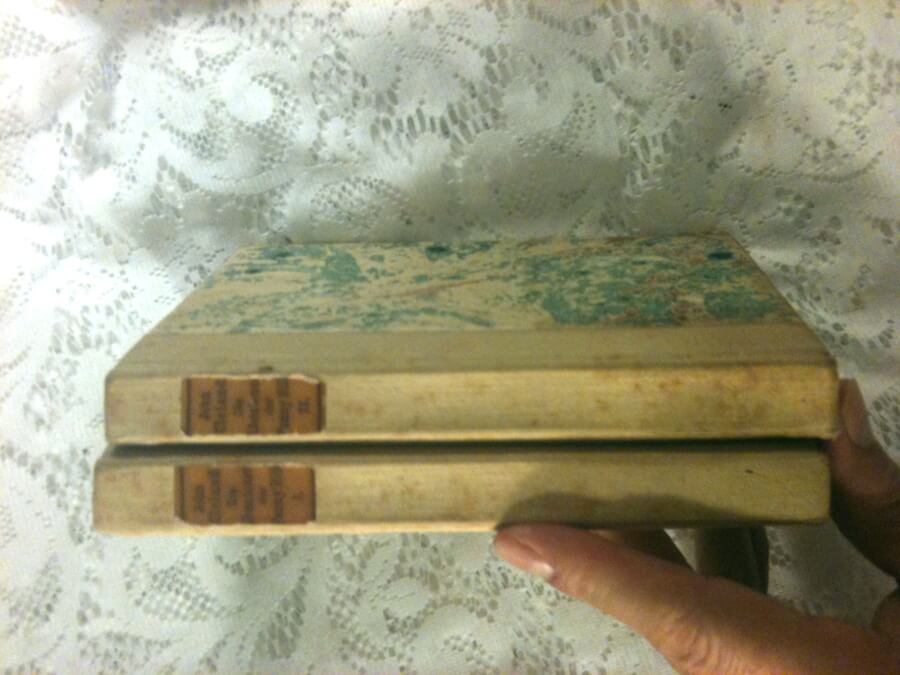
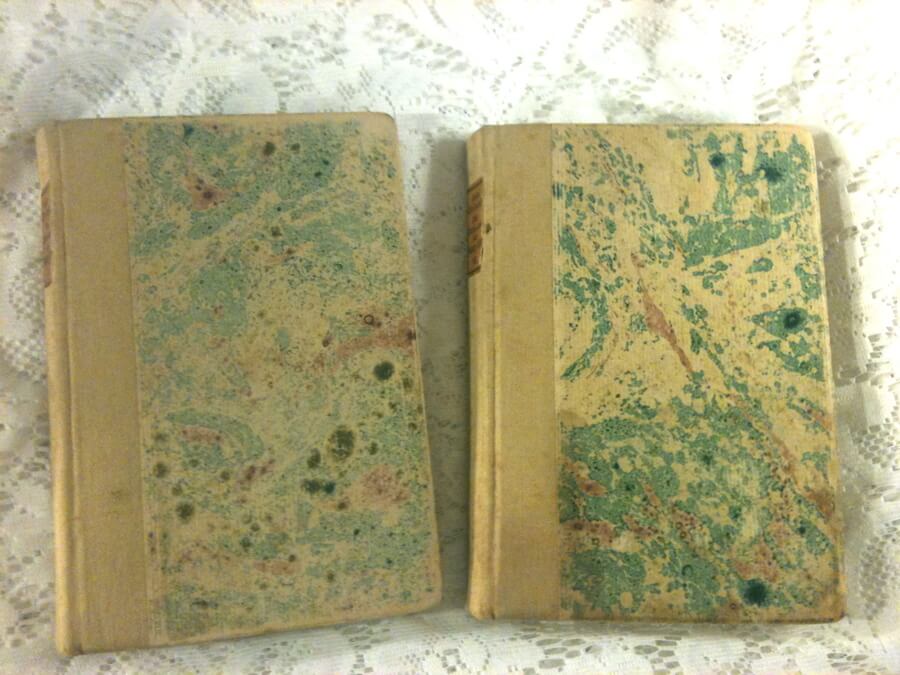 Die Abenteuer der Fanny Hill, John Cleland (np, München, 1919) 7.25" x 5", 2 vol., 178pp, 179-370pp, hardbound, marbled paper boards with cloth spine. Paper label on spine. Good condition for age, showing wear at hinges, both slightly cocked, pages yellowing. Boards worn at edges and corners Written while the author was in debtor's prison in London and first published in 1749, Fanny Hill is considered the first original English prose pornography, and the first pornography to use the form of the novel. One of the most prosecuted and banned books in history, it has become a synonym for obscenity. This German version of Fanny Hill is without mention of publisher. This was German "Bückware" or an item that was kept under the counter only for customers who asked for it. A nice 2 volume set in German.
Die Abenteuer der Fanny Hill, John Cleland (np, München, 1919) 7.25" x 5", 2 vol., 178pp, 179-370pp, hardbound, marbled paper boards with cloth spine. Paper label on spine. Good condition for age, showing wear at hinges, both slightly cocked, pages yellowing. Boards worn at edges and corners Written while the author was in debtor's prison in London and first published in 1749, Fanny Hill is considered the first original English prose pornography, and the first pornography to use the form of the novel. One of the most prosecuted and banned books in history, it has become a synonym for obscenity. This German version of Fanny Hill is without mention of publisher. This was German "Bückware" or an item that was kept under the counter only for customers who asked for it. A nice 2 volume set in German. -
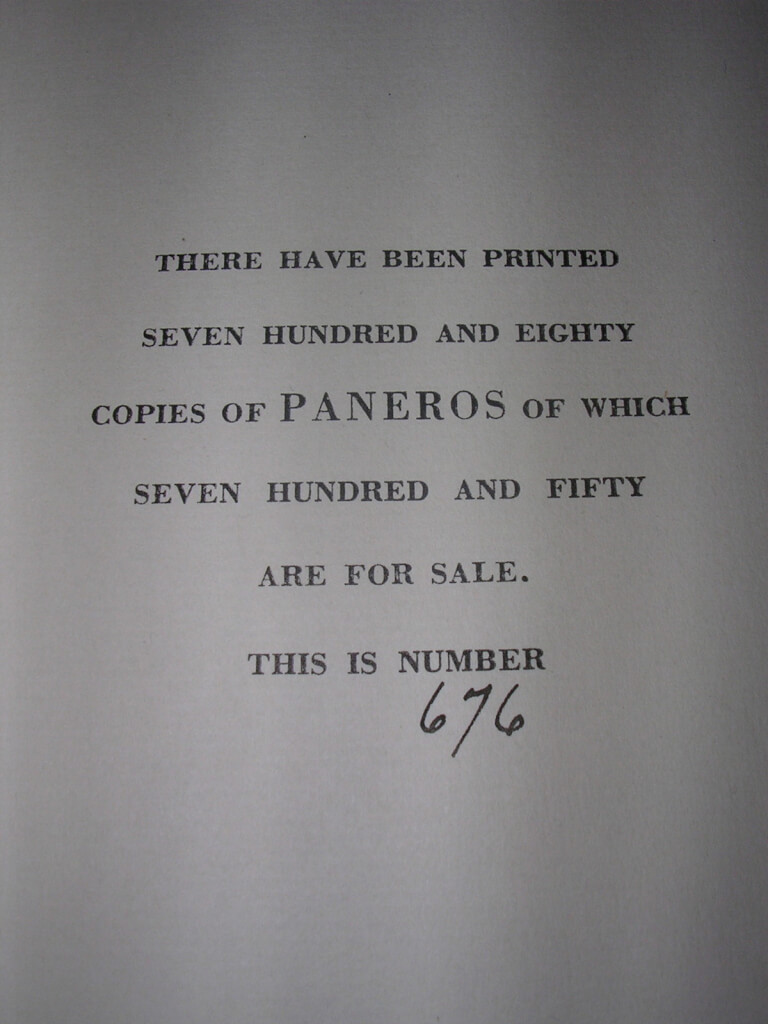
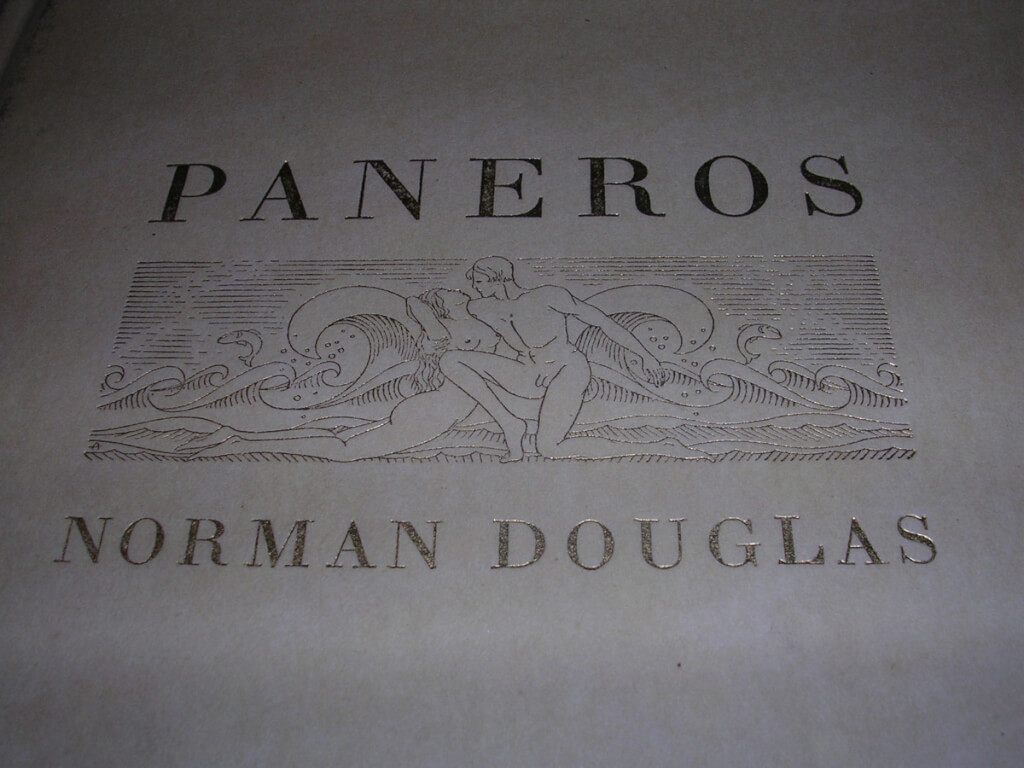 Paneros, some works on aphrodisiacs and the like, Normal Douglas, illus. Robert Rotter [limited, #676/780] (Robert M. McBride & Company, New York, 1932) 9.25" X 5.75", 120pp. Hardcover beige-tan vellum boards with gilt lettering and decorations, top edges gilt. Illustrations throughout. Book in excellent condition, light browning on the spine and edges, it appears to be unread as the binding is tight. #676/780 British author George Norman Douglas (1868 _ 1952) initially published this book in Italy. Doubtless, at the time, had this guide to the world of sexual stimulants been published in London, the author and publisher would have been prosecuted for obscenity. Soon thereafter this limited American version was printed. This edition features an erotic woodcut frontis, other illustrations by Robert Rotter and was limited to 780 copies. Hard to find book with an even harder to find slipcase. Interesting and beautifully illustrated.
Paneros, some works on aphrodisiacs and the like, Normal Douglas, illus. Robert Rotter [limited, #676/780] (Robert M. McBride & Company, New York, 1932) 9.25" X 5.75", 120pp. Hardcover beige-tan vellum boards with gilt lettering and decorations, top edges gilt. Illustrations throughout. Book in excellent condition, light browning on the spine and edges, it appears to be unread as the binding is tight. #676/780 British author George Norman Douglas (1868 _ 1952) initially published this book in Italy. Doubtless, at the time, had this guide to the world of sexual stimulants been published in London, the author and publisher would have been prosecuted for obscenity. Soon thereafter this limited American version was printed. This edition features an erotic woodcut frontis, other illustrations by Robert Rotter and was limited to 780 copies. Hard to find book with an even harder to find slipcase. Interesting and beautifully illustrated. -
 Flagellation & the Flagellants. A History of the Rod in All Countries from the earliest period to the present time, The Rev. Wm. M. Cooper, B.A. [James Glass Bertram] (William Reeves Bookseller Limited, London, nd [c. 1908]) 7 3/4" X 5 1/4", 544pp, hardbound no DJ, dark purple cloth boards with gilt stamp and blind stamp decorations to boards and spine, price is marked on spine in gilt "12/6" (12 shilling, 6 penny), gilting is faded, good condition, minor bumping and rubbing, binding good but leaning slightly, back board hinges worn but holding. Bertram was apprenticed to Tait's Edinburgh Magazine and became managing clerk, before joining a company of strolling players. He returned to Edinburgh and set up as a bookseller and newsagent. In 1855 he was appointed the editor of the North Briton and in 1872 of the Glasgow News, leaving to become a freelance journalist two years later. He published "flagellation" pornography under the names "Revd William Cooper" and "Margaret Anson". This edition was published by William Reeves sometime around 1908.
Flagellation & the Flagellants. A History of the Rod in All Countries from the earliest period to the present time, The Rev. Wm. M. Cooper, B.A. [James Glass Bertram] (William Reeves Bookseller Limited, London, nd [c. 1908]) 7 3/4" X 5 1/4", 544pp, hardbound no DJ, dark purple cloth boards with gilt stamp and blind stamp decorations to boards and spine, price is marked on spine in gilt "12/6" (12 shilling, 6 penny), gilting is faded, good condition, minor bumping and rubbing, binding good but leaning slightly, back board hinges worn but holding. Bertram was apprenticed to Tait's Edinburgh Magazine and became managing clerk, before joining a company of strolling players. He returned to Edinburgh and set up as a bookseller and newsagent. In 1855 he was appointed the editor of the North Briton and in 1872 of the Glasgow News, leaving to become a freelance journalist two years later. He published "flagellation" pornography under the names "Revd William Cooper" and "Margaret Anson". This edition was published by William Reeves sometime around 1908. -
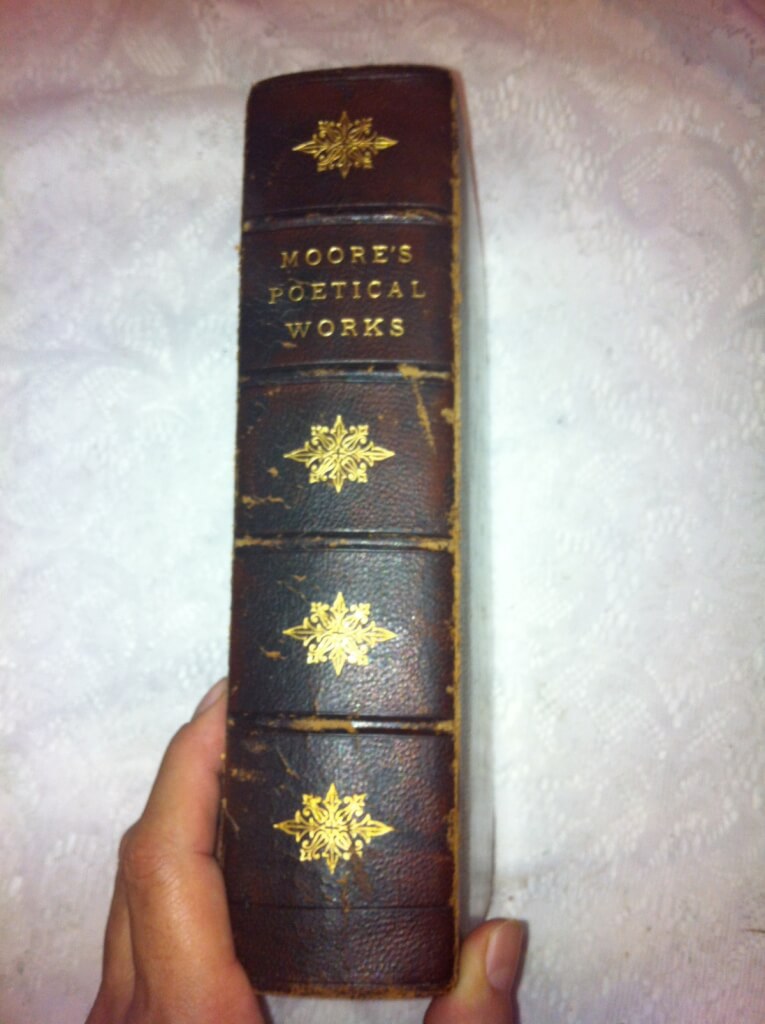
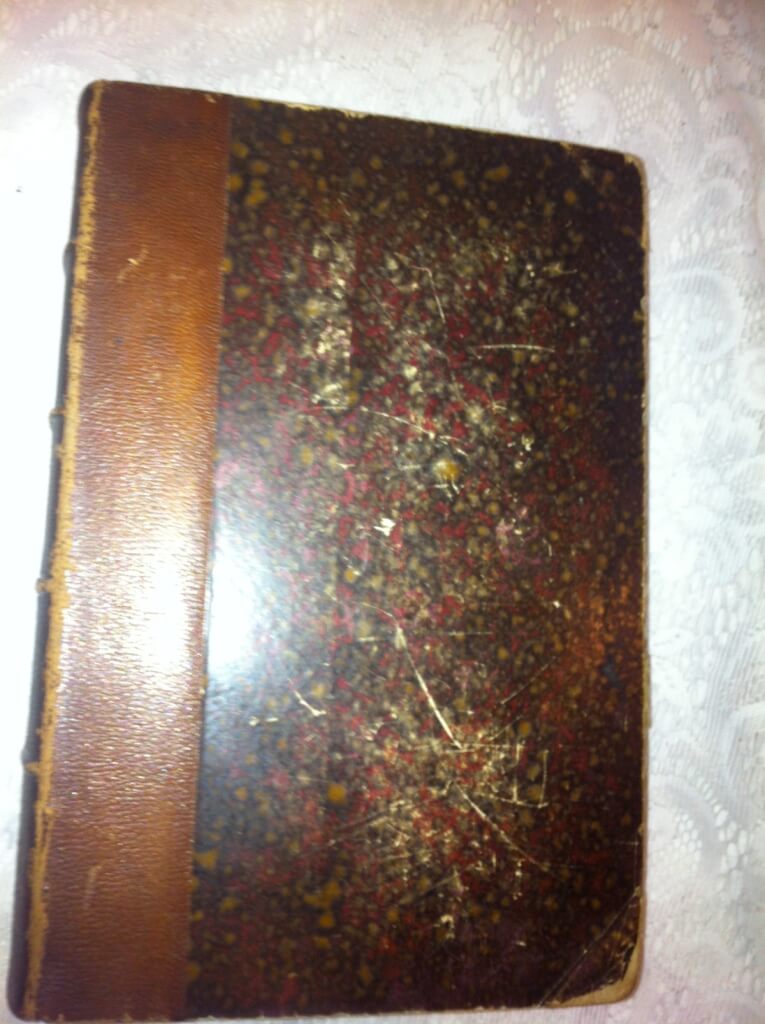 The Poetical Works of Thomas Moore, Thomas Moore (Oliver S. Felt, New York, nd. [c.1860]) 9.5" X 6.5", 776pp., half leather, 4 raised bands. 8 volumes in one. Beautiful steel engravings throughout. Fair condition, binding good, frontispiece missing. Thomas Moore (1779 - 1852) is considered Ireland's "National Bard". He was a poet, singer, songwriter, and entertainer. He was responsible, with John Murray, for burning Lord Byron's memoirs after his death.
The Poetical Works of Thomas Moore, Thomas Moore (Oliver S. Felt, New York, nd. [c.1860]) 9.5" X 6.5", 776pp., half leather, 4 raised bands. 8 volumes in one. Beautiful steel engravings throughout. Fair condition, binding good, frontispiece missing. Thomas Moore (1779 - 1852) is considered Ireland's "National Bard". He was a poet, singer, songwriter, and entertainer. He was responsible, with John Murray, for burning Lord Byron's memoirs after his death. -
 Petting as an Erotic Exercise: a study of the significance and techniques of pre-coital play, D. O. Cauldwell, M.D. (Haldeman-Julius Publications, Girard, Kansas, 1948) 5.5” x 8.5″, 32pp. pamphlet, slight sunning/soiling, very good for age, interior clean. This is one of many books written by David O. Cauldwell (1897-1959), and published by Haldeman-Julius Publications. Dr. Cauldwell was a self-described sexologist who is usually credited with being the first person to use the term 'transsexual' and 'transsexualism'. Although that claim has been widely disputed, he did write some of the first works examining transgender issues. In this pamphlet Dr. Cauldwell writes about foreplay in most all its forms and a call for the normalization of activities that were often described as perversions.
Petting as an Erotic Exercise: a study of the significance and techniques of pre-coital play, D. O. Cauldwell, M.D. (Haldeman-Julius Publications, Girard, Kansas, 1948) 5.5” x 8.5″, 32pp. pamphlet, slight sunning/soiling, very good for age, interior clean. This is one of many books written by David O. Cauldwell (1897-1959), and published by Haldeman-Julius Publications. Dr. Cauldwell was a self-described sexologist who is usually credited with being the first person to use the term 'transsexual' and 'transsexualism'. Although that claim has been widely disputed, he did write some of the first works examining transgender issues. In this pamphlet Dr. Cauldwell writes about foreplay in most all its forms and a call for the normalization of activities that were often described as perversions. -
 Petting as an Erotic Exercise: a study of the significance and techniques of pre-coital play, D. O. Cauldwell, M.D. (Haldeman-Julius Publications, Girard, Kansas, 1948) 5.5” x 8.5″, 32pp. pamphlet, slight sunning/soiling, very good for age, interior clean. This is one of many books written by David O. Cauldwell (1897-1959), and published by Haldeman-Julius Publications. Dr. Cauldwell was a self-described sexologist who is usually credited with being the first person to use the term 'transsexual' and 'transsexualism'. Although that claim has been widely disputed, he did write some of the first works examining transgender issues. In this pamphlet Dr. Cauldwell writes about foreplay in most all its forms and a call for the normalization of activities that were often described as perversions.
Petting as an Erotic Exercise: a study of the significance and techniques of pre-coital play, D. O. Cauldwell, M.D. (Haldeman-Julius Publications, Girard, Kansas, 1948) 5.5” x 8.5″, 32pp. pamphlet, slight sunning/soiling, very good for age, interior clean. This is one of many books written by David O. Cauldwell (1897-1959), and published by Haldeman-Julius Publications. Dr. Cauldwell was a self-described sexologist who is usually credited with being the first person to use the term 'transsexual' and 'transsexualism'. Although that claim has been widely disputed, he did write some of the first works examining transgender issues. In this pamphlet Dr. Cauldwell writes about foreplay in most all its forms and a call for the normalization of activities that were often described as perversions. -
 Venus in Furs, Leopold von Sacher-Masoch, trans. Fernanda Savage (Privately Printed For Subscirbers Only. 1921, [first english translation?] limited first edition thus, #1045/1225) Venus in Furs (German: Venus im Pelz) is a novella by Leopold Ritter von Sacher-Masoch (1836-1895), an Austrian writer and journalist. It is now his best known work and because of its themes the term masochism is derived from his name, coined by the Austrian psychiatrist, Krafft-Ebing. The novel was to be part of an epic series that Sacher-Masoch envisioned called Legacy of Cain. Venus in Furs was part of Love, the first volume of the series. It was published in 1870. The novel draws themes, like female dominance and sadomasochism, and character inspiration heavily from Sacher-Masoch's own life. Wanda von Dunajew, the novel's central female character, was modelled after his mistress Baroness Fanny Pistor. In December 1869 the two signed a contract making him her slave for a period of 6 months. In 1873, after the publication of Venus in Furs, Sacher-Masoch married Aurora von Rümelin who he pressured to continue the lifestyle he wrote about in his book. After 10 years they divorced. Rümelin, using the pseudonym of the books title character, "Wanda von Dunajew", wrote Meine Lebensbeichte (My Life Confession) published in 1906. It detailed Sacher-Masoch's private life and her relationship with him. During his lifetime, Sacher-Masoch was well known as a man of letters, a utopian thinker who espoused socialist and humanist ideals in his fiction and non-fiction. Most of his works remain untranslated into English. Until recently, his novel Venus in Furs was his only book commonly available in English.
Venus in Furs, Leopold von Sacher-Masoch, trans. Fernanda Savage (Privately Printed For Subscirbers Only. 1921, [first english translation?] limited first edition thus, #1045/1225) Venus in Furs (German: Venus im Pelz) is a novella by Leopold Ritter von Sacher-Masoch (1836-1895), an Austrian writer and journalist. It is now his best known work and because of its themes the term masochism is derived from his name, coined by the Austrian psychiatrist, Krafft-Ebing. The novel was to be part of an epic series that Sacher-Masoch envisioned called Legacy of Cain. Venus in Furs was part of Love, the first volume of the series. It was published in 1870. The novel draws themes, like female dominance and sadomasochism, and character inspiration heavily from Sacher-Masoch's own life. Wanda von Dunajew, the novel's central female character, was modelled after his mistress Baroness Fanny Pistor. In December 1869 the two signed a contract making him her slave for a period of 6 months. In 1873, after the publication of Venus in Furs, Sacher-Masoch married Aurora von Rümelin who he pressured to continue the lifestyle he wrote about in his book. After 10 years they divorced. Rümelin, using the pseudonym of the books title character, "Wanda von Dunajew", wrote Meine Lebensbeichte (My Life Confession) published in 1906. It detailed Sacher-Masoch's private life and her relationship with him. During his lifetime, Sacher-Masoch was well known as a man of letters, a utopian thinker who espoused socialist and humanist ideals in his fiction and non-fiction. Most of his works remain untranslated into English. Until recently, his novel Venus in Furs was his only book commonly available in English. -
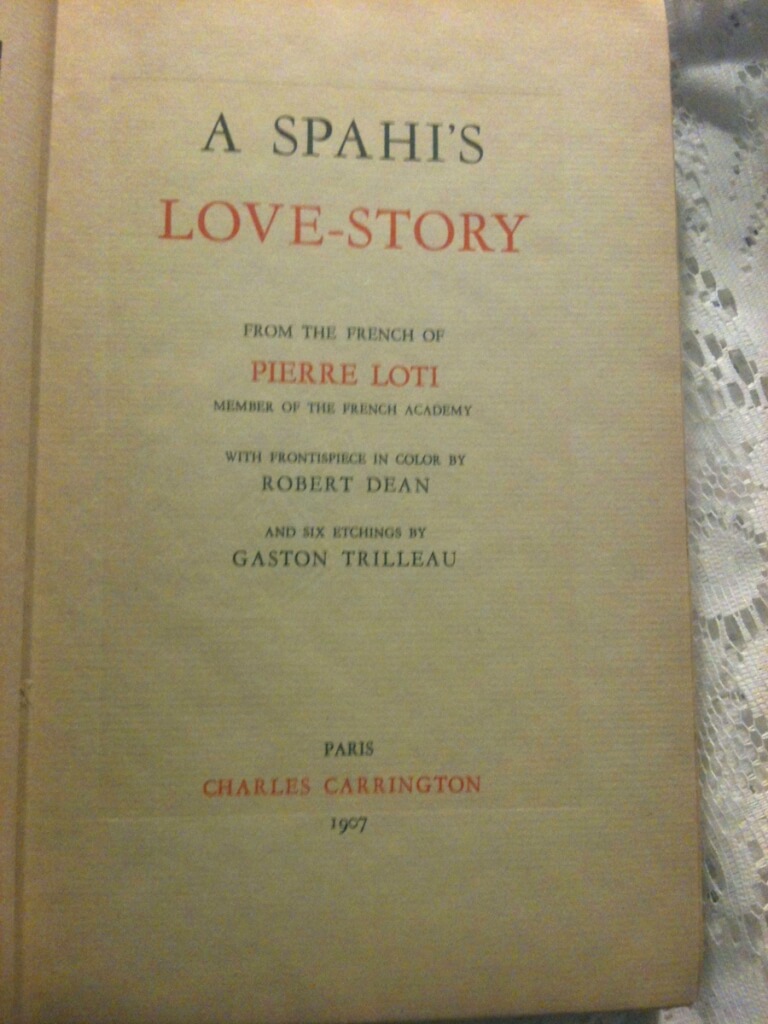
 A Spahi’s Love-Story, Pierre Loti [pseud. Julien Viaud], illus. Robert Dean, illus. Gaston Trilleau (Charles Carrington, Paris, 1907, #17/1000) 9″ x 5.75″, xii+330pp, hardbound, yellow cloth and batik design paper over boards, tipped-in color frontispiece, hand-made paper, deckled edges, good+ condition Julien Viaud (1850-1923) was a French novelist and naval officer. This his third novel (originally titled “Le Roman d’un Spahi”), was originally published in 1881. It recounts the tragic story in the dark middle ages of a Turkish soldier, who fell in love with a woman from a far away culture with a very different background. Color frontispiece by Robert Dean tipped in and six etchings by Gaston Trilleau throughout the book.
A Spahi’s Love-Story, Pierre Loti [pseud. Julien Viaud], illus. Robert Dean, illus. Gaston Trilleau (Charles Carrington, Paris, 1907, #17/1000) 9″ x 5.75″, xii+330pp, hardbound, yellow cloth and batik design paper over boards, tipped-in color frontispiece, hand-made paper, deckled edges, good+ condition Julien Viaud (1850-1923) was a French novelist and naval officer. This his third novel (originally titled “Le Roman d’un Spahi”), was originally published in 1881. It recounts the tragic story in the dark middle ages of a Turkish soldier, who fell in love with a woman from a far away culture with a very different background. Color frontispiece by Robert Dean tipped in and six etchings by Gaston Trilleau throughout the book. -
 The Golden Ass of Apuleius, Lucius Apuleius Madaurensis (124-170 AD), trans. & intro Francis D. Byrne (The Imperial Press[Charles Carrington?], London, n.d. [1904?]) 8.25" X 6.25", xlix+588pp., hardbound, blue cloth boards with paper label on spine, top edge gilt, other edges deckled, just good condition, tearing to top of spine, no illustrations present. The Metamorphoses of Apuleius, which St. Augustine referred to as “The Golden Ass”, is the only Ancient Roman novel in Latin to survive in its entirety. The plot Lucius and his curiosity and insatiable desire to see and practice magic. While trying to perform a spell to transform into a bird, he is accidentally transformed into an ass. This leads to a long journey, literal and metaphorical, filled with in-set tales. He finally finds salvation through the intervention of the goddess Isis, whose cult he joins. The date of the original work is uncertain. Scholars are not sure if he wrote it in his youth or at the end of his life. He adapted the story from a Greek story written by Lucius of Patrae, however his original Greek text has long been lost.
The Golden Ass of Apuleius, Lucius Apuleius Madaurensis (124-170 AD), trans. & intro Francis D. Byrne (The Imperial Press[Charles Carrington?], London, n.d. [1904?]) 8.25" X 6.25", xlix+588pp., hardbound, blue cloth boards with paper label on spine, top edge gilt, other edges deckled, just good condition, tearing to top of spine, no illustrations present. The Metamorphoses of Apuleius, which St. Augustine referred to as “The Golden Ass”, is the only Ancient Roman novel in Latin to survive in its entirety. The plot Lucius and his curiosity and insatiable desire to see and practice magic. While trying to perform a spell to transform into a bird, he is accidentally transformed into an ass. This leads to a long journey, literal and metaphorical, filled with in-set tales. He finally finds salvation through the intervention of the goddess Isis, whose cult he joins. The date of the original work is uncertain. Scholars are not sure if he wrote it in his youth or at the end of his life. He adapted the story from a Greek story written by Lucius of Patrae, however his original Greek text has long been lost. -
 Female Masturbation, New Illustrated Edition, G. Lombard Kelly, M.D. (Banner Books, Inglewood, Calif., 1966) 8.75" X 5.25", 192pp, softcover, good+ condition "A complete reprinting of Dr. Kelly's monograph on the subject of female auto-eroticism, as well as articles on the same subject by other well-known doctors including Edwin Hirsch, Bernhard Bauer, A. von Schrench-Notzing, J. Richardson Parke and Albert Moll."
Female Masturbation, New Illustrated Edition, G. Lombard Kelly, M.D. (Banner Books, Inglewood, Calif., 1966) 8.75" X 5.25", 192pp, softcover, good+ condition "A complete reprinting of Dr. Kelly's monograph on the subject of female auto-eroticism, as well as articles on the same subject by other well-known doctors including Edwin Hirsch, Bernhard Bauer, A. von Schrench-Notzing, J. Richardson Parke and Albert Moll." -

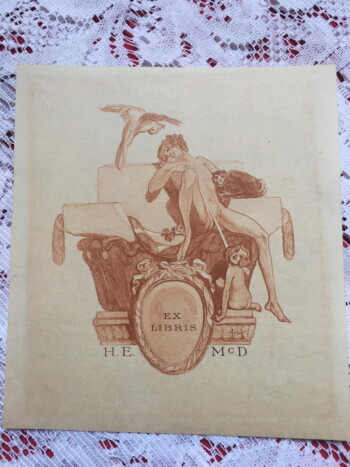 Ex Libris H.E. McD, by Franz von Bayros 4 x 4.5" red ink, previously pasted as evident by top part of back naked girl, animals, and child, presumably Ex libris for Horace E. McDonald Franz von Bayros (1866 – 1924) was an Austrian commercial artist, illustrator, and painter, now he is best known for his erotic work. He belonged to the Decadent movement in art, often utilizing erotic themes and phantasmagoric imagery. At the age 17, Bayros passed the entrance exam for the Vienna Academy with Eduard von Engerth. Bayros mixed in elegant society and soon belonged to the circle of friends of Johann Straub, whose step daughter Alice he married on 1896. The next year, Bayros moved to Munich. In 1904, Bayros gave his first exhibition in Munich, which was a great success. From 1904 until 1908, Bayros traveled to Paris and Italy for his studies. Typically, for an artist dealing with such imagery, von Bayros produced work under several pseudonyms, most notably Choisy Le Conin, and was hounded by authorities for much of his life for his “indecent” art often very imaginative, and including such taboo subjects as sadomasochism and bestiality. He became equally well-known for his masterly drawn figures of elegant modestly nude and non-nude women.
Ex Libris H.E. McD, by Franz von Bayros 4 x 4.5" red ink, previously pasted as evident by top part of back naked girl, animals, and child, presumably Ex libris for Horace E. McDonald Franz von Bayros (1866 – 1924) was an Austrian commercial artist, illustrator, and painter, now he is best known for his erotic work. He belonged to the Decadent movement in art, often utilizing erotic themes and phantasmagoric imagery. At the age 17, Bayros passed the entrance exam for the Vienna Academy with Eduard von Engerth. Bayros mixed in elegant society and soon belonged to the circle of friends of Johann Straub, whose step daughter Alice he married on 1896. The next year, Bayros moved to Munich. In 1904, Bayros gave his first exhibition in Munich, which was a great success. From 1904 until 1908, Bayros traveled to Paris and Italy for his studies. Typically, for an artist dealing with such imagery, von Bayros produced work under several pseudonyms, most notably Choisy Le Conin, and was hounded by authorities for much of his life for his “indecent” art often very imaginative, and including such taboo subjects as sadomasochism and bestiality. He became equally well-known for his masterly drawn figures of elegant modestly nude and non-nude women. -
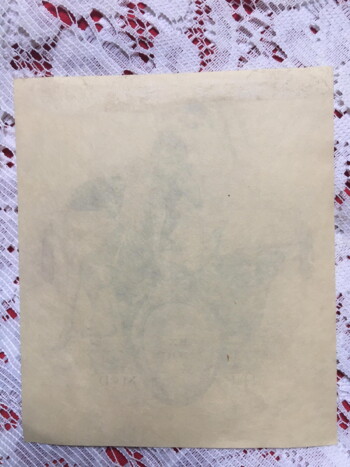
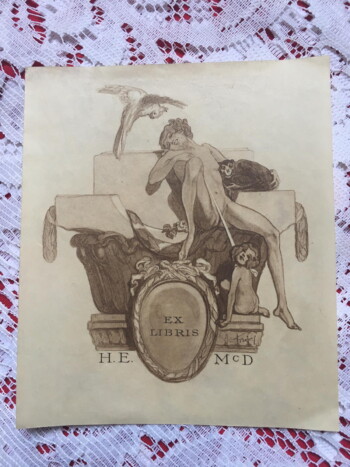 Ex Libris H.E. McD, by Franz von Bayros 4 x 4.5" brown/black ink, previously pasted as evident by top part of back naked girl, animals, and child, presumably Ex libris for Horace E. McDonald Franz von Bayros (1866 – 1924) was an Austrian commercial artist, illustrator, and painter, now he is best known for his erotic work. He belonged to the Decadent movement in art, often utilizing erotic themes and phantasmagoric imagery. At the age 17, Bayros passed the entrance exam for the Vienna Academy with Eduard von Engerth. Bayros mixed in elegant society and soon belonged to the circle of friends of Johann Straub, whose step daughter Alice he married on 1896. The next year, Bayros moved to Munich. In 1904, Bayros gave his first exhibition in Munich, which was a great success. From 1904 until 1908, Bayros traveled to Paris and Italy for his studies. Typically, for an artist dealing with such imagery, von Bayros produced work under several pseudonyms, most notably Choisy Le Conin, and was hounded by authorities for much of his life for his “indecent” art often very imaginative, and including such taboo subjects as sadomasochism and bestiality. He became equally well-known for his masterly drawn figures of elegant modestly nude and non-nude women.
Ex Libris H.E. McD, by Franz von Bayros 4 x 4.5" brown/black ink, previously pasted as evident by top part of back naked girl, animals, and child, presumably Ex libris for Horace E. McDonald Franz von Bayros (1866 – 1924) was an Austrian commercial artist, illustrator, and painter, now he is best known for his erotic work. He belonged to the Decadent movement in art, often utilizing erotic themes and phantasmagoric imagery. At the age 17, Bayros passed the entrance exam for the Vienna Academy with Eduard von Engerth. Bayros mixed in elegant society and soon belonged to the circle of friends of Johann Straub, whose step daughter Alice he married on 1896. The next year, Bayros moved to Munich. In 1904, Bayros gave his first exhibition in Munich, which was a great success. From 1904 until 1908, Bayros traveled to Paris and Italy for his studies. Typically, for an artist dealing with such imagery, von Bayros produced work under several pseudonyms, most notably Choisy Le Conin, and was hounded by authorities for much of his life for his “indecent” art often very imaginative, and including such taboo subjects as sadomasochism and bestiality. He became equally well-known for his masterly drawn figures of elegant modestly nude and non-nude women. -
Out of stock
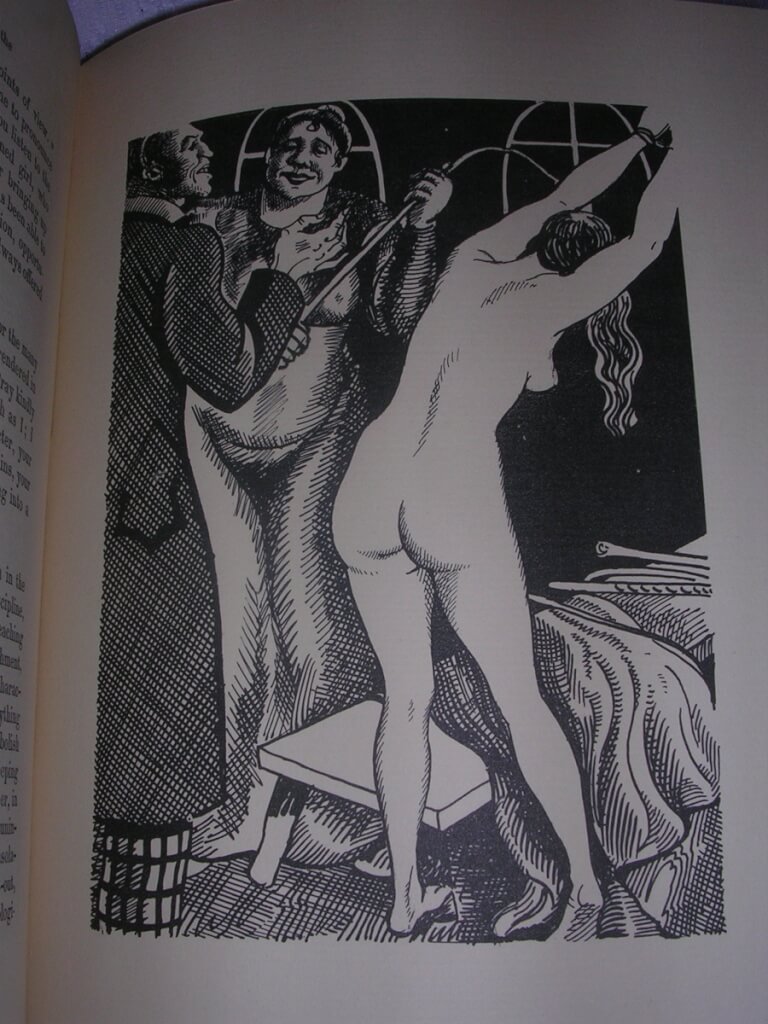 Nell in Bridewell (Lenchen im Zuchthause): Description of the System of Corporal Punishment (Flagellation) in the Female Prisons of South Germany up to the year 1848; a contribution to the history of manners., W. Reinhard, trans. W.C. Costello Ph. D. and A. R. Allinson M. A. (Psych Press [New York], 1932) 9 5/8" X 6 1/2", 326pp, hardbound, black cloth spine over orange cloth boards, gilt lettering and bands on spine, fore and bottom edge deckle, just good condition, soiling and rubbing on front cover, interior clean, some pages unopened, ex libris Joe H. and Bertha M. Shryock Although the title suggests that this is a "study", it goes beyond the facts and delves into the minds of those who are doing the punishing and those who are being humiliated and punished. Publishers of these "flagellation novels" would often lesson their liability by representing their books as academic studies. Often they would go unnoticed by the larger community unaware of the erotic nature of such a book to a certain segment of the public. In this book, Nell describes in graphic terms the merciless floggings she witnessed of girls and young women, as well as of boys and men and confesses to disturbingly confusing emotions that such sights occasioned in her. She recalls the lustful expressions on the faces of the onlookers, records the fervent words of gratitude to the skillful flogger from the lips of grand ladies who "were only too delighted to see such girls whipped", and tells of the evidently sensual appetites such cruelties incited in the torturers. This edition is a facsimile reprint of Carrington's 1900 translation. Added to it are very nice illustrations [woodcuts?] by an unknown artist.
Nell in Bridewell (Lenchen im Zuchthause): Description of the System of Corporal Punishment (Flagellation) in the Female Prisons of South Germany up to the year 1848; a contribution to the history of manners., W. Reinhard, trans. W.C. Costello Ph. D. and A. R. Allinson M. A. (Psych Press [New York], 1932) 9 5/8" X 6 1/2", 326pp, hardbound, black cloth spine over orange cloth boards, gilt lettering and bands on spine, fore and bottom edge deckle, just good condition, soiling and rubbing on front cover, interior clean, some pages unopened, ex libris Joe H. and Bertha M. Shryock Although the title suggests that this is a "study", it goes beyond the facts and delves into the minds of those who are doing the punishing and those who are being humiliated and punished. Publishers of these "flagellation novels" would often lesson their liability by representing their books as academic studies. Often they would go unnoticed by the larger community unaware of the erotic nature of such a book to a certain segment of the public. In this book, Nell describes in graphic terms the merciless floggings she witnessed of girls and young women, as well as of boys and men and confesses to disturbingly confusing emotions that such sights occasioned in her. She recalls the lustful expressions on the faces of the onlookers, records the fervent words of gratitude to the skillful flogger from the lips of grand ladies who "were only too delighted to see such girls whipped", and tells of the evidently sensual appetites such cruelties incited in the torturers. This edition is a facsimile reprint of Carrington's 1900 translation. Added to it are very nice illustrations [woodcuts?] by an unknown artist. -
Out of stock

 2.25" x 2.75" Shackle Antique hand-forged iron shackles from a farm in Bulgaria. They have been cleaned up and seasoned much like you'd season your cast iron skillet (repeatedly coated with oil and baked). No key is needed as they lock using a puzzle design.
2.25" x 2.75" Shackle Antique hand-forged iron shackles from a farm in Bulgaria. They have been cleaned up and seasoned much like you'd season your cast iron skillet (repeatedly coated with oil and baked). No key is needed as they lock using a puzzle design. -
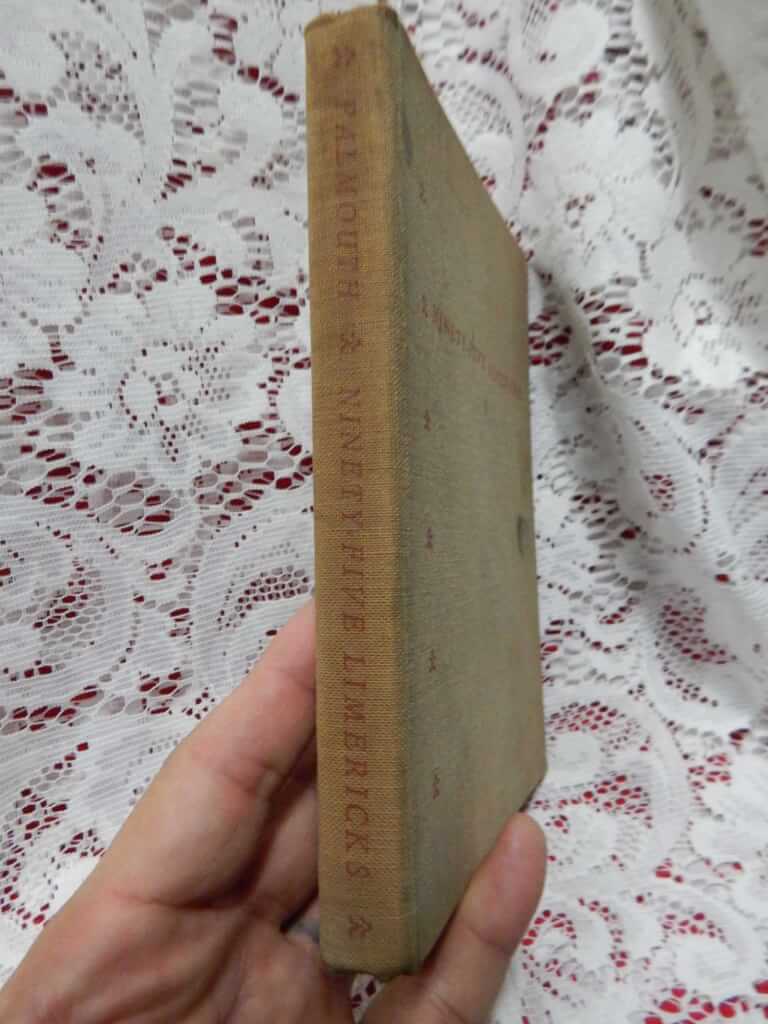
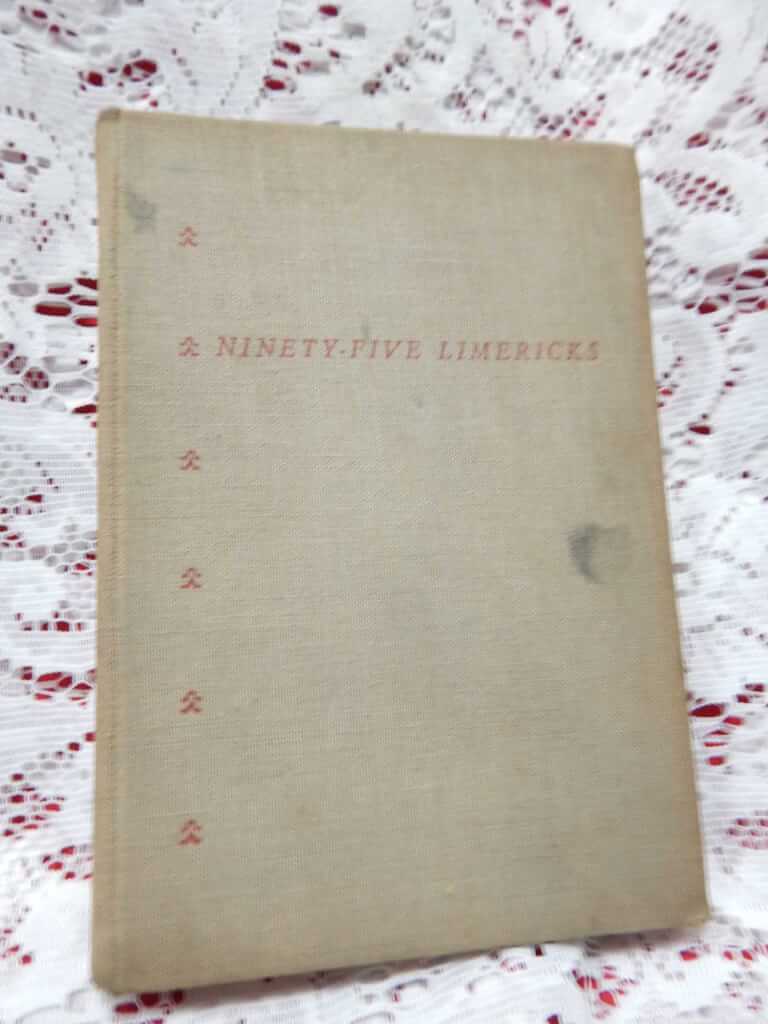 Ninety-Five Limericks | A Contribution to the Folk Lore of our Time | Collected and Edited by John Falmouth (The Limerick Press, Suffern, NY, 1932) 5"x7.25", unpaginated, tan cloth boards with red lettering and decorations, some soiling on boards, interior good, previous owner added a limerick about a young man from Calcutta in the end pages. Mr. Falmouth has a 6 page forward where he discusses the phallic nature of the limerick (with diagrams). A fun little book even though the profanity is exed out.
Ninety-Five Limericks | A Contribution to the Folk Lore of our Time | Collected and Edited by John Falmouth (The Limerick Press, Suffern, NY, 1932) 5"x7.25", unpaginated, tan cloth boards with red lettering and decorations, some soiling on boards, interior good, previous owner added a limerick about a young man from Calcutta in the end pages. Mr. Falmouth has a 6 page forward where he discusses the phallic nature of the limerick (with diagrams). A fun little book even though the profanity is exed out. -
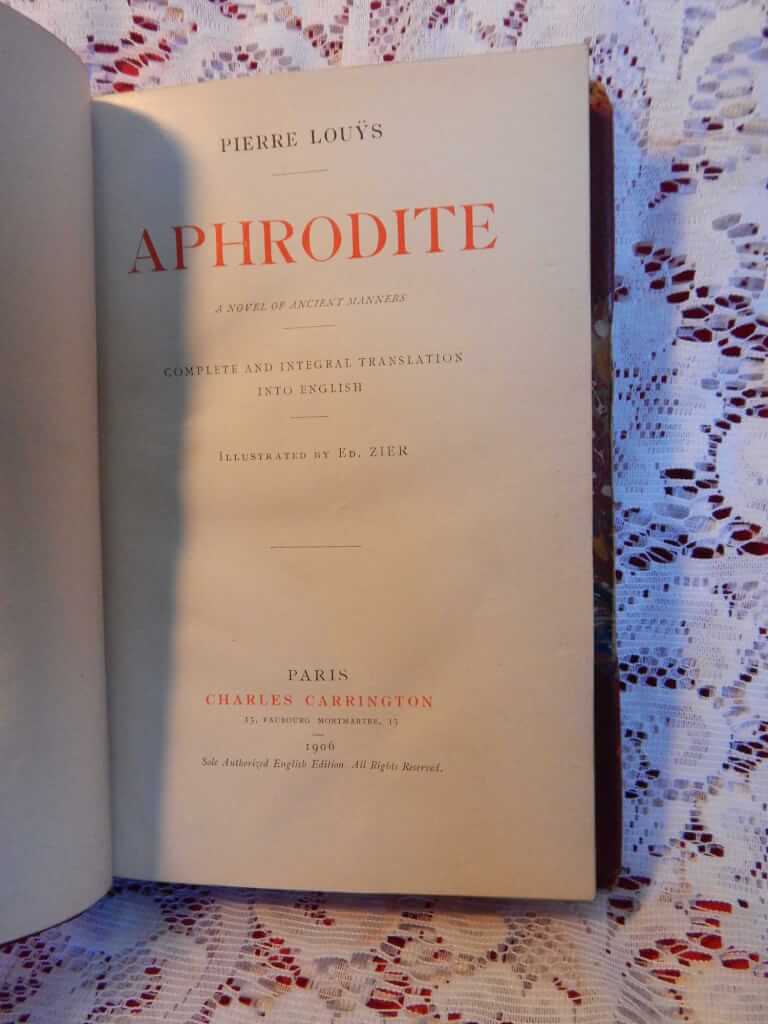
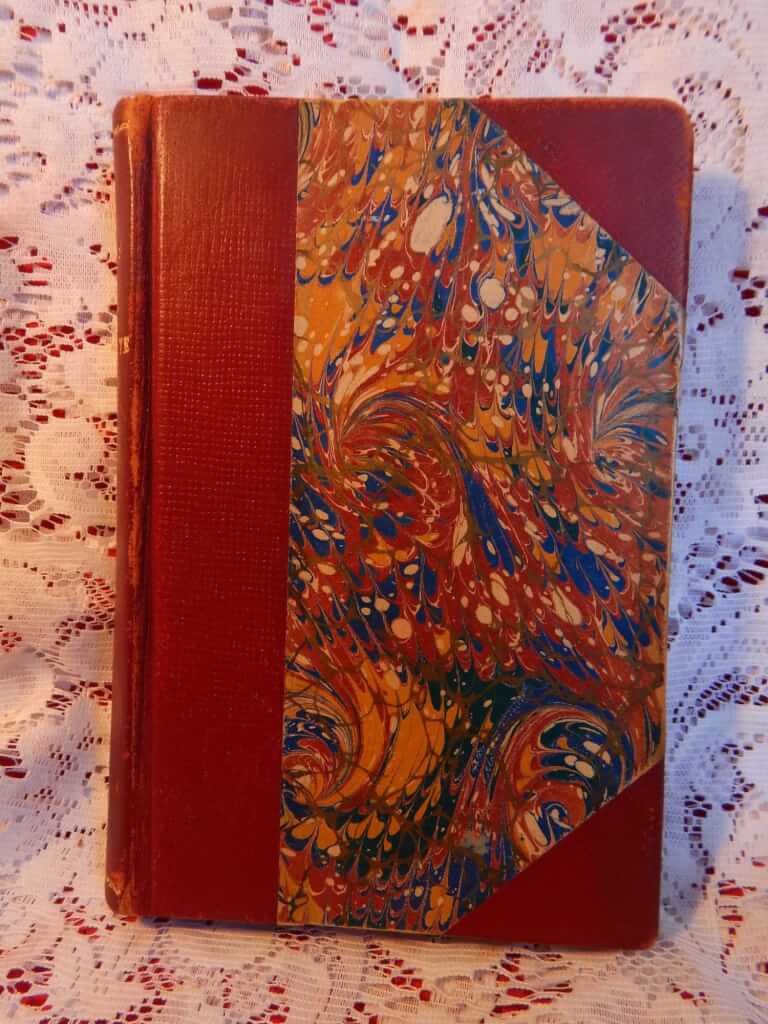 Aphrodite, a novel of ancient manners, by Pierre Louÿs, illus. Ed. Zier (Charles Carrington, 1906, first edition thus, first English translation) 5.25 x 8", 412pp, marbled boards with three quarter red cloth, gilt lettering and decoration on spine, very good condition for age, some slight bumping/scuffing Pierre Louys (1870 - 1925) was a French poet and writer, most renowned for lesbian and classical themes in some of his writings. He is known as a writer who "expressed pagan sensuality with stylistic perfection." "Aphrodite: mæurs antiques" (Ancient Manners) is a "libertine" story set in ancient Alexandria. Highlights include the loves of Chrysis, an orgy banquet ending in the crucifixion of a slave, the love of two young musician girls and the festivals of Aphrodite. "This Translation of Aphrodite was executed on the Printing Presses of Charles Herissey, at Evreux (France), for Mr. Charles Carrington, Paris, Bookseller et Publisher, and is the only complete English version extant." Édouard François Zier, (1856-1924) was a French illustrator and painter.
Aphrodite, a novel of ancient manners, by Pierre Louÿs, illus. Ed. Zier (Charles Carrington, 1906, first edition thus, first English translation) 5.25 x 8", 412pp, marbled boards with three quarter red cloth, gilt lettering and decoration on spine, very good condition for age, some slight bumping/scuffing Pierre Louys (1870 - 1925) was a French poet and writer, most renowned for lesbian and classical themes in some of his writings. He is known as a writer who "expressed pagan sensuality with stylistic perfection." "Aphrodite: mæurs antiques" (Ancient Manners) is a "libertine" story set in ancient Alexandria. Highlights include the loves of Chrysis, an orgy banquet ending in the crucifixion of a slave, the love of two young musician girls and the festivals of Aphrodite. "This Translation of Aphrodite was executed on the Printing Presses of Charles Herissey, at Evreux (France), for Mr. Charles Carrington, Paris, Bookseller et Publisher, and is the only complete English version extant." Édouard François Zier, (1856-1924) was a French illustrator and painter. -
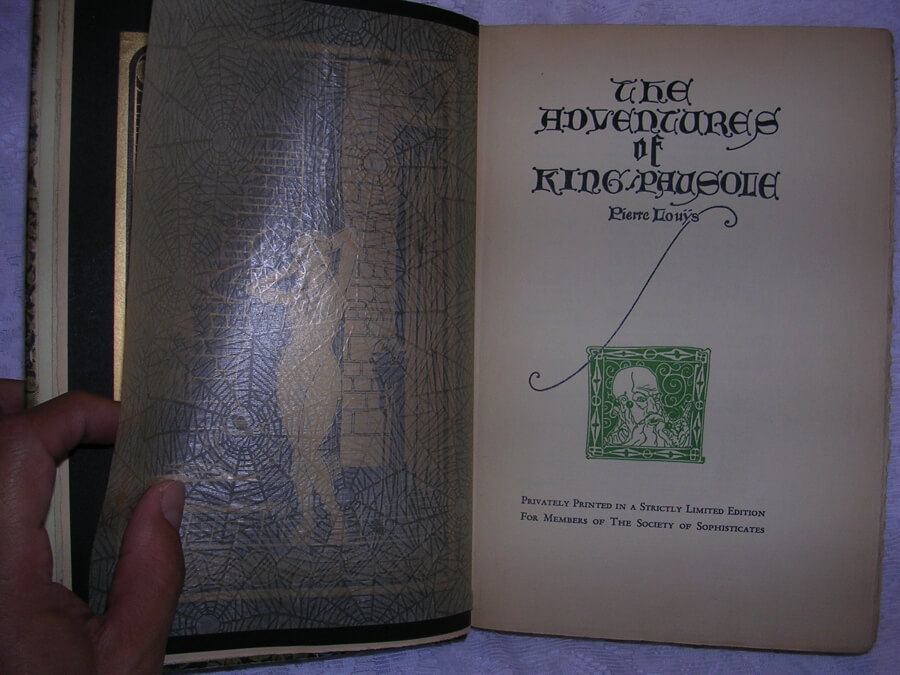
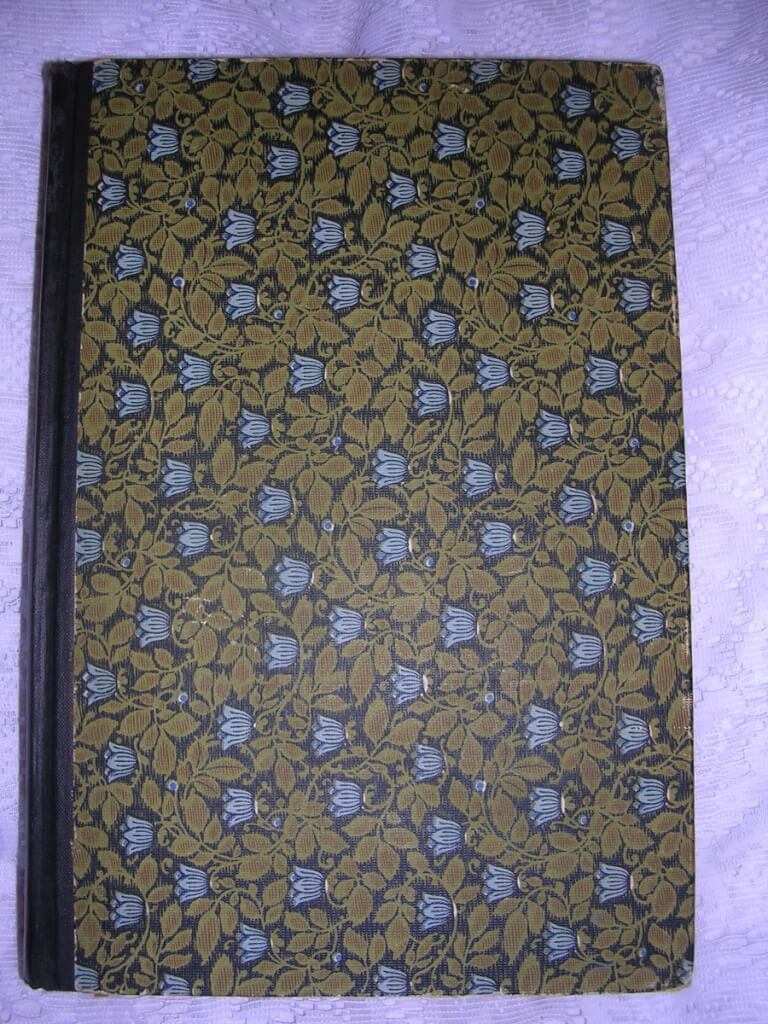 The Adventures of King Pausole, Pierre Louys, ilustrated by Lotan Welshans ("Privately Printed in a Strictly Limited Edition for Members of The Society of Sophisticates", no date, [c. 1927, the date of the illustrations], [first edition thus]) 9 5/8" X 6 5/8", 305pp, hardbound, no dust jacket, boards green floral pattern, gilt lettering and designs on spine, top edge gilted, other edges deckle, good condition. Pierre Louys (1870 - 1925) was a French poet and writer, most renowned for lesbian and classical themes in some of his writings. He is known as a writer who "expressed pagan sensuality with stylistic perfection." This book is a humorous and risqué "libertine" story about a king with many wives (one for each day of the year). As part of the story, King Pausole had two laws "1. harm no man. 2. Then do as you please." Spider-webb-patterned tissue coverings on the nine exotic and sensuous plates (gilt on black paper tipped in), by Lotan Weshans.
The Adventures of King Pausole, Pierre Louys, ilustrated by Lotan Welshans ("Privately Printed in a Strictly Limited Edition for Members of The Society of Sophisticates", no date, [c. 1927, the date of the illustrations], [first edition thus]) 9 5/8" X 6 5/8", 305pp, hardbound, no dust jacket, boards green floral pattern, gilt lettering and designs on spine, top edge gilted, other edges deckle, good condition. Pierre Louys (1870 - 1925) was a French poet and writer, most renowned for lesbian and classical themes in some of his writings. He is known as a writer who "expressed pagan sensuality with stylistic perfection." This book is a humorous and risqué "libertine" story about a king with many wives (one for each day of the year). As part of the story, King Pausole had two laws "1. harm no man. 2. Then do as you please." Spider-webb-patterned tissue coverings on the nine exotic and sensuous plates (gilt on black paper tipped in), by Lotan Weshans. -
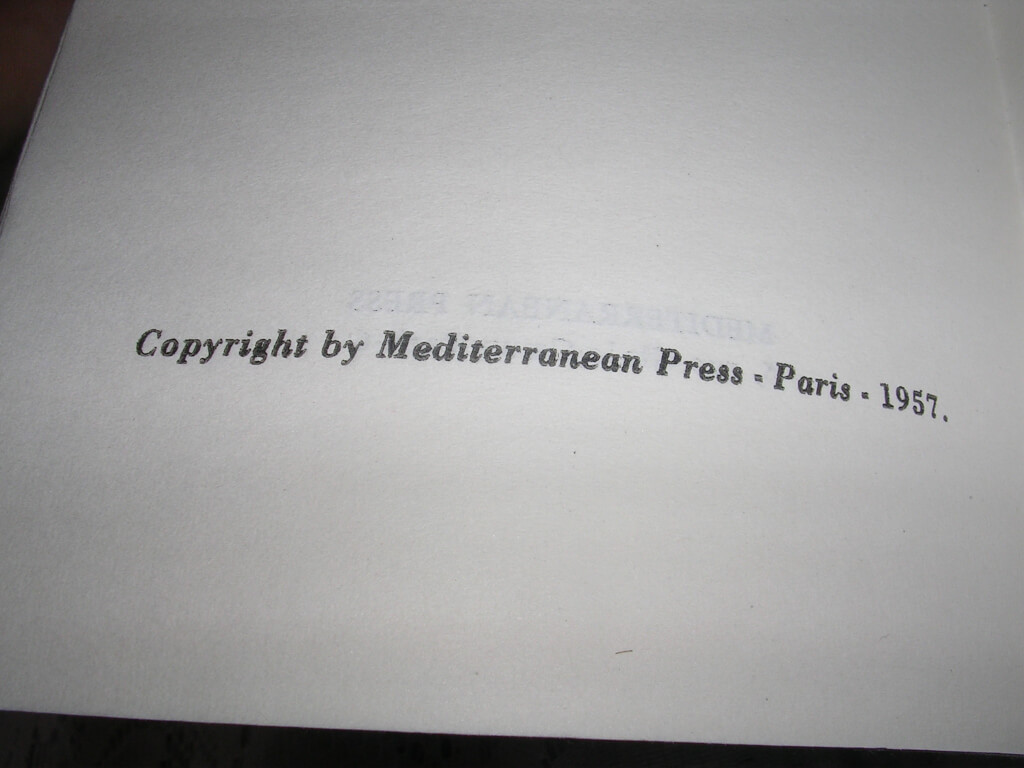
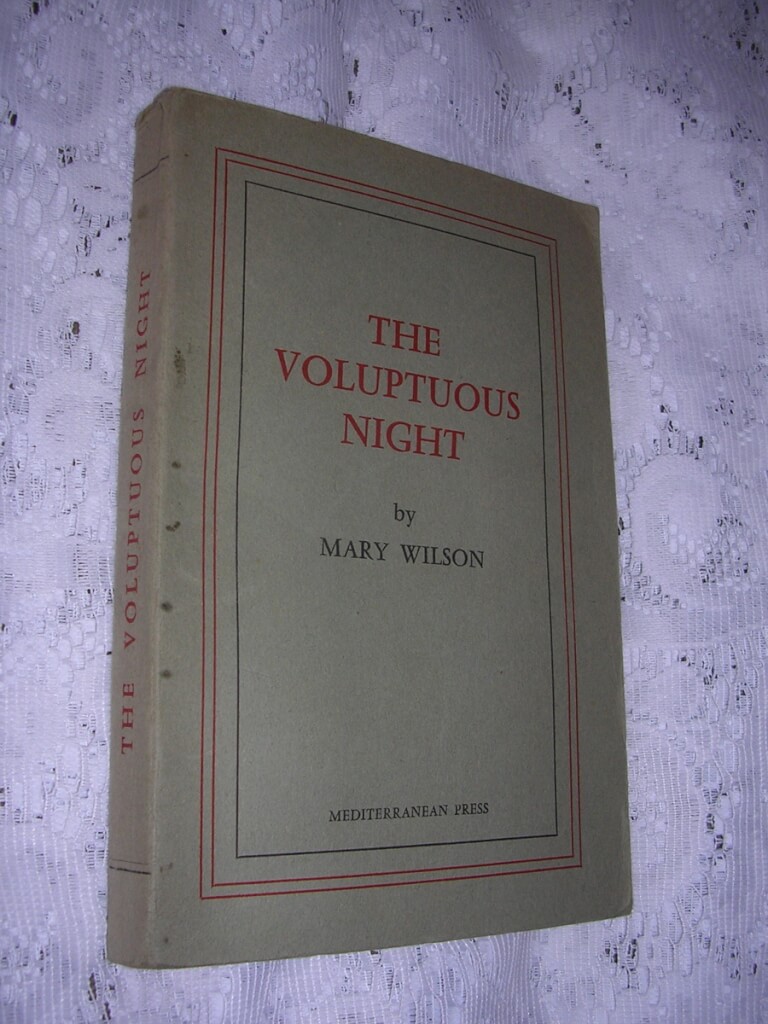 The Voluptuous Night, Mary Wilson (Mediterranean Press, Paris, 1957) 6 3/4" X 4 5/8", 167pp, soft bound, good condition, some soiling on covers According to James Campbell Reddie, this book is a translation of "La Nuit Merveilleuse" (a pornographic version of Vivant Demon's story "Point de Lendemain", 1777). It was published by various people including George Cannon c. 1830. This edition is a paperback from Paris in 1957. The back cover reads "Not to be imported into the United Kingdom or the U.S.A"
The Voluptuous Night, Mary Wilson (Mediterranean Press, Paris, 1957) 6 3/4" X 4 5/8", 167pp, soft bound, good condition, some soiling on covers According to James Campbell Reddie, this book is a translation of "La Nuit Merveilleuse" (a pornographic version of Vivant Demon's story "Point de Lendemain", 1777). It was published by various people including George Cannon c. 1830. This edition is a paperback from Paris in 1957. The back cover reads "Not to be imported into the United Kingdom or the U.S.A" -
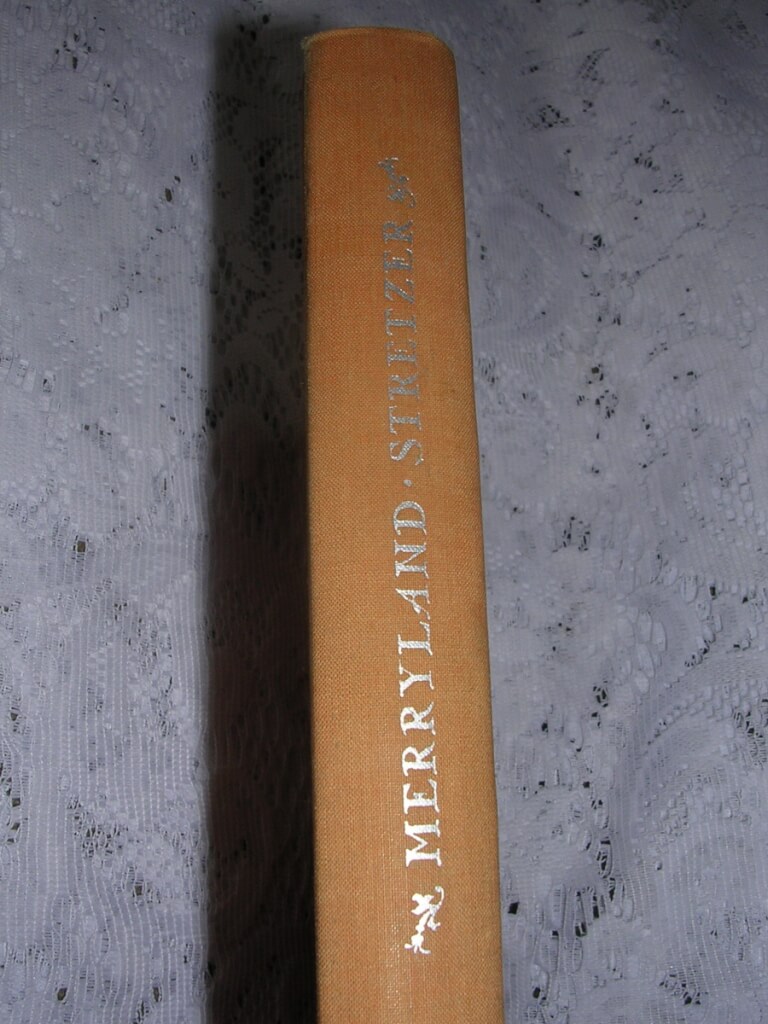
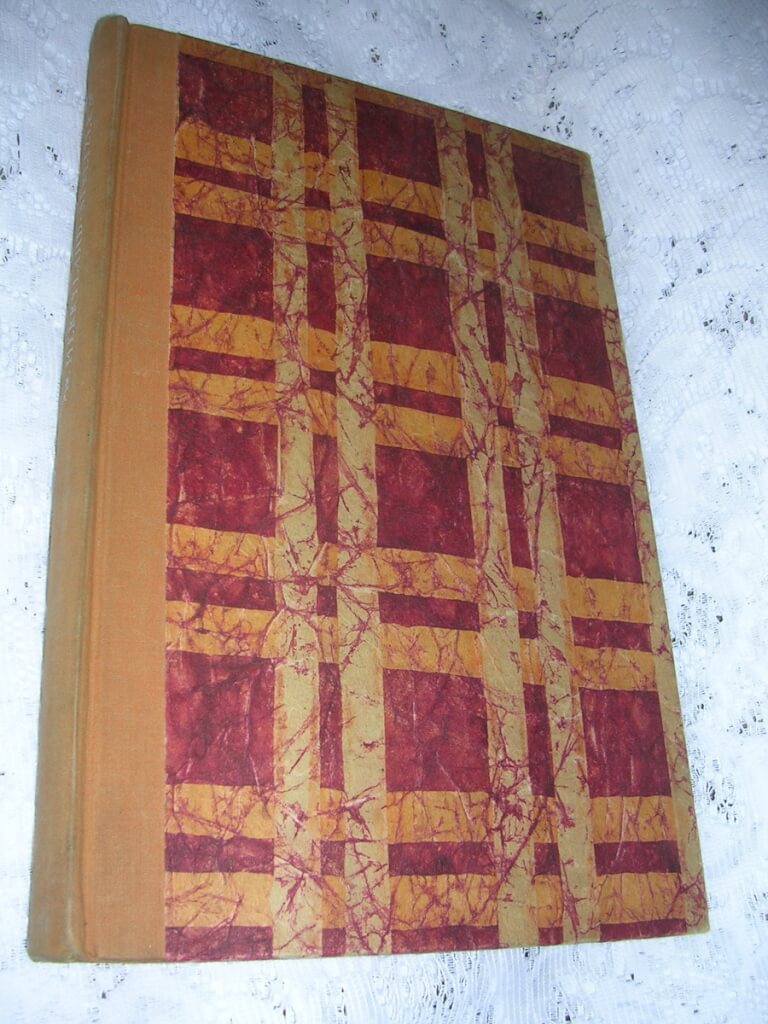 Merryland, Thomas Stretzer (Privately Issued, New York, Robin Hood House, 1932) 9 3/8" X 6 1/8", 136pp, hardbound no DJ, decorative paper boards, silver gilt lettering on spine, very good condition The Merryland books were a somewhat peculiar genre of English seventeenth and eighteenth century erotic fiction in which the female body was described in terms of a topographical metaphor derived from a pun on Maryland. Stretzer's book is typical of the genre in depicting the female body as a landscape that men explore, till, and plow. For example, he writes: "Her valleys are like Eden, her hills like Lebanon, she is a paradise of pleasure and a garden of delight."
Merryland, Thomas Stretzer (Privately Issued, New York, Robin Hood House, 1932) 9 3/8" X 6 1/8", 136pp, hardbound no DJ, decorative paper boards, silver gilt lettering on spine, very good condition The Merryland books were a somewhat peculiar genre of English seventeenth and eighteenth century erotic fiction in which the female body was described in terms of a topographical metaphor derived from a pun on Maryland. Stretzer's book is typical of the genre in depicting the female body as a landscape that men explore, till, and plow. For example, he writes: "Her valleys are like Eden, her hills like Lebanon, she is a paradise of pleasure and a garden of delight." -
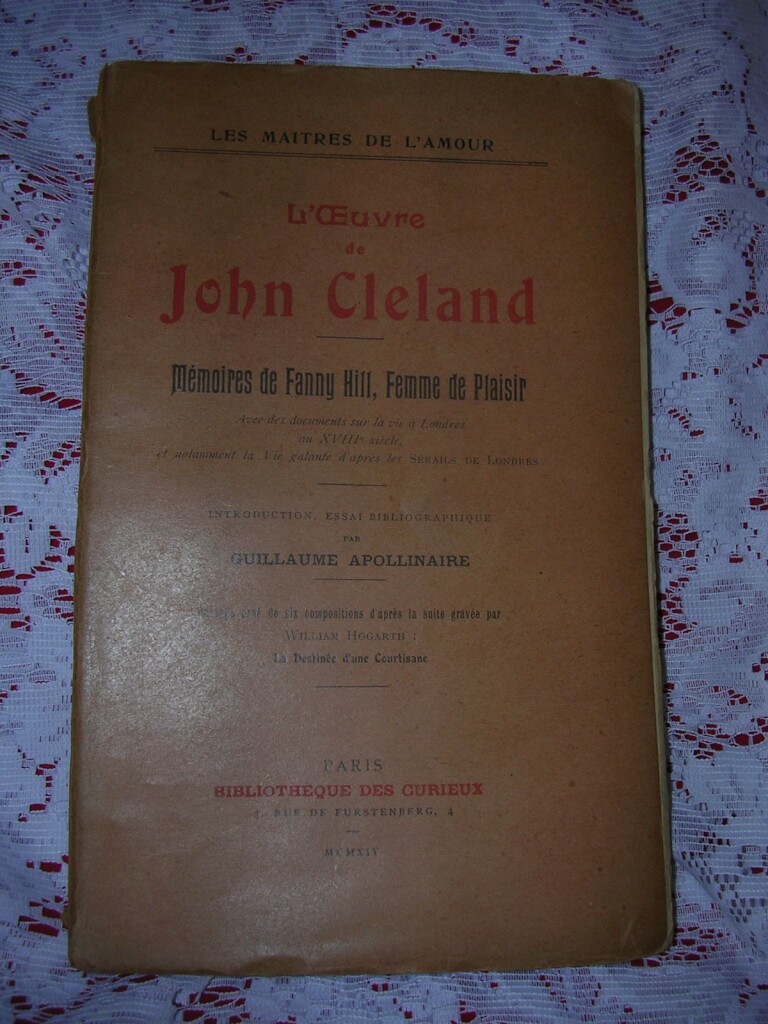
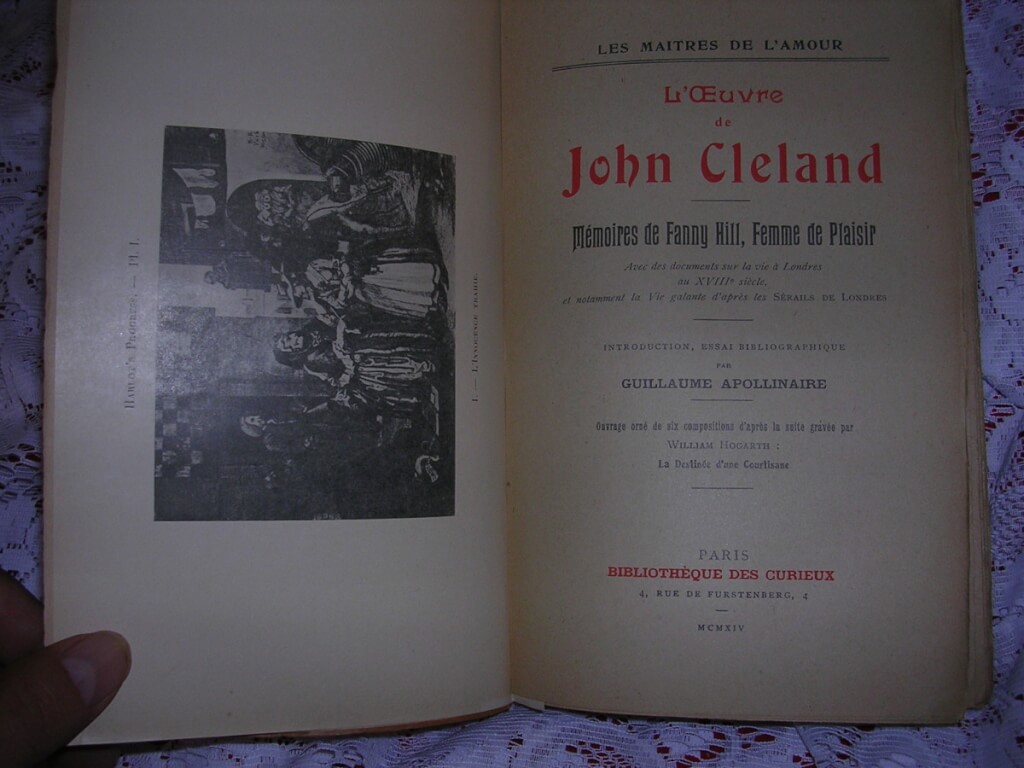 Mémoires de Fanny Hill, Femme de Plaisir, John Cleland (Bibliothèque Des Curieux, Paris, 1914) 9" X 5 5/8", 281pp, soft bound, deckle edges, many pages uncut/unread, "decorated with six compositions from the series of engravings by William Hogarth: La Destin_e d'une Courtisane", fair condition, good considering it's age, pages yellow and small rips near spine Written while the author was in debtor's prison in London and first published in 1749, Fanny Hill is considered the first original English prose pornography, and the first pornography to use the form of the novel. One of the most prosecuted and banned books in history, it has become a synonym for obscenity. This book appeared as a part of a series "Les Maitres de l'amour" (The Masters of Love). "With documents about life in London in the eighteenth century, including Life after the gallant Serails of London, Introduction and bibliography by Guillaume Apollinaire"
Mémoires de Fanny Hill, Femme de Plaisir, John Cleland (Bibliothèque Des Curieux, Paris, 1914) 9" X 5 5/8", 281pp, soft bound, deckle edges, many pages uncut/unread, "decorated with six compositions from the series of engravings by William Hogarth: La Destin_e d'une Courtisane", fair condition, good considering it's age, pages yellow and small rips near spine Written while the author was in debtor's prison in London and first published in 1749, Fanny Hill is considered the first original English prose pornography, and the first pornography to use the form of the novel. One of the most prosecuted and banned books in history, it has become a synonym for obscenity. This book appeared as a part of a series "Les Maitres de l'amour" (The Masters of Love). "With documents about life in London in the eighteenth century, including Life after the gallant Serails of London, Introduction and bibliography by Guillaume Apollinaire" -
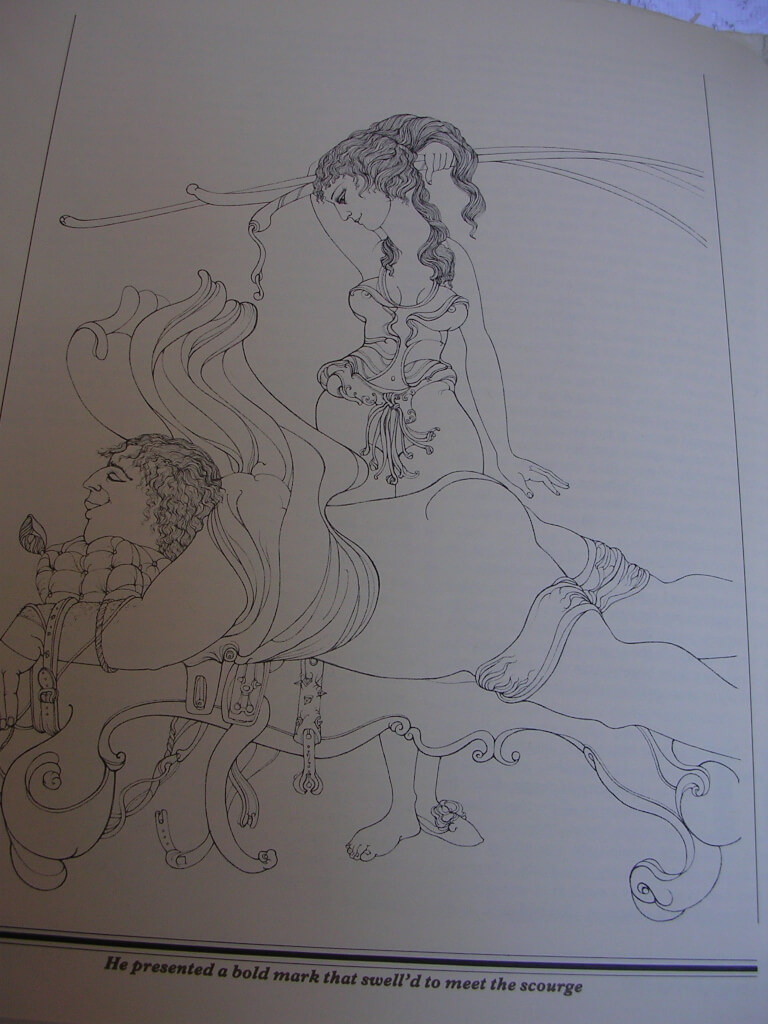
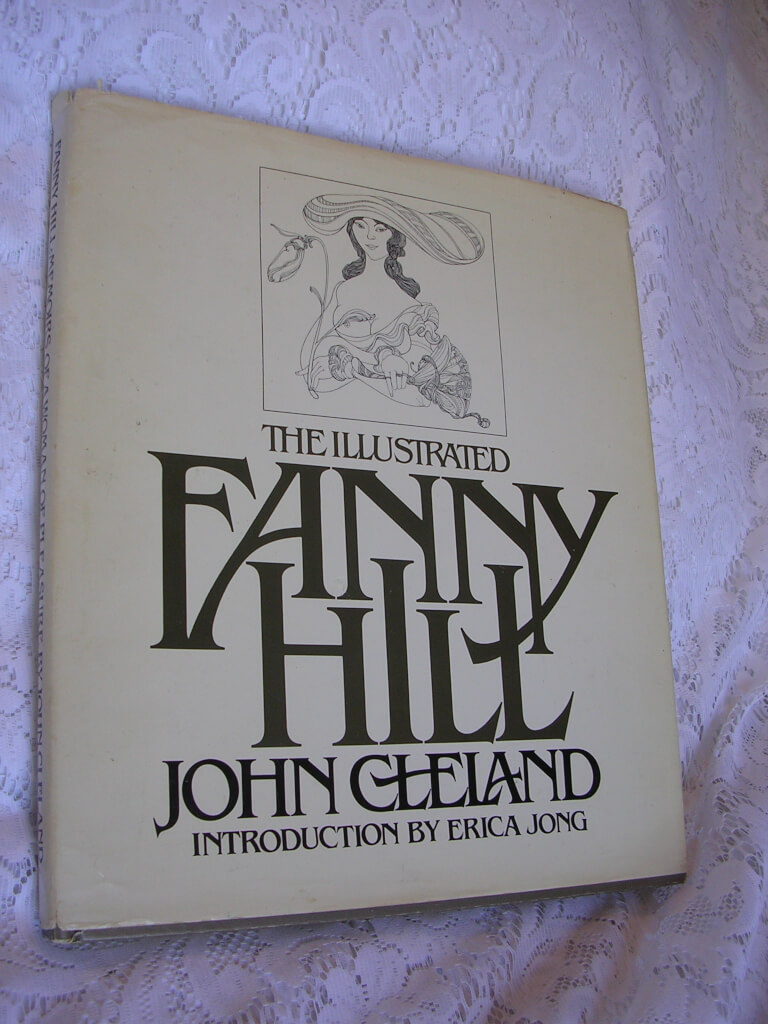 The Illustrated Fanny Hill, John Cleland, illustrated by Zevi Blum, introduction written by Erica Jong, designed by Herb Lubalin (The Erotic Artbook Society [Ralph Ginzburg], 1978, first edition thus, stated "NE PLUS EDITION") 12.5" X 10.5", 127pp, hardbound with DJ, very good condition, minor tears to dust jacket Written while the author was in debtor's prison in London and first published in 1748, Fanny Hill is considered the first original English prose pornography, and the first pornography to use the form of the novel. One of the most prosecuted and banned books in history, it has become a synonym for obscenity. Dust Jacket shows some wear but in good condition. This copy is an excellent and beautiful "legal" (meaning post-1966 Supreme Court Case) edition of Fanny Hill. It was published by Ralph Ginzburg (Eros Magazine, Fact Magazine, served 8 months of a 5 year prison term for obscenity). The illustrations are beautifully done and have a psychedelic feel to them.
The Illustrated Fanny Hill, John Cleland, illustrated by Zevi Blum, introduction written by Erica Jong, designed by Herb Lubalin (The Erotic Artbook Society [Ralph Ginzburg], 1978, first edition thus, stated "NE PLUS EDITION") 12.5" X 10.5", 127pp, hardbound with DJ, very good condition, minor tears to dust jacket Written while the author was in debtor's prison in London and first published in 1748, Fanny Hill is considered the first original English prose pornography, and the first pornography to use the form of the novel. One of the most prosecuted and banned books in history, it has become a synonym for obscenity. Dust Jacket shows some wear but in good condition. This copy is an excellent and beautiful "legal" (meaning post-1966 Supreme Court Case) edition of Fanny Hill. It was published by Ralph Ginzburg (Eros Magazine, Fact Magazine, served 8 months of a 5 year prison term for obscenity). The illustrations are beautifully done and have a psychedelic feel to them. -
Out of stock
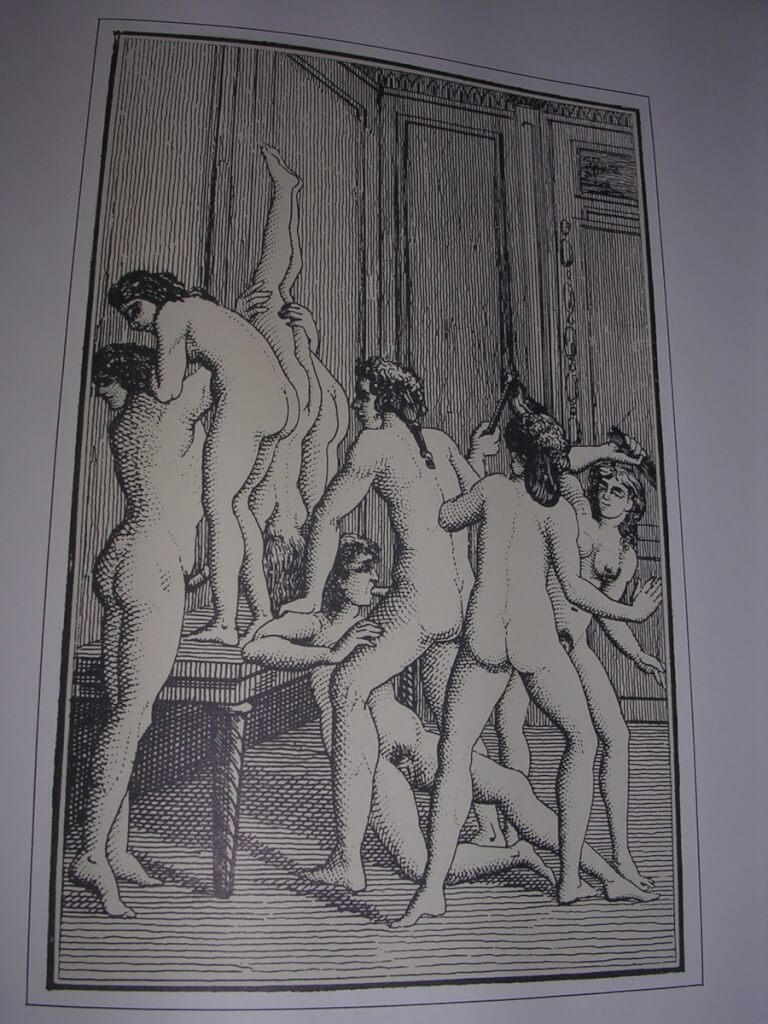
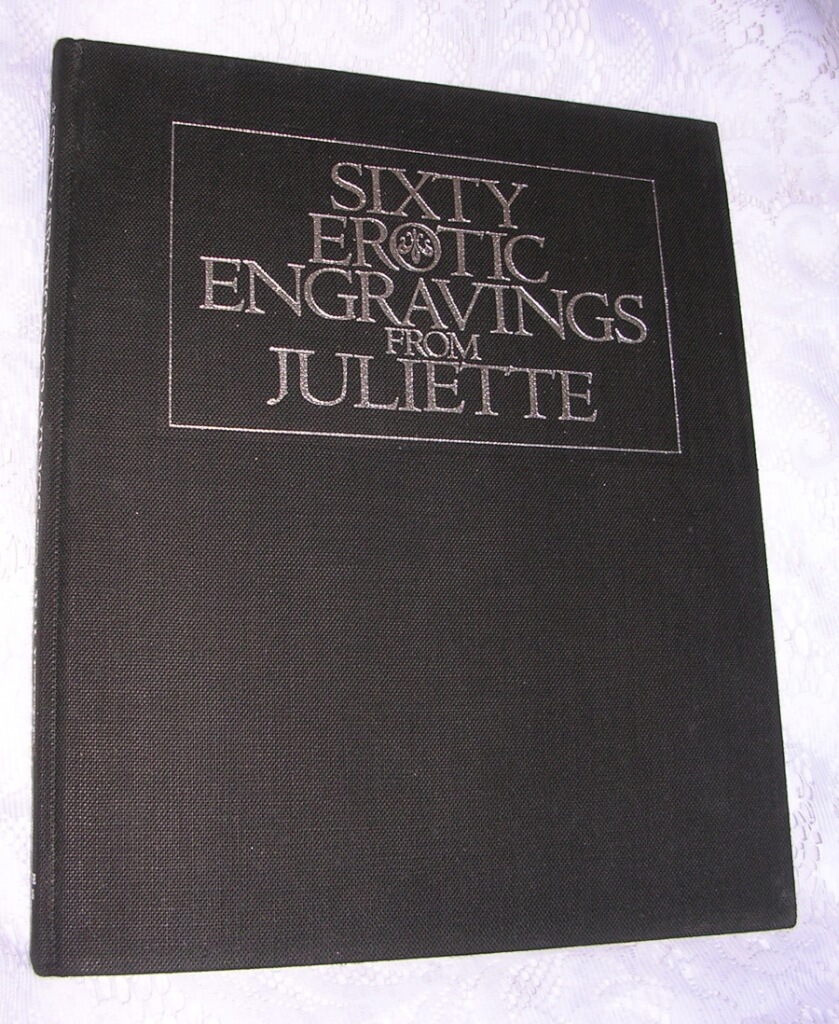 SIXTY EROTIC ENGRAVINGS FROM JULIETTE, Marquise De Sade (Grove Press, Inc., New York, 1969 [first printing]) 11 3/8" X 9 1/2", 60pp, hardback no DJ, good condition 1797 The Marquis de Sade published "Justine, or the Misfortunes of Virtue" and "Juliette or the Prosperity of Vice" (or "vice amply rewarded") together forming 10 volumes of nearly 4000 pages in total; publication was completed in 1801 and included around 100 very explicit engravings. Napoleon Bonaparte ordered the arrest of the anonymous author of Justine and Juliette, and as a result Sade was incarcerated for the last 13 years of his life. Napoleon called the work "the most abominable book ever engendered by the most depraved imagination". Justine and Juliette were published sporadically from the 19th century into the mid 20th century but mostly without any of the engravings from the original. The engravings which appear in this book were reproduced from a copy of that famous 1797 Holland edition. This publication marks the first legal printing of these engravings in the US.
SIXTY EROTIC ENGRAVINGS FROM JULIETTE, Marquise De Sade (Grove Press, Inc., New York, 1969 [first printing]) 11 3/8" X 9 1/2", 60pp, hardback no DJ, good condition 1797 The Marquis de Sade published "Justine, or the Misfortunes of Virtue" and "Juliette or the Prosperity of Vice" (or "vice amply rewarded") together forming 10 volumes of nearly 4000 pages in total; publication was completed in 1801 and included around 100 very explicit engravings. Napoleon Bonaparte ordered the arrest of the anonymous author of Justine and Juliette, and as a result Sade was incarcerated for the last 13 years of his life. Napoleon called the work "the most abominable book ever engendered by the most depraved imagination". Justine and Juliette were published sporadically from the 19th century into the mid 20th century but mostly without any of the engravings from the original. The engravings which appear in this book were reproduced from a copy of that famous 1797 Holland edition. This publication marks the first legal printing of these engravings in the US. -
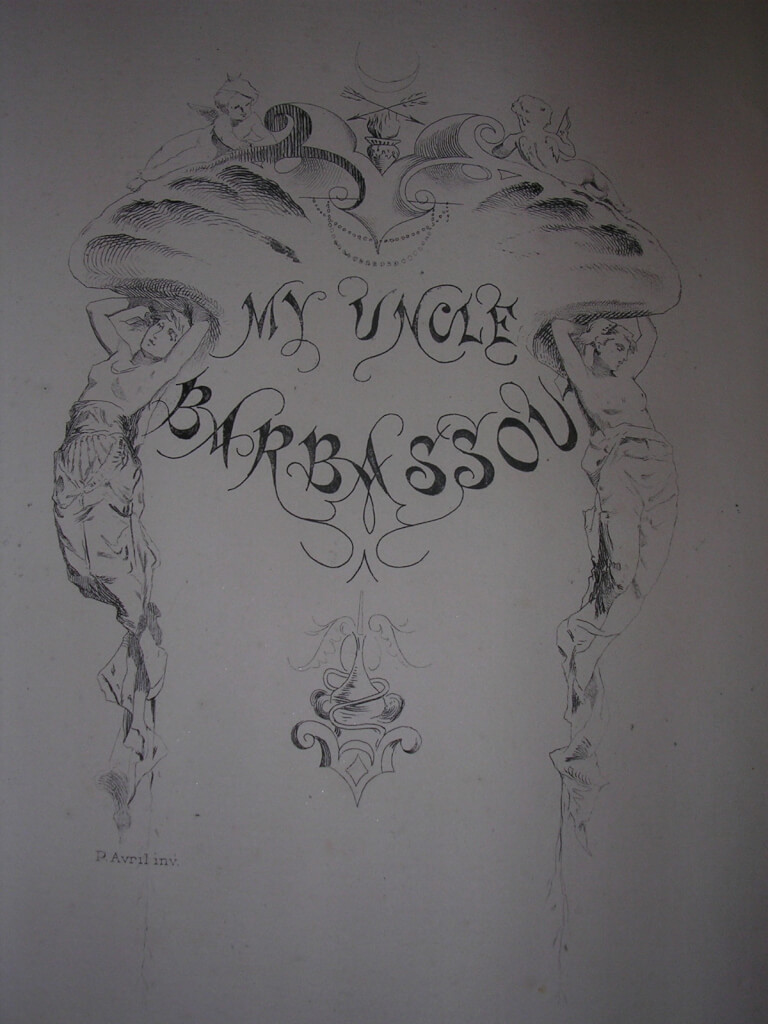
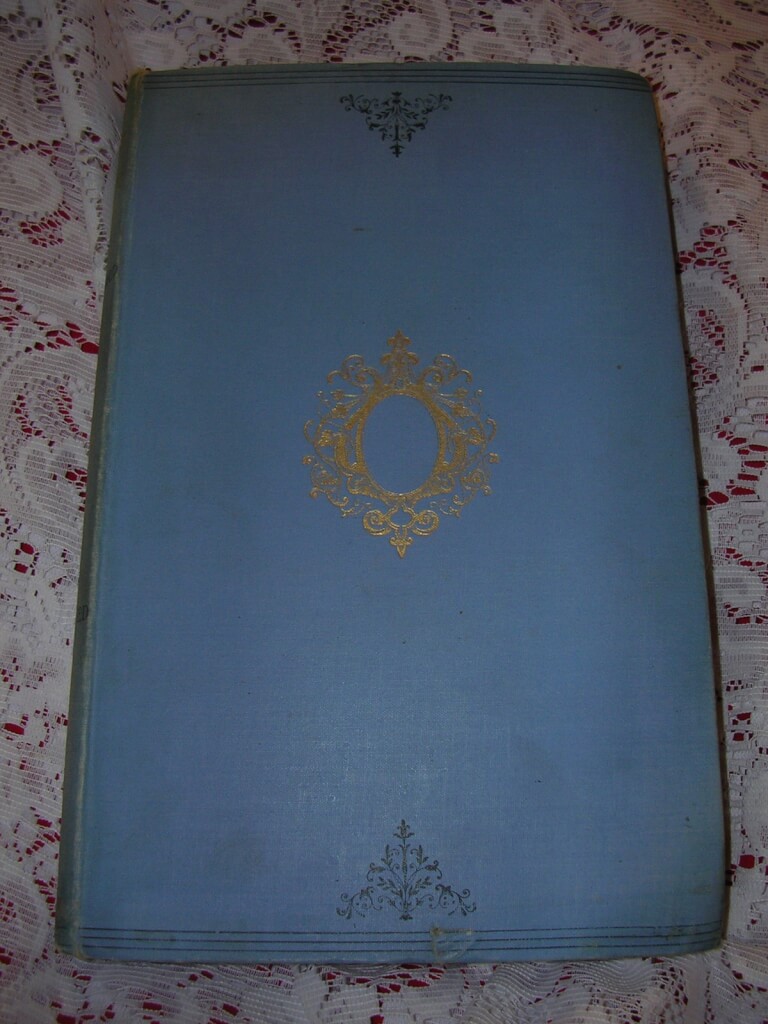 My Uncle Barbassou, Mario Uchard, Paul Avril (illust.) (Vizetelly & Co., London, 1888) 10.25" X 6.5", 339pp., hardbound, blue cloth boards with gilt and black titles and decorations on spine and front cover. Deckled edges. Good condition for age, boards and binding sound, illustrations throughout. Originally published in 4 parts in 1876, "Mon Oncle Barbassou" is a story of a man who inherits his uncle's estate which includes a newly purchased harem of 3 young girls. This novel is a prime example of the French "Orientalists" of the late 1800's. Scandalous for the age, but mild by today's standards, this book is the first English translation. The first English translation from the "Mon Oncle Barbassou" published in 1877. 40 beautiful engravings by Paul Avril. Édouard-Henri Avril (1849-1928) used the pseudonym "Paul Avril" for his erotic work. He was a French painter and commercial artist. His career saw collaboration with influential people like Octave Uzanne, Henry Spencer Ashbee and Friedrich Karl Forberg. He is one of the most celebrated erotic artists of his age. Avril was a soldier before starting his career in art. He was awarded with the Legion of Honour for his actions in the Franco-Prussian War.
My Uncle Barbassou, Mario Uchard, Paul Avril (illust.) (Vizetelly & Co., London, 1888) 10.25" X 6.5", 339pp., hardbound, blue cloth boards with gilt and black titles and decorations on spine and front cover. Deckled edges. Good condition for age, boards and binding sound, illustrations throughout. Originally published in 4 parts in 1876, "Mon Oncle Barbassou" is a story of a man who inherits his uncle's estate which includes a newly purchased harem of 3 young girls. This novel is a prime example of the French "Orientalists" of the late 1800's. Scandalous for the age, but mild by today's standards, this book is the first English translation. The first English translation from the "Mon Oncle Barbassou" published in 1877. 40 beautiful engravings by Paul Avril. Édouard-Henri Avril (1849-1928) used the pseudonym "Paul Avril" for his erotic work. He was a French painter and commercial artist. His career saw collaboration with influential people like Octave Uzanne, Henry Spencer Ashbee and Friedrich Karl Forberg. He is one of the most celebrated erotic artists of his age. Avril was a soldier before starting his career in art. He was awarded with the Legion of Honour for his actions in the Franco-Prussian War. -
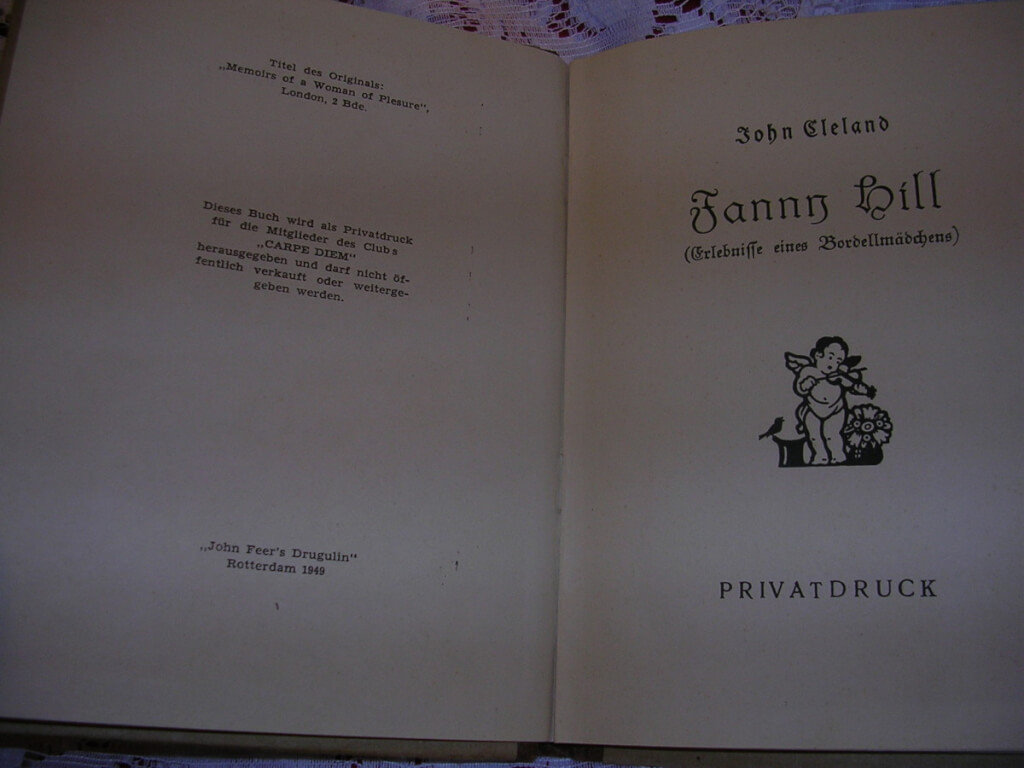
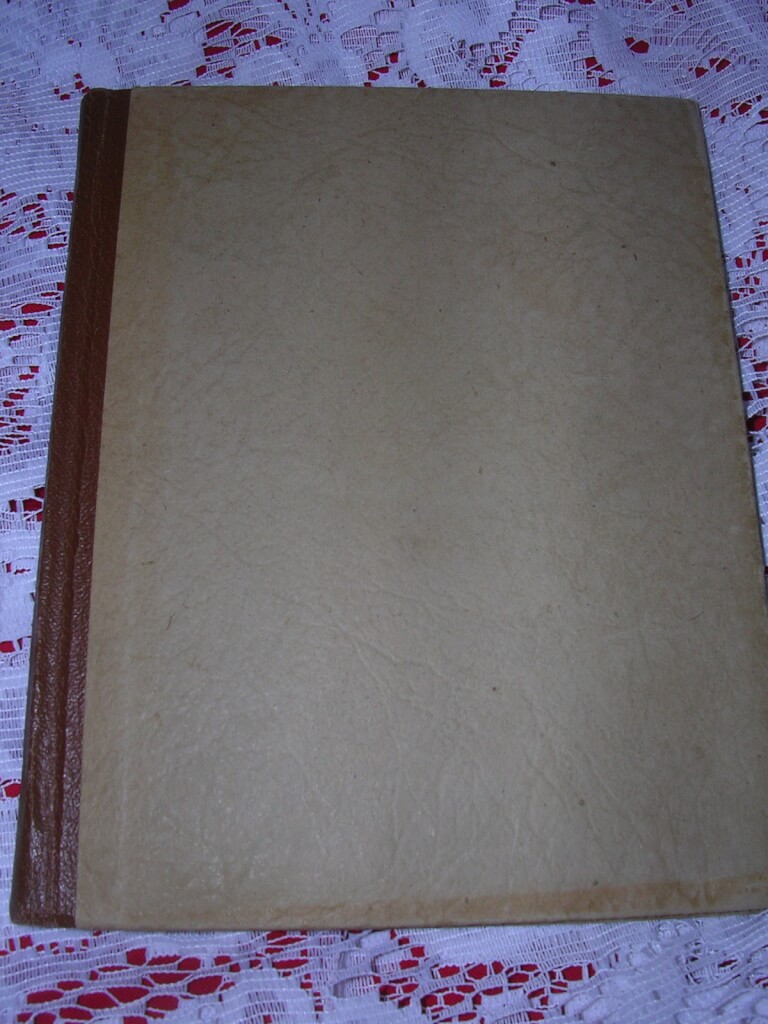 Fanny Hill (Erlebnisse eines Bordellmädchens.), John Cleland (Dieses Buch wird als Privatdruck für die Mitglieder des Clubs 'Carpe Diem' herausgegeben und darf nicht öffentlich verkauft oder weitergegeben werden. John Freer's Druglin, Rotterdam, 1949) 6.5" x 5.25", 78pp, hardbound tan paper over boards, faux leather spine. Good condition, slight foxing around edges of front cover. "This book is privately printed, published for the members of the 'Carpe Diem' club and must not be passed on or sold to the public." This was German "Bückware" or an item that was kept under the counter only for customers who asked for it. The book is labeled "Erstes Buch" (First Book). It is unknown whether this is a complete book. With only 79 pages, it might be a loosely translated edition or just the first volume. I have not found any similar books labeled anything but "Erste Buch"
Fanny Hill (Erlebnisse eines Bordellmädchens.), John Cleland (Dieses Buch wird als Privatdruck für die Mitglieder des Clubs 'Carpe Diem' herausgegeben und darf nicht öffentlich verkauft oder weitergegeben werden. John Freer's Druglin, Rotterdam, 1949) 6.5" x 5.25", 78pp, hardbound tan paper over boards, faux leather spine. Good condition, slight foxing around edges of front cover. "This book is privately printed, published for the members of the 'Carpe Diem' club and must not be passed on or sold to the public." This was German "Bückware" or an item that was kept under the counter only for customers who asked for it. The book is labeled "Erstes Buch" (First Book). It is unknown whether this is a complete book. With only 79 pages, it might be a loosely translated edition or just the first volume. I have not found any similar books labeled anything but "Erste Buch" -
 Manual of Classical Erotology (De figuris veneris), Fred. Chas. Forberg (stated Julian Smithson M. A., and friends, 1884 [later pirated edition]) 9.25"x6", hardcover 1/4 maroon over marbled boards, xiii-248pp, good condition This is a pirated edition (most likely 1920-30) of the first known English translation of this work. The original Julian Smithson edition was limited to 100 copies. De figuris Veneris (On the figures of Venus) was an anthology of ancient Greek and ancient Roman writings on erotic topics, discussed objectively and classified and grouped by subject matter. It was first published by the German classicist Friedrich Karl Forberg in 1824 in Latin and Greek as a commentary to Antonio Beccadelli's (1394-1471) Hermaphroditus (commonly referred to as Antonii Panormitae Hermaphroditus), an erotic poem sequence of 1425 in renaissance Latin, though it was later also published as a separate work. In 1899 Forberg's work was translated into English and published by Charles Carrington as De figuris Veneris, Manual of classical erotology, and again in 1907 by Charles Hirsch, and into French, German and Spanish. The French edition by Alcide Bonneau was titled Manuel d’érotologie classique. One French edition of 1906 was illustrated by Édouard-Henri Avril, which concludes with a list of 95 sexual positions. Most of the editions were restricted to high society or censored; one of the copies edited in France was immediately deposited on the secret shelves of the Bibliothèque nationale de France.
Manual of Classical Erotology (De figuris veneris), Fred. Chas. Forberg (stated Julian Smithson M. A., and friends, 1884 [later pirated edition]) 9.25"x6", hardcover 1/4 maroon over marbled boards, xiii-248pp, good condition This is a pirated edition (most likely 1920-30) of the first known English translation of this work. The original Julian Smithson edition was limited to 100 copies. De figuris Veneris (On the figures of Venus) was an anthology of ancient Greek and ancient Roman writings on erotic topics, discussed objectively and classified and grouped by subject matter. It was first published by the German classicist Friedrich Karl Forberg in 1824 in Latin and Greek as a commentary to Antonio Beccadelli's (1394-1471) Hermaphroditus (commonly referred to as Antonii Panormitae Hermaphroditus), an erotic poem sequence of 1425 in renaissance Latin, though it was later also published as a separate work. In 1899 Forberg's work was translated into English and published by Charles Carrington as De figuris Veneris, Manual of classical erotology, and again in 1907 by Charles Hirsch, and into French, German and Spanish. The French edition by Alcide Bonneau was titled Manuel d’érotologie classique. One French edition of 1906 was illustrated by Édouard-Henri Avril, which concludes with a list of 95 sexual positions. Most of the editions were restricted to high society or censored; one of the copies edited in France was immediately deposited on the secret shelves of the Bibliothèque nationale de France. -
Out of stock
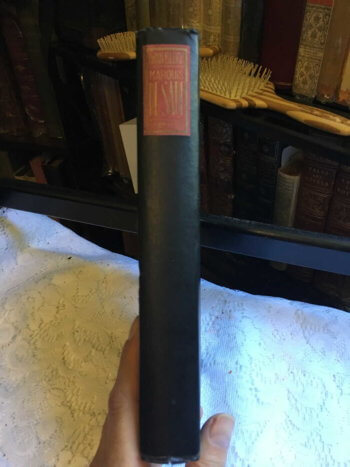
 Marquis de Sade | The Man and His Age | studies in the history of the culture and morals of the eighteenth century, Dr. Iwan Bloch, translated by James Bruce (Julian Press, 1931, [first american edition]) 6 .5"x9.5", 296pp, hardbound, black boards, red and gilt title on spine, some bumps and wear, good condition for age. Iwan Bloch (1872-1922), the “father of sexology”, was a Berlin dermatologist. His many socio-cultural studies in sexology earned him an international reputation as a medical historian. He also discovered de Sade’s manuscript of the “120 days of Sodom” in 1904, which had been believed to be lost. Together with Magnus Hirschfeld and Albert Eulenburg, Bloch proposed the new concept of a science of sexuality: Sexualwissenschaft or sexology. In 1906 he wrote Das Sexualleben unserer Zeit in seinen Beziehungen zur modernen Kultur [The Sexual Life of our Time in its Relations to Modern Civilization], a complete encyclopedia of the sexual sciences in their relation to modern civilization. According to Sigmund Freud, Bloch's studies were instrumental in the development of the anthropological approach to the theory of sexuality. For example, before Bloch, homosexuality was analyzed using a pathological approach.
Marquis de Sade | The Man and His Age | studies in the history of the culture and morals of the eighteenth century, Dr. Iwan Bloch, translated by James Bruce (Julian Press, 1931, [first american edition]) 6 .5"x9.5", 296pp, hardbound, black boards, red and gilt title on spine, some bumps and wear, good condition for age. Iwan Bloch (1872-1922), the “father of sexology”, was a Berlin dermatologist. His many socio-cultural studies in sexology earned him an international reputation as a medical historian. He also discovered de Sade’s manuscript of the “120 days of Sodom” in 1904, which had been believed to be lost. Together with Magnus Hirschfeld and Albert Eulenburg, Bloch proposed the new concept of a science of sexuality: Sexualwissenschaft or sexology. In 1906 he wrote Das Sexualleben unserer Zeit in seinen Beziehungen zur modernen Kultur [The Sexual Life of our Time in its Relations to Modern Civilization], a complete encyclopedia of the sexual sciences in their relation to modern civilization. According to Sigmund Freud, Bloch's studies were instrumental in the development of the anthropological approach to the theory of sexuality. For example, before Bloch, homosexuality was analyzed using a pathological approach. -
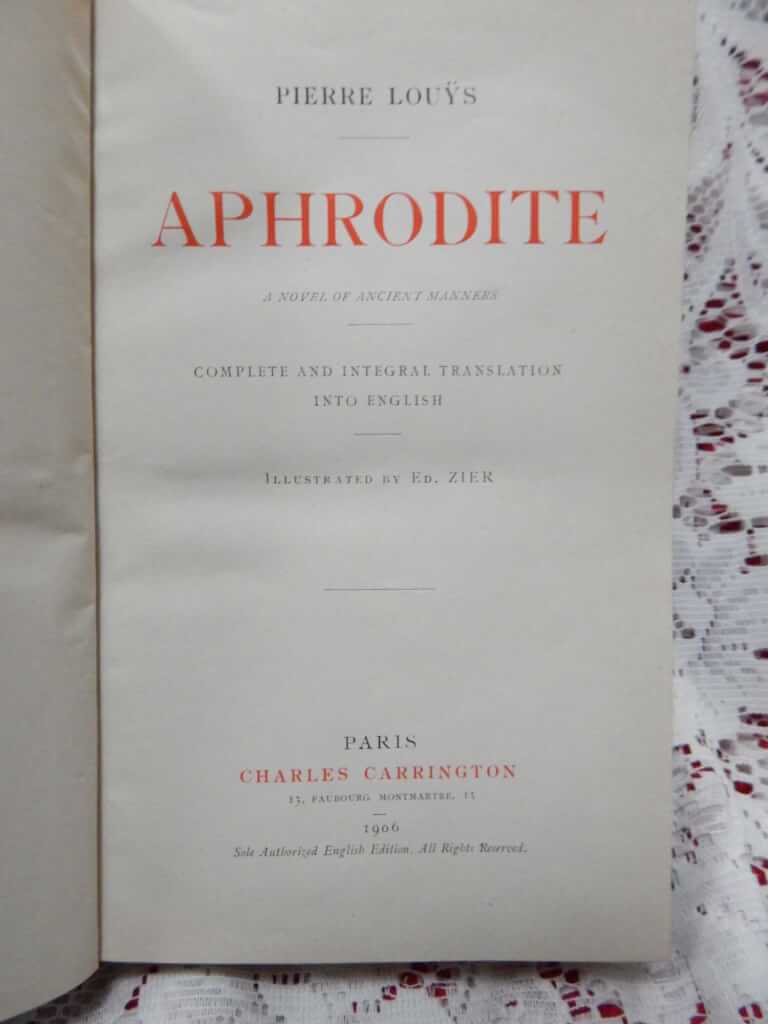
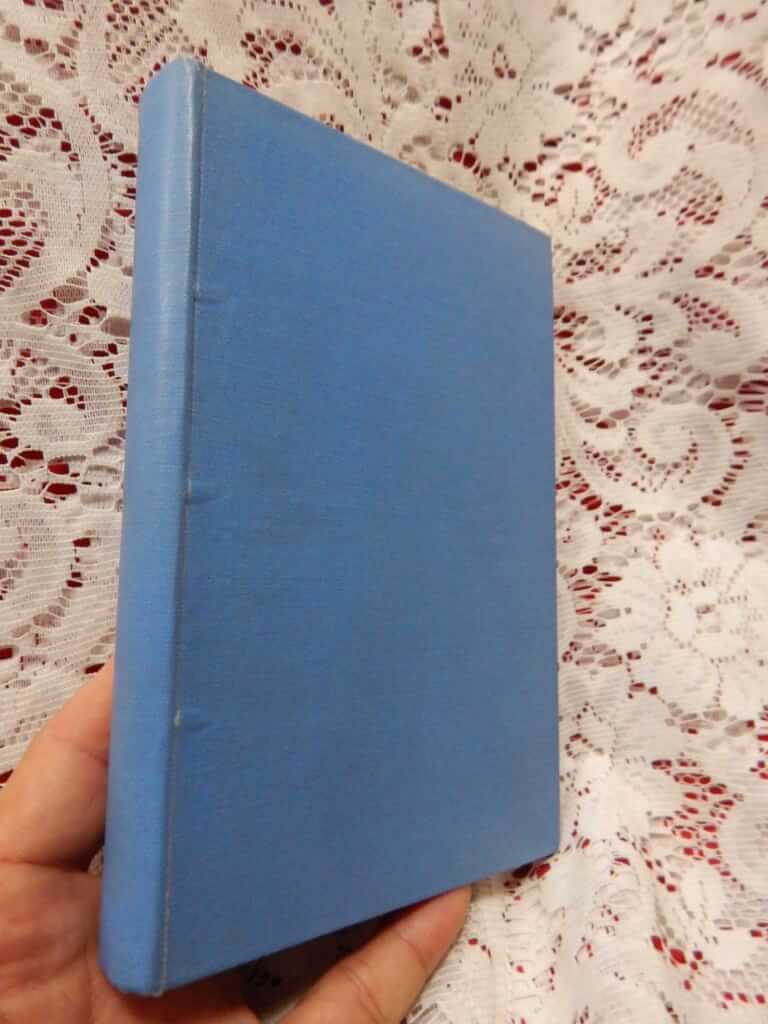 Aphrodite, a novel of ancient manners, by Pierre Louÿs, illus. Ed. Zier (Charles Carrington, 1906, first edition thus, first English translation) 5.25 x 7.75", xiv+412pp, rebound with plain blue boards, fine condition Pierre Louys (1870 - 1925) was a French poet and writer, most renowned for lesbian and classical themes in some of his writings. He is known as a writer who "expressed pagan sensuality with stylistic perfection." "Aphrodite: mæurs antiques" (Ancient Manners) is a "libertine" story set in ancient Alexandria. Highlights include the loves of Chrysis, an orgy banquet ending in the crucifixion of a slave, the love of two young musician girls and the festivals of Aphrodite. "This Translation of Aphrodite was executed on the Printing Presses of Charles Herissey, at Evreux (France), for Mr. Charles Carrington, Paris, Bookseller et Publisher, and is the only complete English version extant." Édouard François Zier (1856-1924) was a French illustrator and painter.
Aphrodite, a novel of ancient manners, by Pierre Louÿs, illus. Ed. Zier (Charles Carrington, 1906, first edition thus, first English translation) 5.25 x 7.75", xiv+412pp, rebound with plain blue boards, fine condition Pierre Louys (1870 - 1925) was a French poet and writer, most renowned for lesbian and classical themes in some of his writings. He is known as a writer who "expressed pagan sensuality with stylistic perfection." "Aphrodite: mæurs antiques" (Ancient Manners) is a "libertine" story set in ancient Alexandria. Highlights include the loves of Chrysis, an orgy banquet ending in the crucifixion of a slave, the love of two young musician girls and the festivals of Aphrodite. "This Translation of Aphrodite was executed on the Printing Presses of Charles Herissey, at Evreux (France), for Mr. Charles Carrington, Paris, Bookseller et Publisher, and is the only complete English version extant." Édouard François Zier (1856-1924) was a French illustrator and painter. -
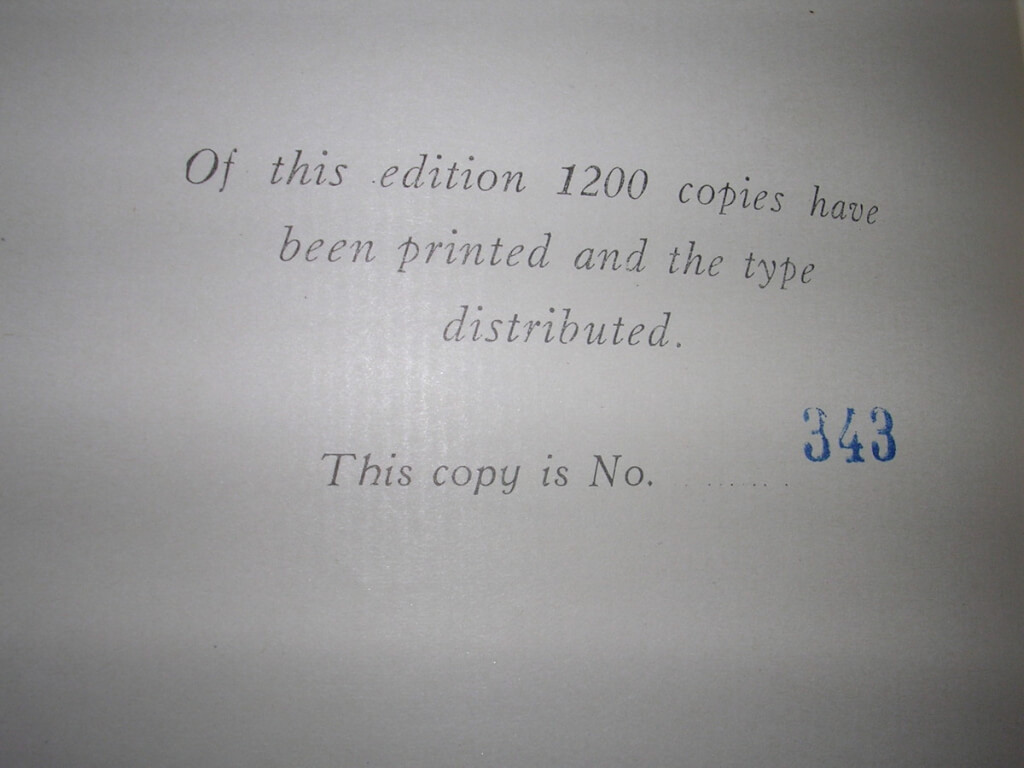
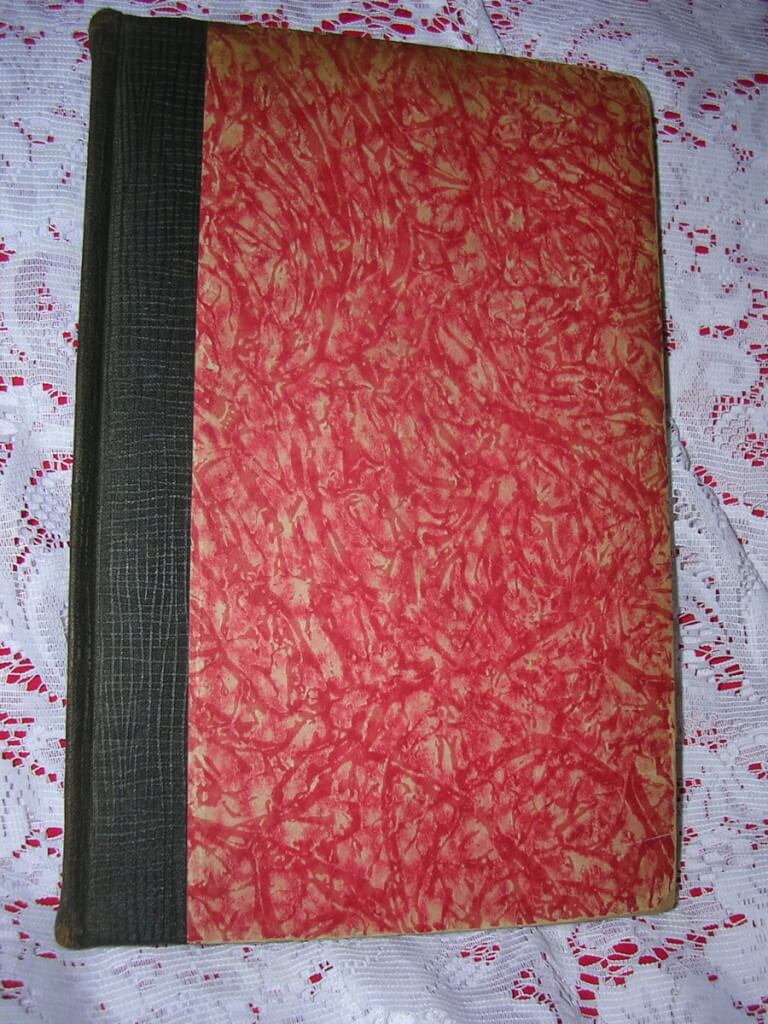 The Satyricon of Petronius Arbiter, Gaius Petronius, trans. ascribed to Oscar Wilde (Privately Printed, 1928, Limited Edition 343/1200 stamped in ink) 9" X 6 1/4", 236pp, black spine with gilt titles (mostly worn off), decorated red boards. Fair copy, boards worn, binding good. Front board loose but holding. Satyricon (or Satyrica) is a Latin work of fiction in a mixture of prose and poetry (prosimetrum). It is believed to have been written by Gaius Petronius, though the manuscript tradition identifies the author as a certain Titus Petronius. Classical scholars often describe it as a "Roman novel", without necessarily implying continuity with the modern literary form. The surviving portions of the text detail the misadventures of the narrator, Encolpius, and his lover, a handsome sixteen-year-old boy named Giton. Throughout the novel, Encolpius has a hard time keeping his lover faithful to him as he is constantly being enticed away by others. Encolpius's friend Ascyltus (who seems to have previously been in a relationship with Encolpius) is another major character. It is a rare example of a Roman novel, the only other surviving example (quite different in style and plot) being Metamorphoses of Apuleius. It is also extremely important evidence for the reconstruction of what everyday life must have been like for the lower classes during the early Roman Empire.
The Satyricon of Petronius Arbiter, Gaius Petronius, trans. ascribed to Oscar Wilde (Privately Printed, 1928, Limited Edition 343/1200 stamped in ink) 9" X 6 1/4", 236pp, black spine with gilt titles (mostly worn off), decorated red boards. Fair copy, boards worn, binding good. Front board loose but holding. Satyricon (or Satyrica) is a Latin work of fiction in a mixture of prose and poetry (prosimetrum). It is believed to have been written by Gaius Petronius, though the manuscript tradition identifies the author as a certain Titus Petronius. Classical scholars often describe it as a "Roman novel", without necessarily implying continuity with the modern literary form. The surviving portions of the text detail the misadventures of the narrator, Encolpius, and his lover, a handsome sixteen-year-old boy named Giton. Throughout the novel, Encolpius has a hard time keeping his lover faithful to him as he is constantly being enticed away by others. Encolpius's friend Ascyltus (who seems to have previously been in a relationship with Encolpius) is another major character. It is a rare example of a Roman novel, the only other surviving example (quite different in style and plot) being Metamorphoses of Apuleius. It is also extremely important evidence for the reconstruction of what everyday life must have been like for the lower classes during the early Roman Empire. -
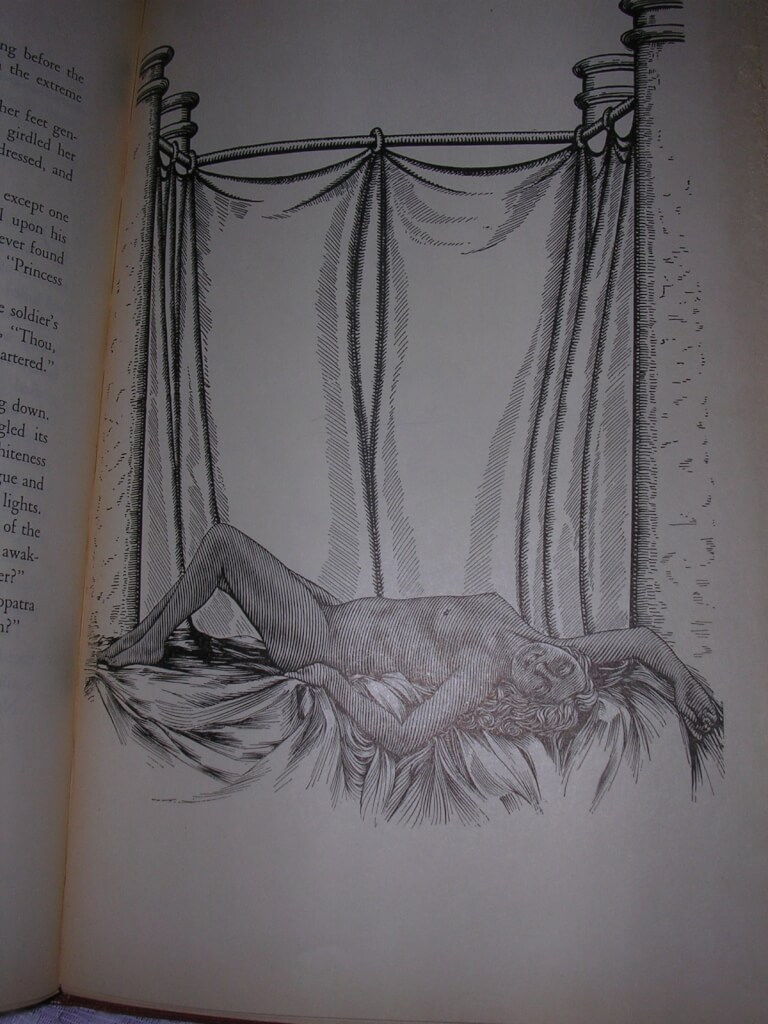
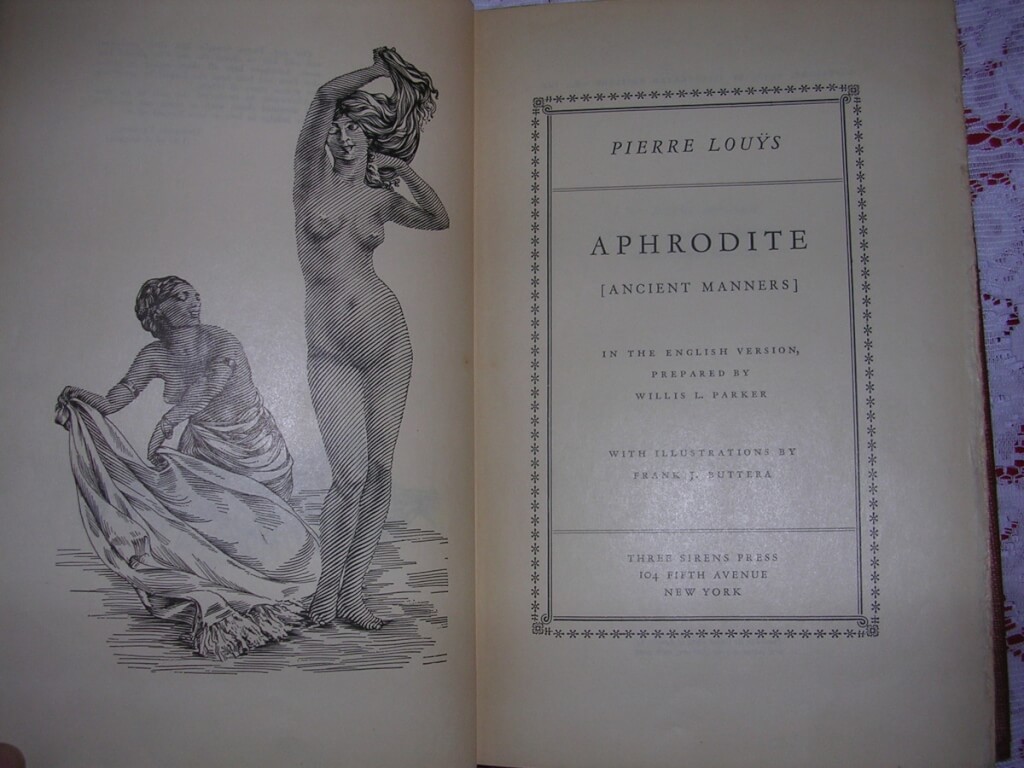 Aphrodite (Ancient Manners), Pierre Louys, trans. Willis L. Parker, illustrator Frank J. Buttera (Three Sirens Press, New York, 1932) 9 1/2" X 6 1/4", 251pp, hardbound no DJ, red cloth over boards with gilt decorations, deckle fore and bottom edge, inked top edge, very good condition, minor bumping to corners Pierre Louys (1870 - 1925) was a French poet and writer, most renowned for lesbian and classical themes in some of his writings. He is known as a writer who "expressed pagan sensuality with stylistic perfection." "Aphrodite: mæurs antiques" (Ancient Manners) is a "libertine" story set in ancient Alexandria. Highlights include the loves of Chrysis, an orgy banquet ending in the crucifixion of a slave, the love of two young musician girls and the festivals of Aphrodite. This edition is illustrated by Frank J. Buttera
Aphrodite (Ancient Manners), Pierre Louys, trans. Willis L. Parker, illustrator Frank J. Buttera (Three Sirens Press, New York, 1932) 9 1/2" X 6 1/4", 251pp, hardbound no DJ, red cloth over boards with gilt decorations, deckle fore and bottom edge, inked top edge, very good condition, minor bumping to corners Pierre Louys (1870 - 1925) was a French poet and writer, most renowned for lesbian and classical themes in some of his writings. He is known as a writer who "expressed pagan sensuality with stylistic perfection." "Aphrodite: mæurs antiques" (Ancient Manners) is a "libertine" story set in ancient Alexandria. Highlights include the loves of Chrysis, an orgy banquet ending in the crucifixion of a slave, the love of two young musician girls and the festivals of Aphrodite. This edition is illustrated by Frank J. Buttera -
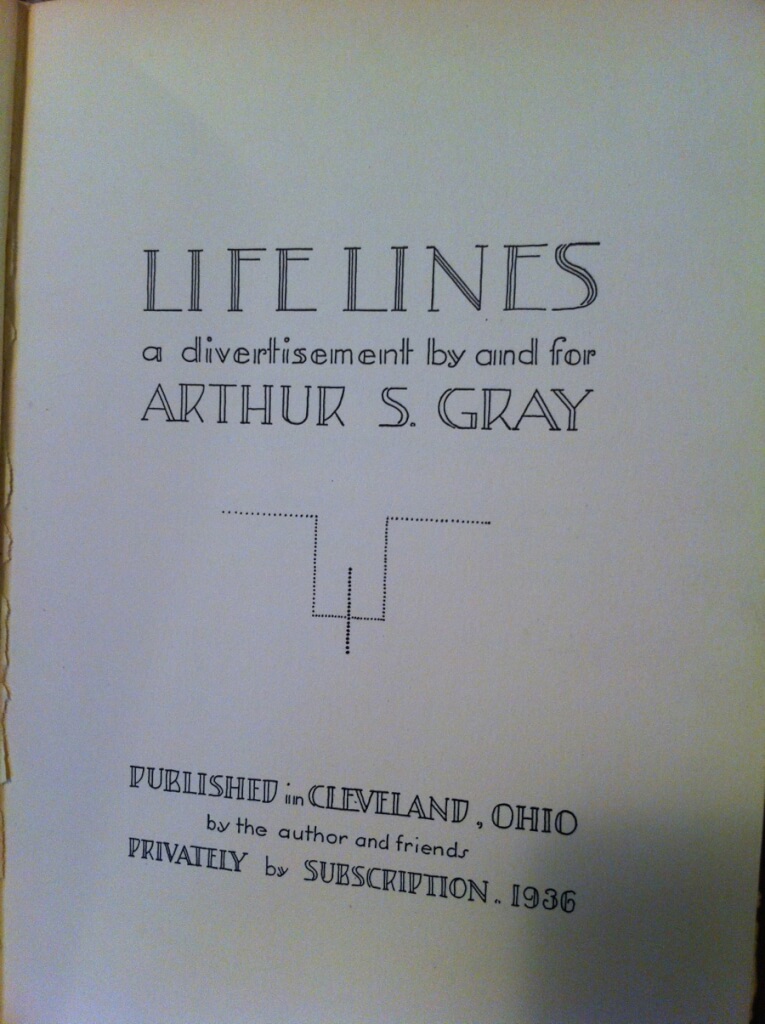
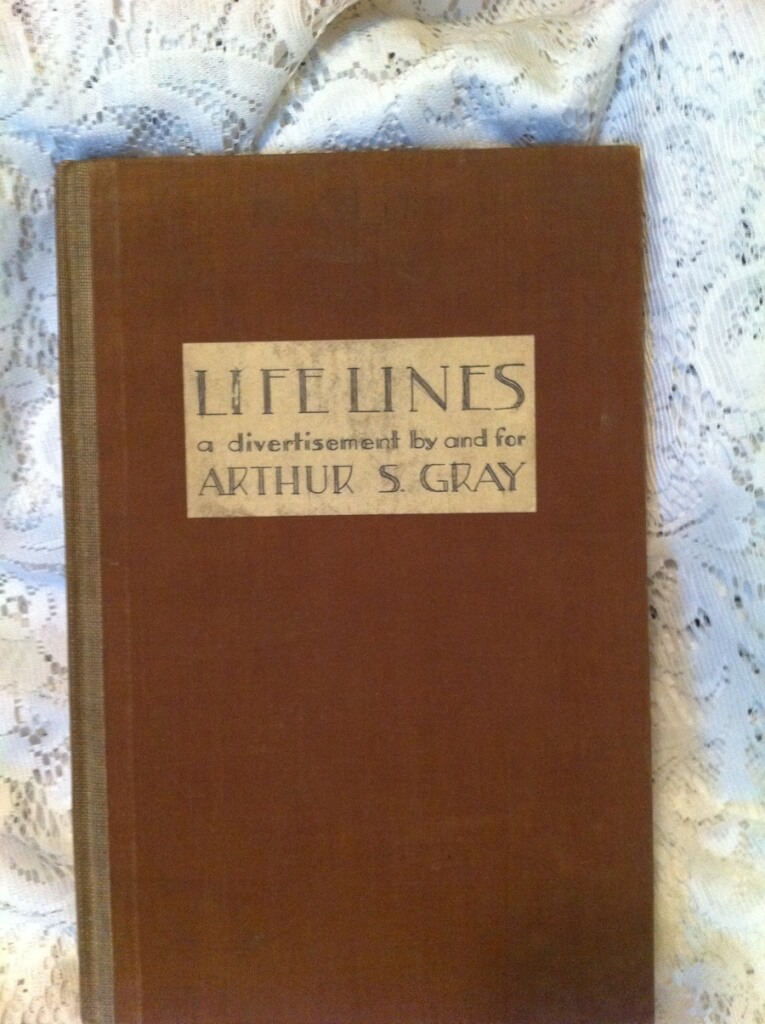 Life Lines, Arthur S. Gray ("Published in Cleveland, Ohio by the author and friends, Privately by Subscription, 1936") 10 1/8 X 6 3/4, 93pp, hardbound no DJ, deckle edges, good condition, slight soiling to boards The title page reads "Life Lines, a divertisement by and for Arthur S. Gray". Published in Cleveland, Ohio by the author and friends, Privately by Subscription, 1936". The author writes in his preface, "Because this book is a Michelangelo collection of poems and drawings done now and then for my diversion and satisfaction, it is necessary to announce that the pictures are not illustrations. Each drawing is a simple record of some particular and more or less unique quality which caught my attention and incited me to draw. After the prime reason, the urge to make something. I draw the way I do for two reasons: first to preserve the integrity of my powers of observation and reaction; second, to render that respect which is the natural right of an individual entity."
Life Lines, Arthur S. Gray ("Published in Cleveland, Ohio by the author and friends, Privately by Subscription, 1936") 10 1/8 X 6 3/4, 93pp, hardbound no DJ, deckle edges, good condition, slight soiling to boards The title page reads "Life Lines, a divertisement by and for Arthur S. Gray". Published in Cleveland, Ohio by the author and friends, Privately by Subscription, 1936". The author writes in his preface, "Because this book is a Michelangelo collection of poems and drawings done now and then for my diversion and satisfaction, it is necessary to announce that the pictures are not illustrations. Each drawing is a simple record of some particular and more or less unique quality which caught my attention and incited me to draw. After the prime reason, the urge to make something. I draw the way I do for two reasons: first to preserve the integrity of my powers of observation and reaction; second, to render that respect which is the natural right of an individual entity."












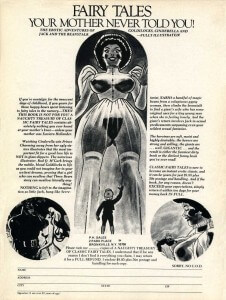








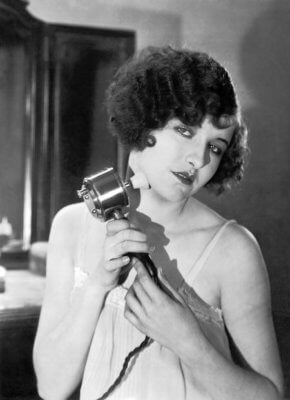 c. 1927 Actress Colleen Moore using a Star-Rite electric massage vibrator in Hollywood.
c. 1927 Actress Colleen Moore using a Star-Rite electric massage vibrator in Hollywood. 

